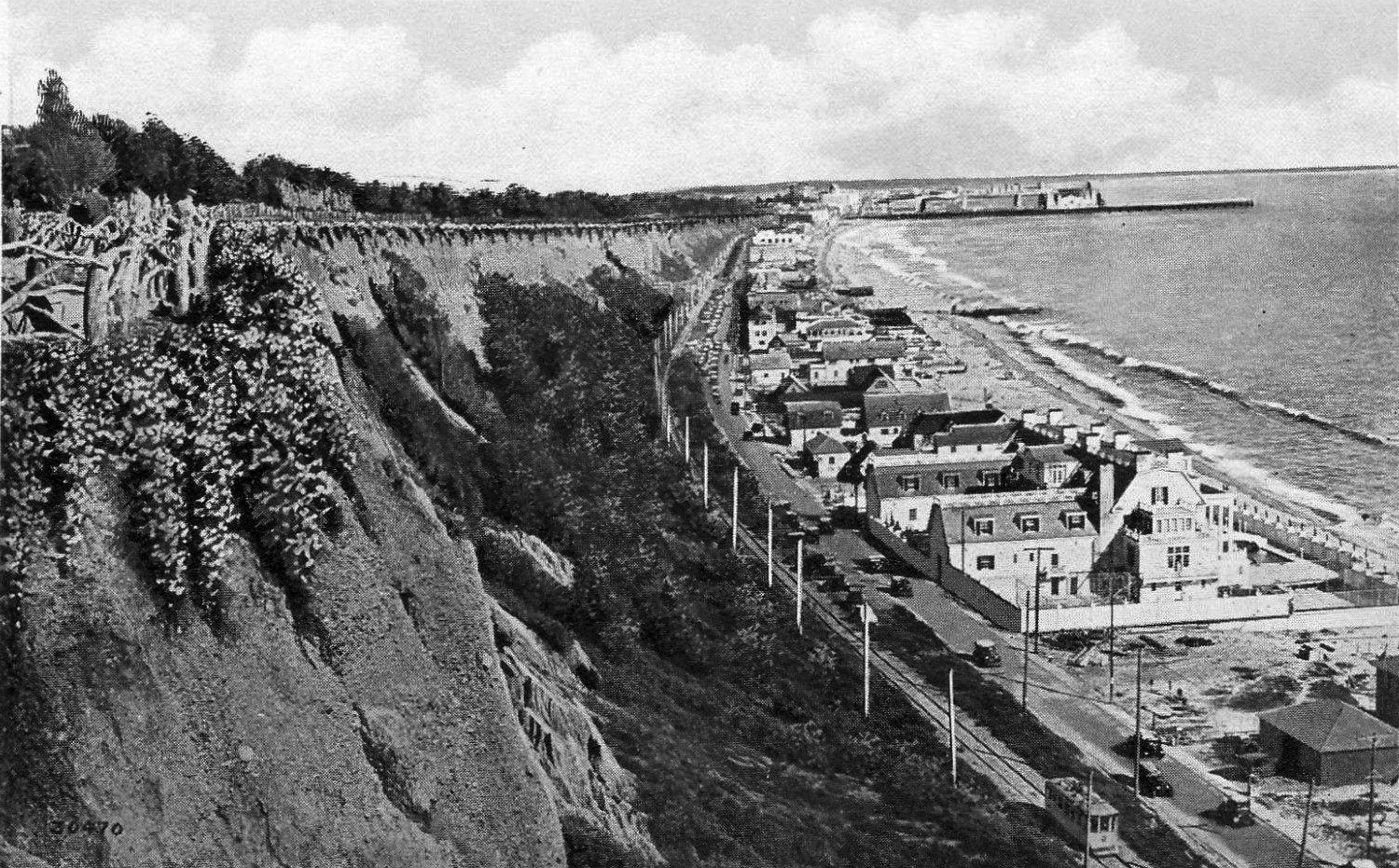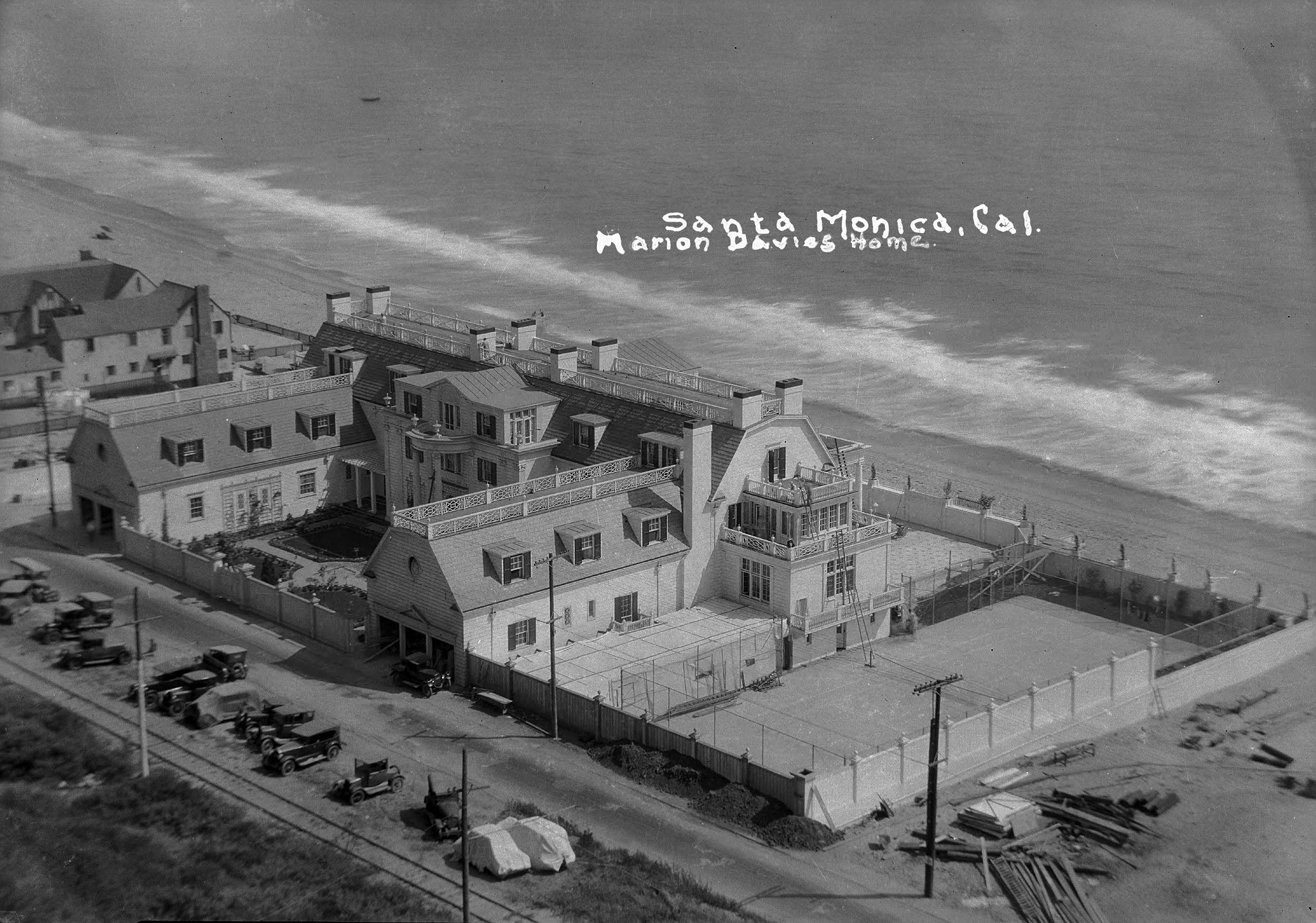Early Views of Santa Monica
Historical Photos of Early Santa Monica |
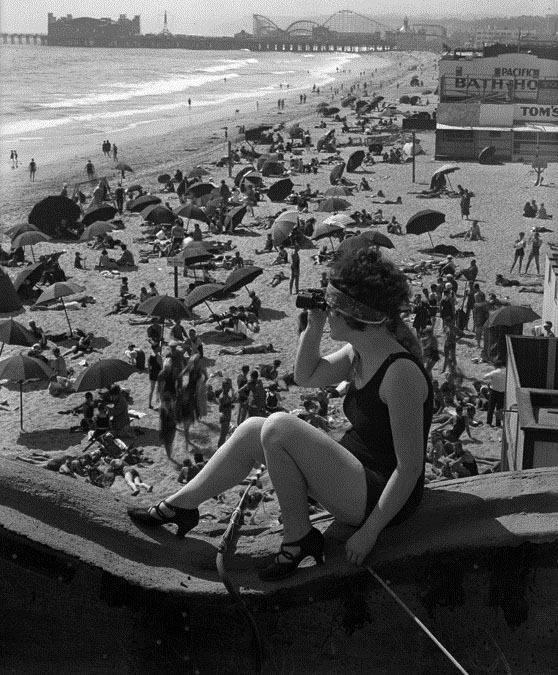 |
|
| (ca. 1920)* - Woman with spy glass looking out toward the ocean. The beach is full of sunbathers with the Santa Monica Pier and Amusement Park in the distance. Pacific Bath House can be seen at upper right. |
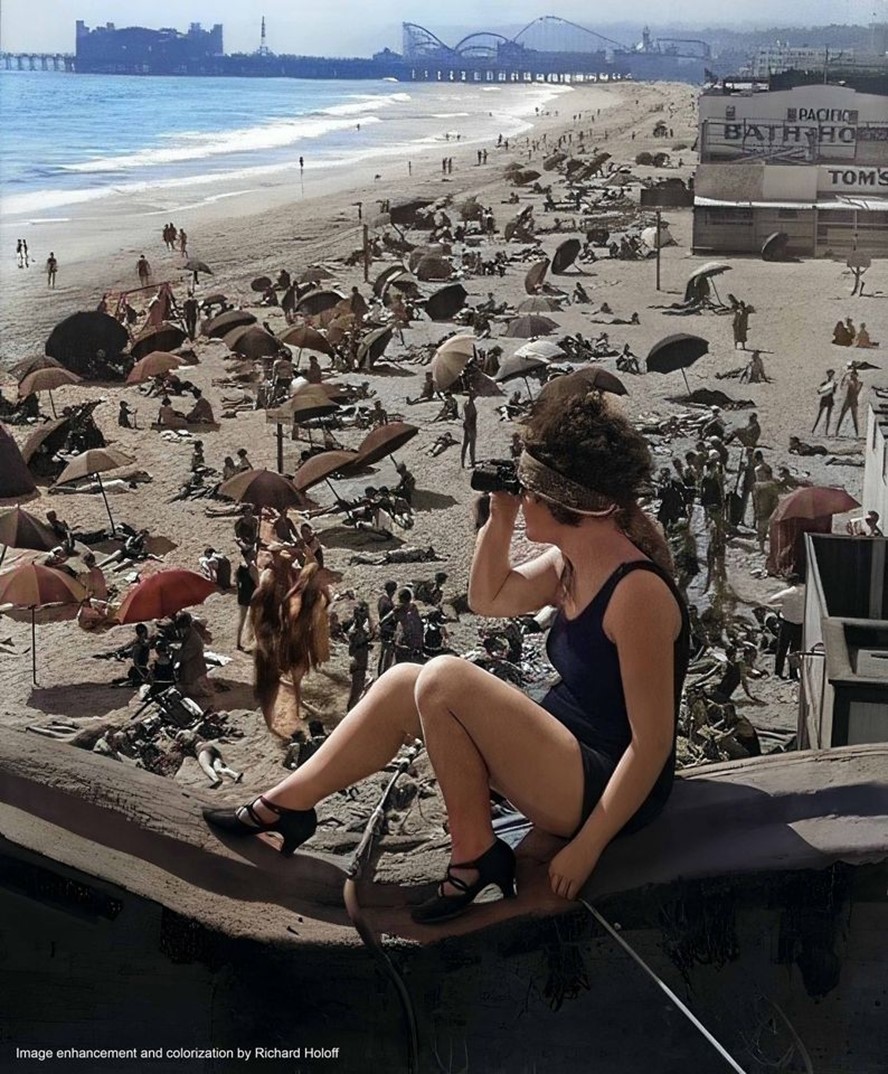 |
|
| (ca. 1920)* - Woman with spy glass looking out toward the ocean. The beach is full of sunbathers with the Santa Monica Pier and Amusement Park in the distance. Pacific Bath House can be seen at upper right. Image enhancement and colorization by Richard Holoff. |
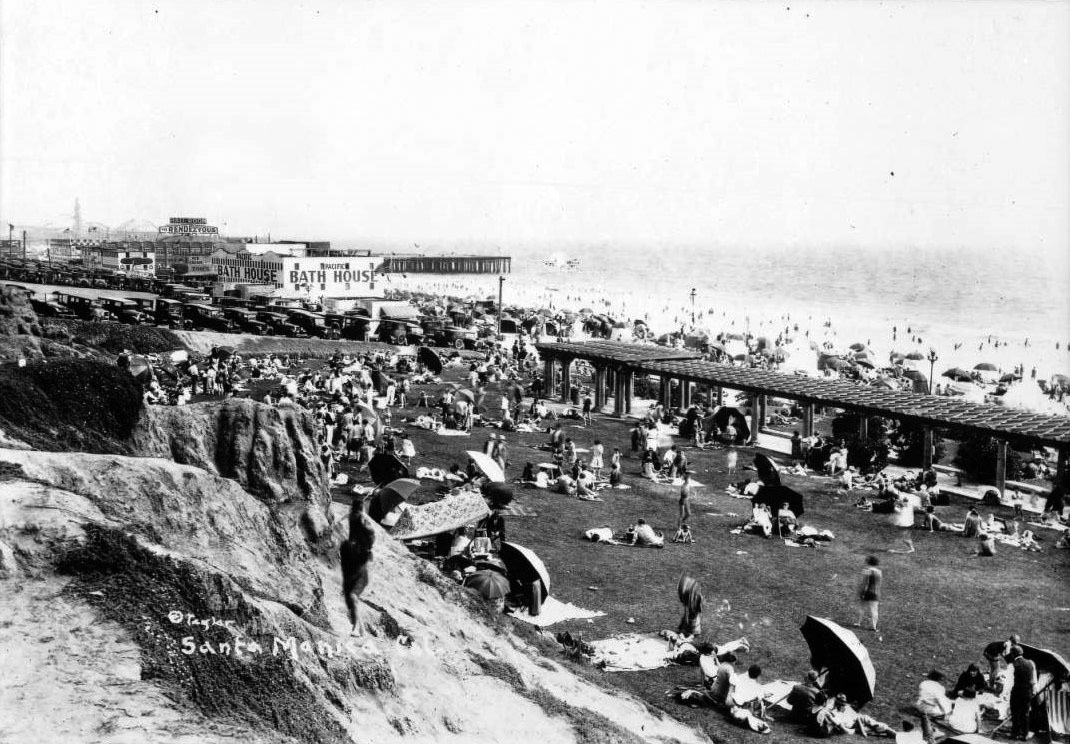 |
|
| (ca. 1920)* - View of the beach in Santa Monica, south of the pier. A large grassy park is in the foreground at right. Many people are seated beneath umbrellas or on blankets on the grass. A covered walkway runs through the middle of the park at right. The beach is in the background at center and is also crowded with umbrellas and people. There is a rocky outcropping in the foreground at left. In the background at right are several large buildings and a parking lot full of early-model automobiles. Part of a pier is jutting out into the water in the distance at center, and there appears to be a roller coaster in the far distance. Legible signs include, from left to right: "Ball Room", "The Rendezvous", "Ice Cream", "Tom's", and "Pacific Bath House". |
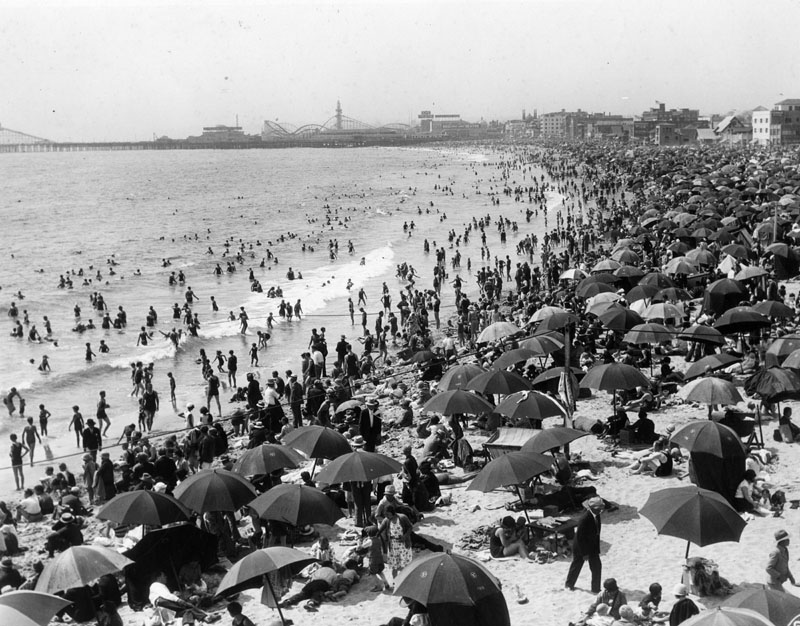 |
|
| (ca. 1920s)* - View looking north of a very crowded shoreline at Ocean Park Beach in Santa Monica. |
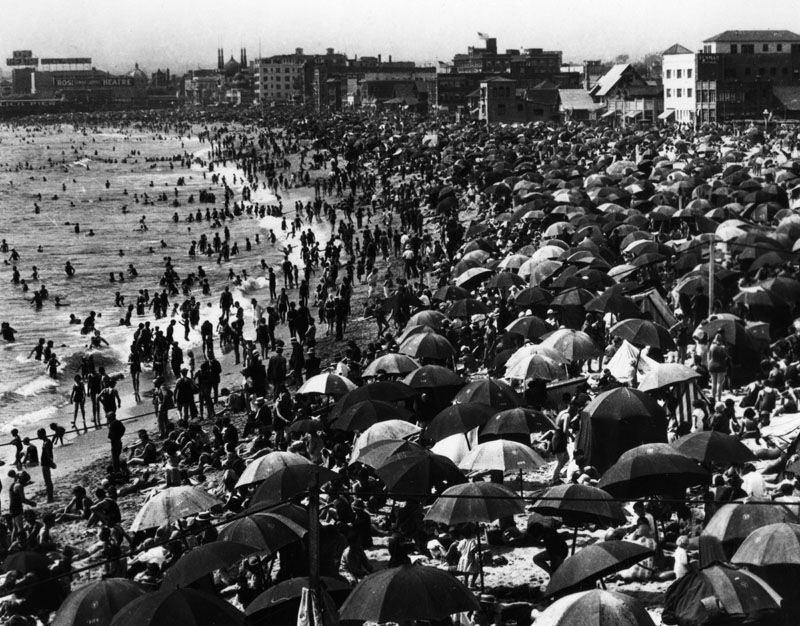 |
|
| (1925)* - WOW! - High density real estate. The view is looking north towards Ocean Park where some buildings and part of Lick Pier are visible. |
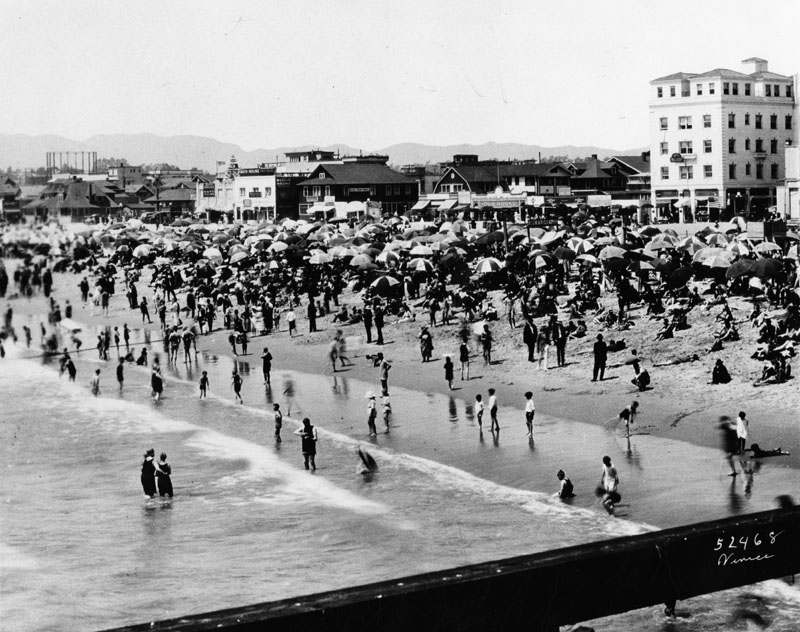 |
|
| (ca. 1920s)* - Crowded shoreline at Ocean Park Beach in Santa Monica. |
Ink Well Beach
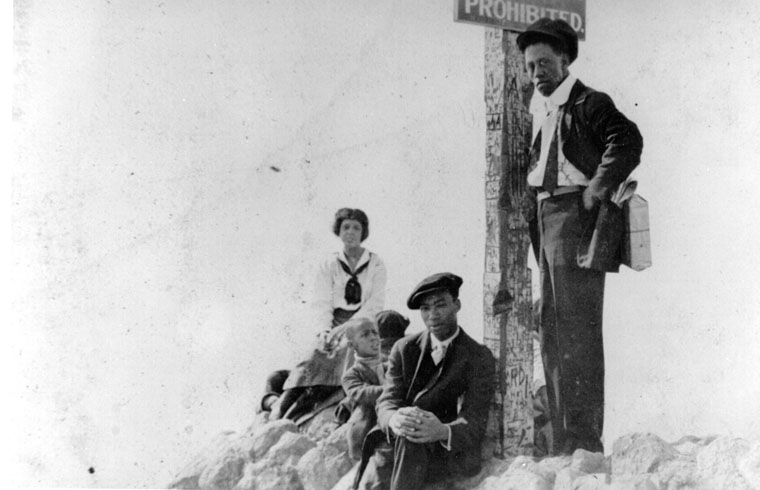 |
|
| (ca. 1920s)* - A group at the sign that reads "Prohibited," at the boundary between Ink Well Beach and the whites-only section of beach in Santa Monica. |
Historical Notes Through the 1920s, many public beaches were open to whites only. For the African American community, there was a 200-sq ft. area of beach at the foot of Pico Blvd that was marked with a sign that said “Negroes Only.” This stretch of beach became known as the Ink Well. African Americans continued to congregate at the Ink Well long after racial restrictions on beach access were lifted in 1927. It continued to be a popular African American gathering spot into the 1960s. |
* * * * * |
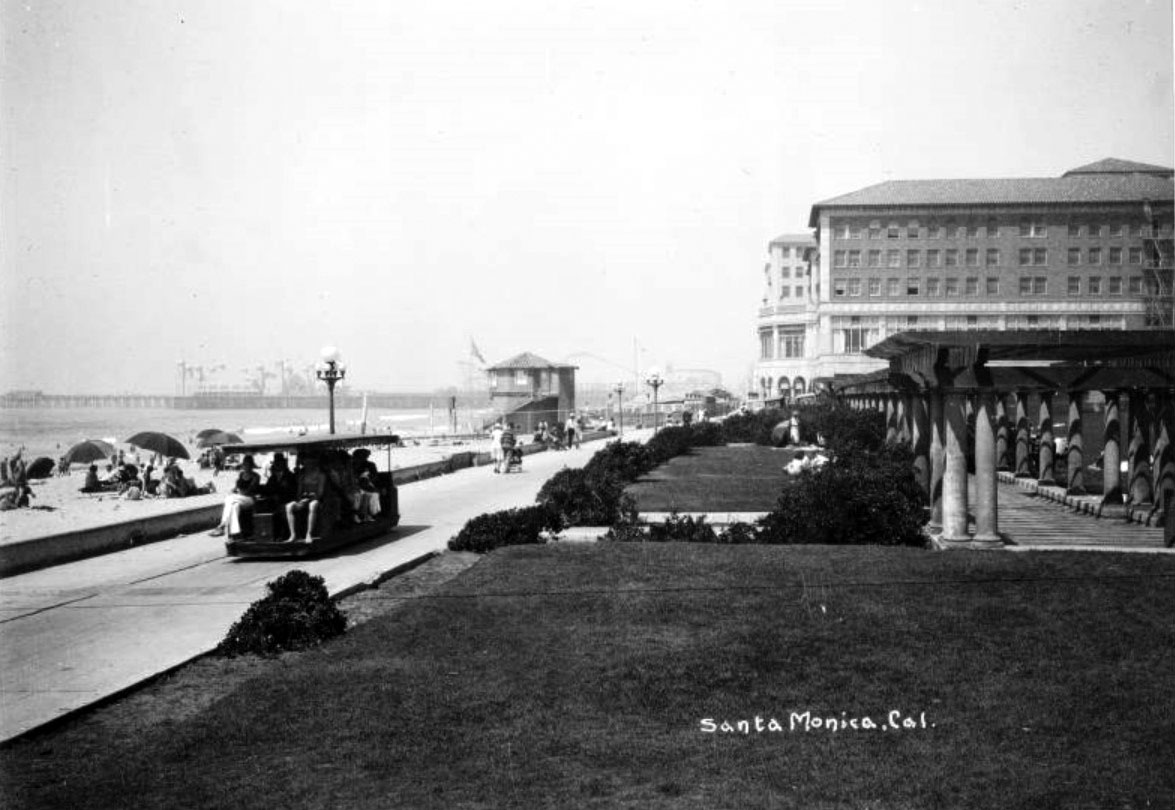 |
|
| (1920)* - View of the beach south of Casa Del Mar Beach Club in Santa Monica, looking north to the pier. There is a grassy park at right, and the right side of the park is bordered by a covered walkway. A broad sidewalk divides the park from the sandy beach at left, and a small sidewalk electric tram is transporting passengers along the walkway. The beach is occupied by many people, several of whom are resting beneath umbrellas. The large Casa Del Mar Beach Club is at right. It is a massive rectangular building with at least five stories and a terra cotta tile roof. The pier is in the background at left. |
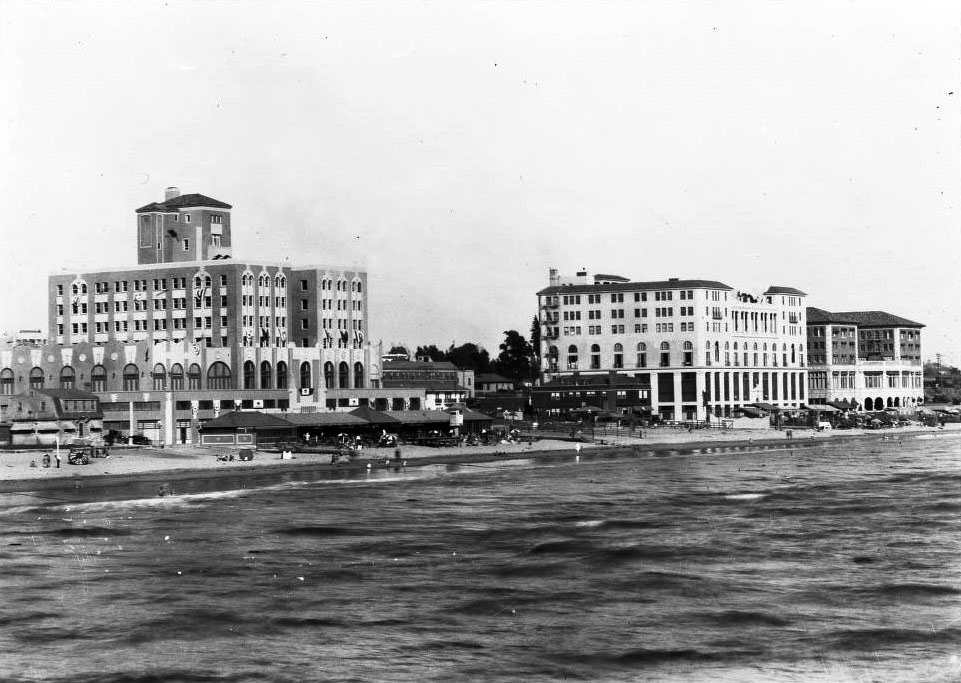 |
|
| (1920)* - View of the Edgewater, Breakers, and Casa Del Mar Beach Clubs in Santa Monica, looking south from the water. The three massive beach clubs are seen on the shore in the middle distance. All three buildings have at least six or seven stories and two distinct wings. A tall tower emerges from the flat roof of the club at left. Several smaller buildings can be seen between and in front of the beach clubs. The beach in front of the clubs is sparsely populated with beachgoers. The ocean in the foreground is calm. |
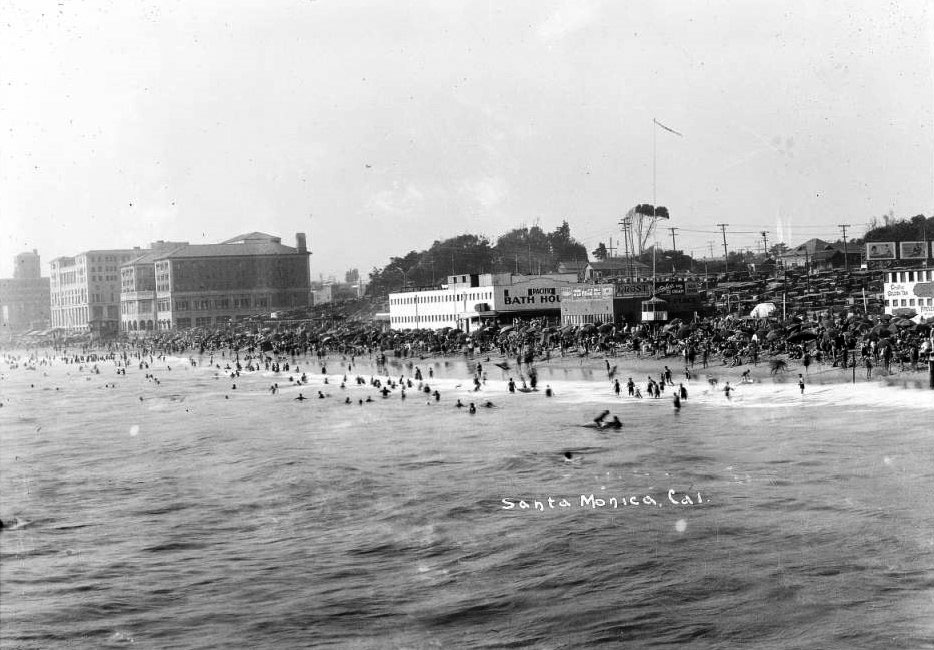 |
|
| (ca. 1920s)* - View of the Santa Monica beach and the Pacific Bath House south of Casa Del Mar Beach Club. The sandy beach stretches across the middle of the image and is crowded with hundreds of people. The Pacific Bath house is at center. It is a light-colored, two-story building with rows of rectangular windows around its perimeter. Several large beach clubs are in the distance at left, and two small eateries are at right. There is a crowded parking lot full of early-model automobiles behind the bath house. Legible signs include, from left to right, "Pacific Bath House", "Fish Dinners", "Coca Cola Sold Here", "Frost", "Christopher's Ice Cream", "Sea Food", "Creates Golden Tan", and "Prevent". |
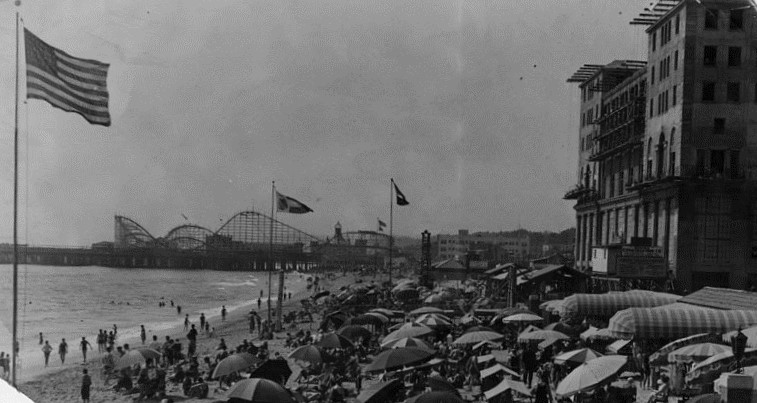 |
|
| (1926)* - Sunbathers and umbrellas are on the sand in front of the Club Casa del Mar beach club in Santa Monica. The building displayed is the Edgewater Beach Club, 1855 Promenade. Both clubs were private. In the background is the Santa Monica Pier with its roller coaster ride. |
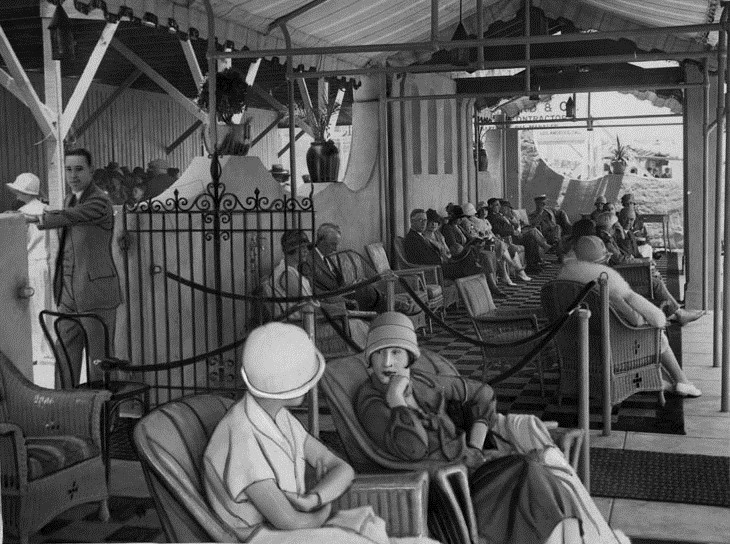 |
|
| (1926)* - Several people are seen relaxing at the Edgewater Beach Club, 1855 Promenade, in a covered pavilion on the beach. |
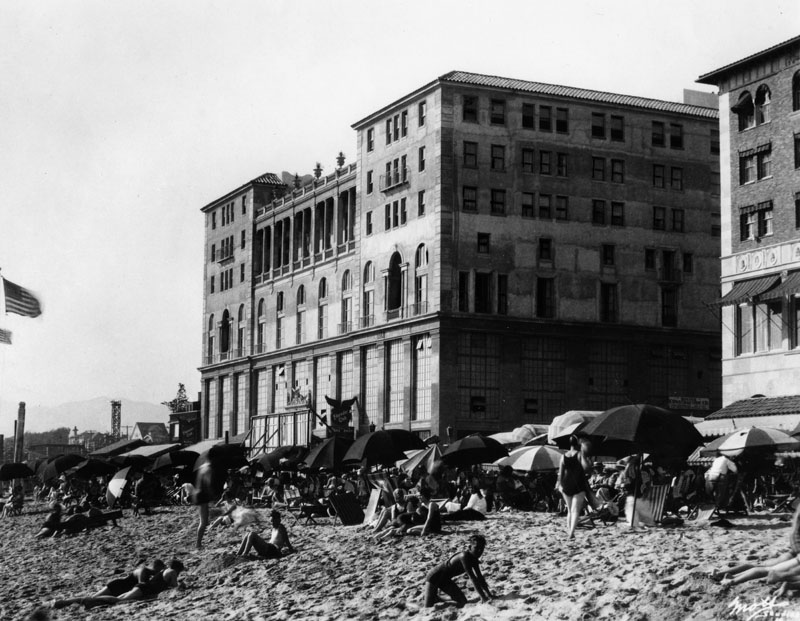 |
|
| (1927)* - Exterior view of the Edgewater Beach Club, left, at 1855 Promenade in Santa Monica. Groups of people with umbrellas are seen in front of the private beach clubs sitting on the sand and enjoying their day at the beach. The building partially visible to the right is the Club Casa del Mar. |
Grand Hotel (originally Breakers Beach Club, later Sea Castle Apartments)
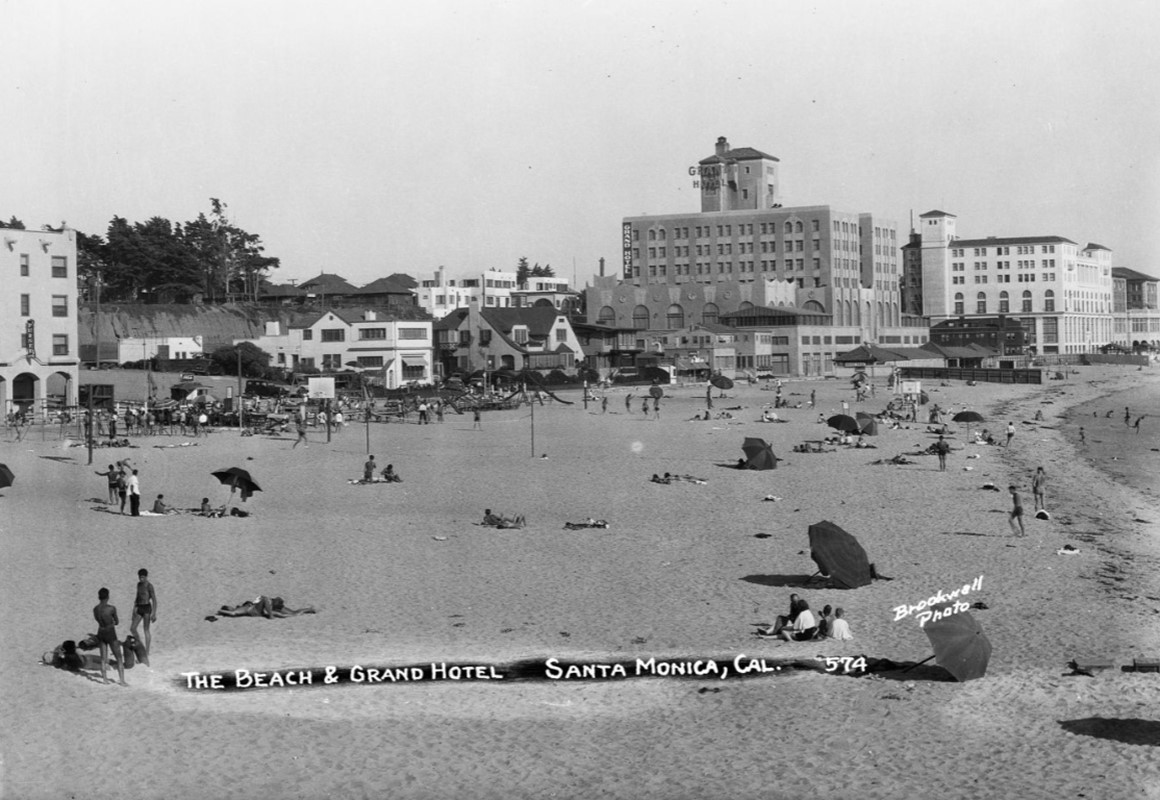 |
|
| (1930s)* – Postcard view showing people on the beach next to the Grand Hotel with the Edgewater Club and Casa Del Mar beach clubs in the distance in south Santa Monica. The hotel at center has a large sign that reads "Grand Hotel" on the north side of the building. |
Historical Notes The Breakers Beach Club, founded in 1926, was converted into the Grand Hotel in 1934 and eventually into an apartment complex. The Edgewater Beach Club, founded in 1927, was eventually demolished. The Casa Del Mar, founded in 1926, and is currently a hotel. |
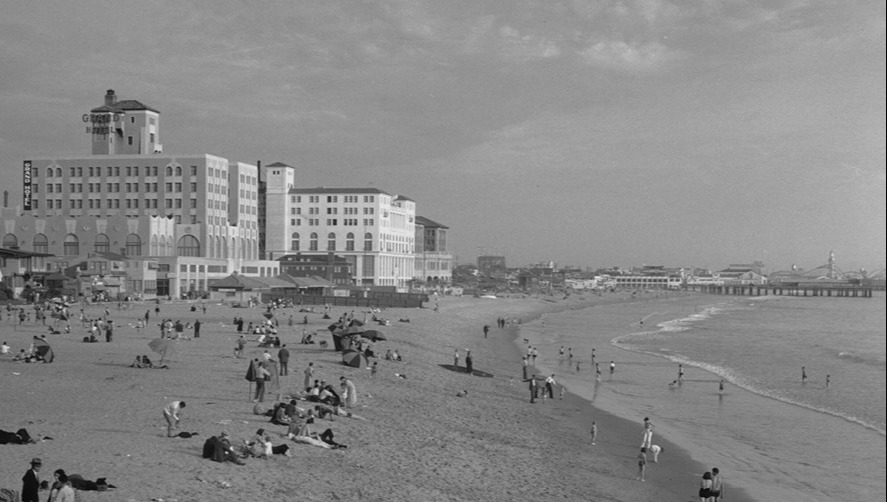 |
|
| (1932)* - Santa Monica beach, with Grand Hotel, Edgewater Beach Club, Casa del Mar, and other buildings at left. |
Historical Notes “Resort and Hotel Notes,” Los Angeles Times, 10 July 1932. The article states: The opening of the Grand Hotel on the ocean front at Pico Boulevard last Wednesday was one of the most important of early summer events in Santa Monica. Formerly occupied by an exclusive beach club the building has been remodeled and redecorated to conform to the highest of hotel standards. |
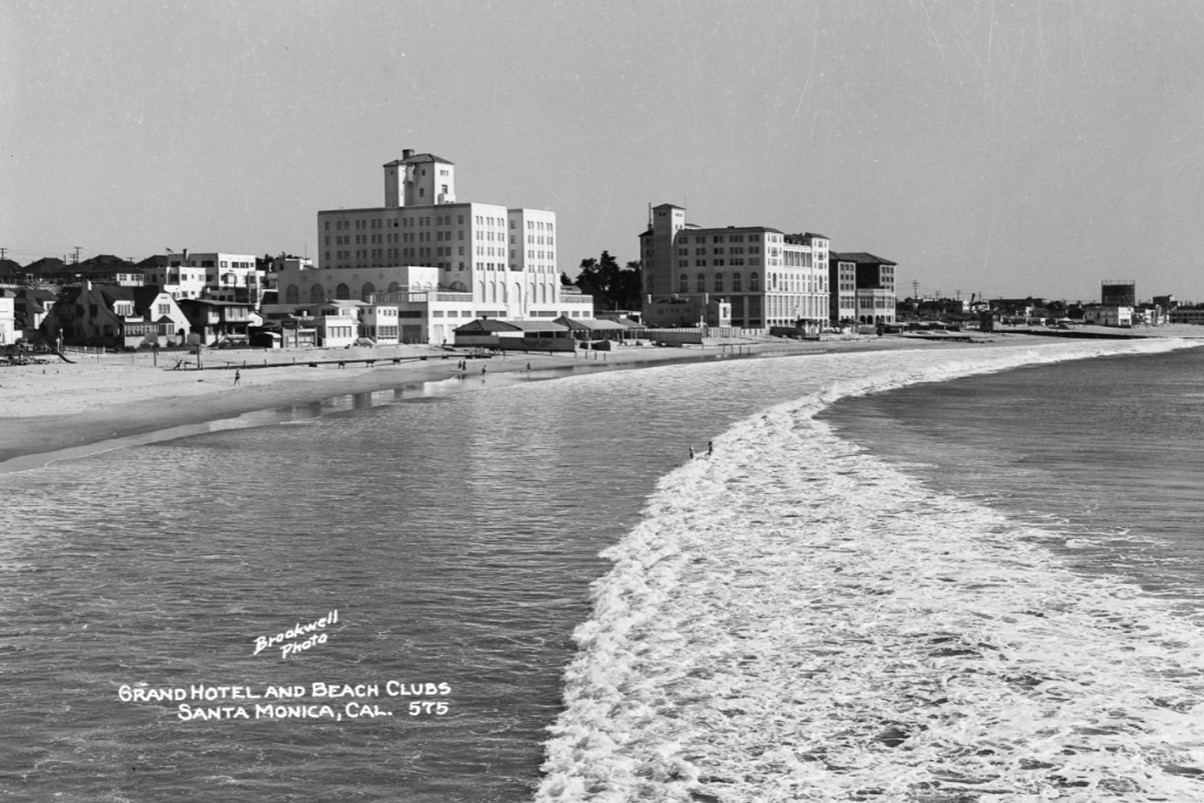 |
|
| (1930s)* - Image of the beach and surf in front of three multi-story beach clubs (from left to right): the Waverly Club, Edgewater Club and Casa Del Mar in south Santa Monica, California. The hotel in the foreground has a sign that reads "Waverly Club" on a partition on the beach. |
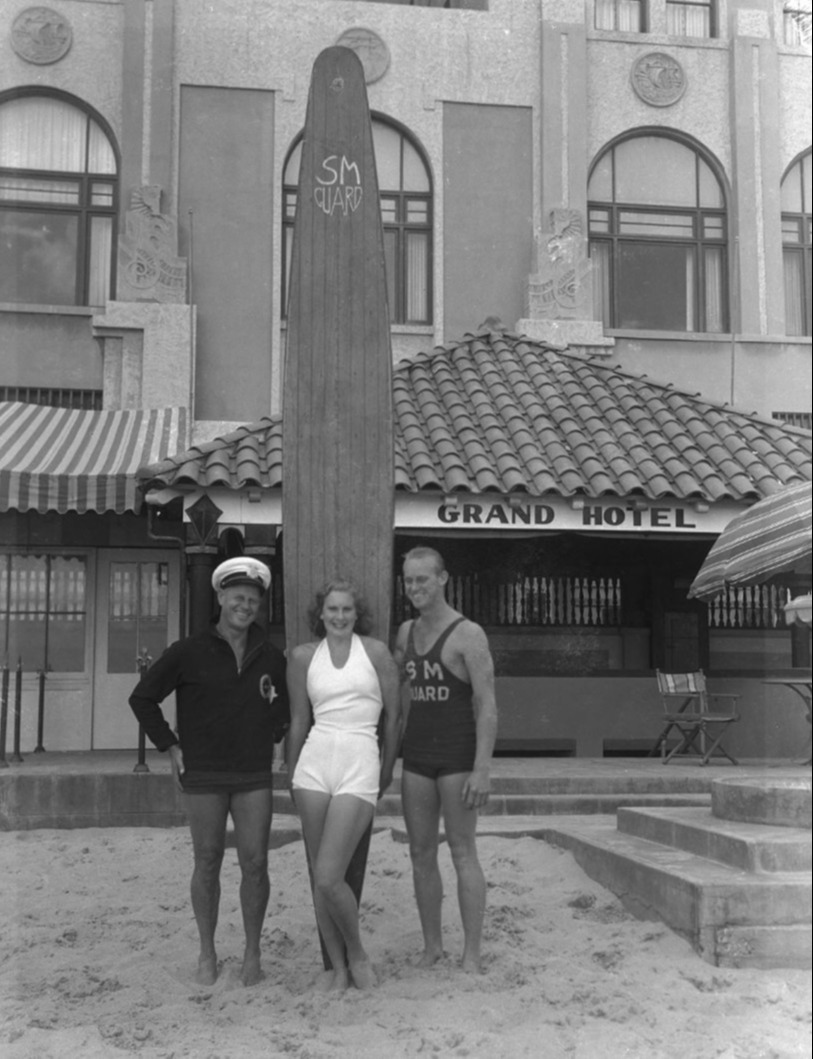 |
|
| (1933)* - Swimmer Helene Madison and Santa Monica lifeguards at Grand Hotel, Santa Monica, |
Historical Notes Helen Madison won three gold medals in freestyle event at the 1932 Summer Olympics in Los Angeles, becoming, along with Romeo Neri of Italy, the most successful athlete at the 1932 Olympics. |
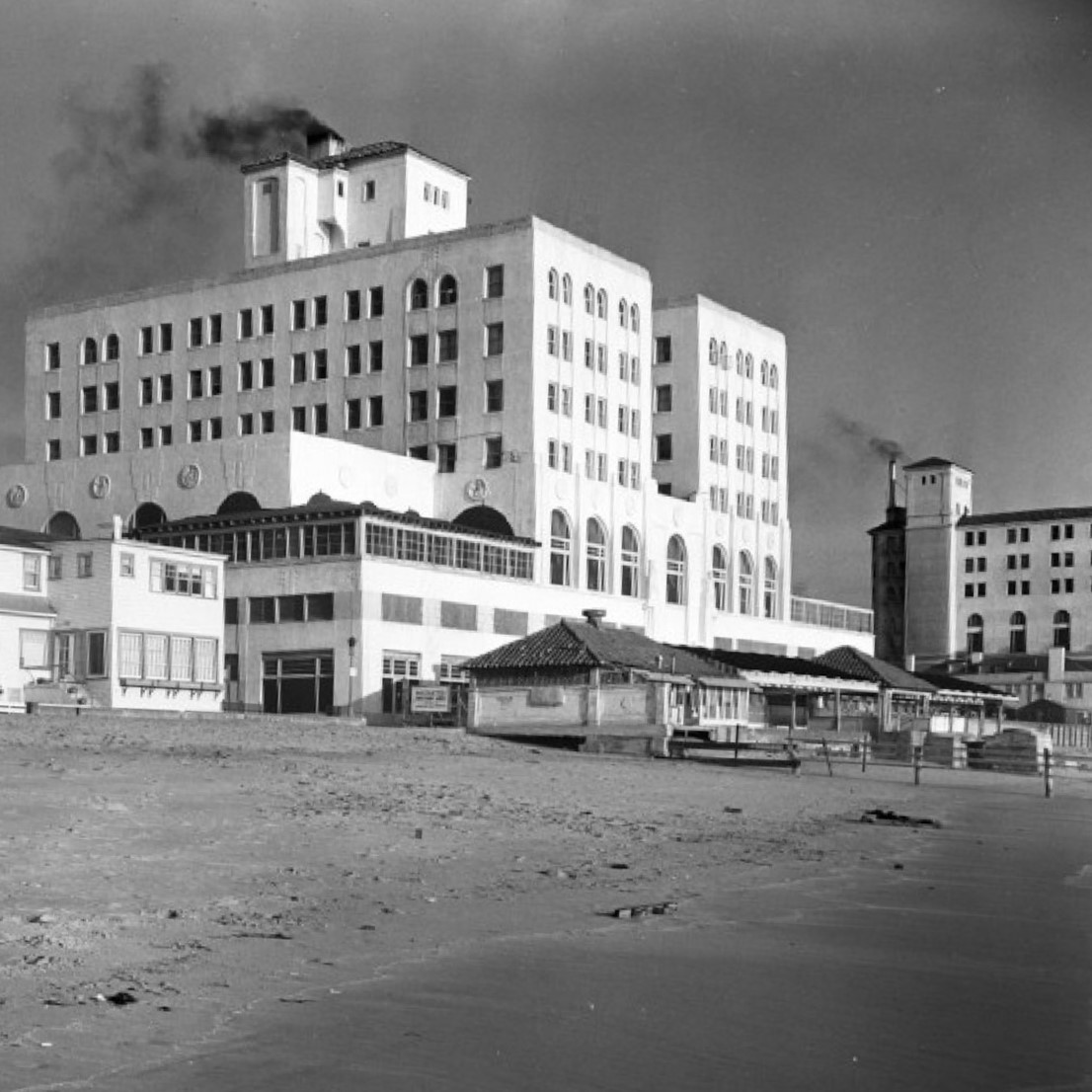 |
|
| (1944)* - The Grand Hotel, later renamed Chase Hotel, eventually became what we know today as the Sea Castle Apartments. Located on the beach in Santa Monica, between Ocean Front Walk and Appian Way, north of Pico Blvd. |
Historical Notes The Breakers Beach Club, founded in 1926, was converted into the Grand Hotel in 1934. Today it is the Sea Castle Apartments. |
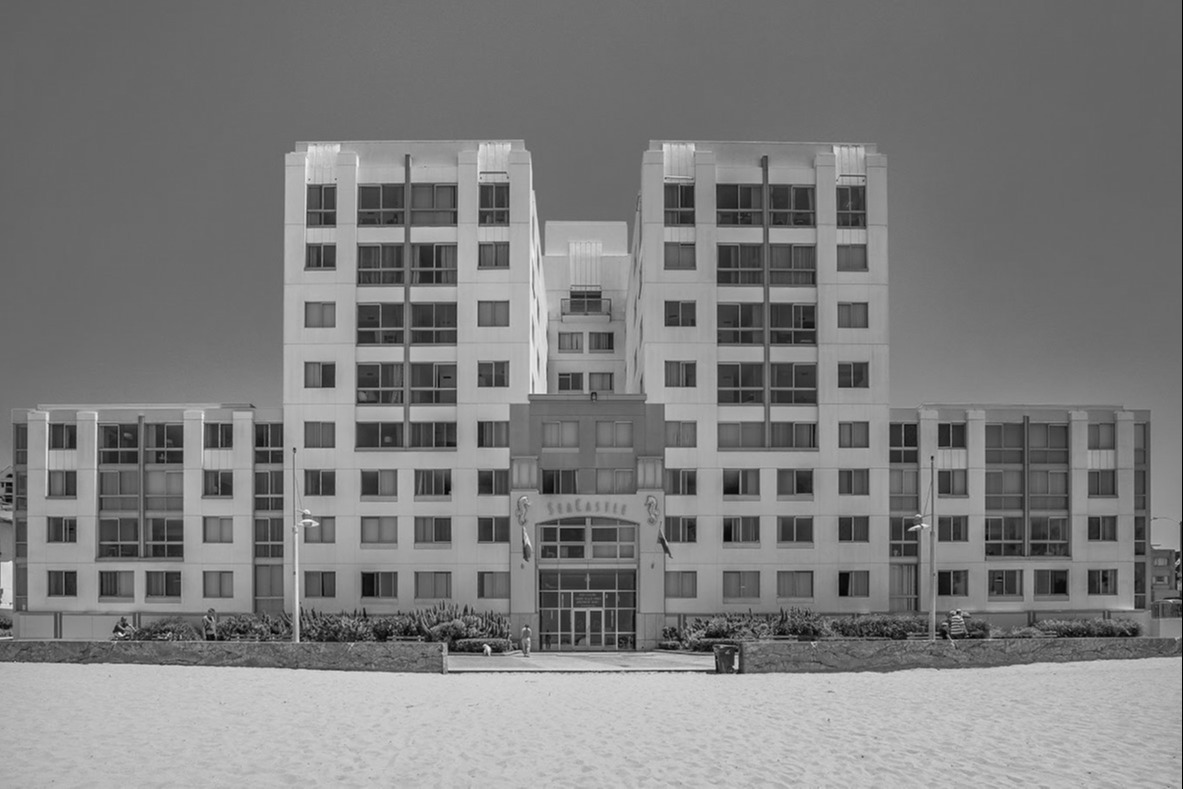 |
|
| (2019)* - The Sea Castle (previously Grand Hotel) was red-tagged after the 1994 Northridge Earthquake and rebuilt to what we see above, 178-unit, 8 story apartment building. Photo courtesy of Patrick Carroll |
Historical Notes This is actually a new building which replaced the previous one. The older building was irretrievably damaged in the Northridge quake. |
Club Casa del Mar
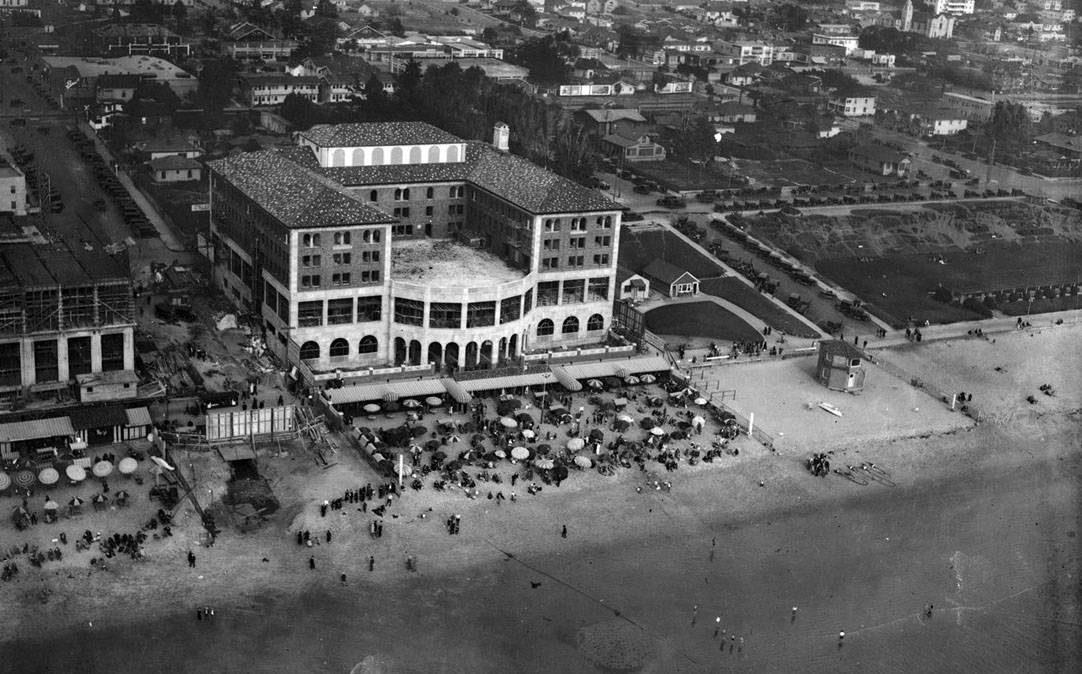 |
|
| (1926)* - Aerial view looking east showing the beach and Club Casa del Mar in Santa Monica. Construction of the Edgewater Club can be seen at left edge of image, north of Pico Boulevard. Huntington Library |
Historical Notes Club Casa del Mar opened in 1926 at the foot of Pico Blvd. The building was constructed by brothers E.A. "Jack" Harter and T.D. "Til" Harter, doing business as the H & H Holding Company, at a cost of $2 million. It opened as Club Casa del Mar, a private beach club, on May 1, 1926. Designed by Los Angeles architect Charles F. Plummer to reflect an Italian Renaissance Revival aesthetic. |
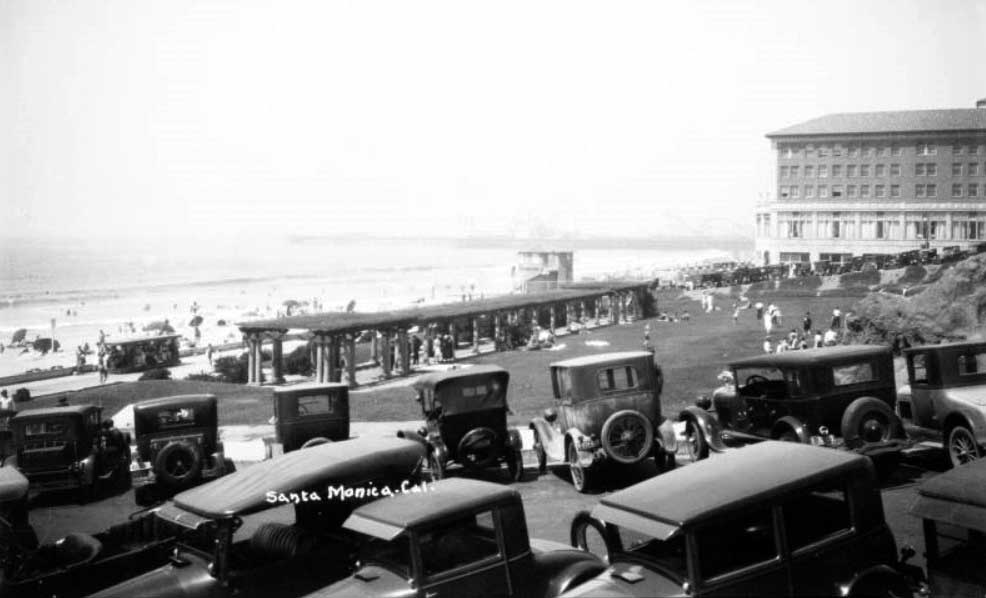 |
|
| (ca. 1927)* - View of the beach in Santa Monica looking north from a a full parking lot. Beyond the parking lot is a large grassy area with a covered walkway running down the middle. The Club Casa del Mar stands in the upper right. The pier in the distance is barely visible through a light fog. An electric vehicle (left-center) is seen transporting passengers along the walkway that parallels the beach. |
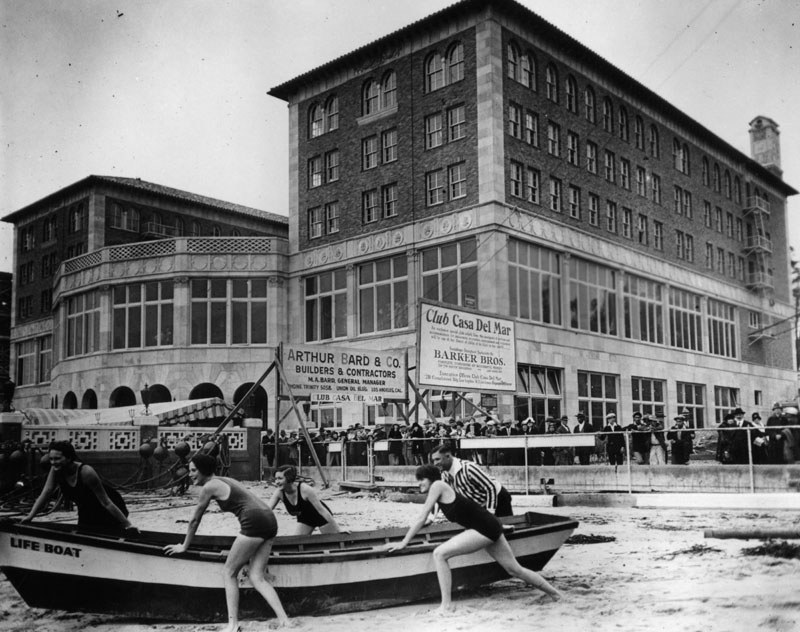 |
|
| (ca. 1926)* - Life boat drill with male and female lifeguards outside the new Club Casa del Mar, a private beach club at 1901 Promenade, Santa Monica. |
Historical Notes Lifeguard services were initially developed during the early 1900s in response to the rise in popularity of the beach. Several municipalities had their own service before combining forces with Los Angeles County in the 1970s, creating the world's largest professional lifeguard service. |
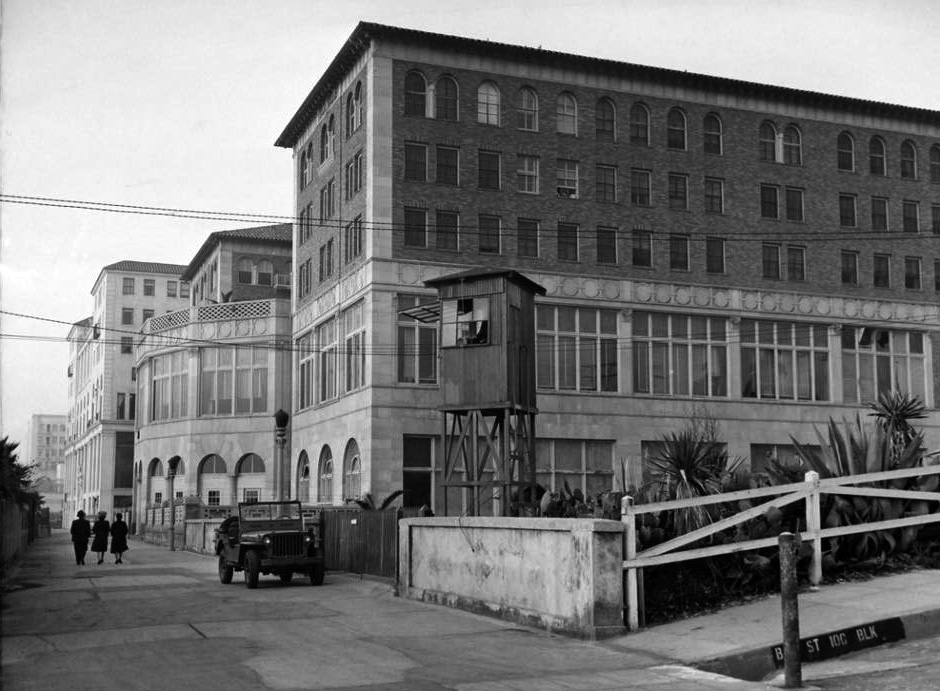 |
|
| (1945)^ – View showing the Del Mar Club when it was used as US Navy relocation center. |
Historical Notes In 1941, the US Navy took over the building, utilizing it for enlisted soldiers during World War II. By 1960, the hotel was shuttered. In 1967, Charles E. Dederich reopened the building as the Synanon Foundation, a drug rehabilitation program. In 1978, Nathan Pritikin turned the building into the Prikikin Longevity Center, a nutrition and health care facility that closed in 1997. |
 |
|
| (1953)^ - View of the beach in front of the Club Casa del Mar. A variety of designs are on display as umbrellas cover the beach. |
Historical Notes In 1998, The Edward Thomas Hospitality Corporation acquired the building and converted it into a luxury hotel called the Casa del Mar Hotel.* The Casa del Mar Hotel is listed on the National Register of Historic Places. |
Then and Now
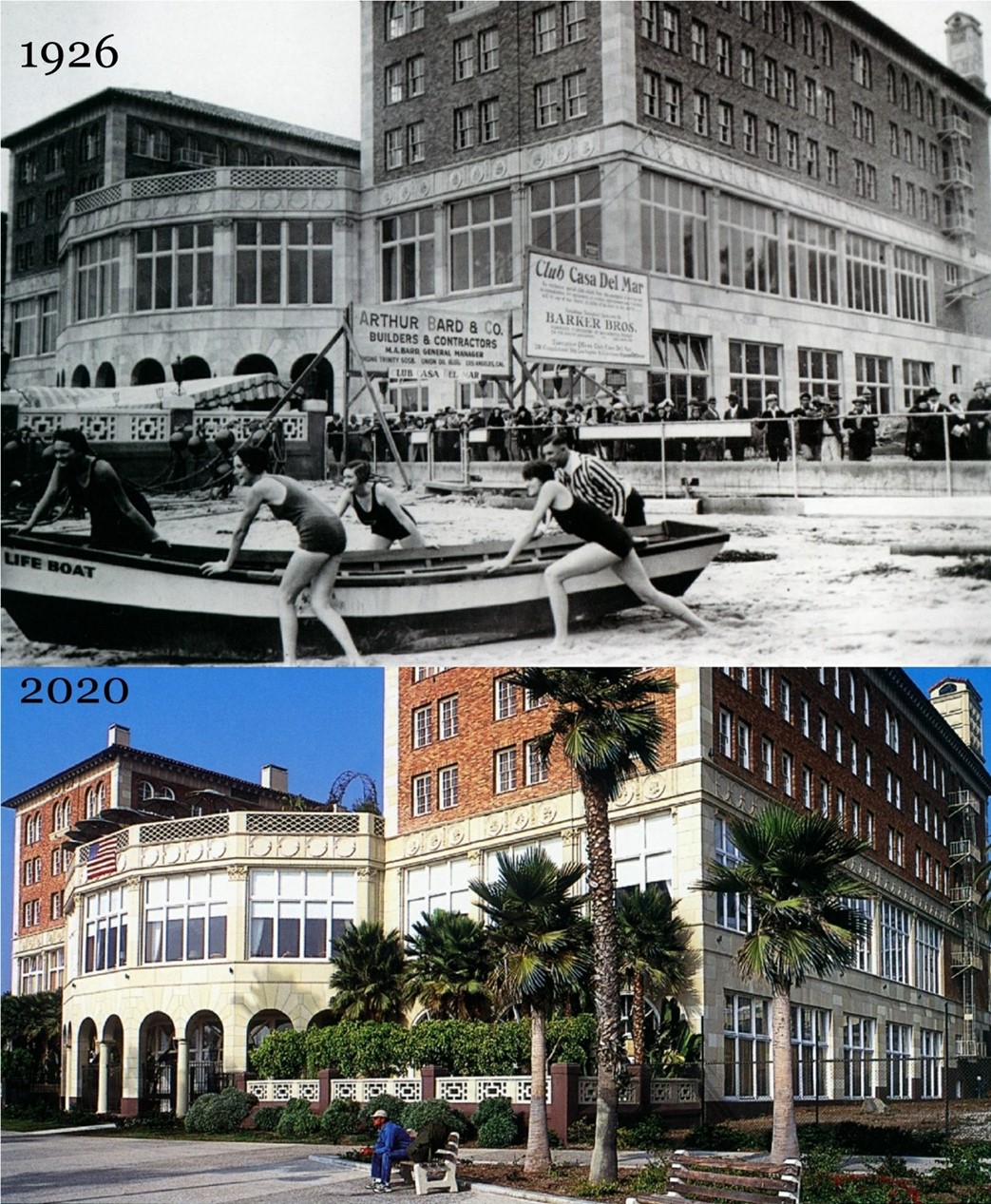 |
|
| Then and Now – Photo Courtesy of Augie Castagnola* |
* * * * * |
Palisades Park Views (1920s)
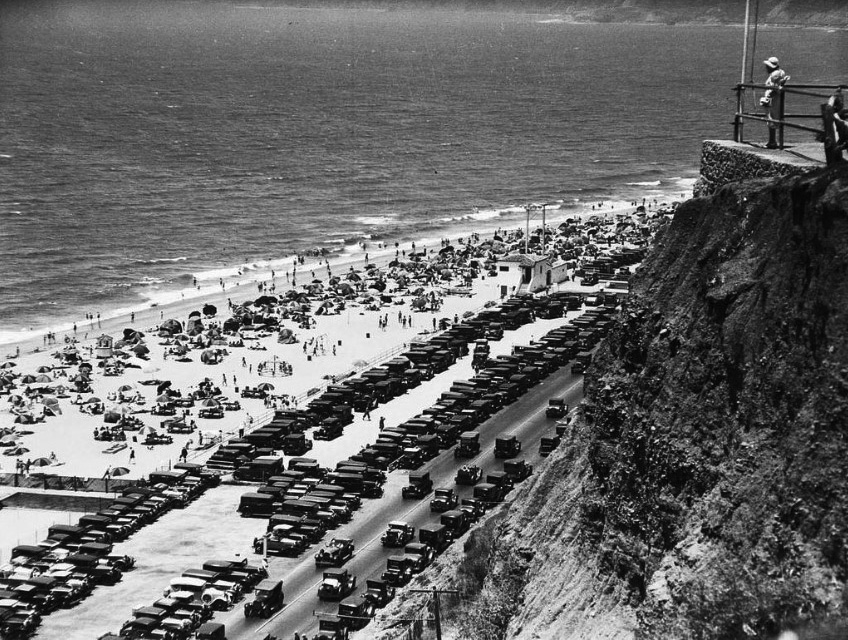 |
|
| (1924)* – A woman stands at the edge of the Pacific Palisades looking down at a crowded Santa Monica Beach and Roosevelt Highway. |
Historical Notes Palisades Park in Santa Monica during the 1920s was a vibrant and picturesque urban oasis overlooking the Pacific Ocean. Established in 1892, the park had evolved significantly by the 1920s, featuring a 1.6-mile stretch along Ocean Avenue with breathtaking views of both the ocean and coastal mountains. |
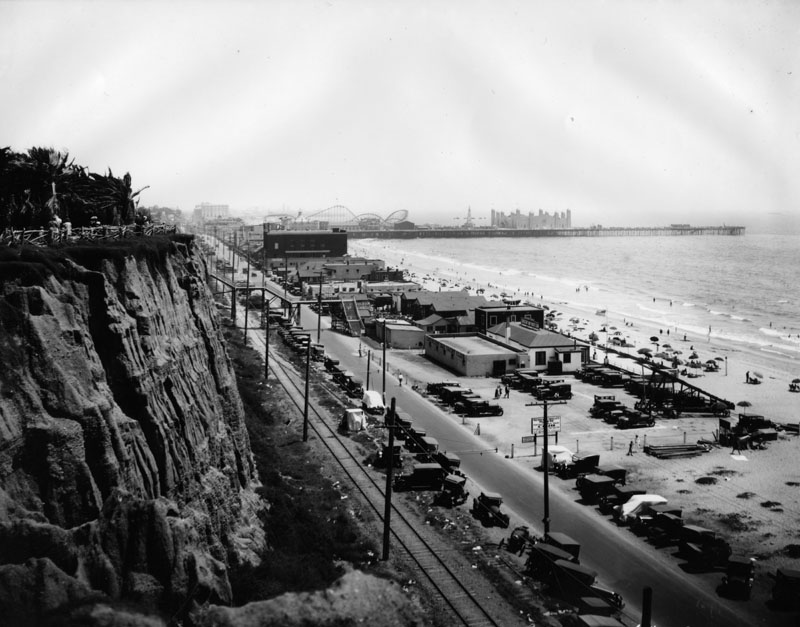 |
|
| (1927)* - Photo shows people on the top of the Palisades (left), which overlooks Santa Monica beach. The buildings, cars parked along the highway, and the crowds on the beach can be seen. The pier and amusement park is in the background. A new concrete staircase is seen that connects the top of the palisades to the beach. |
Historical Notes The steps and bridge seen in the above photo are at the same location as the original '99 Steps" built in 1875. When the Pacific Coast Highway was built in 1927, new concrete steps and a bridge over the highway were built to allow for continued beach access. Click HERE to see more on the original 1875-built '99 Steps". |
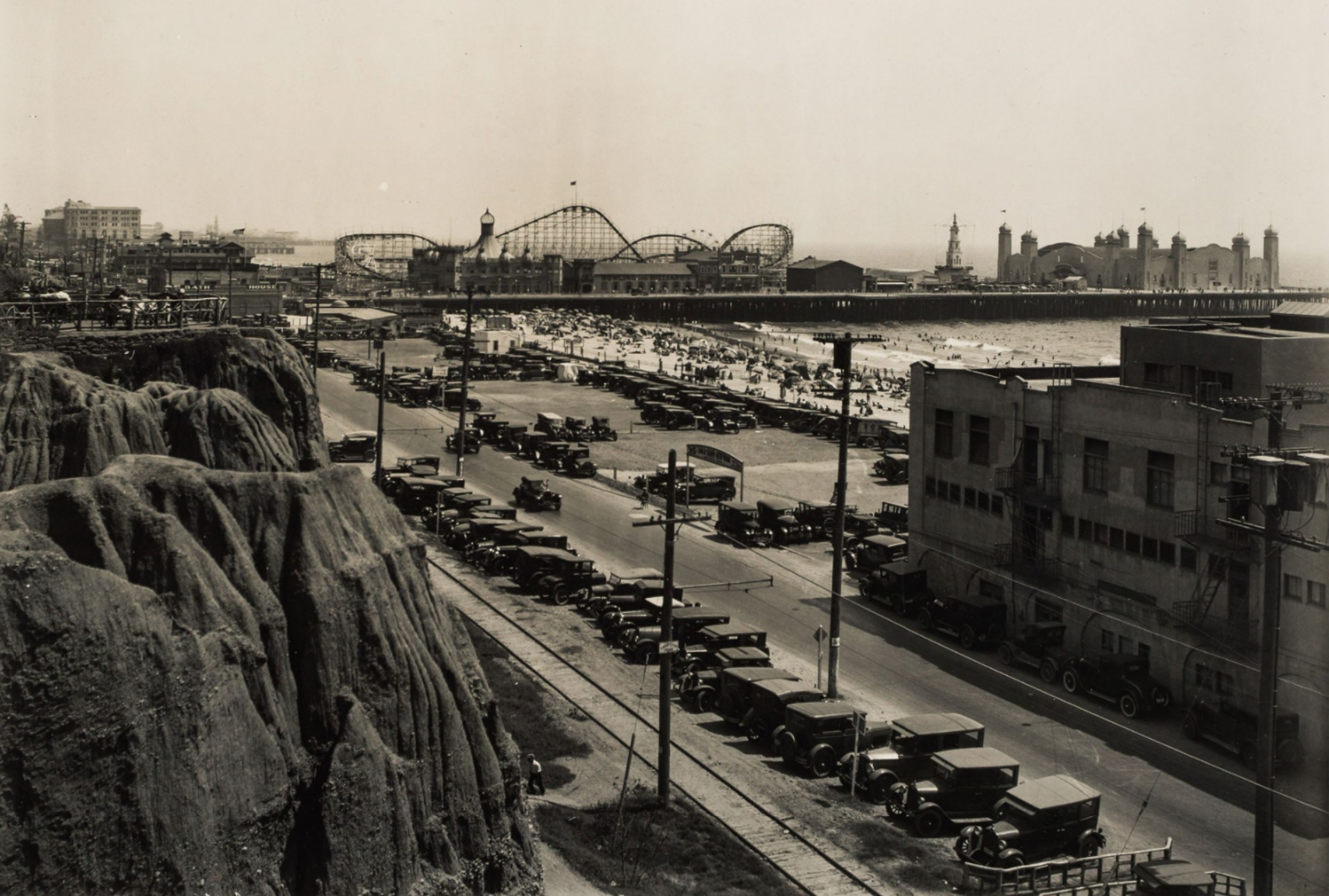 |
|
| (1927)* – Looking down from Palisades Park at Beach Road (later Roosevelt Highway and Pacific Coast Highway), with cars parked along the tracks. To the right is the Santa Monica Athletic Club. In the distance, the Santa Monica Pier features the Whirlwind Dipper roller coaster and La Monica Ballroom. Photo from the Ernest Marquez Collection. |
Historical Notes Beach Road in Santa Monica became Roosevelt Highway in 1927. The road was then renamed Pacific Coast Highway (PCH) in 1941. |
* * * * * |
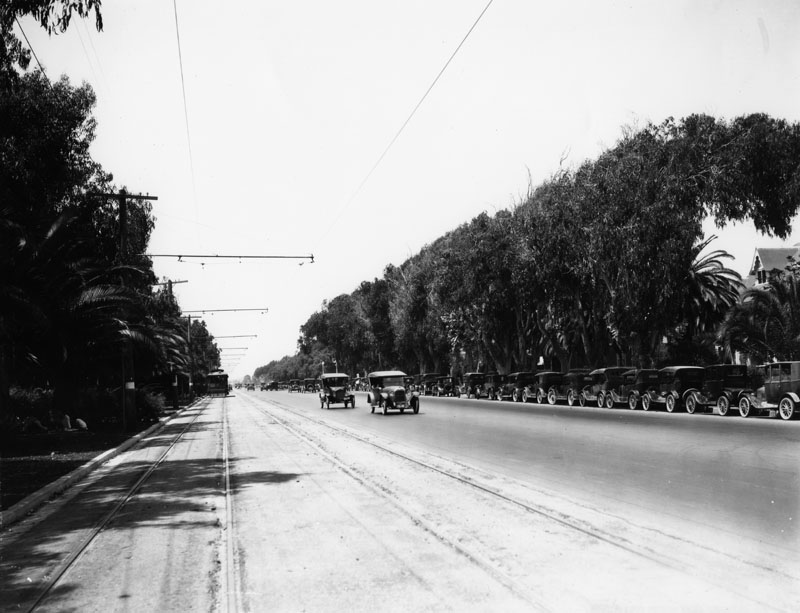 |
|
| 1927)* - View of Ocean Avenue shows many cars parked on one side of the road. A trolley can be seen in the distance. |
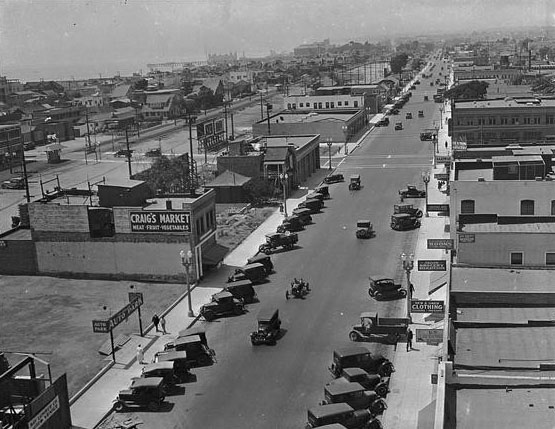 |
|
| (1928)* - Bird's-eye view of Main Street and surroundings, looking west-northwest toward Ashland Avenue, showing businesses, cars, pedestrians, and houses, with Santa Monica Pier in background. |
* * * * * |
Van De Kamp's
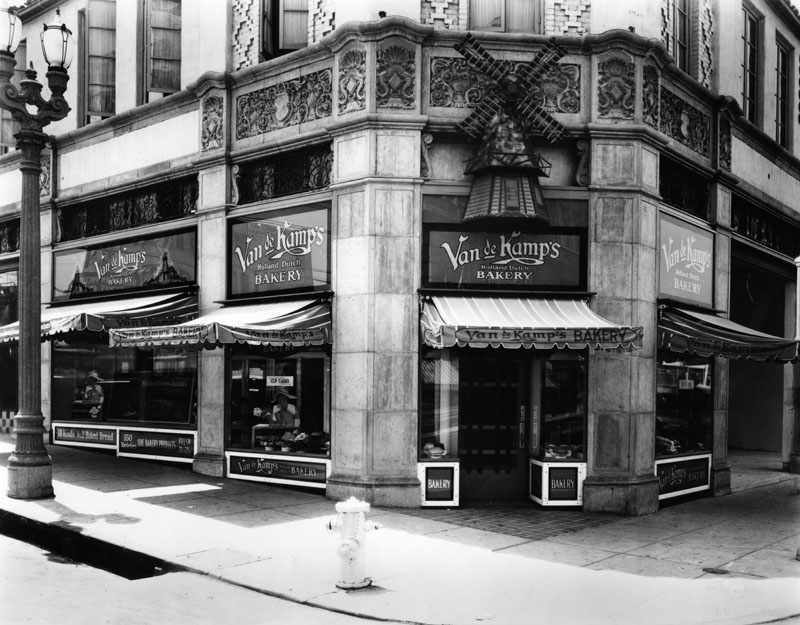 |
|
| (1929)* - An exterior corner view of the Parkhurst Building which here housed the Van De Kamp's Bakery on the bottom floor. Located at 185 Pier Ave. in Ocean Park. |
Historical Notes Built in 1927, the Spanish Colonial Revival style building was designed by architects Marsh, Smith & Powell. Norman F. Marsh also planned the arcaded streets and canals of Venice. |
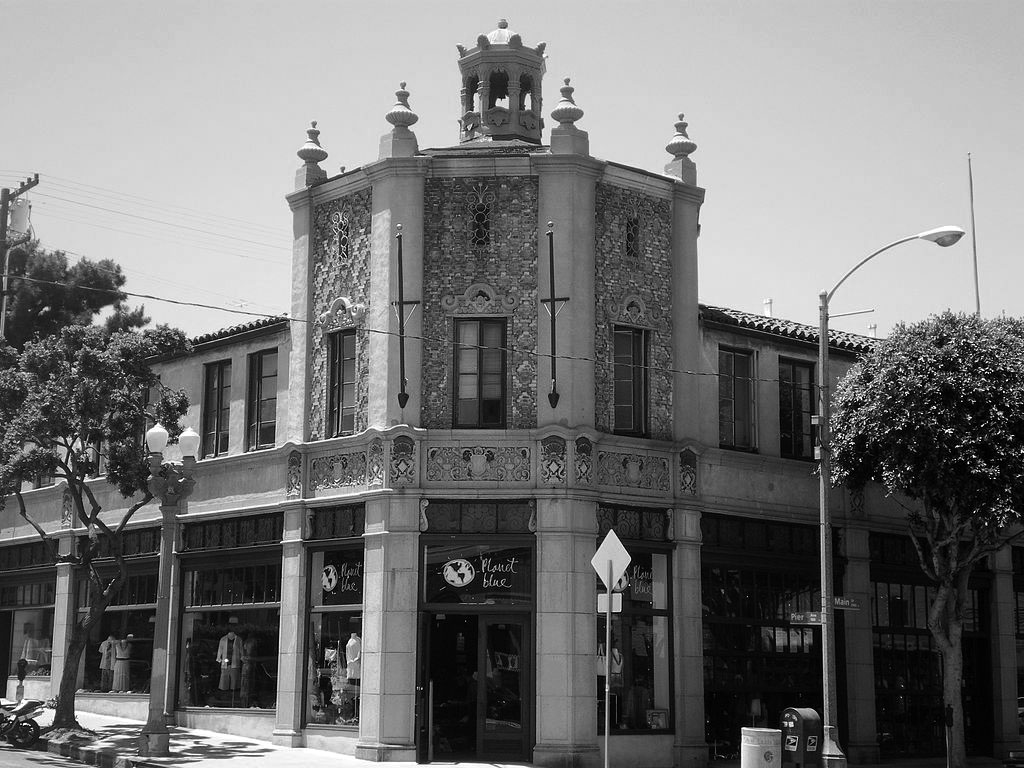 |
|
| (2008)*^ - View of the Parkhurst Building as it appeared in 2008. The sign on the front door reads: "Planet Blue". |
Historical Notes The Parkhurst Building was included in the National Register of Historic Places, California Register of Historic Places and designated as a Santa Monica landmark. |
* * * * * |
Douglas Company Plant
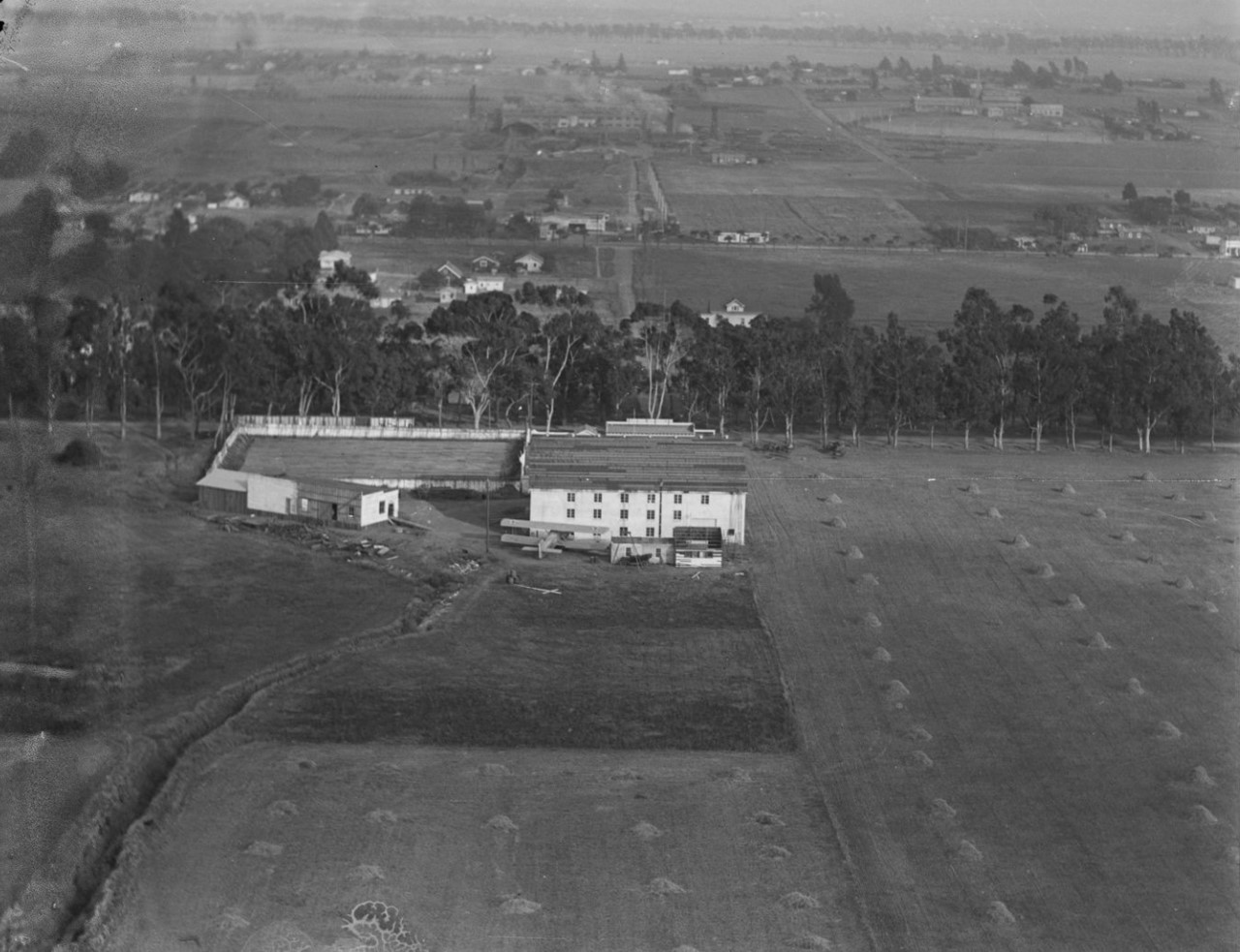 |
|
| (1922)* - Aerial view of the buildings of the Douglas Company plant (incorporated as the Douglas Aircraft Company in 1928) and surrounding fields along Wilshire Boulevard in Santa Monica, with a DT-2 biplane parked next to the main building. The Douglas Company leased the abandoned film studio buildings of the Herrman Film Corporation in 1922. Photo from the Ernest Marquez Collection. |
Historical Notes Founded by Donald Wills Douglas Sr. in 1921, the Douglas Aircraft Company began in a small facility on Wilshire Boulevard at 25th Street in Santa Monica. Initially operating as the "Douglas Company," its early operations were modest, with the company even starting out in the back of a barbershop. In 1922, as the company sought to expand, Douglas Aircraft leased the abandoned film studio buildings of the Herrman Film Corporation. This move provided the company with additional space and resources to grow its operations. The expanded facilities proved crucial as the company worked on one of its most significant early achievements: the production of the Douglas World Cruiser. |
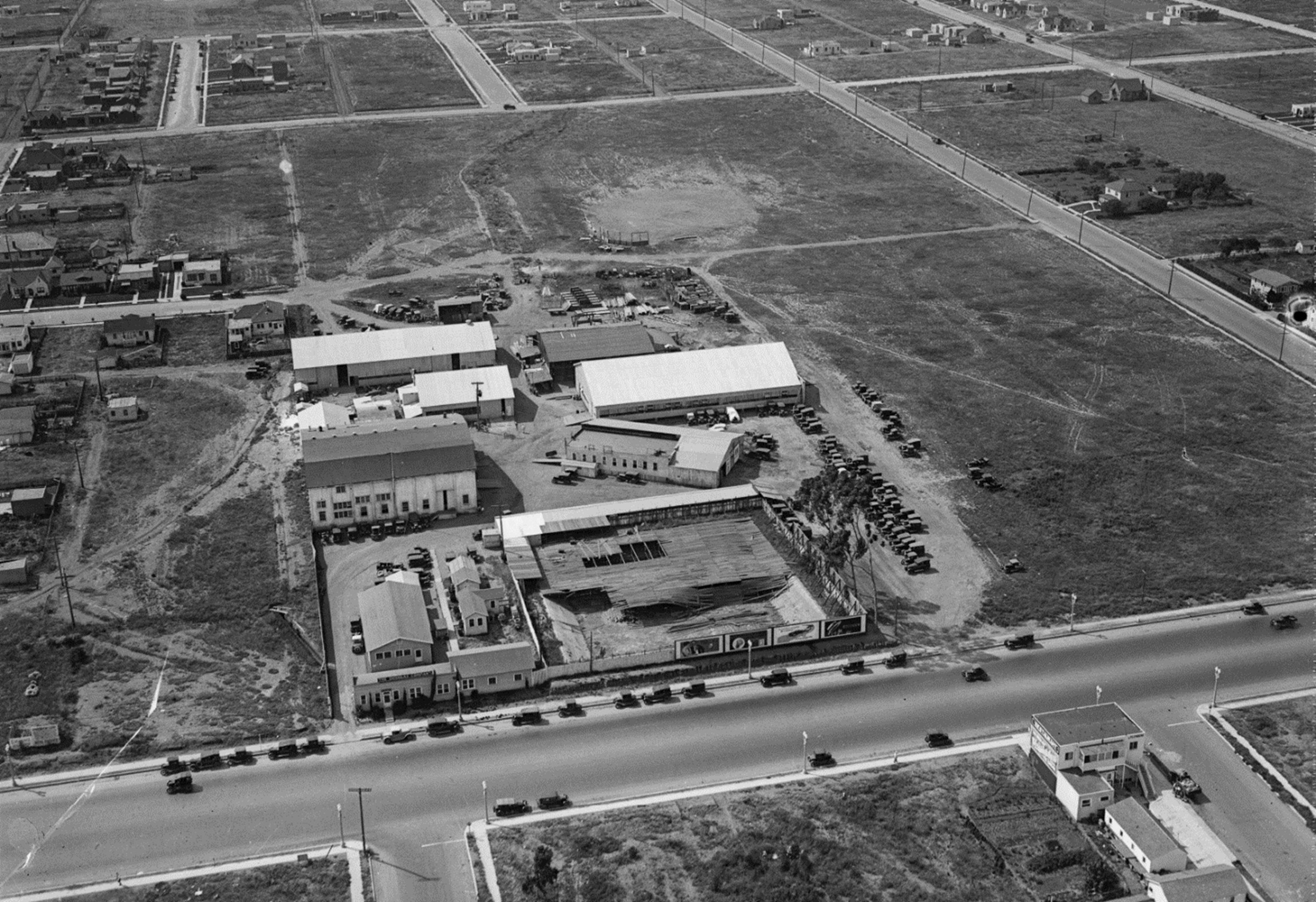 |
|
| (1925)* - Aerial view of the buildings of the Douglas Company plant and surrounding fields and buildings along Wilshire Boulevard in Santa Monica, with billboard advertisements visible along the fence at right. Photo from the Ernest Marquez Collection. |
Historical Notes In 1924, the Douglas World Cruiser became the first aircraft to successfully circumnavigate the globe, a feat that brought the company international recognition and established it as a major player in the aviation industry. Despite the success, the limitations of the Wilshire Boulevard and leased Herrman Film Corporation facilities soon became apparent as the company's military contracts and production demands grew. By the late 1920s, the need for a larger and more strategically located facility led Douglas Aircraft to relocate to Clover Field in Santa Monica. This move allowed the company to expand its production capabilities and continue its trajectory of success, but the original plant remains a significant part of the company's early history, marking the humble beginnings of what would become a powerhouse in the aerospace industry. |
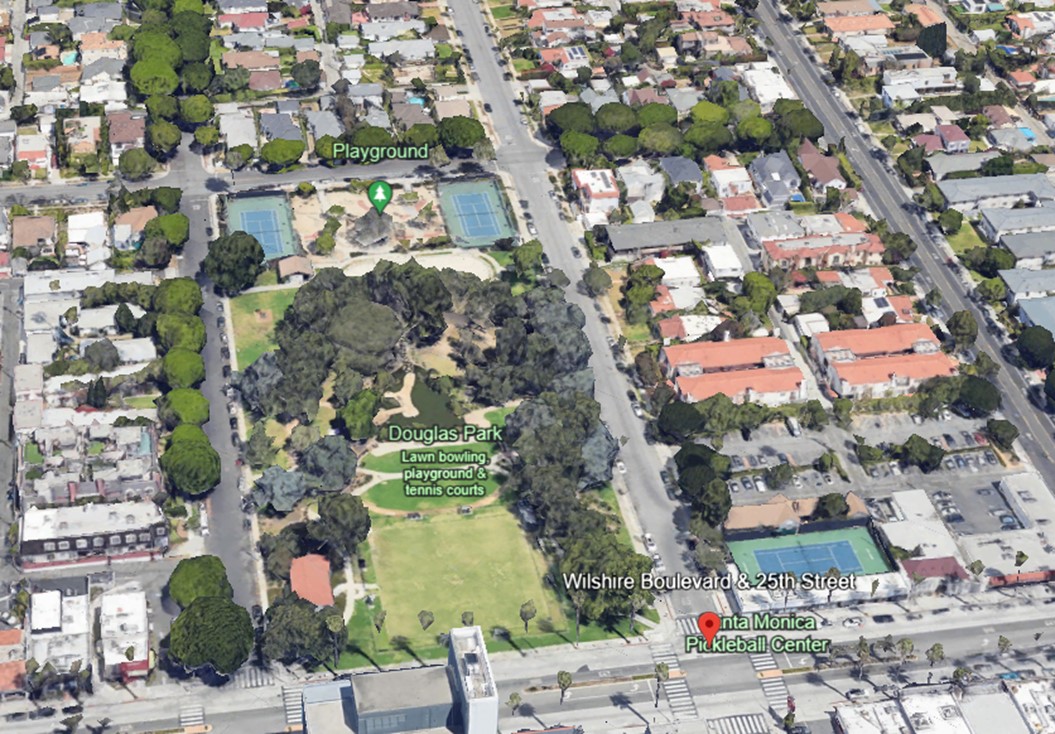 |
|
| (2020s)* - Google Earth view looking down at the Douglas Park on Wilshire Boulevard and 25th Street in Santa Monica. This was the sight of the Douglas Company Plant from 1920 to 1927. |
Historical Notes Douglas Park in Santa Monica has a rich history that reflects its transformation from an industrial site to a cherished public space. Originally, the land where Douglas Park is located was used as an aircraft factory for the Douglas Aircraft Company, founded by Donald Douglas. The site also served as a movie studio lot. However, due to the limitations posed by the surrounding trees, which affected aircraft takeoff, the factory operations were moved to Clover Field (now Santa Monica Airport) in 1927. Following the relocation of the factory, the city of Santa Monica decided to repurpose the land into a public park. The park's design was entrusted to architect Ed Howard, and construction took place between 1931 and 1933. Initially named Padre Park, it was later renamed Douglas Park in honor of Donald Douglas. Douglas Park spans 10.7 acres and features a variety of recreational facilities. These include two tennis courts, picnic areas, a children's playground, a clubhouse, and a lawn bowling green that hosts the Santa Monica Bowls Club. The park is also home to three reflecting pools and the largest municipal pond in Los Angeles County, supporting a diverse ecosystem of ducks, turtles, and fish. |
Then and Now
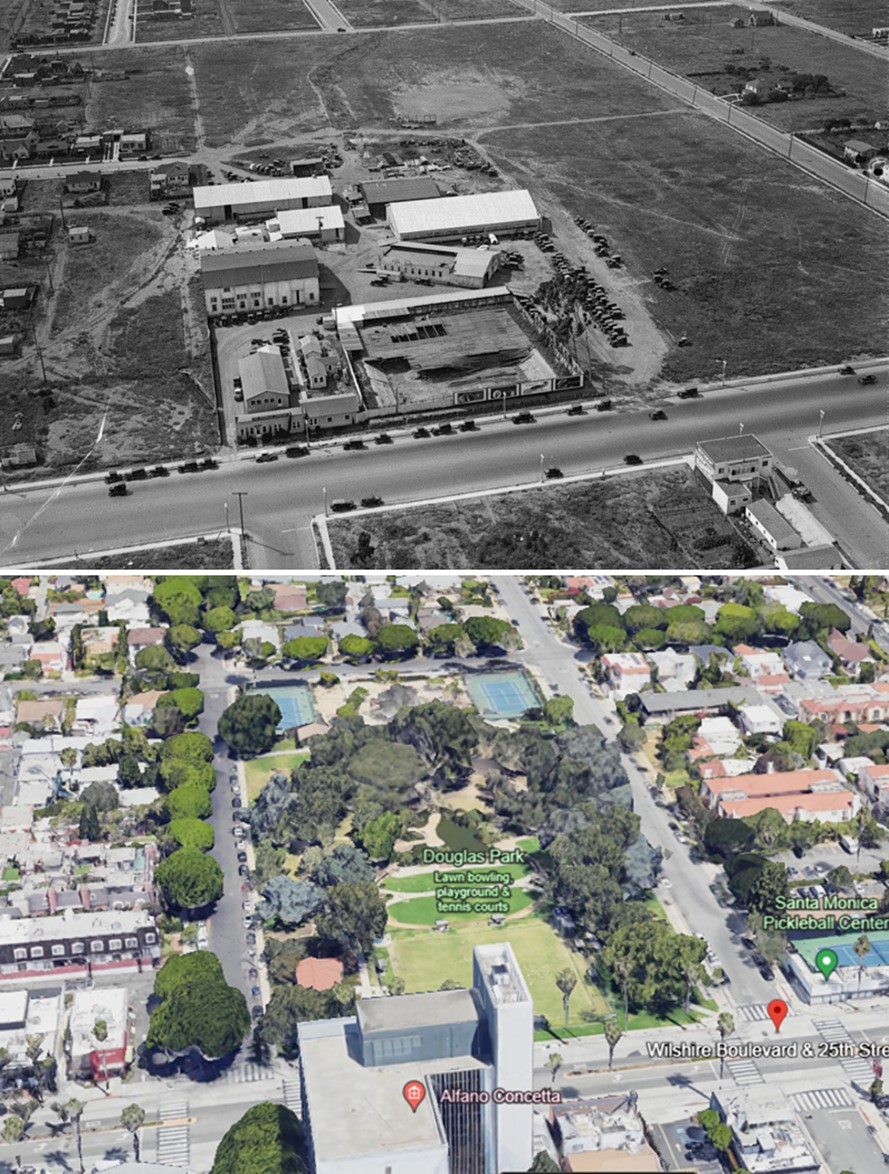 |
|
| (1925 vs. 2020)* - Aerial view looking north over Wilshire Boulevard and 25th Street in Santa Monica, showing the Douglas Aircraft Company Plant, which is now the site of Douglas Park. |
* * * * * |
Clover Field (later Santa Monica Airport)
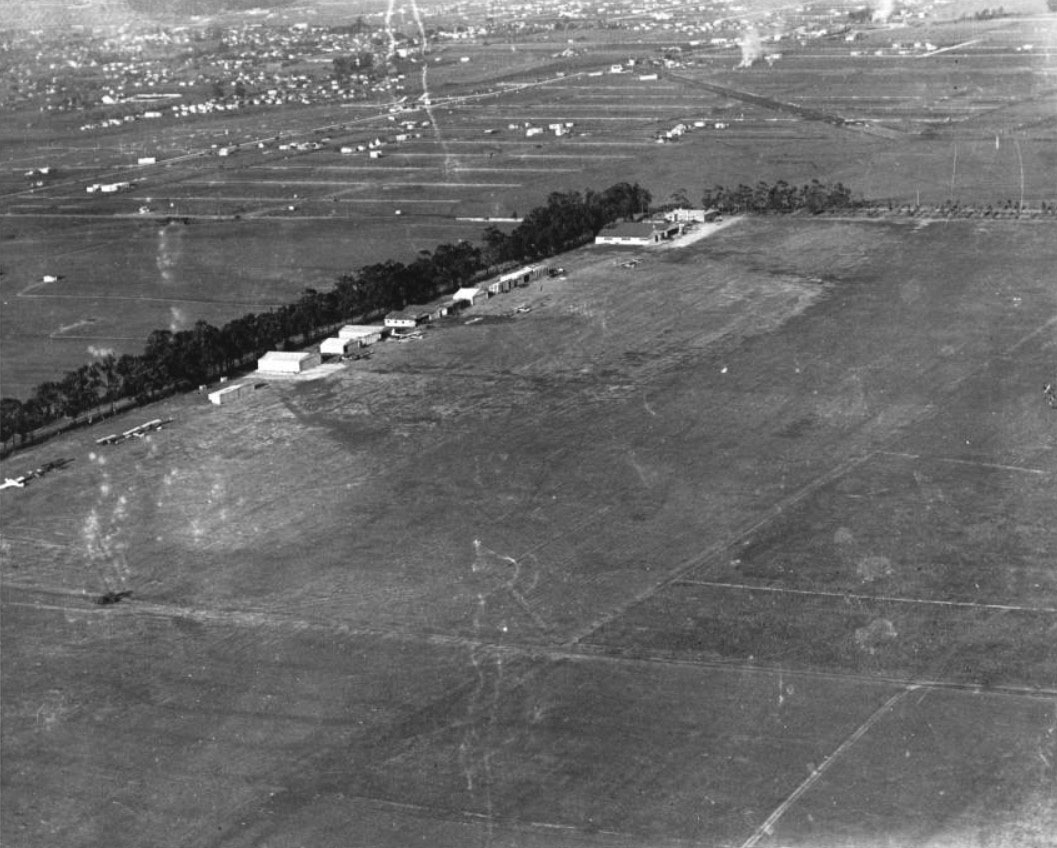 |
|
| (ca. 1924)* - Aerial view of Clover Field Airport in Santa Monica, showing residences in the distance. Hangars and other buildings are seen at center, amidst large expanses of open land. Several airplanes sit in the grass in front of and to the left of the buildings. A row of trees sits behind the building, running diagonally across the upper left corner of the image. |
Historical Notes As early as 1917, aviators were landing on this grassy runway perched atop a mesa just southeast of Santa Monica. It was surrounded by stalks of barley. Soon the landing strip became a military airfield, and in 1922 the U.S. Army named it Clover Field in honor of Greayer Clover, a fighter pilot killed in France during the First World War. Since then the site has served many purposes. First it was the western headquarters of the Army’s reserve air corps, and later Douglas Aircraft produced its line of DC planes there. |
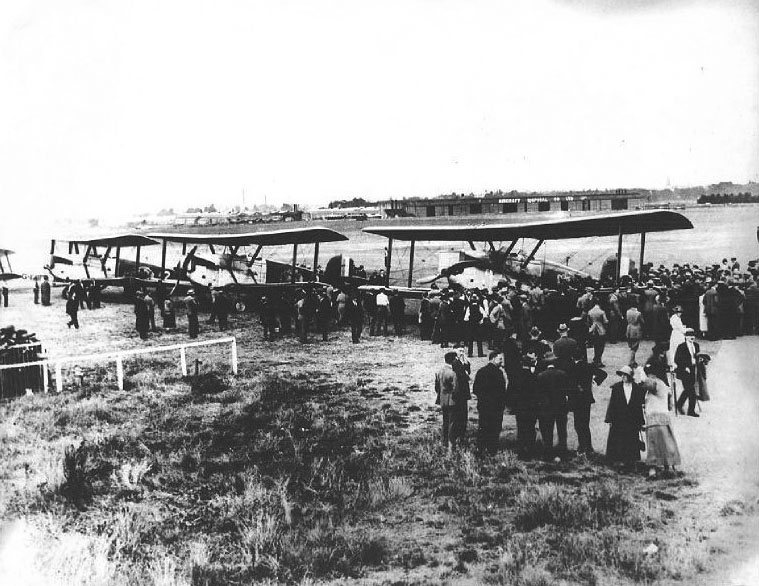 |
|
| (1924)#+# - A growing crowd of spectators at Clover Field inspect the World Cruisers before their epic flight. |
Historical Notes Douglas World Cruiser biplanes are the first aircraft to circumnavigate the globe in the weeks between April and September. The U.S. Army with Douglas World Cruisers, took off from Clover Field on St. Patrick’s day, March 17, 1924, and returned there after some 28,000 miles. |
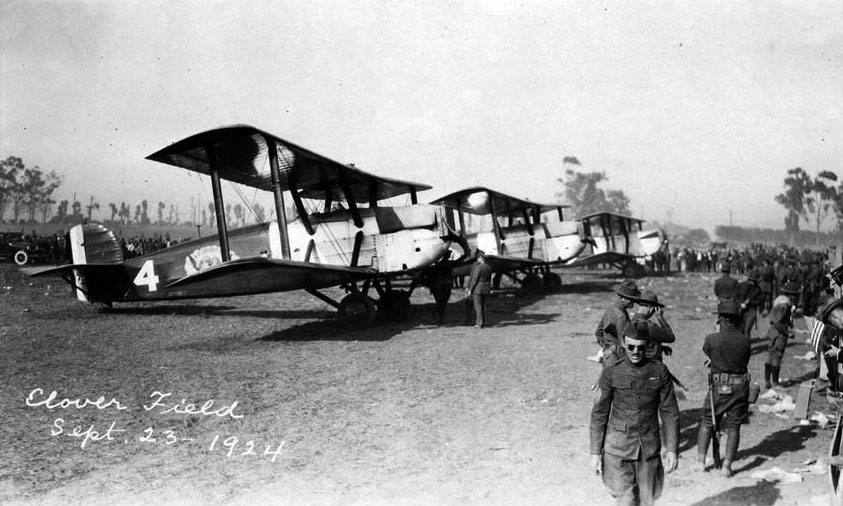 |
|
| (1924)* - "Douglas World Cruisers return to Clover Field, Santa Monica, CA on September 23rd, 1924." |
Historical Notes Two planes made it back, after having covered 27,553 miles in 175 days, and were greeted on their return September 23, 1924 by a crowd of 200,000 (generously estimated). |
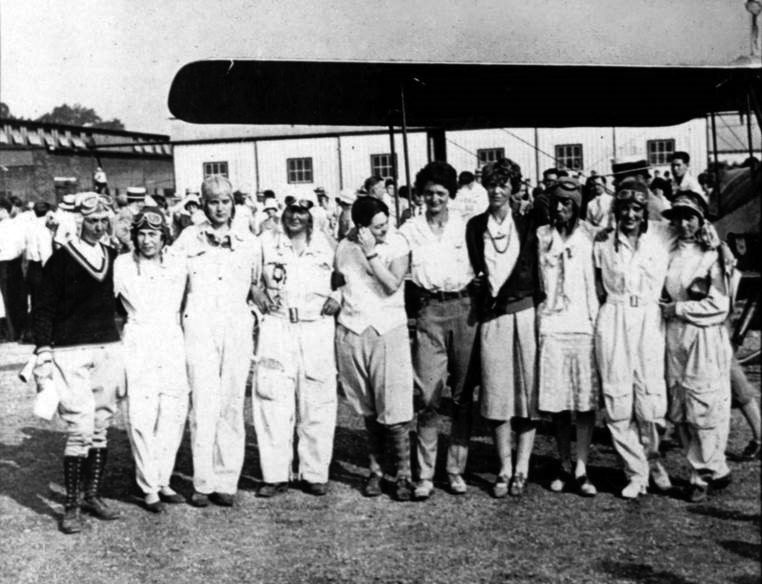 |
|
| (1929)* – View showing some of the female aviators who competed in the first women’s transcontinental air derby which began in Santa Monica on August 18, 1929. Amelia Earhart is fourth from the right. Louise Thaden, who won the 2700-mile race, is fifth from the right. |
Historical Notes In August 1929, seventy women held a United States pilot’s license. Of those, twenty young female aviators assembled at Clover Field on the afternoon of August 18 to take part in the groundbreaking competition. Navigating the 2700-mile course with only road maps on their laps, the women flew from Santa Monica to Cleveland via stops in Arizona, New Mexico, Texas, Oklahoma, Kansas, Missouri, Illinois and Indiana. Along the way, there were continuous mishaps and a constant need for maintenance. Some competitors were forced to drop out of the race. Florence “Pancho” Barnes and Ruth Nichols crashed their aircraft. Margaret Perry contracted typhoid fever. Claire Fahy’s plane was found to have suspicious mechanical damage. Sadly, pilot Marvel Crosson, who had just set an altitude record at 23,996 feet the previous May, perished in a tragic crash. The race continued despite these perils, malfunctions and calamities. And at every stop, enthusiastic crowds gathered to meet the female flyers they had read about in the press. At the Cleveland Municipal Airport, a throng estimated at 18,000 people greeted the pilots as they finished the race. Louise Thaden came in first, and she was followed by fourteen others: Amelia Earhart, Ruth Elder, Edith Foltz, Mary Hazlip, Jessie Keith-Miller, Opal Kunz, Blanche Noyes, Gladys O’Donnell, Phoebe Omlie, Neva Paris, Thea Rasche, Bobbi Trout (finished untimed because of two forced landings), Mary von Mach, and Vera Dawn Walker. The Air Derby set the stage for other major air race competitions for women and supported the notion, highly suspect at the time, that women could be accomplished pilots. The race also strengthened the bonds between the participants and inspired them to organize. A few months later in 1929, most of these female aviators became founding members of The Ninety-Nines, an organization of licensed women pilots founded to promote and support women in aviation. |
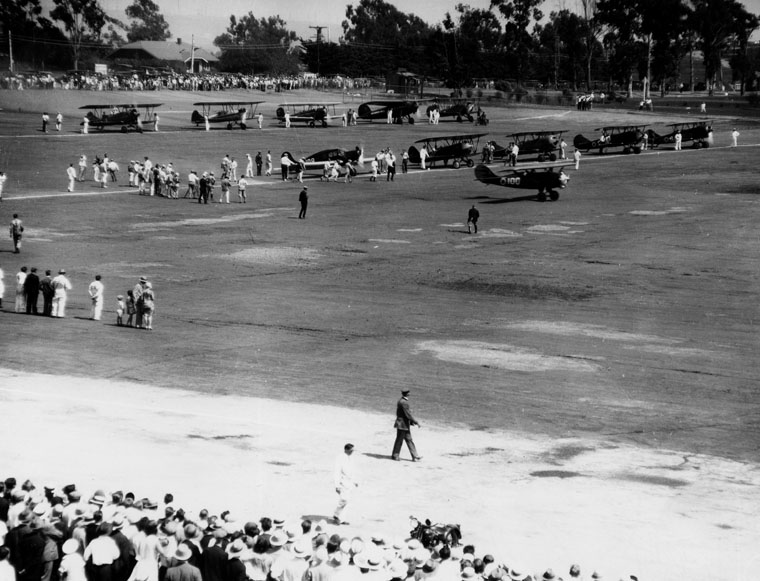 |
|
| (1929)* - Crowds gathered on the sides of Clover Field (Santa Monica Airport) to watch the air show. Several planes are parked on the field, waiting their turns to takeoff. |
Historical Notes On June 15, 1927 Santa Monica City Council changed the name of Clover Field to Santa Monica Airport (SMO). In 1928, the City acquired an additional 60 acres to expand the Airport and to accommodate an expanding Douglas plant. |
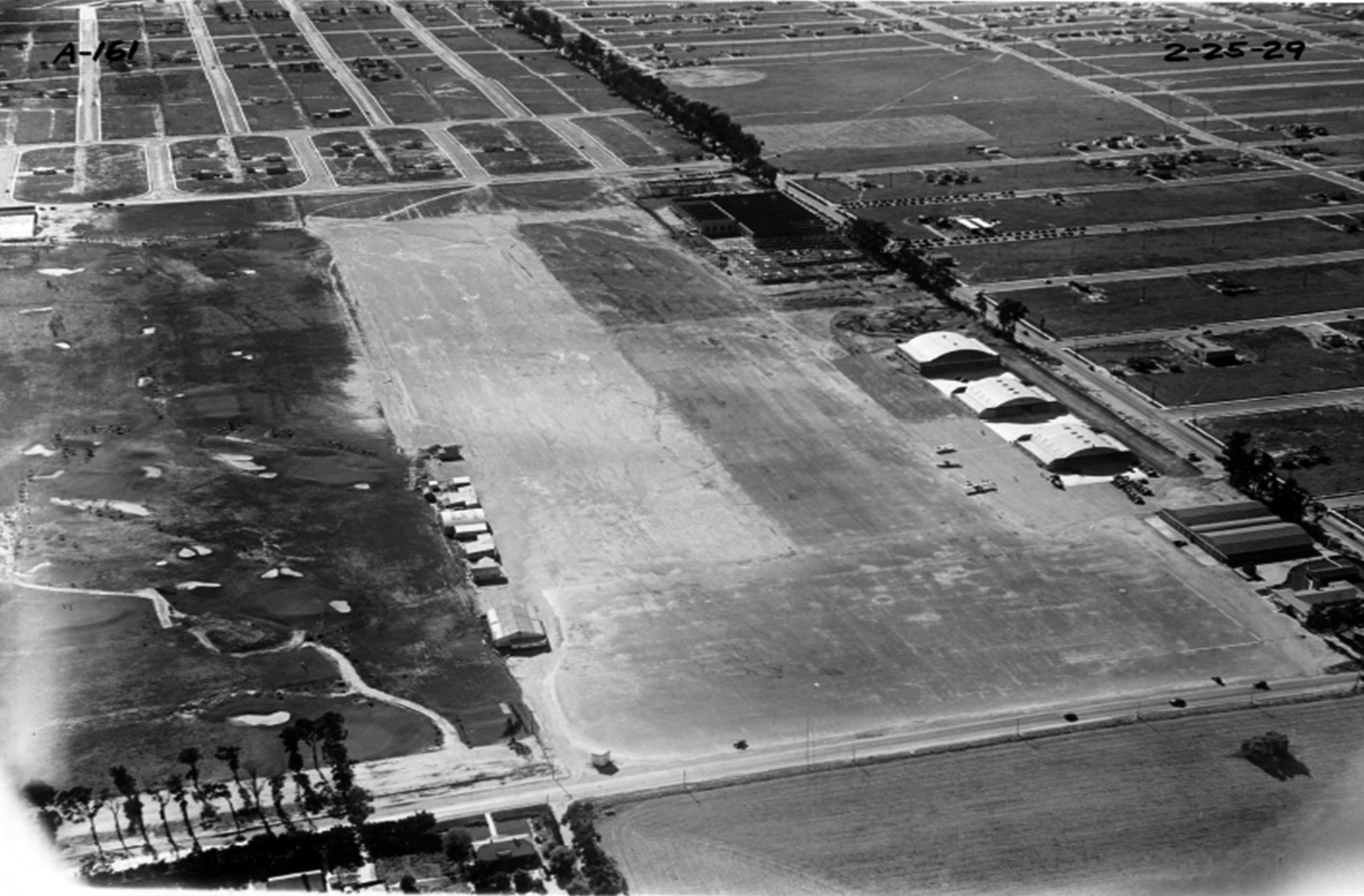 |
|
| (1929)* - View showing the Santa Monica Airport (previously named Clover Field). The Douglas Aircraft plant can be seen on the right. |
Historical Notes Donald Wills Douglas, Sr. founded the Douglas Aircraft Company in 1921 with his first plant on Wilshire Boulevard. He built a plant in 1922 at Clover Field (Santa Monica Airport), which was in use for 46 years. In 1924, four Douglas-built planes took off from Clover Field to attempt the first aerial circumnavigation of the world. Two planes made it back, after having covered 27,553 miles in 175 days, and were greeted on their return September 23, 1924 by a crowd of 200,000 (generously estimated). In 1929, Douglas enlarged its Santa Monica Airport operations, closed other facilities, and began to develop its early DC-2 and DC-3 airliners as well as other projects. |
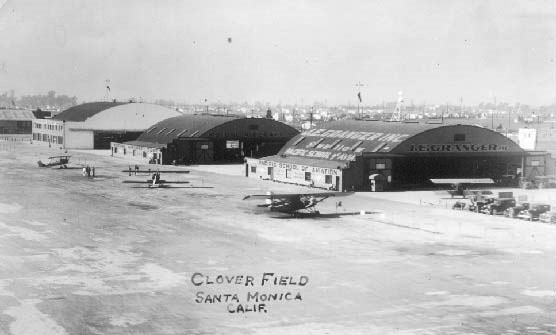 |
|
| (1930s)* – Close-up view of the original three big hangars on the north side of Clover Field. The large hangar at the back is the first Douglas Aviation hangar on the field, circa early 30's. |
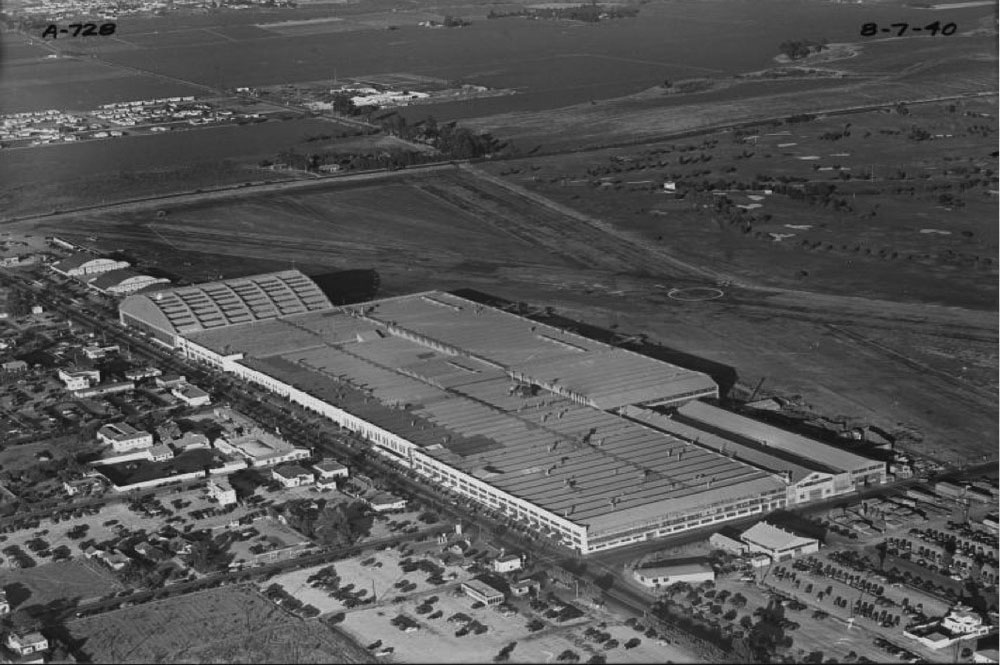 |
|
| (1940)* – Aerial view of the Santa Monica Airport looking towards the southeast with the Douglas plant filling the bottom half of the photo. Photo Date: August 7, 1940 |
Historical Notes Between 1941 and 1944 (During World War II), Douglas Aircraft becomes a major defense contractor, employing up to 44,000 workers who work three shifts, seven days a week. This economic engine transforms the city as thousands of new homes are built for the Douglas workers, creating Sunset Park and other neighborhoods. |
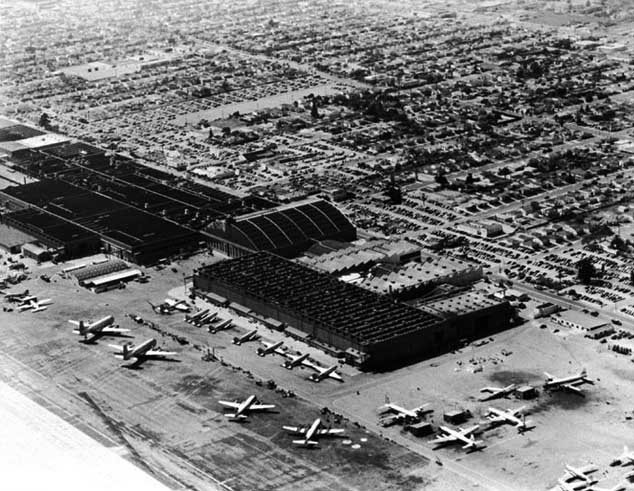 |
|
| (1940s)* - View of Douglas Aircraft with numerous planes positioned all around its plant. The surrounding neighborhood has been built up when compared to previous photo. |
Historical Notes Douglas Aircraft Co. was a major player in the aircraft industry during World War II. Local historians note that World War II affected Santa Monica more than most places, as the Federal Government (for national security reasons) leased the Airport from the City to provide protection for Douglas Aircraft – then a major defense contractor located in Sunset Park. The government also participated in the expansion of the facility to accommodate the ever-growing production of military aircraft by Douglas Aircraft. |
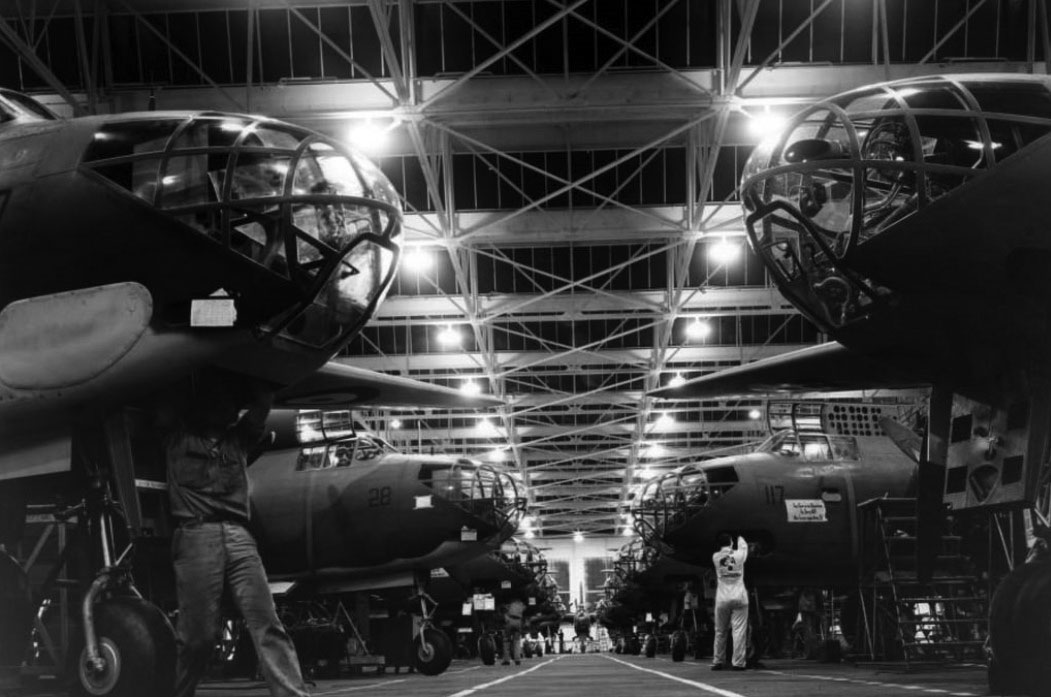 |
|
| (1940s)* – View showing night production of fighters at Douglas Aircraft Company's assembly plant in Santa Monica. |
Historical Notes Santa Monica CA- Along brilliantly lit assembly lines of Douglas Aircraft Company’s plant here, night crews are rushing production of DB-7B attackers bombers, recently acclaimed as night fighters in the defense of blacked out Britain. Equipped with heavy armament self-sealing fuel tanks and armor plating, these ships are proving swift and deadly in interception and downing Nazi raiders. R.A.F. early designated the DB-7 type the Boston and more recent the Havoc. Under a backlog in excess of $400,000,000 nearly 28,000 Douglas employees are working around the clock on attack ships, dive bombers and military transports for Americans and Britain. |
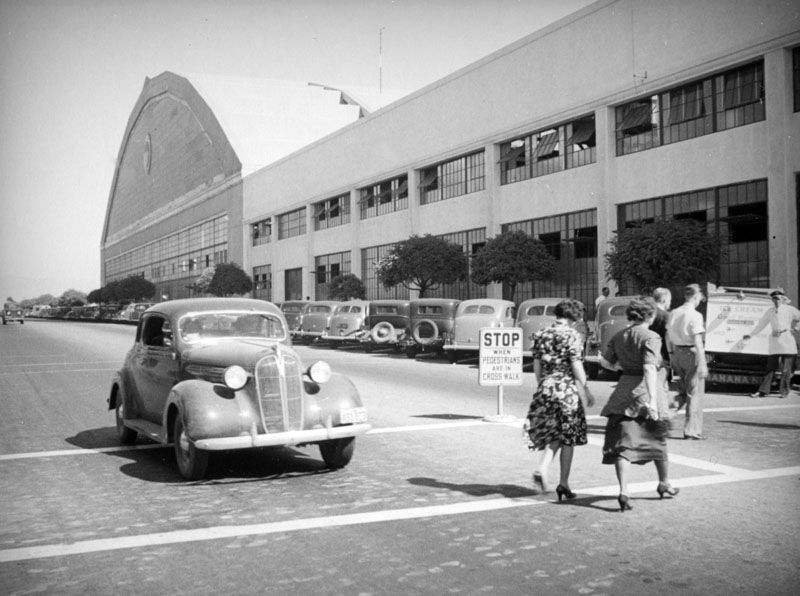 |
|
| (ca. 1940)* - An impatient car starts across the crosswalk while men and women are still crossing towards the Douglas Aircraft Company factory, located at 2700 Ocean Park Boulevard, Santa Monica. An ice cream truck is parked and the attendant is ready to catch workers as they return to work. |
Historical Notes At its peak, Douglas Aircraft, and Santa Monica Airport grew in size to its present 227 acres, employing 40,000 individuals. |
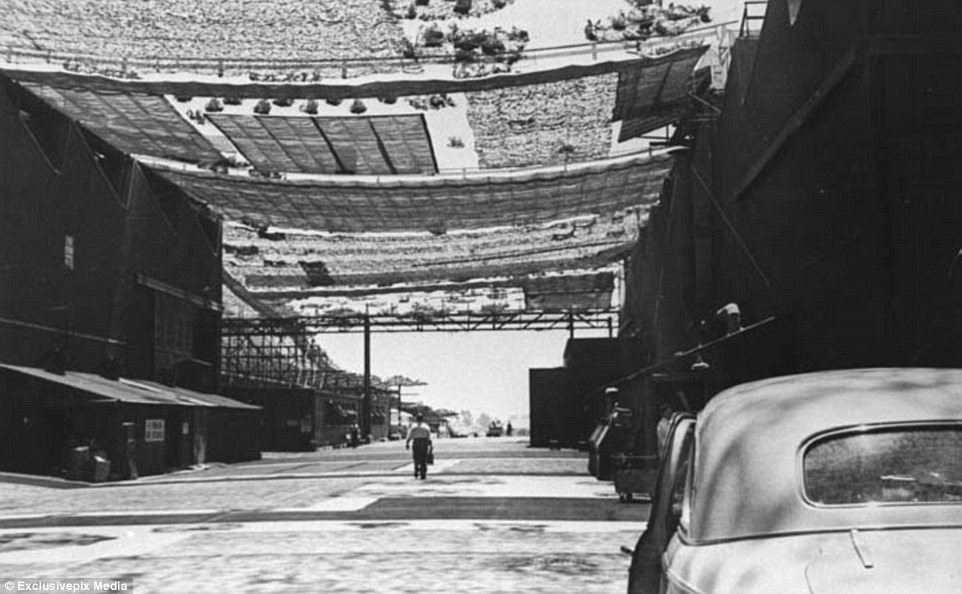 |
|
| (ca. 1945)* - Playing such a vital role in military aircraft production during World War II, camouflage was used to make the plant and airstrip disappear - at least from the air. |
Historical Notes During the war the airport area was cleverly disguised from the air with the construction of a false "town" (built with the help of Hollywood craftsman) suspended atop it. |
 |
|
| (ca. 1950)* – Santa Monica Airport with the Douglas Aircraft plant seen at right. |
Historical Notes Clover Field (Santa Monica Airport) was once the site of the Army’s 40th Division Aviation, 115th Observation Squadron and became a Distribution Center after World War II. |
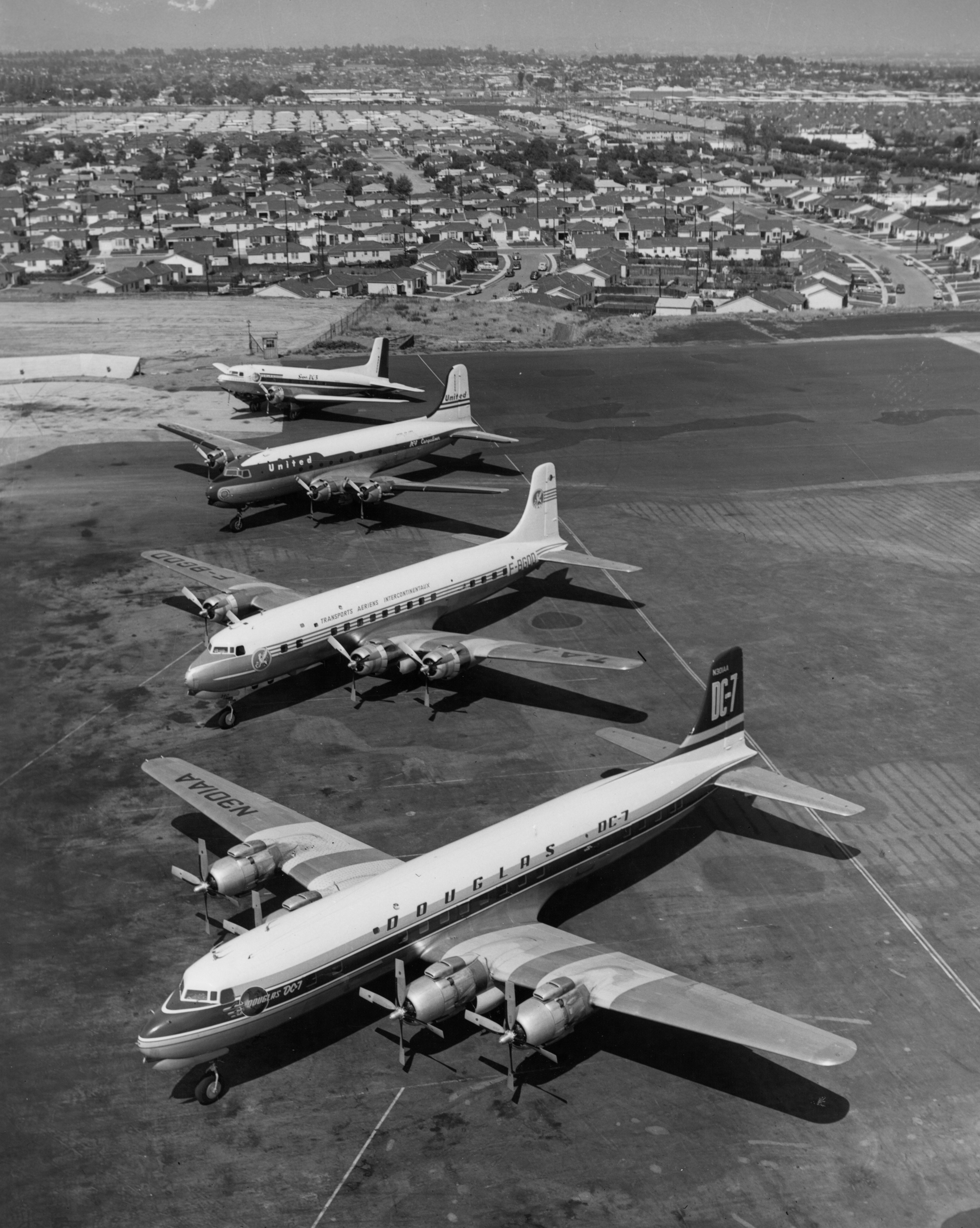 |
|
| (1953*- Douglas DC-3, DC-4, DC-6, DC-7 lined up on the NE end of the Santa Monica Airport. The view is looking towards the east. |
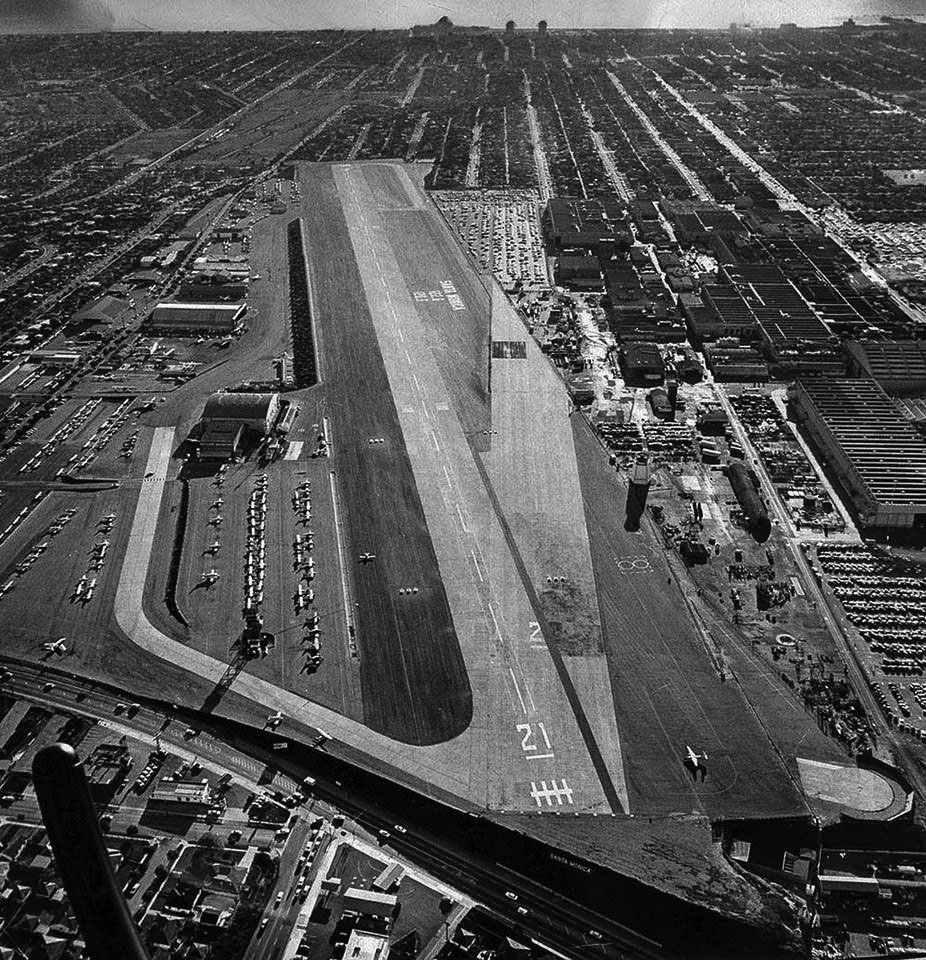 |
|
| (1967)* – Aerial view looking west toward the Pacific Ocean showing Santa Monica Airport. The Douglas Aircraft plant is on the right. |
Historical Notes In later years, Douglas Aircraft merged with a rival to become McDonnell-Douglas Corporation (1967) and moved to Long Beach (1976). The 5,000-foot runway at what was by then known as Santa Monica Airport was too short for the firm's growing jet production. Two decades later, McDonnell-Douglas would be absorbed by yet another rival, Boeing Company. When the corporation left town, Douglas' son, Donald Wills Douglas Jr, set up the Donald Douglas Museum and Library to commemorate his father's legacy. Douglas Sr. died in 1981. Nine years later, the nonprofit Museum of Flying, founded by golf course and real estate developer David Price, superseded the old museum as part of a $20-million airport overhaul. Exhibits included vintage planes and an immense photo of when the airport and plant operated under cover of camouflage. |
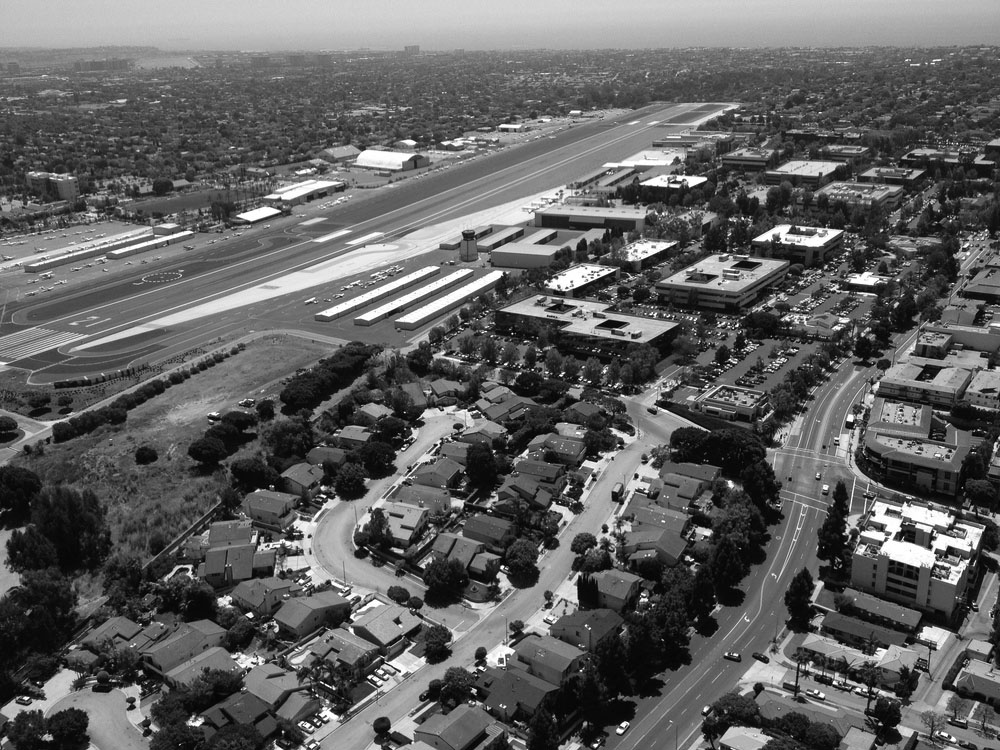 |
|
| (2014)* - Santa Monica Airport (SMO) as it appears today. |
Historical Notes On January 28, 2017, it was announced that Santa Monica City officials and the Federal Aviation Administration had reached an agreement to close the Santa Monica Airport on December 31, 2028 and return 227 acres of aviation land to the city for eventual redevelopment. It is anticipated that the airport land will be redeveloped into areas for parks, open space, recreation, education and/or cultural use. In an attempt to reduce jet traffic, the city planned to shorten the runway from 4,973 feet to 3500 feet by repainting the runway and moving some navigational aids. The shortening has been formally completed as of 2017 December 23. |
Click HERE to see more in Aviation in Early L.A. |
* * * * * |
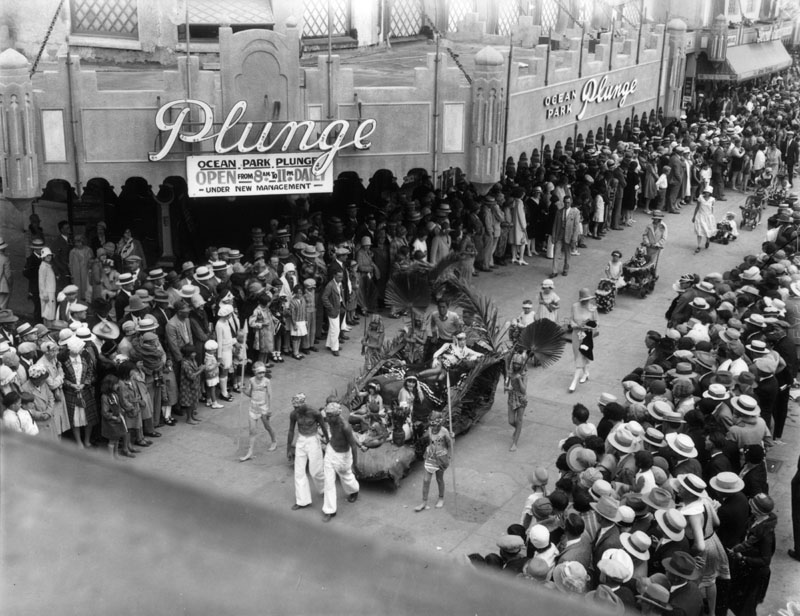 |
|
| (1930)* - A view down the street showing the parade marchers, floats and spectators of the Baby Parade of 1930 as they march past the Ocean Park Plunge near the beachfront. |
Roosevelt Highway Opening (Last Section - Later PCH)
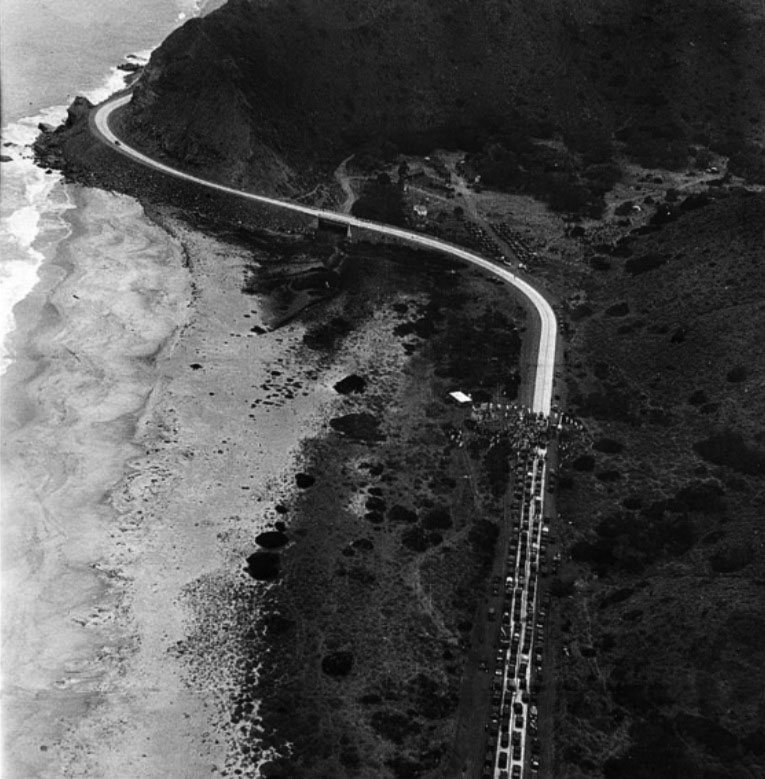 |
|
| (1929)#* – Aerial view showing the opening ceremonies of the Roosevelt Highway through Malibu. This was the last section of the highway linking Mexico with Canada. The Roosevelt Highway today is the Pacific Coast Highway. Photo taken from the Goodyear airship Volunteer and published in the June 30, 1929, Los Angeles Times. |
Historical Notes LA Times Article dated June 30, 1929 reads: For the first time in more than a century the general public was today given access to the scenic wonders of the famous Malibu Ranch when the last link in the Roosevelt Highway, extending from Canada to Mexico, was formally opened and dedicated by Gov. Young at ceremonies in Sycamore Canyon, near the Ventura-Los Angeles county line. |
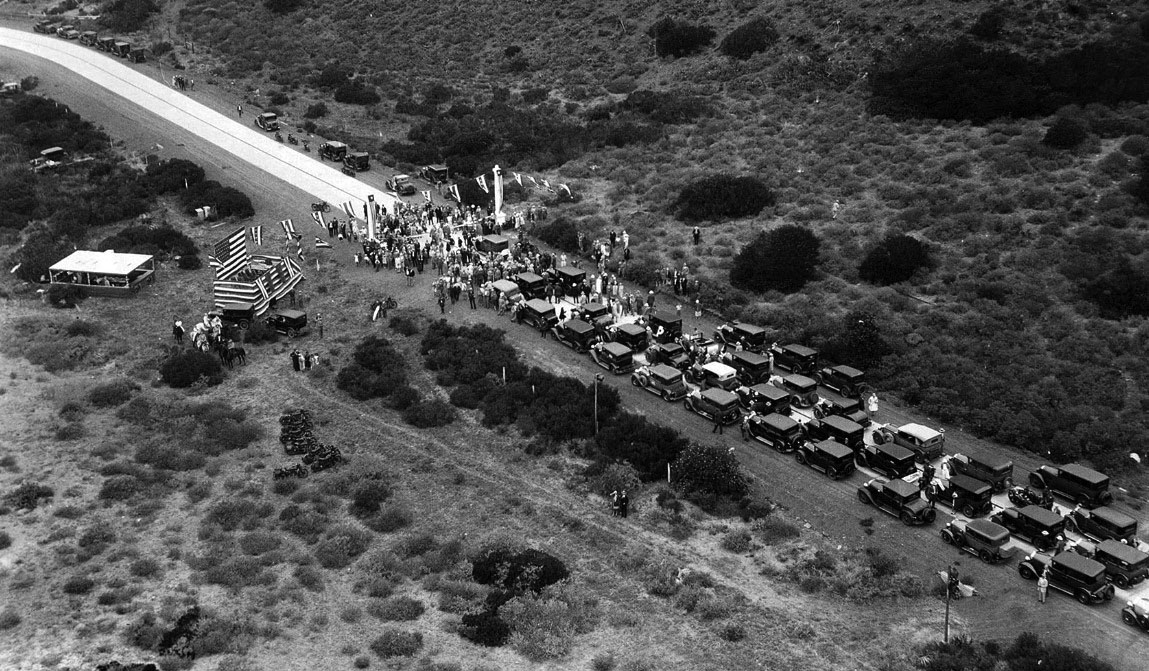 |
|
| (1929)#* – First Sig Alert on the PCH? An aerial photo shows cars waiting for opening ceremonies on the Roosevelt Highway through Malibu, the last section of the highway linking Mexico with Canada. |
Historical Notes A motor caravan of 1500 cars filled with representatives of various organizations which have labored long and hard that this highway might be built left the Chamber of Commerce at Santa Monica at 9:30 o’clock this morning. The procession wended its way north to the canyon, where an arch was constructed on the highway. - LA Times, June 30, 1929 |
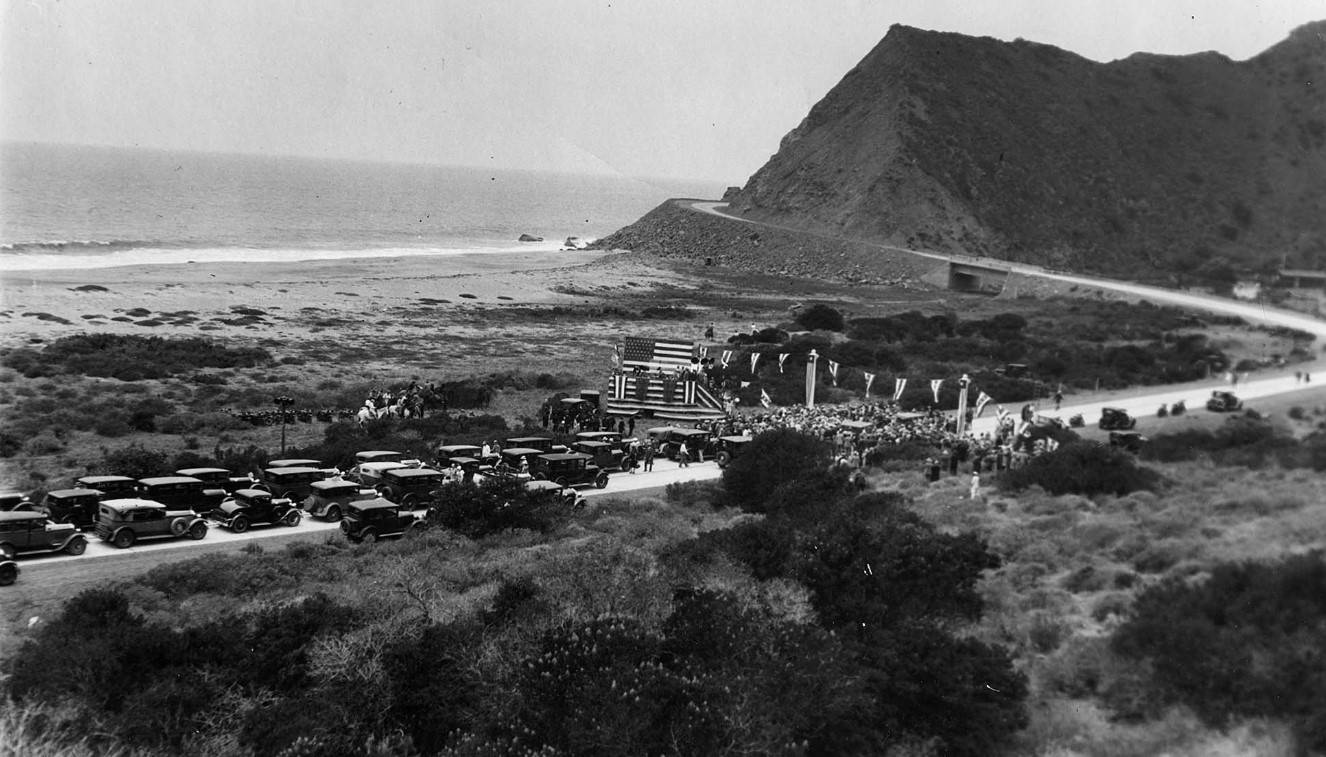 |
|
| (1929)#* - A crowd of dignitaries attends a ceremony opening the Roosevelt Highway through Malibu. |
Historical Notes Gov. Young, after a short speech in which he related some of the handicaps overcome in construction of the road, gave the signal to the young lady representatives of Canada and Mexico, who applied lighted tapers to an explosive so placed that its explosion severed a barrier across the highway. - LA Times, June 30, 1929 |
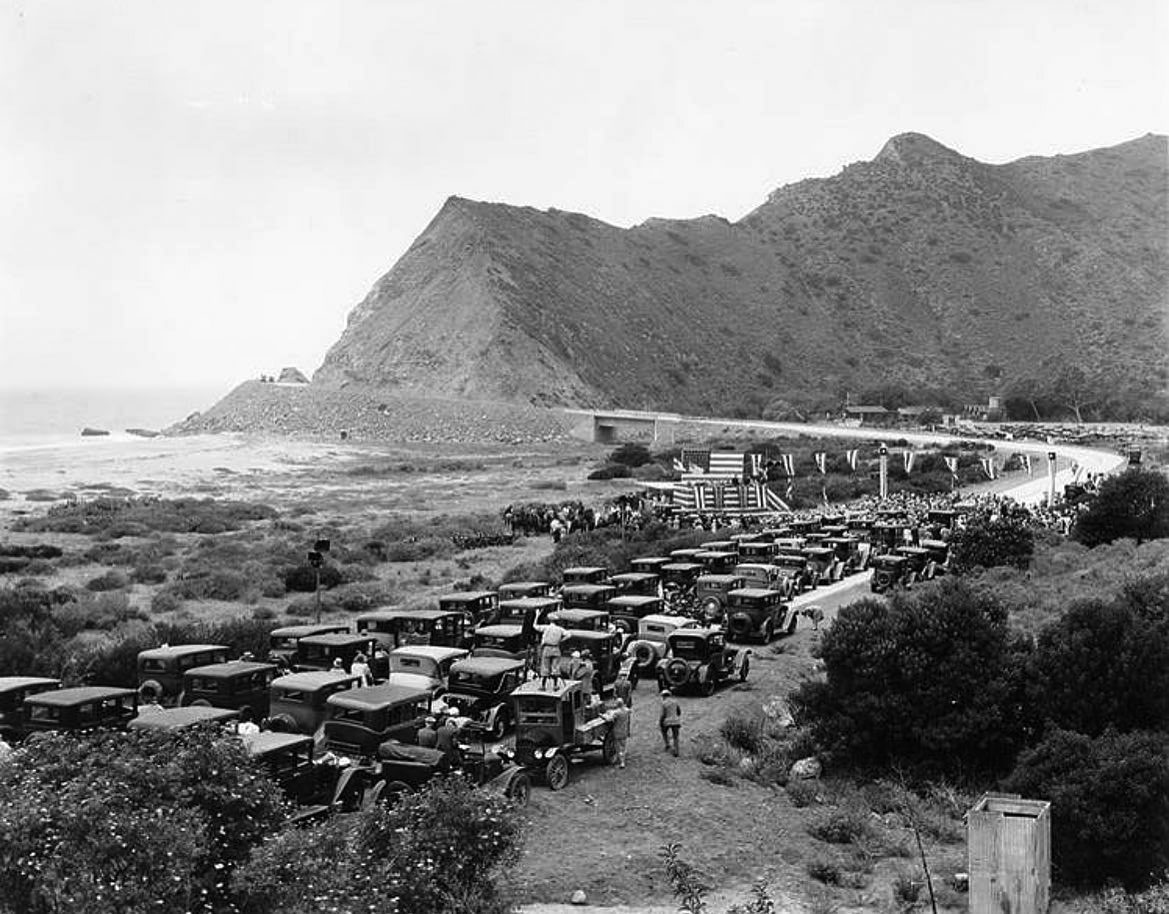 |
|
| (1929)* - Opening of Roosevelt Highway (PCH) in Malibu. |
Historical Notes The coast highway was formally dedicated as the 'Theodore Roosevelt Highway' when it was completed in 1929 and was generally known as the 'Roosevelt Highway' or 'Coast Highway' in the 1930s. It was designated as US 101A (Alternate) in 1936. State legislative action in 1964 changed many highway numbers in California, and US 101A became CA 1. In the same year, the state legislature offically named CA 1 'Pacific Coast Highway' in Orange, Los Angeles and Ventura Counties. |
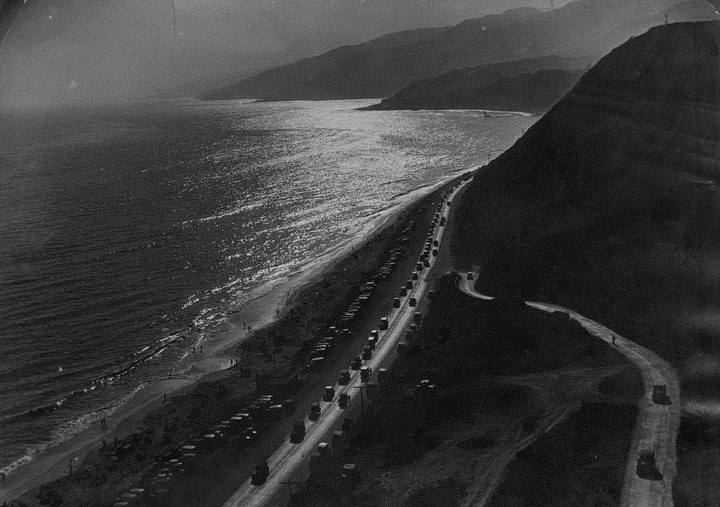 |
|
| (1929)* - Photo shows "two views of the picturesque Santa Monica-Oxnard link of the Coast highway opening today, winding about the hills along the sunset shore." Photograph dated: June 29, 1929. |
Historical Notes The section of Highway 1 from Santa Monica to Oxnard, via Malibu, went out to contract in 1925 as "Coast Boulevard" but was designated "Theodore Roosevelt Highway" when it was dedicated in 1929. The Highway 1 designation was first designated in 1939. Various portions of State Highway 1 have been posted and referred to by various names and numbers over the years. State construction of what became Highway 1 started after the state's third highway bond issue passed before 1910.*^ |
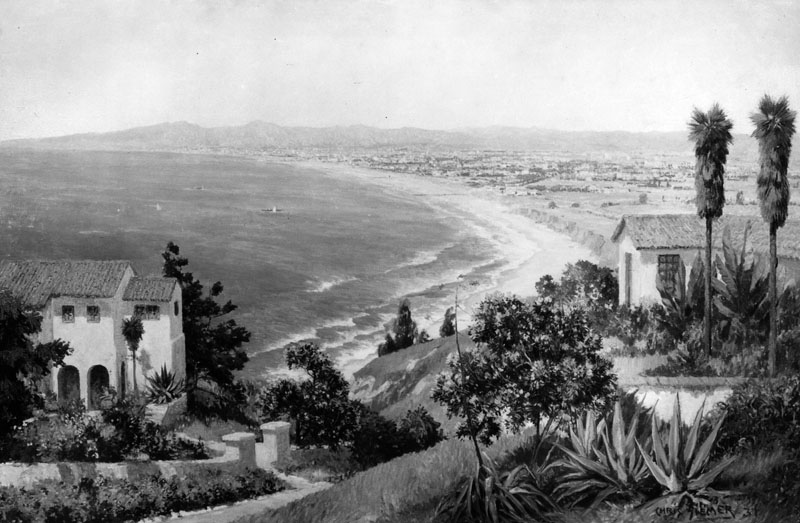 |
|
| (ca. 1930)* - View of the coastline along Pacific Coast Highway looking north to Santa Monica, Pacific Palisades and Malibu. |
Historical Notes This is a photograph of a Chris Siemer painting created for a display by the L.A. Chamber of Commerce. |
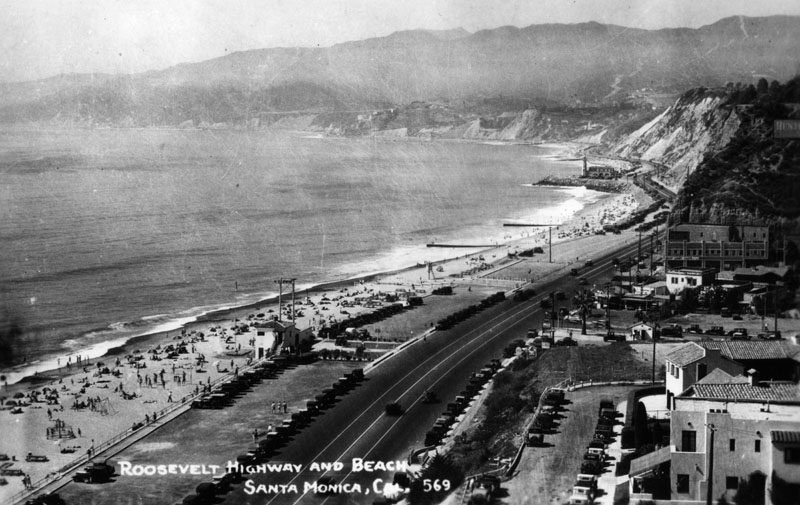 |
|
| (ca. 1930)* - Panoramic view showing the Roosevelt Highway running along the coastline of Santa Monica beach. The landmark Pacific Palisades Lighthouse, Bathhouse, and Restaurant at the location of the original Long Wharf can be seen in the distance. |
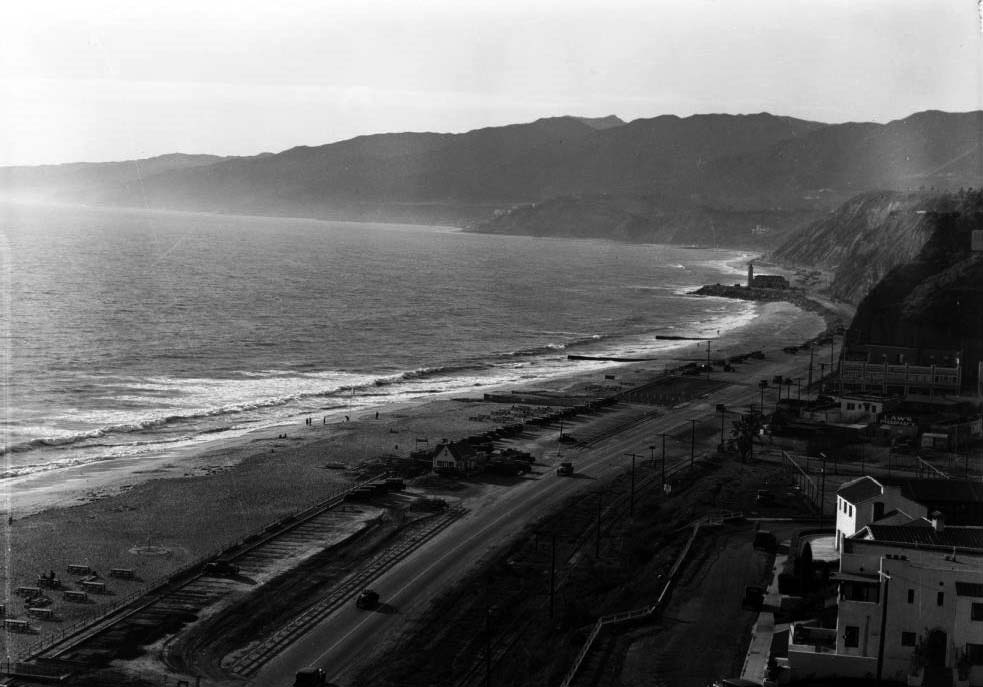 |
|
| (1931)** – Winter view of the Pacific Palisades along the Roosevelt Highway, looking north from the Santa Monica Palisades, showing the landmark lighthouse and bathouse. Photo date: February 26, 1931. |
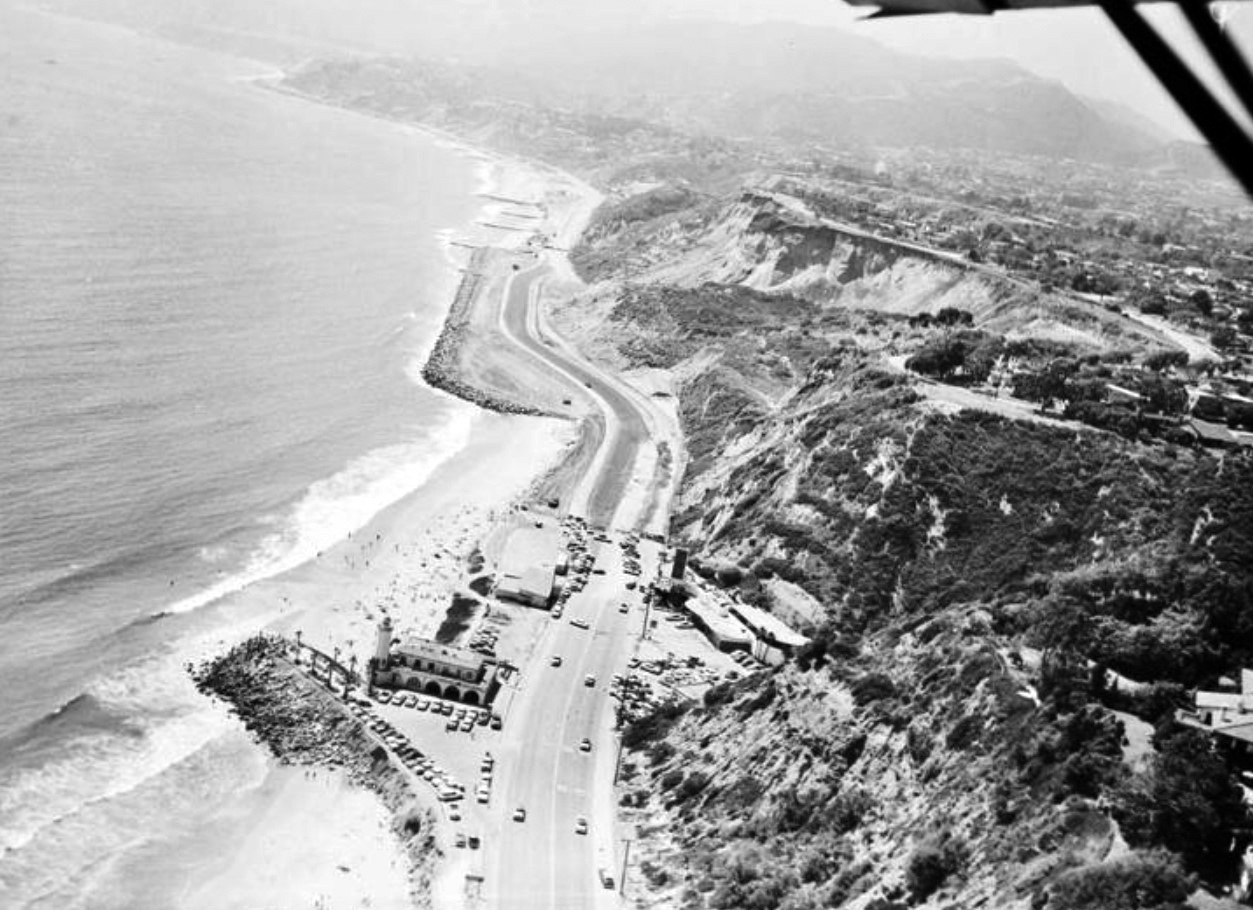 |
|
| (ca. 1958)#*#* - Aerial view showing the Light House Restaurant (1927 - 1972) and Carl's at the Beach across Pacific Coast Highway, Santa Monica, at the location of the original Long Wharf (1893 - 1920). |
Carl's at the Beach (aka Carl's Sea-Air Motel, Carl's Sea-Air Lodge, and Sunspot Motel)
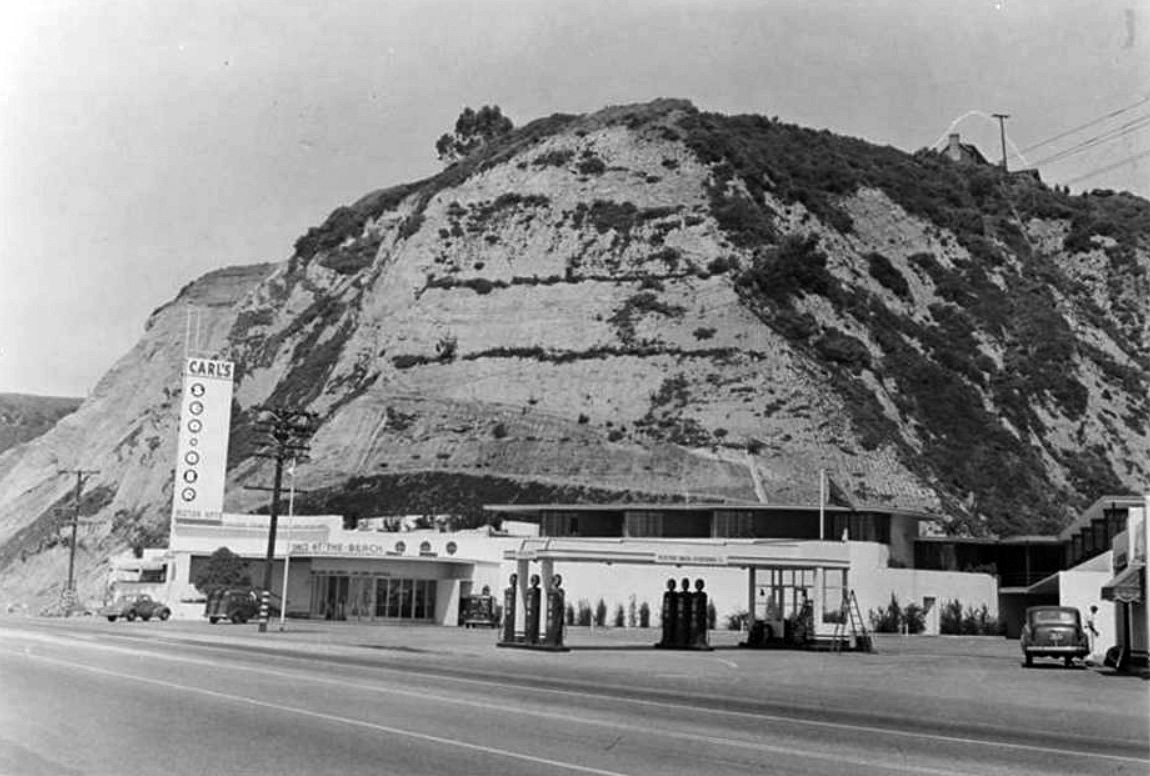 |
|
| (ca. 1938)*#^ - Carl's-at-the-Beach Motel (later the Sun Spot Motel) on Pacific Coast Highway, one of the oldest motels in California. The motel was located across the street from the landmark Pacific Palisades Lighthouse, Bathhouse, and Restaurant. |
Historical Notes The 12-room motel, designed in 1930s by two prominent Los Angeles architects, Burton Alexander Schutt and A. Quincy Jones, was among the first to offer a full range of services--from restaurant to gas station to garage space--for Americans beginning their love affair with the car and the open road.^ |
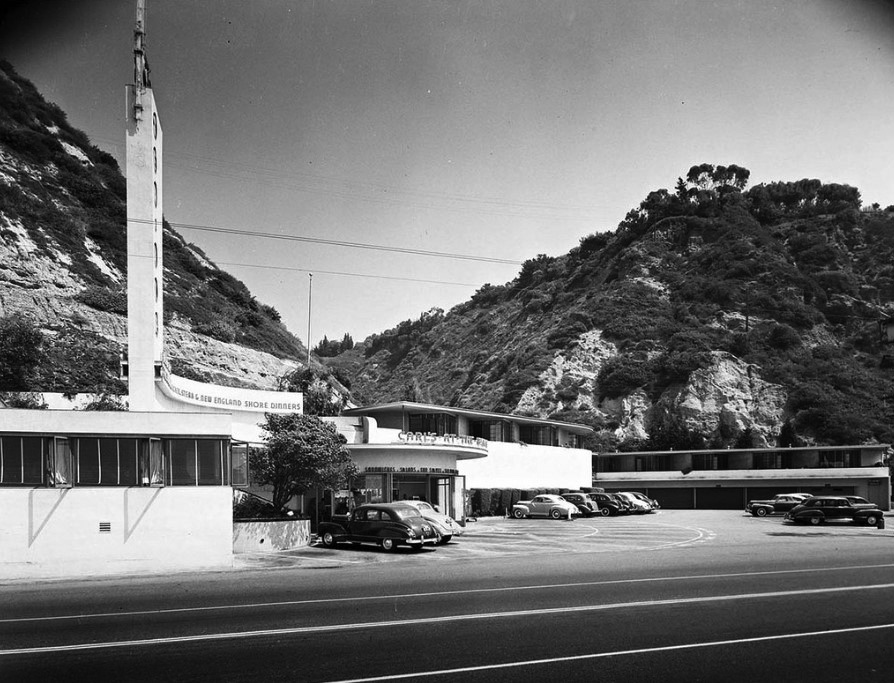 |
|
| (1947)#*#* – View showing Carl's-at-the-Beach motel complex which included a drive-in restaurant. Photo by Julius Shulman |
Historical Notes This motel was different--a streamlined V-shaped building, its two wings nestled snugly against the line of the bluffs where Potrero Canyon opens to the ocean. The public areas were close to the road, the sleeping rooms on a second story away from the traffic streaming by on what was then known as Roosevelt Highway. Motel guests, shielded from the cars' noise and fumes, could relax in the rear garden and look at the canyon beyond. Or they could gaze out the angled front windows of their rooms at a sweeping ocean vista.^ |
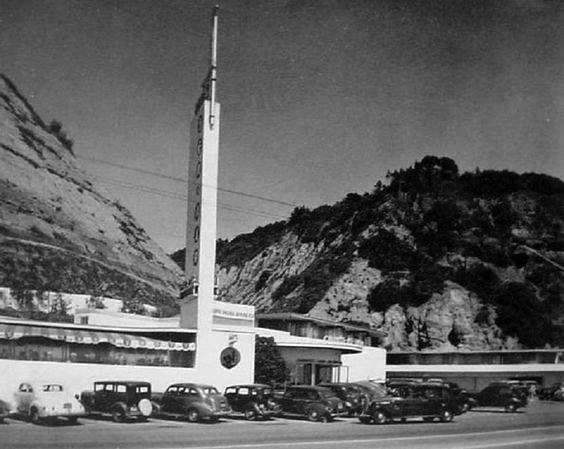 |
|
| (1940s)^x^ - Full house at Carl's-at-the-Beach Drive-in Restaurant and motel complex. |
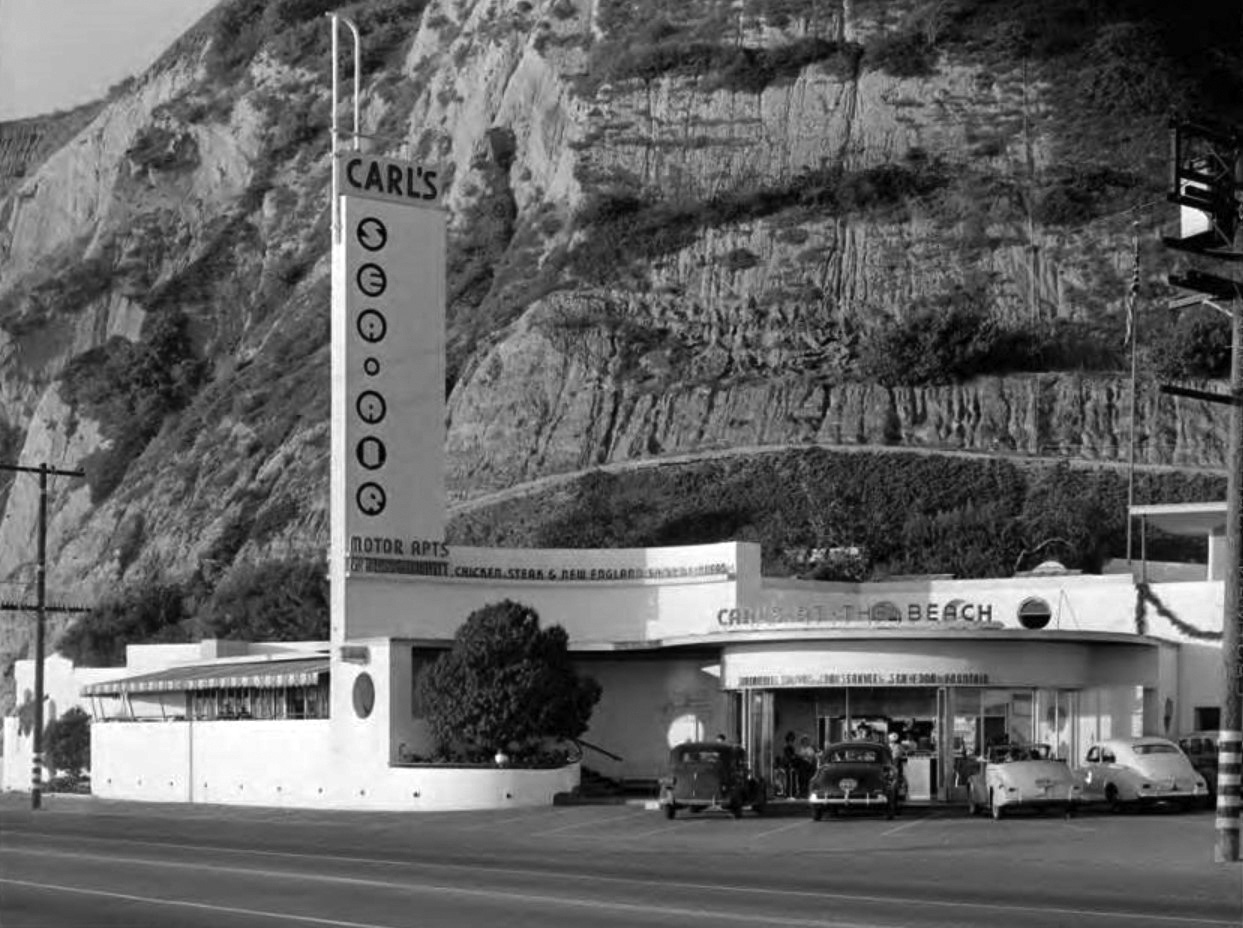 |
|
| (1940s)#^^ – Close-up view showing Carl's Drive-in at the Sea Air Lodge complex (aka Carl's-at-the-Beach) |
Historical Notes Drive-in Restaurants flourished in Southern California during the 1930s and 40s. Click HERE to see more Early LA Drive-in Restaurants. |
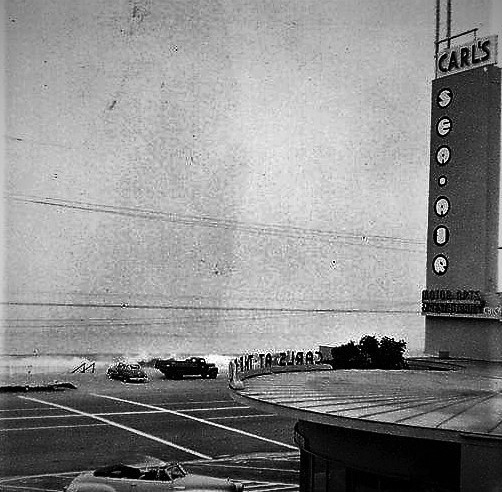 |
(1940s)^x^ – Looking over the roofline of Carl’s-by-the-Beach Drive-in towards the ocean. |
|
.jpg) |
|
| (1947)#*#* - View showing Carl's at the Beach Motel (later known as the Sunspot), a 12-room motel, designed in 1938. The car parked on the left is a beautiful 1941 Buick two-door sedanette. Photo by Julius Shulman |
Historical Notes By the mid-1970s, the property at the foot of the Pacific Palisades bluffs had evolved into the Sunspot, a bar and mecca for the disco dance craze. The Sunspot complex was closed in the 1980s and sat empty for nearly 10 years. The Los Angeles Recreation and Parks Department, which owned the property, hoped eventually to renovate and lease the building as a motel and restaurant. However in 1994 a landslide crushed the westerly portion of the building—the part that would have been the restaurant. Since then the City has demolished what was left of the buildings.^ |
* * * * * |
Will Rogers State Beach
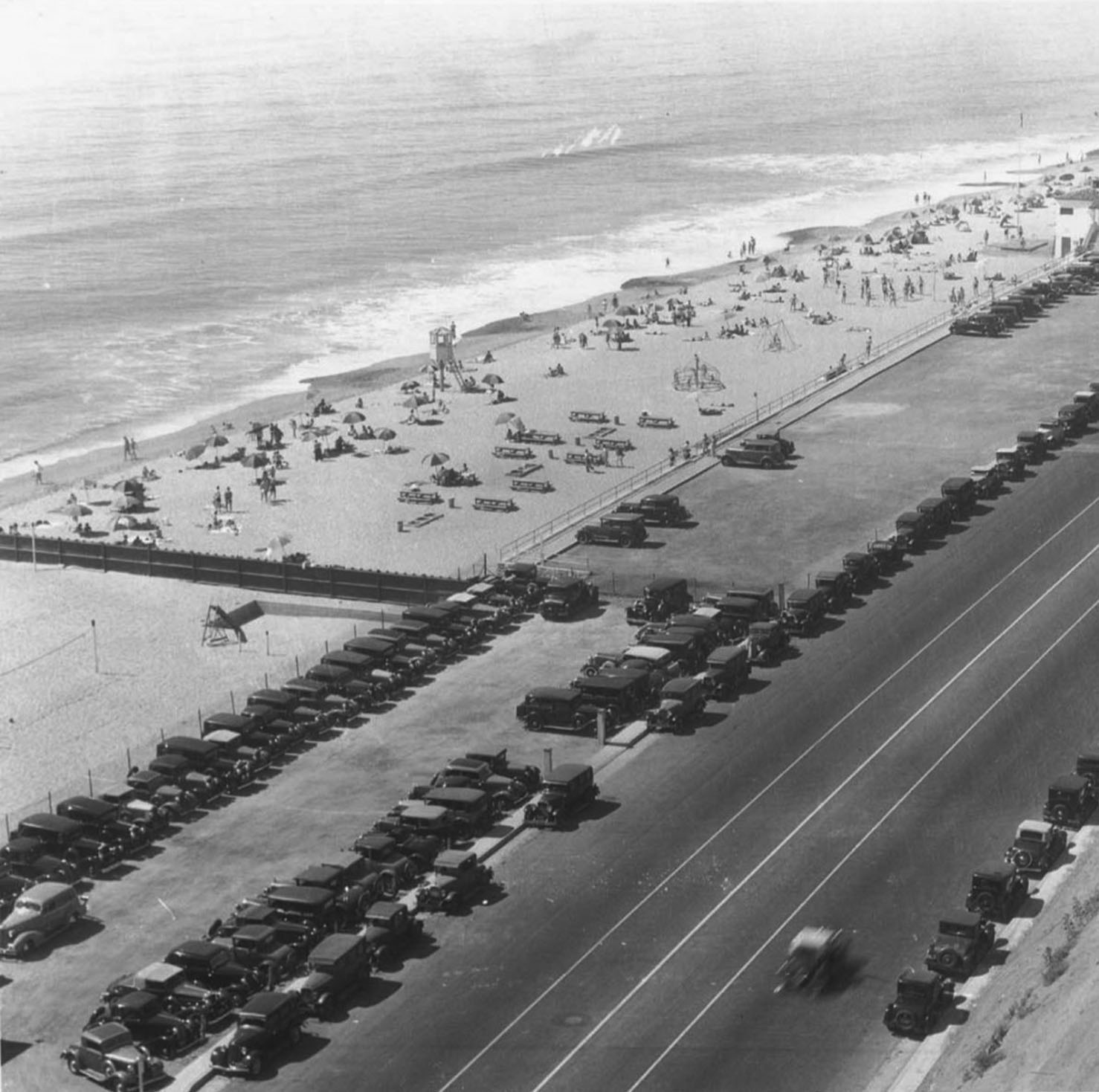 |
|
| (1930s)* - View from the bluffs, looking North to Will Rogers State Beach and Pacific Coast Highway. |
Historical Notes The beach is named after actor Will Rogers. In the 1920s, Rogers bought the land and developed a ranch along the coast. He owned 186 acres along the coast in what is now Pacific Palisades. Rogers died in a plane crash in 1935. Then when his widow, Betty, died in 1944, the ranch became a state park. The Will Rogers State Beach lifeguard headquarters is the site of the former Port of Los Angeles Long Wharf, a California Historical Landmark, site number 881.^ |
Chautauqua Boulevard and Pacific Coast Highway
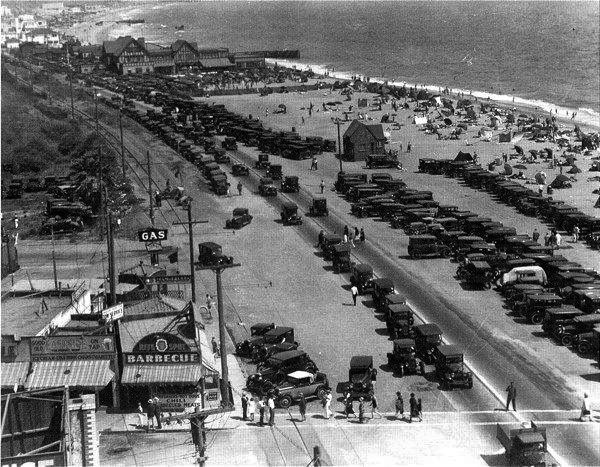 |
|
| (mid-1920s)^x^ - View looking south on Roosevelt Highway at the intersection with Chautauqua Boulevard and Channel Road. A 'Barbecue' restaurant can be seen on the southeast corner. The crowded beach to the right will become Will Rogers State Beach in 1944. |
Historical Notes Will Rogers Beach was donated to the State of California by his widow, Betty, in 1944. The County of Los Angeles has been operating the beach since 1975.^ Note the old tracks on Roosevelt Highway are still there in the above photo. The railroad tracks were removed when Roosevelt Highway was widened in 1934. |
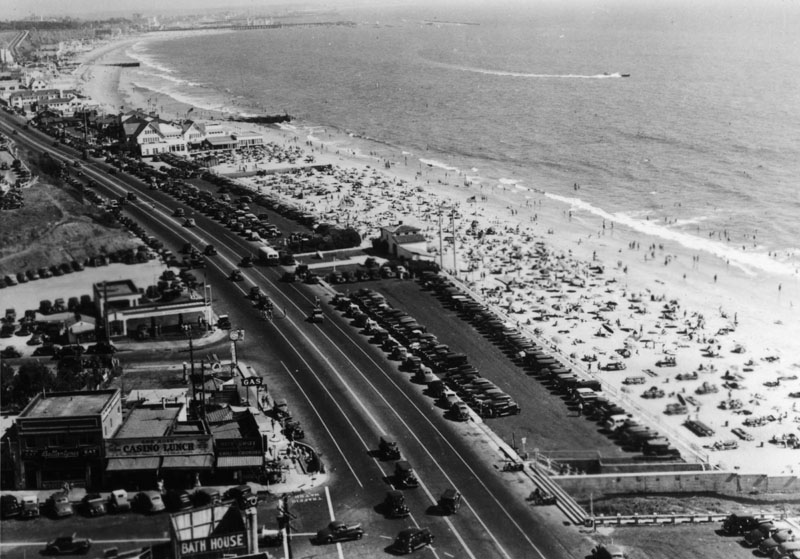 |
|
| (1930s)* - View shows Roosevelt Highway (now PCH) running parallel to the Santa Monica beach at the intersection with Chautauqua Boulevard. Cars parked along the sides of the highway and crowds on the beach can be seen. A bath house sign, several restaurants and a couple of gas stations are on the left side. The Santa Monica pier can be seen in the distance. |
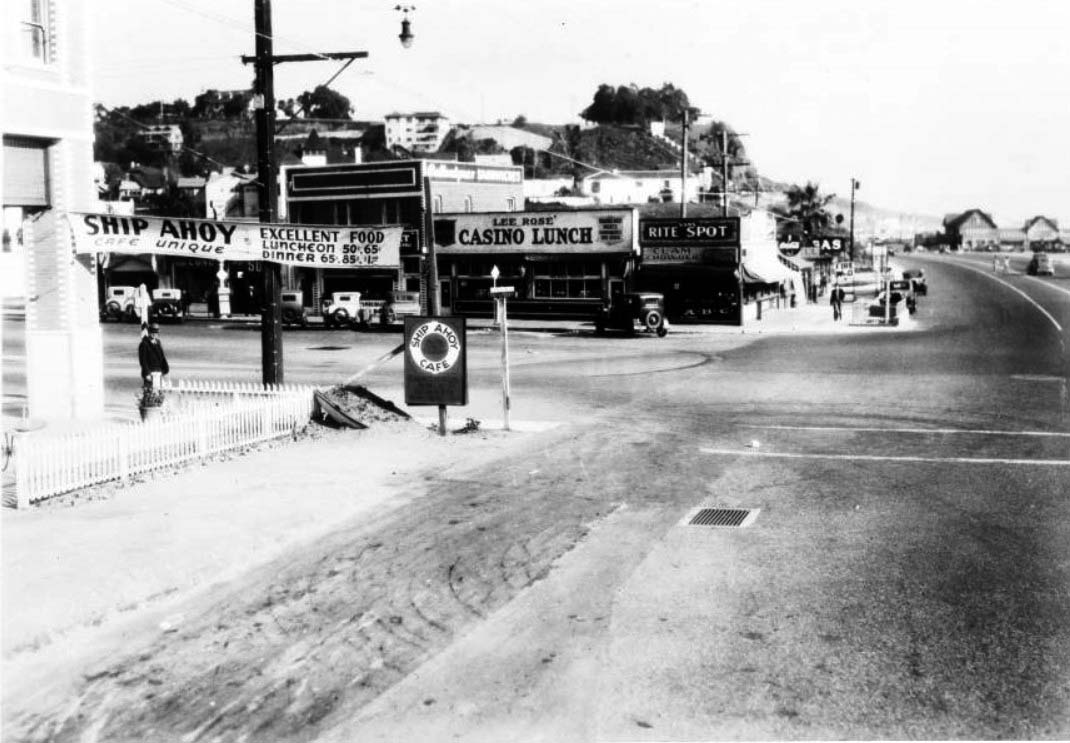 |
|
| (1930s)** – Close-up view of the intersection of Chautauqua Boulevard and Pacific Coast Highway in Santa Monica. The highway extends into the distance at right while Chautauqua runs from left to right. There are several buildings visible on the sides of Chautauqua, and many early-model automobiles are parked along the side of the road. A man is standing in the foreground at left, holding a basket, and several other pedestrians are visible in the distance at right. A hill covered with large houses can be seen in the distance at left. Legible signs include, from left to right: "Ship Ahoy Cafe Unique Excellent Food Luncheon 50 65 Dinner 65 85 $1.00", "Ballanlymes Sandwiches", "Lee Rose Casino Lunch Barbequed Mets Hamburger Hot Dogs", "Sam's Rite Spot", "Clam Chowder", and "ABC". |
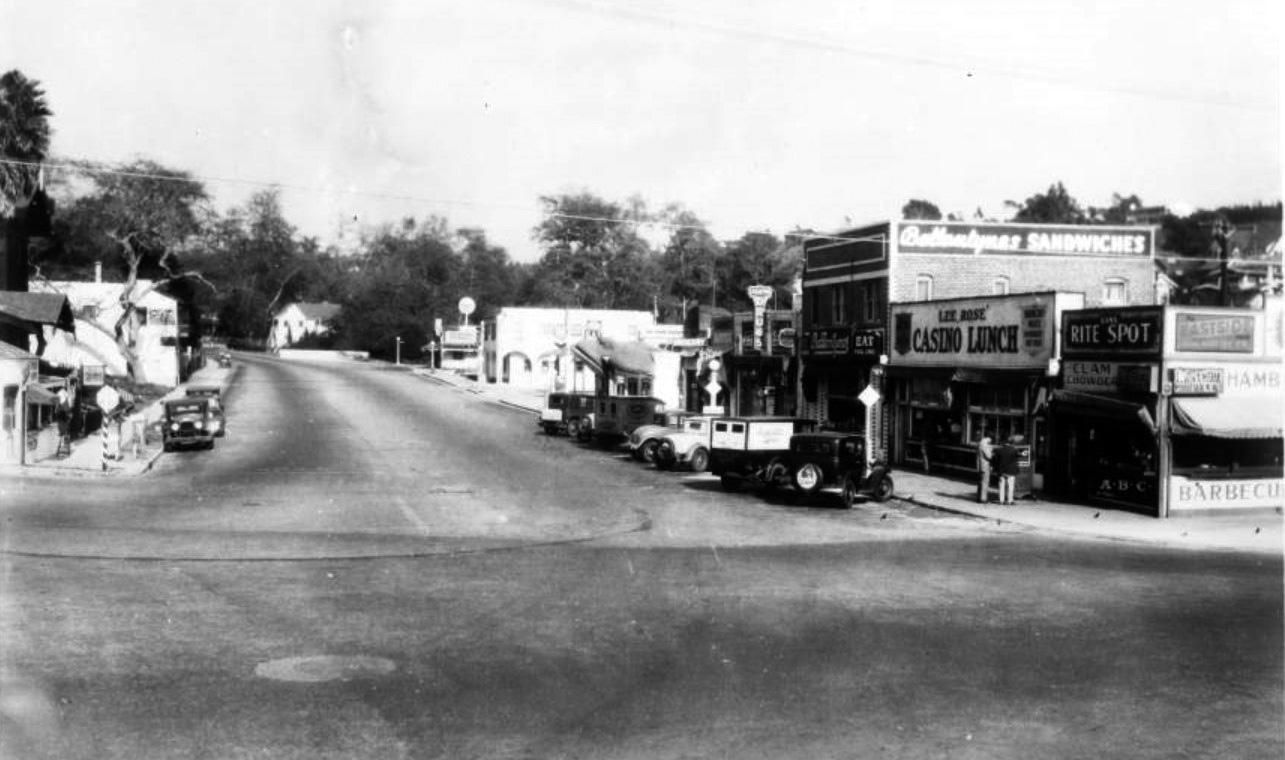 |
|
| (1930s)** - Panoramic view of West Channel Road in Santa Monica from Chautauqua Boulevard and Pacific Coast Highway. Legible signs include, from left to right: "Liquor Drugs", "Grocery", "Eat Real Chili", "Ballanlymes Sandwiches", "Lee Rose Casino Lunch Barbequed Mets Hamburger Hot Dogs", "Sam's Rite Spot", "Clam Chowder", "ABC", "Eastside Beer", and "Barbeque". |
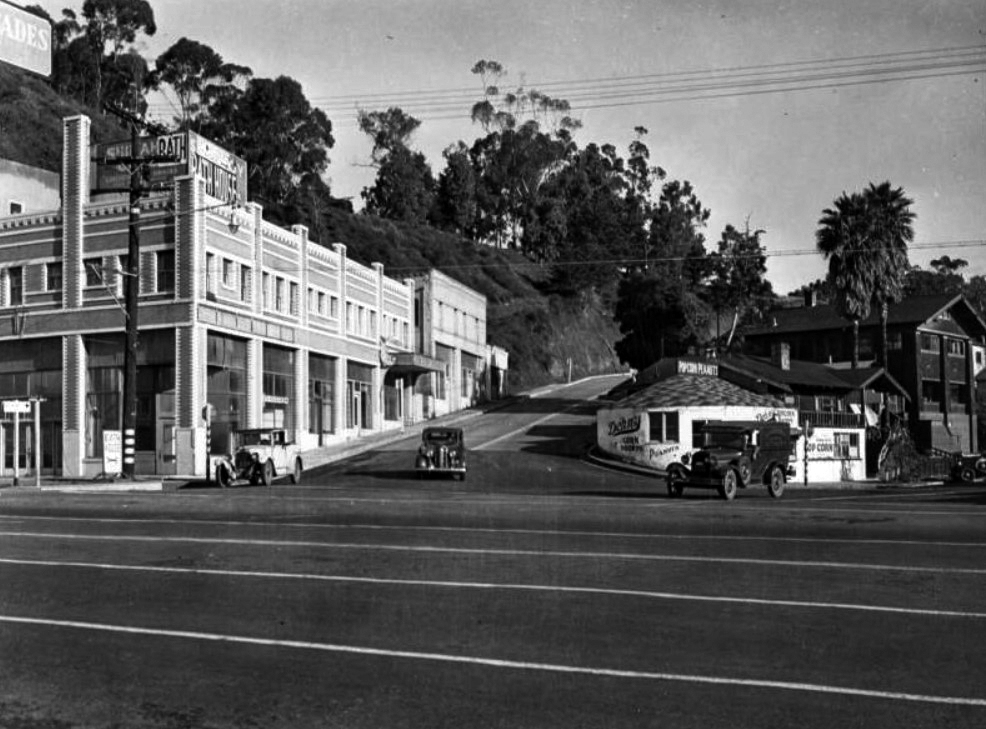 |
|
| (1930s)^** - Intersection of Pacific Coast Highway, Chautauqua Blvd. and Channel Road, Santa Monica. |
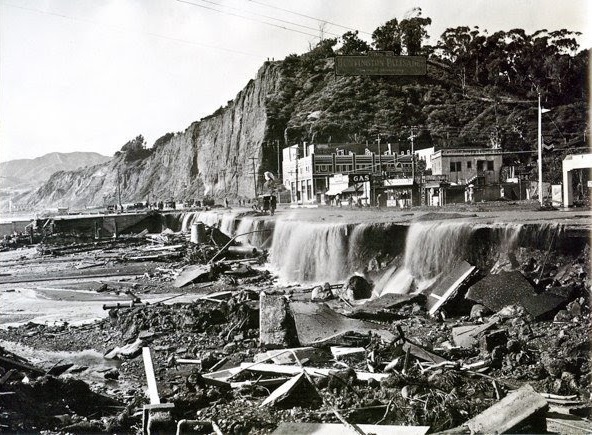 |
|
| (1938)^^^^ - View of the Santa Monica Canyon flood of 1938. The sign on top of the hill reads: HUNTINGTON PALISADES. |
Historical Notes In 1938, PCH was damaged by one of wettest seasons ever to hit Southern California. |
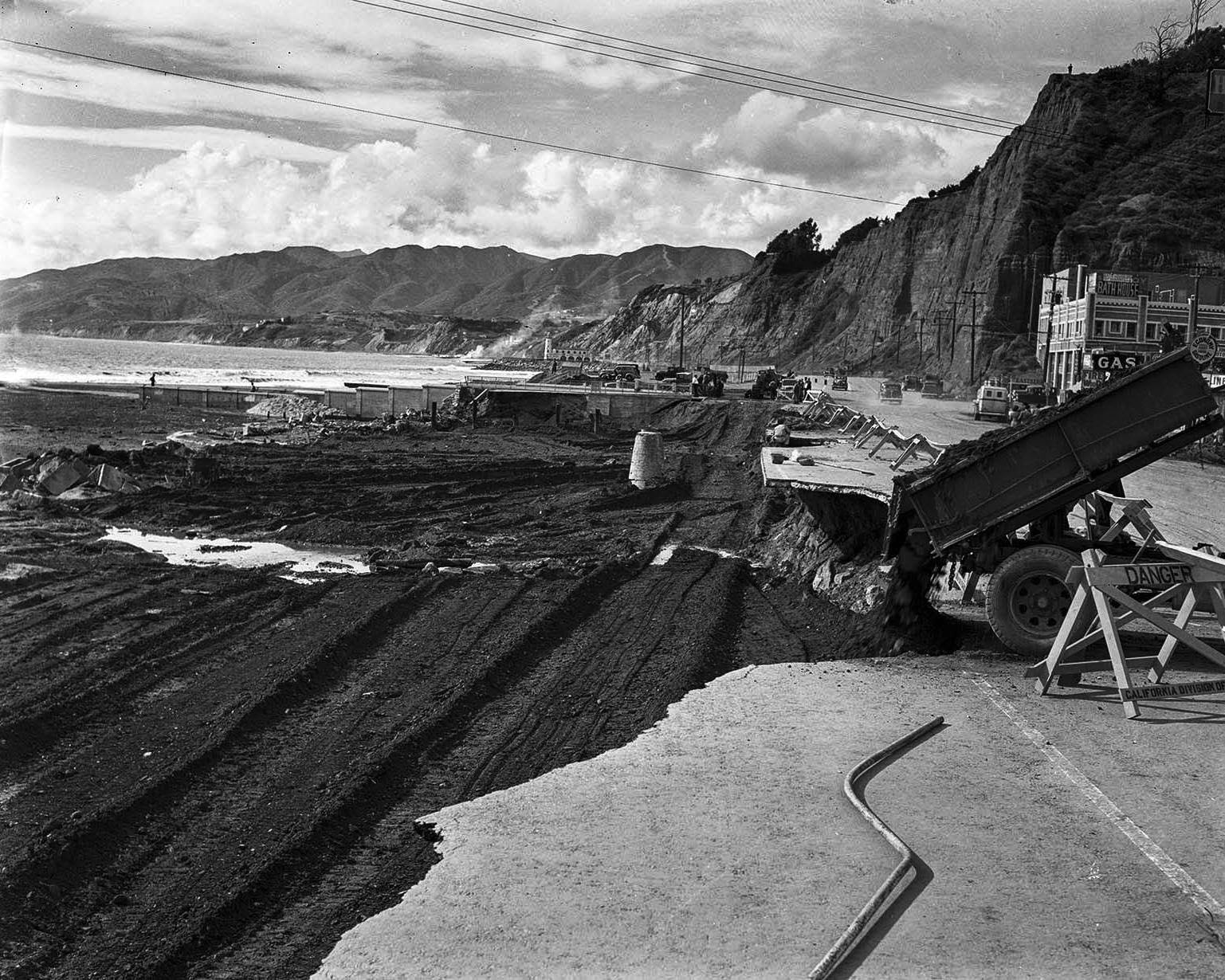 |
|
| (1938)#*#* – Repairing Pacific Coast Highway after the great storm of 1938. The intersection of PCH and Chautauqua Blvd is seen in the background. Photo Date: March 7, 1938 |
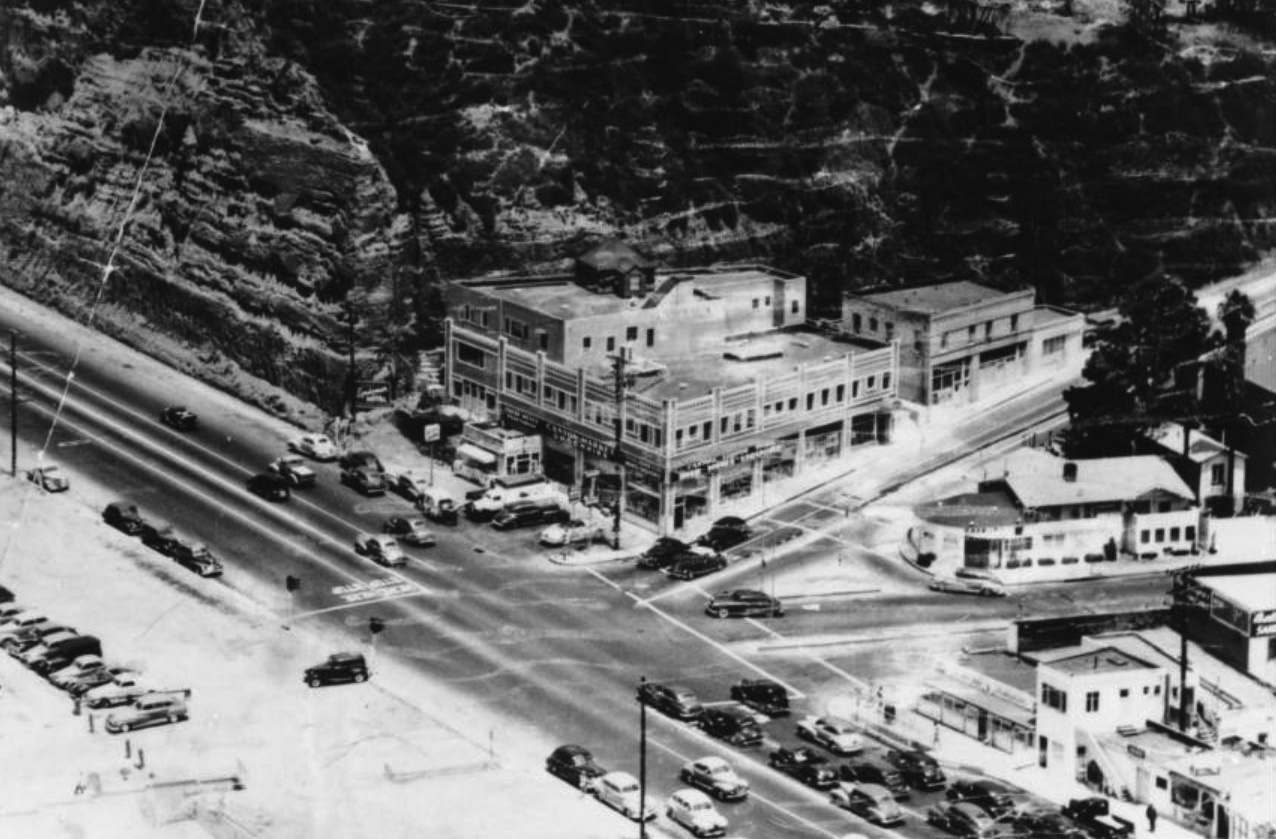 |
|
| (ca. 1945)** - Aerial view of the intersection of Chautauqua Boulevard, West Channel Road and Pacific Coast Highway. The Canyon Market Groceries and Liquor building is at center, and to the left is a billboard sign for the Lindomar Hotel. In the left foreground Pacific Coast Highway separates the market from a partly filled parking lot and the beach. The area where the market is located appears to be cut out of the solid rock hill in the background. |
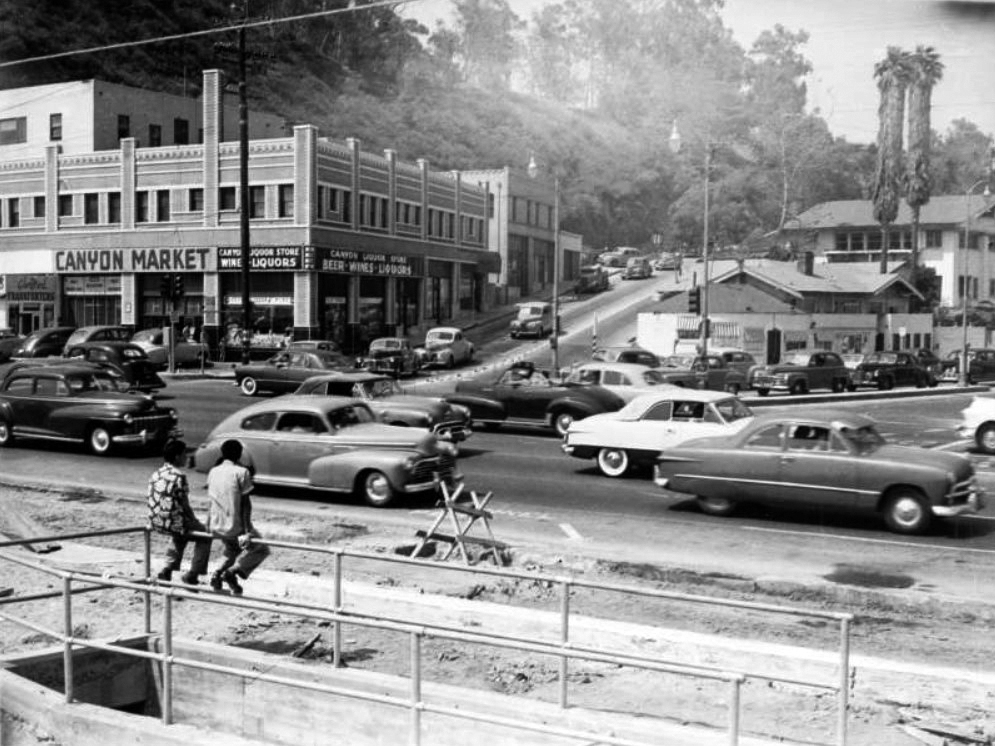 |
|
| (ca. 1950)^** - View showing automobile traffic at the intersection of Pacific Coast Highway, Chautauqua Boulevard, and Channel Road in Santa Monica. Two boys are sitting on a railing watching traffic across from storefront signs that read "Canyon Market", "Canyon Liquor Store", and "Gloryfied frankfurters." |
Then and Now
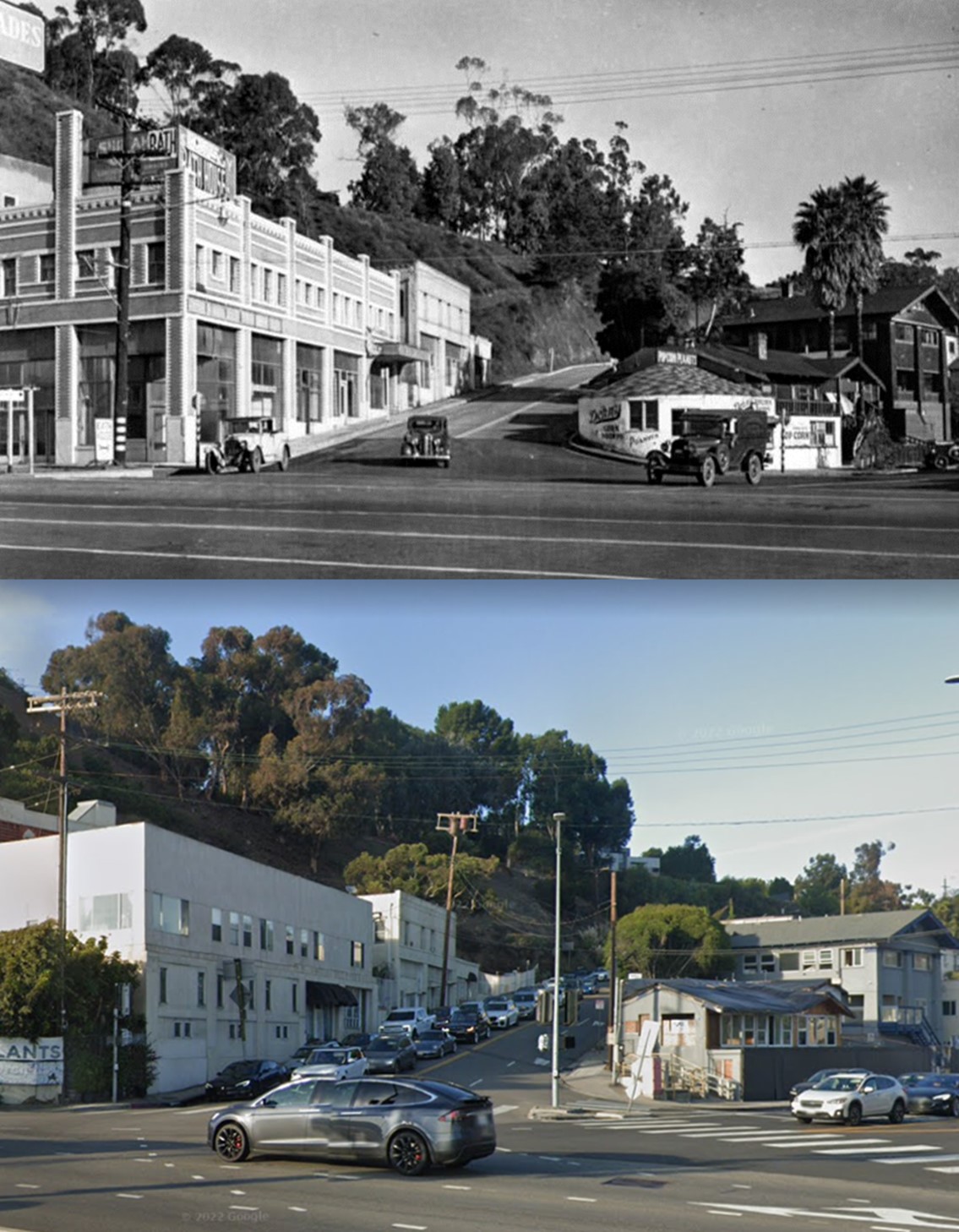 |
|
| (1930s vs 2022)* - Intersection of Pacific Coast Highway, Chautauqua Blvd. and Channel Road, Santa Monica. |
Sunset and PCH
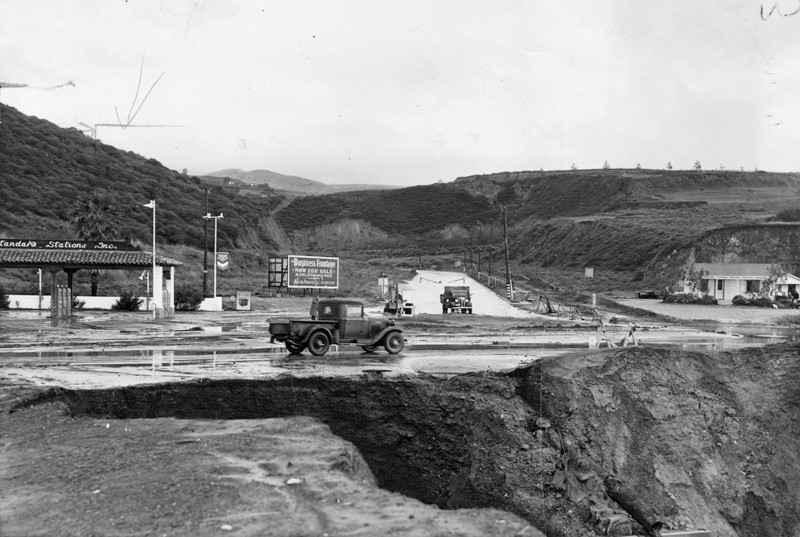 |
|
| (1940)* – View looking NE showing Sunset Boulevard where it comes into Pacific Coast Highway (PCH), after a storm. In the foreground can be seen the erosion of a section of the highway. Photo taken from site of Gladstones today. |
Historical Notes This section of Pacific Coast Highway was formally dedicated as the 'Theodore Roosevelt Highway' when it was completed in 1929 and was generally known as the 'Roosevelt Highway' or 'Coast Highway' in the 1930s. It was designated as US 101A (Alternate) in 1936. State legislative action in 1964 changed many highway numbers in California, and US 101A became CA 1. In the same year, the state legislature offically named CA 1 'Pacific Coast Highway' in Orange, Los Angeles and Ventura Counties.* Gas station on left is still there. Got remodeled 15- 20 years ago. Click HERE for contemporary view. |
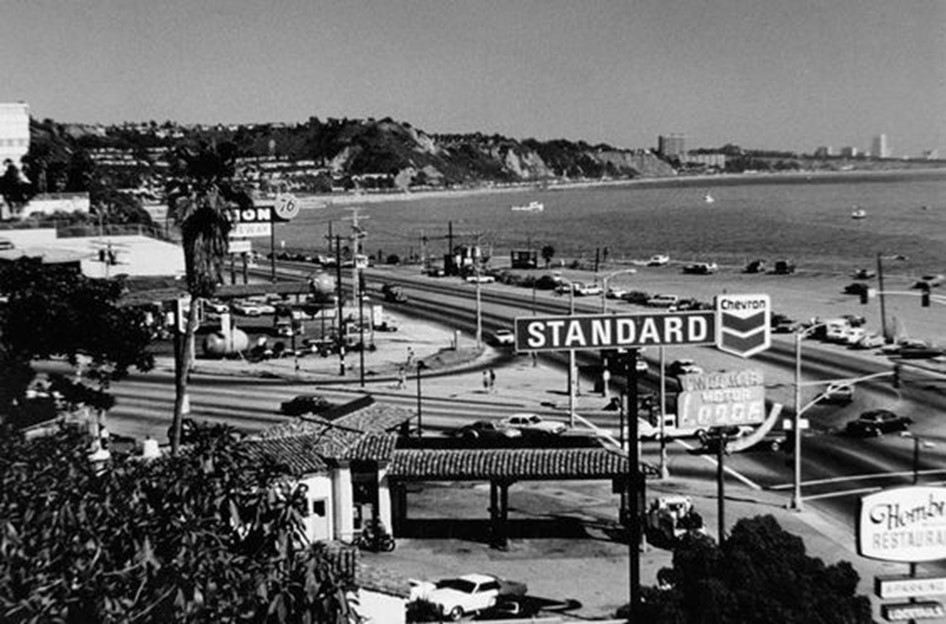 |
|
| (1960s)* - Sunset Boulevard and Pacific Coast Highway. |
Historical Notes The Standard Oil Station pictured was owned by Clint Eastwood's father. |
Then and Now
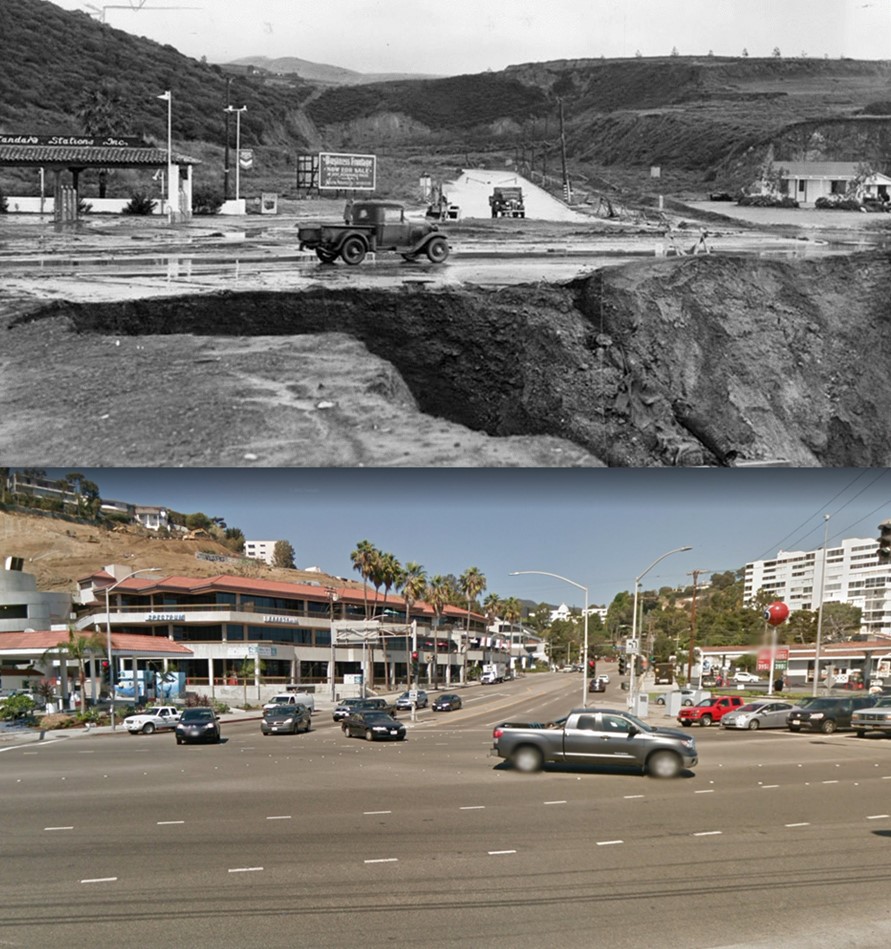 |
|
| (1940 vs. 2022)* – Looking NE on Sunset Boulevard from PCH showing how the area has evolved over the last 80 years. Current image taken from driveway of Gladstones. |
* * * * * |
Marion Davies Mansion
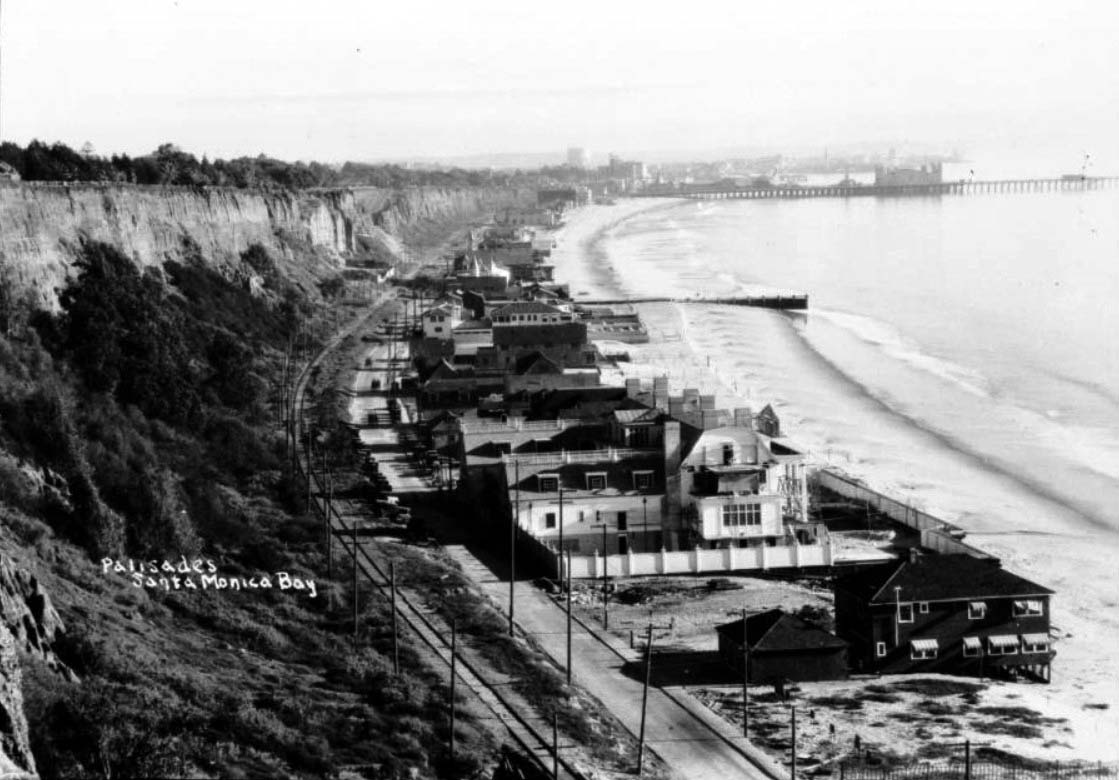 |
|
| (ca. 1929)* - View of Santa Monica homes along Pacific Coast Highway, looking south. The highway is in the foreground at center and follows the contours of the coast as it disappears into the distance at center. The right side of the road is lined with an assortment of large beach houses including Marion Davies' mansion (center-right) which is still under construction. On the left side of the highway, a railroad runs parallel to the road and the steep cliffs of Palisades Park rise above the tracks. There are trees along the top and bottom of the cliffs, but the faces are bare rock. There is a small wharf at center that sticks out above the low tide, and a long pier is visible in the background at right. |
Historical Notes William Randolph Hearst might have been the first media mogul of the 20th Century. In his day, Hearst owned 28 major newspapers and 18 magazines, as well as radio stations and movie companies. Santa Monica’s Gold Coast was so desirable that in the 1920s, Hearst, one of the richest and most powerful men in America, bought 4.91 acres of beachfront property so that he could build a mansion for his mistress, actress Marion Davies. |
|
Historical Notes During the 1930s and 1940s, Marion Davies' Beach House in Santa Monica became the epicenter of Hollywood's social scene, solidifying its place in entertainment history. Davies and William Randolph Hearst frequently hosted lavish parties and exclusive film screenings for the entertainment elite, making the estate a must-visit destination for celebrities and industry moguls. The property was a crown jewel of Santa Monica's prestigious "Gold Coast," a stretch of beachfront where numerous movie stars and influential figures owned homes. With its opulent design and extravagant amenities, the Beach House was widely regarded as one of the most lavish properties in the area, rivaling other famous residences of the time and cementing its status as a symbol of Hollywood's Golden Age glamour. |
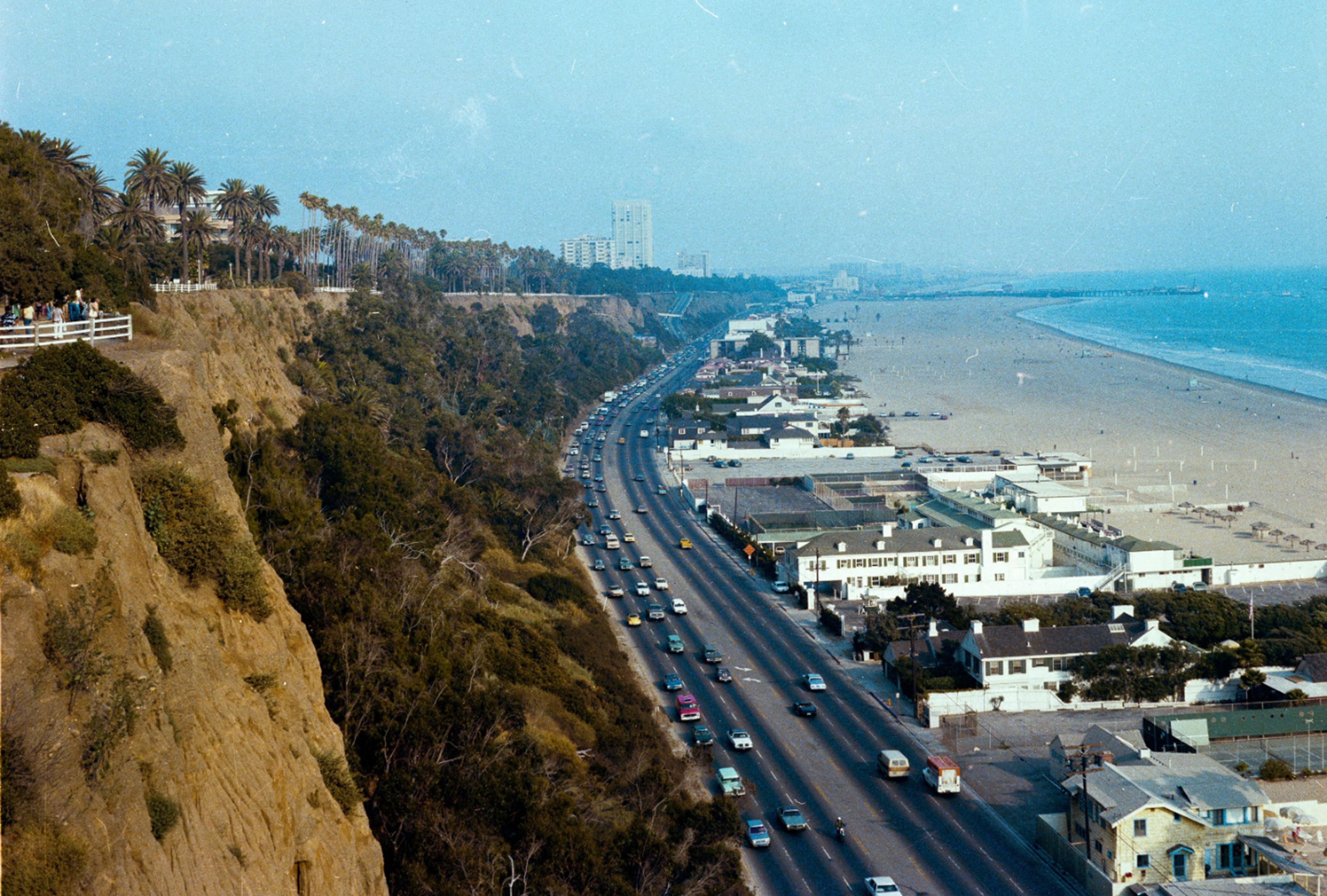 |
|
| (1978)* – View from the bluff looking down at the beach, highlighting changes to the Marion Davies residence over a 50-year span. Photo from the Ernest Marquez Collection. |
Historical Notes After Marion Davies sold the estate in 1947 for $600,000, the property underwent significant changes. It was initially operated as a luxury hotel and limited-membership beach club, catering to an exclusive clientele. However, in 1956, despite opposition from neighbors, the main mansion was demolished, marking the end of an era for the iconic residence. The state of California then purchased the property in 1960, setting the stage for its future as a public space. Today, the site is known as the Annenberg Community Beach House, with only the original guest house and main pool surviving from Davies' time. |
Before and After
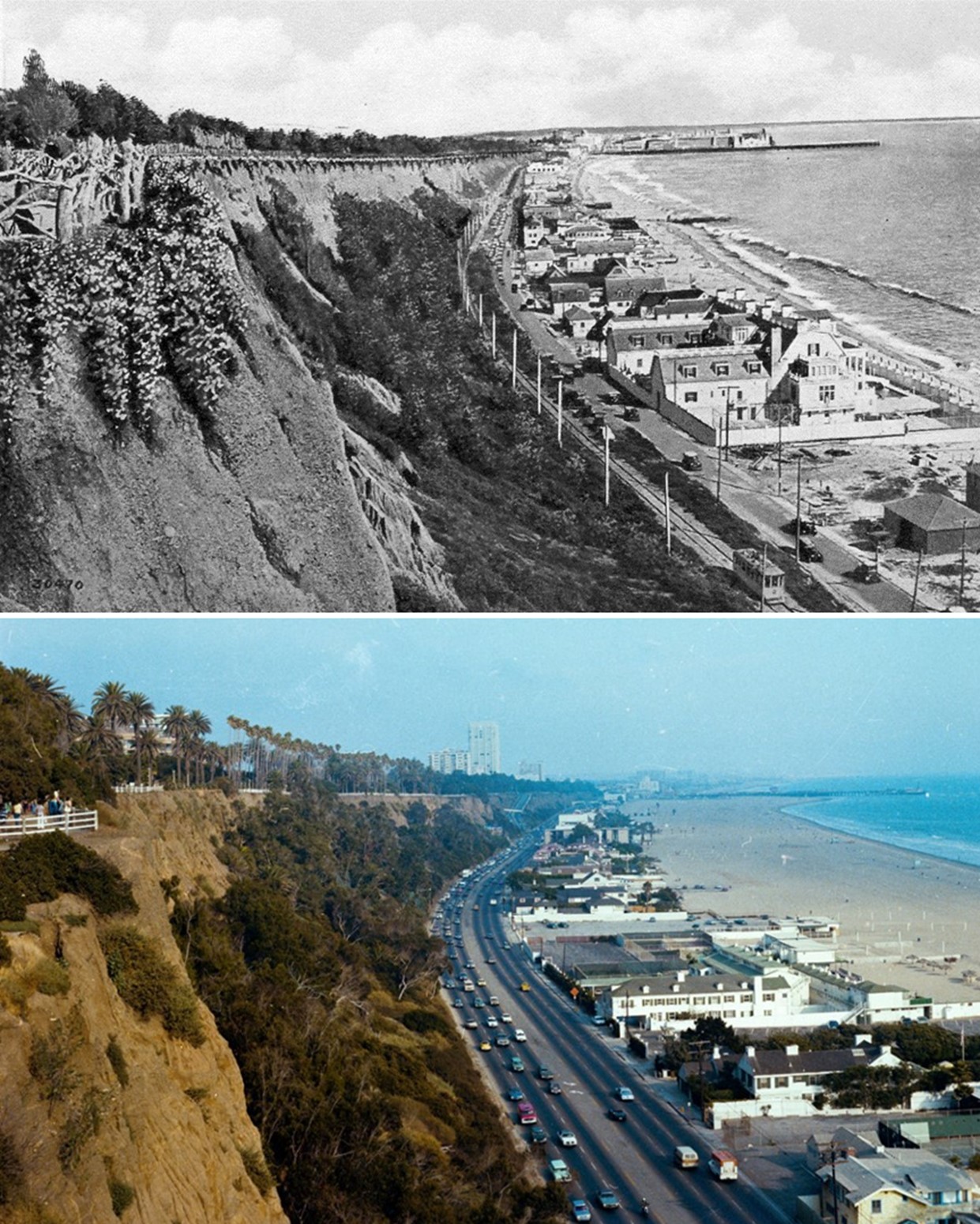 |
|
| (1929 vs. 1978)* – View looking south from Palisades Park toward the Santa Monica Pier. The most noticeable change over this nearly 50-year span is the widened beach, primarily the result of human intervention through beach nourishment projects. Also note the streetcar running along the Southern Pacific tracks on the Roosevelt Highway (now PCH) in the earlier image. |
Historical Notes The increased sand on Santa Monica Beach compared to 100 years ago is largely due to human intervention, particularly through beach nourishment projects. Over the past century, efforts have been made to widen and enhance the beach to boost tourism and recreation. Key factors include the artificial widening of the beach by adding approximately 30 million cubic yards of sand, sourced from infrastructure projects and dredging operations, and the desire to make Santa Monica Beach resemble wider, flatter East Coast beaches. In 1947, for example, nearly 14 million cubic yards of sand were removed to make way for El Segundo's Hyperion power plant. They were deposited onto Santa Monica's beaches. Another million cubic yards came a couple years later, the sand this time recovered from dredging operations along a nearby breakwater. In all, some thirty million cubic yards of sand have been dumped onto the beaches of Santa Monica and Venice. |
|
Historical Notes The railroad tracks will be removed in 1934 when Roosevelt Highway is widened to 4 lanes. |
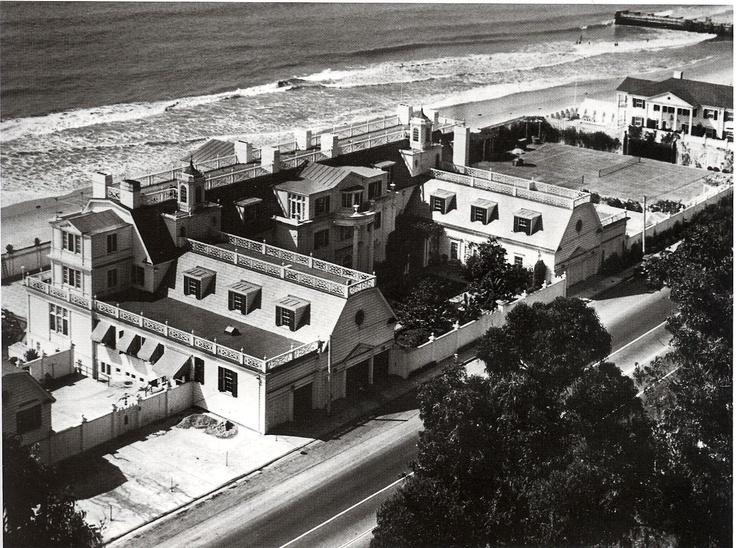 |
|
| (late 1930s)* - Closer view of Marion Davies' beach house (mansion) on the Pacific Coast Highway, Santa Monica |
Historical Notes Julia Morgan created a three-story, 34-bedroom Georgian mansion on the Pacific Coast Highway in Santa Monica. Called "Ocean House" or "The Beach House," it was the grandest property in the neighborhood. Rumor has it the cost was $7 million dollars. |
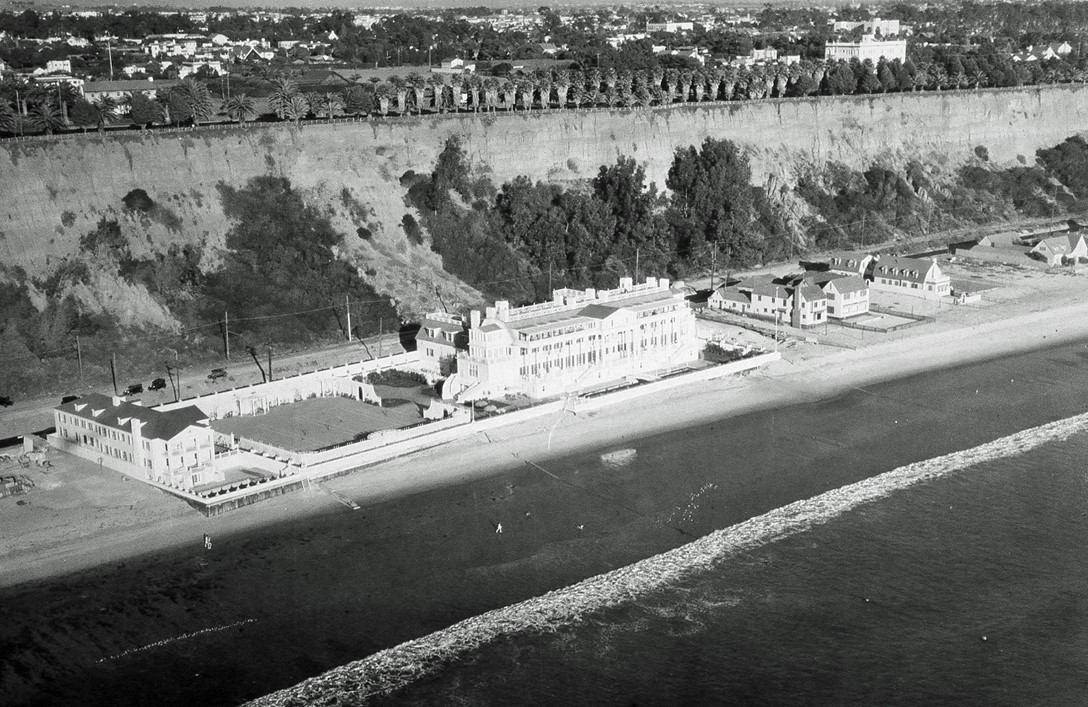 |
|
| (late 1930s)* - Aerial view showing the 4.91-acre Marion Davies estate in Santa Monica, designed by Julia Morgan. The building on the left is the guest house. |
Historical Notes Marion Davies was born Marion Douras in Brooklyn, New York on January 3rd, 1897. She always wanted to be a star. When she met William Randolph Hearst, she had already made a name for herself on the Broadway stage. Rumor has it she wrote her first film, "Runaway Romany," directed by her brother-in-law, George Lederer. 1918’s "Cecilia of the Pink Roses" was her first film backed by Hearst. Then her marketing campaign began. Over the next ten years, Davies filmed an average of almost three films a year. She was a tireless worker, always trying to live up to the relentless promotional campaigns launched by Hearst. In the early twenties, she and Hearst relocated their movie company, Cosmopolitan Productions, to California to join forces with Metro-Goldwyn-Mayer studios. Once the Beach House was finished, Marion evolved into Hollywood's premiere hostess. Her parties attracted the day’s biggest stars, international dignitaries and business titans. Those who knew Davies say she never took herself seriously and was beloved by all who knew her for her gracious spirit and charitable tendencies. |
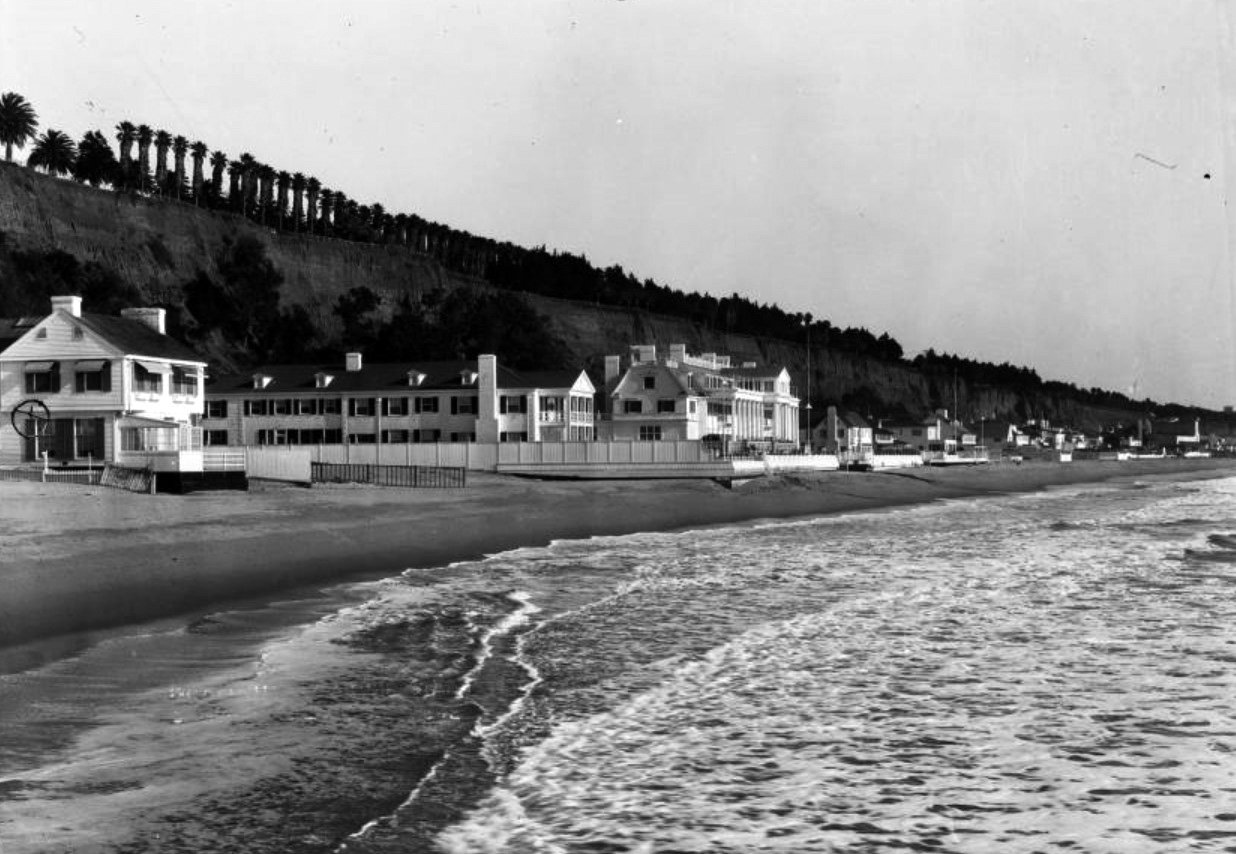 |
|
| (1940s)* - Image of the mansion beach house of actress Marion Davies (which later became Ocean House, or the Oceanhouse Hotel, and Sand and Sea Beach Club), with the bluffs below Palisades Park visible in the background. |
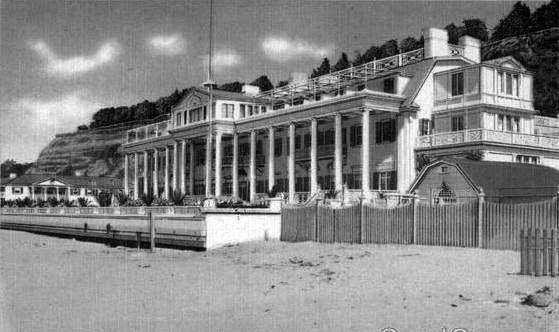 |
|
| (ca. 1930s)* - Postcard view from the beach, showing the Marion Davies mansion. The Santa Monica bluffs are seen in the background. The mansion's guest house, on the left, still exists today. |
Historical Notes The three-story, 118-room, 34-bedroom, 55-bath Georgian mansion had 37 fireplaces, Tiffany chandeliers, a ballroom, a dining room from a Venetian palazzo, and a room that was coated in gold leaf. It was accompanied by three guesthouses, two swimming pools, tennis courts and dog kennels and was called “Ocean House." |
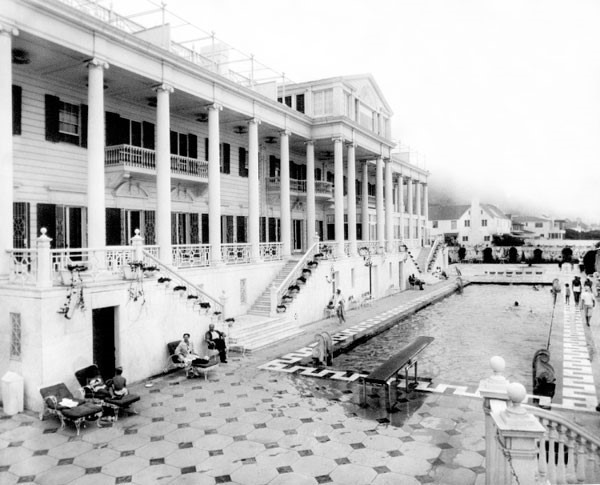 |
|
| (ca. 1930s)* - View showing guests enjoying a day by the pool at Marion Davies' mansion in Santa Monica. |
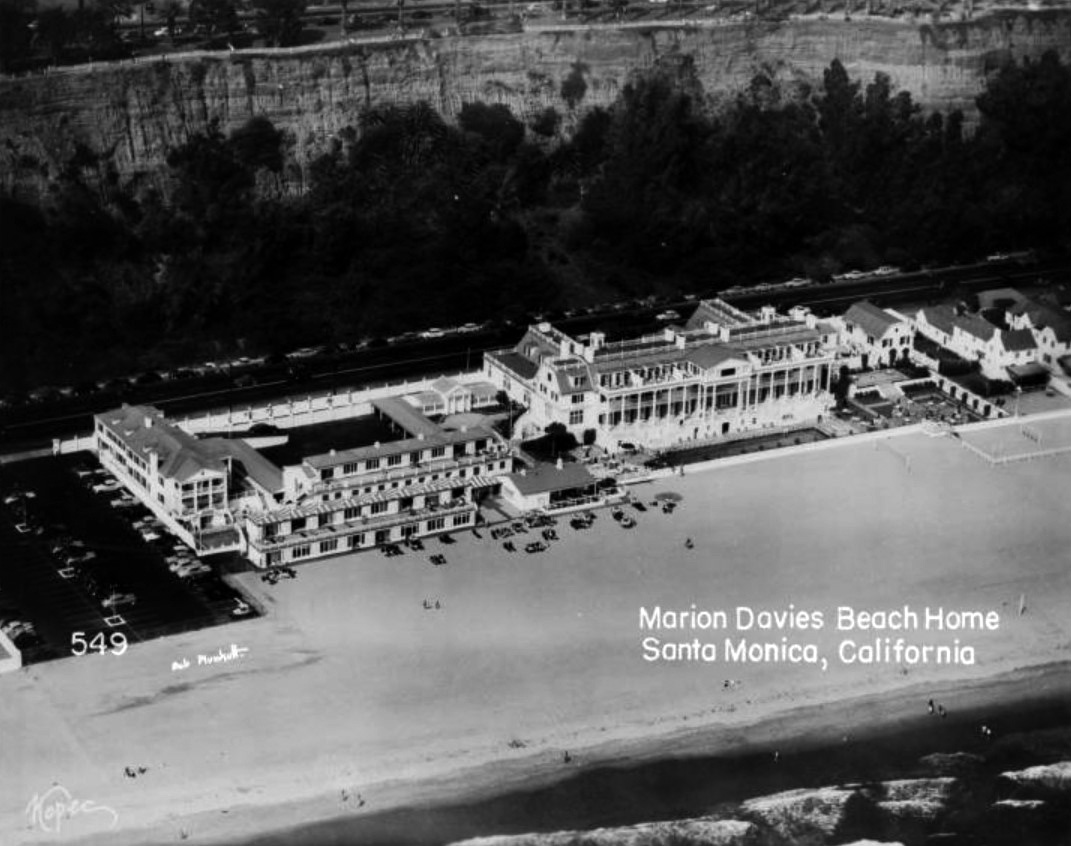 |
|
| (ca. 1950)* - Aerial view of Ocean House (or the Oceanhouse Hotel) and the Sand and Sea Beach Club on the property that was formerly the mansion of actress Marion Davies on the beach in Santa Monica, California, with Palisades Beach Road (part of Pacific Coast Highway) and the bluffs below Palisades Park in the background. |
Historical Notes In 1947, Davies sold the estate and it was converted into the Oceanhouse Hotel and Sand & Sea Beach Club. The main mansion was demolished in 1956, and the property was sold to the State of California in 1959. The Sand & Sea Club remained popular with regulars all the way through until the 1990s. In 2005, the Annenberg Foundation, at the recommendation of Wallis Annenberg, made a generous financial commitment to preserve the site for public use. The Annenberg Community Beach House at Santa Monica State Beach opened to the public on April 25, 2009, representing a unique partnership between the Annenberg Foundation, California State Parks and the City of Santa Monica. The total construction costs were roughly $30 million. |
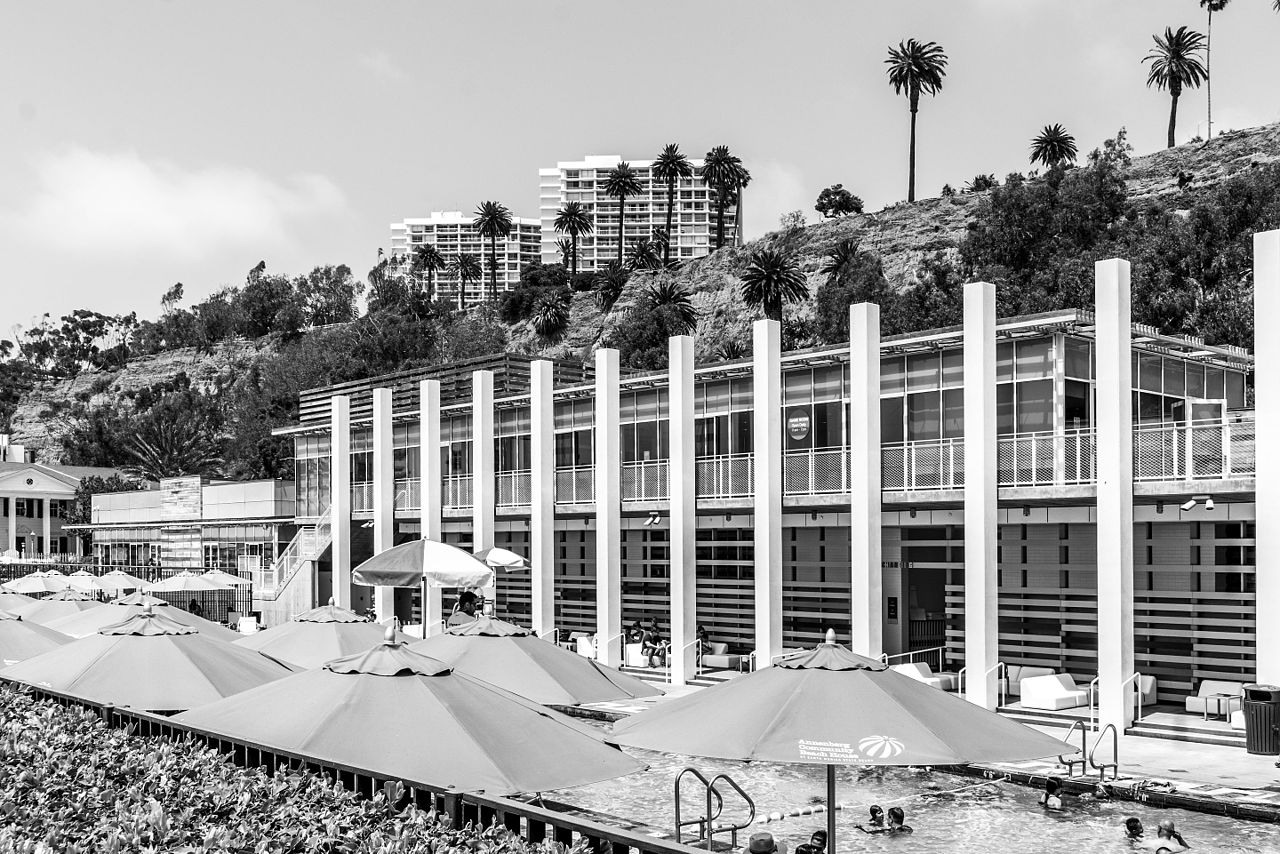 |
|
| (2016)* - View of the restored Marion Davies Mansion pool, now part of the Annenberg Community Beach House. Photo by Mike Hope / Wikipedia |
Historical Notes The mansion's original pool was restored by the Annenberg Foundation and opened to the public on a fee for entry basis in 2009. The pool is trimmed in tile and has a marble deck. The mansion's original guest house also still exists and is used for events. New facilities include a pool house with changing areas and a second floor view deck, a new event house, a splash pad, gardens, beach volleyball/tennis courts, a children's play area, public restrooms, beach rentals, and a cafe. |
* * * * * |
Lasky Residence
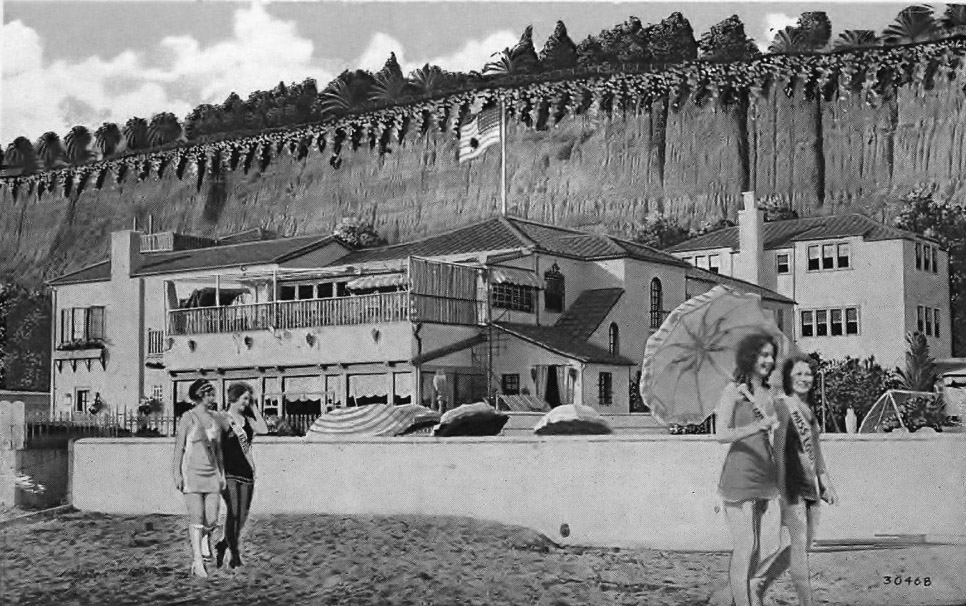 |
|
| (1920s)* – Postcard view showing the beach home of Jesse Lasky (one of the founders of Paramount Pictures), located at 609 Ocean Front Walk across from the Sorrento/Gables. |
Historical Notes Filled with antiques and guests, the Lasky home became a magnet for stars, performers, and executives. From hosting lavish open air extravaganzas to spontaneous get-togethers, the beach house was where Hollywood culture maven Bess Lasky held court. |
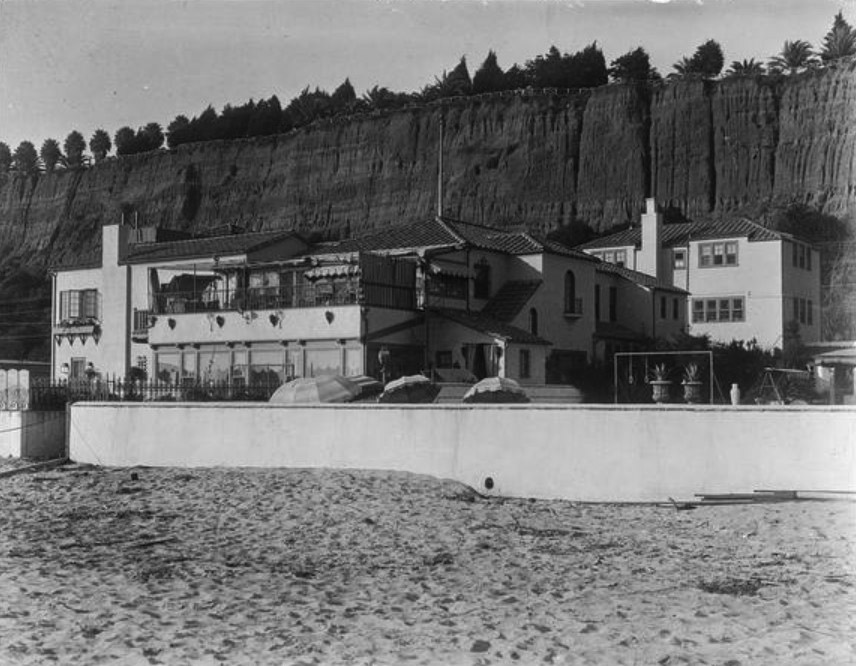 |
|
| (1928)* – View showing the Jesse L. Lasky residence, with Spanish tile roof, large balcony, enclosed and open patios, umbrellas, and playground equipment, with beach and wall in foreground and cliffs in background. |
Historical Notes "'Our Santa Monica beach house, 609 Ocean Front, was a two-story hacienda surrounding a garden with a fountain. It originally had twelve guest suites...[which] my father enlarged..still further. We became a kind of hotel for the famous...I can remember no time when we were not inundated with house guests.” – Jesse L. Lasky, Jr. In 1930, Lasky traded Paramount shares and the beach house to Harry Warner for $250K. |
* * * * * |
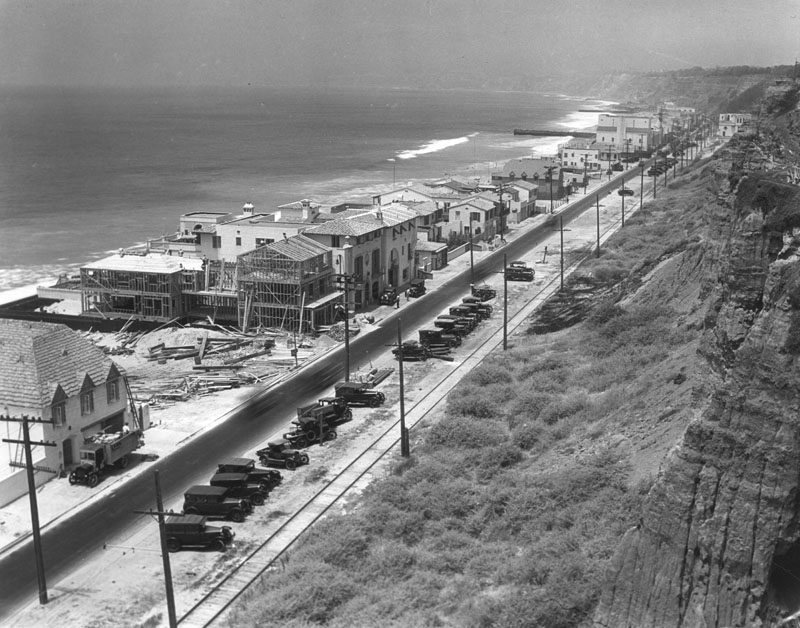 |
|
| (ca. 1930)* - Roosevelt Highway, later renamed the Pacific Coast Highway (PCH), as seen from Palisades Park in Santa Monica. The highway runs parallel with the many beach clubs, restaurants, and residences on the coast. In the distance are Pacific Palisades, where the landmark Lighthouse bathhouse is located, and the Santa Monica Mountains. |
Historical Notes The Hollywood set and the uber-rich were drawn to Santa Monica’s beach in the 1920s & 30s. The opulent residences they constructed north of the Pier and fabulous parties they threw earned this stretch of sand the nickname of “Gold Coast”. Many other Hollywood stars, producers and movie studio moguls also built homes on Santa Monica's beach in the 1920s. Douglas Fairbanks and Mary Pickford were among the first to make the move. |
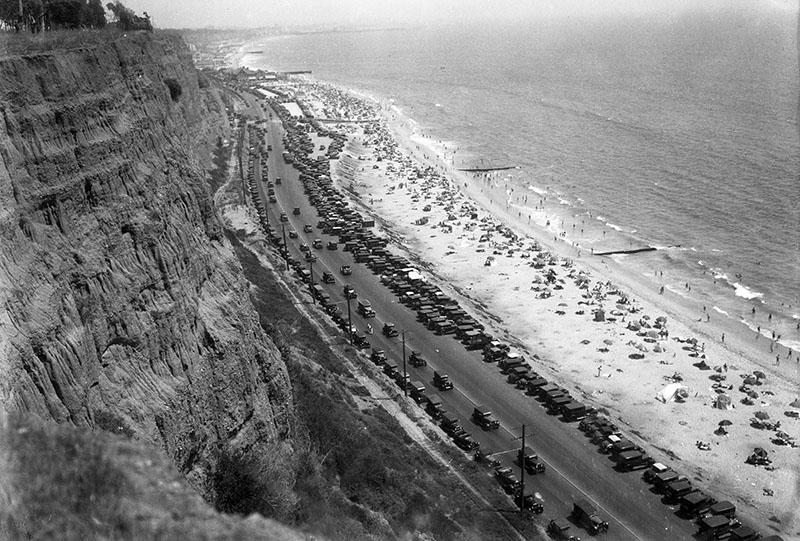 |
|
| (1931)* - Looking down upon the Roosevelt Highway (later Pacific Coast Highway) and crowds at the beach from the cliffs in Pacific Palisades. |
 |
|
| (1934)* - Caption reads: A new link in the Roosevelt highway and an improved coastal boulevard which replaces the old narrow road along the beach at the foot of the Santa Monica Palisades, will be formally opened and dedicated on Monday afternoon. Governor F. F. Merriam and state, county and municipal officials will join in ceremonies which will climax months of work. Photo shows the highway link, which has been widened to 80 feet and extends nearly one mile. Arrow shows where boulevard rises to connect with Wilshire Boulevard on Ocean Avenue. |
* * * * * |
Sorrento Club Garage (later known as the Sorrento Ruins)
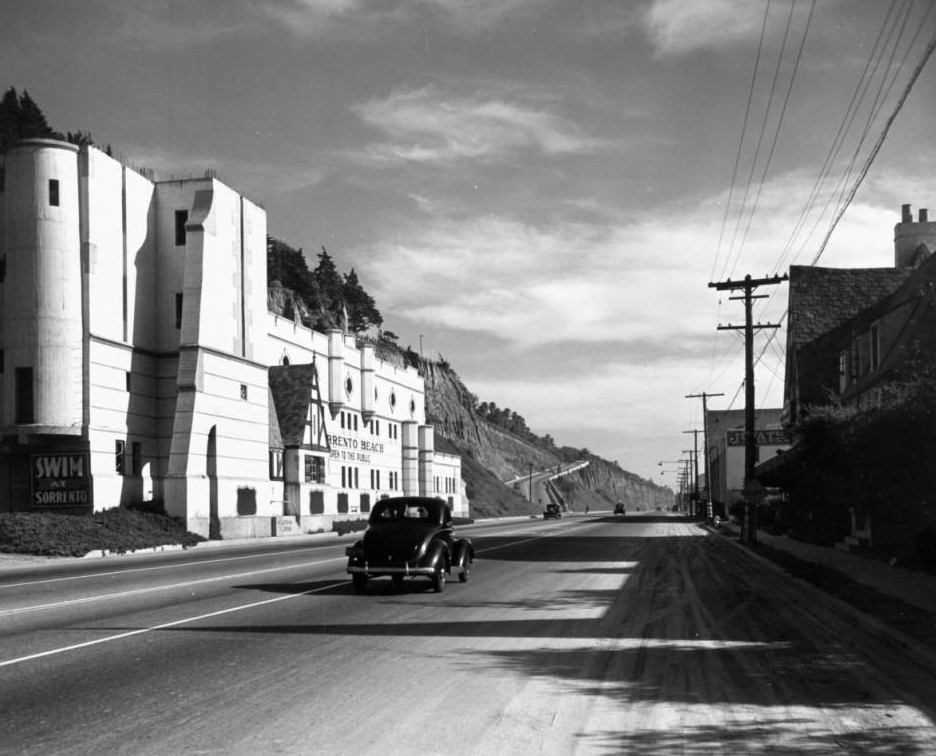 |
|
| (1936)* - View showing a car travelling south on Roosevelt Highway (later PCH) in Santa Monica with the Sorrento Beach Club garage on the left and the California Incline in the distance. |
Historical Notes IIn the 1920s, “Promoters decided to create a fantastic club (Gables Beach Club) and hotel complex on the cliffs at the foot of Montana Avenue...Designed to emulate the grandest castle-like structures of Europe.....would be twenty-one stories high and would include the first new bridge to span the beach road." - (from the book) Santa Monica Beach by Ernest Marquez |
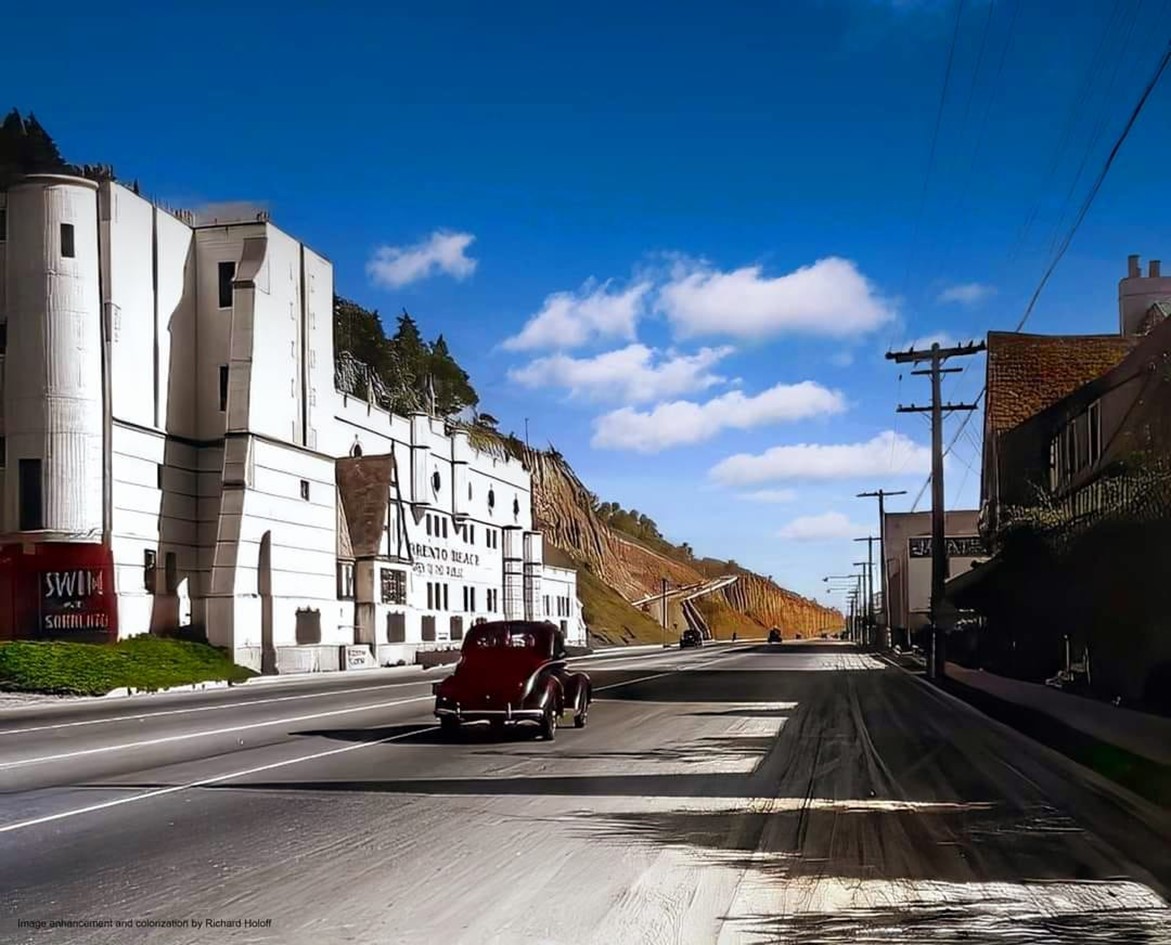 |
|
| (1936)* - View showing a car travelling south on Roosevelt Highway (later PCH) in Santa Monica with the Sorrento Beach Club garage on the left and the California Incline in the distance. Photo by 'Dick' Whittington; Image enhanced and colorized by Richard Holoff |
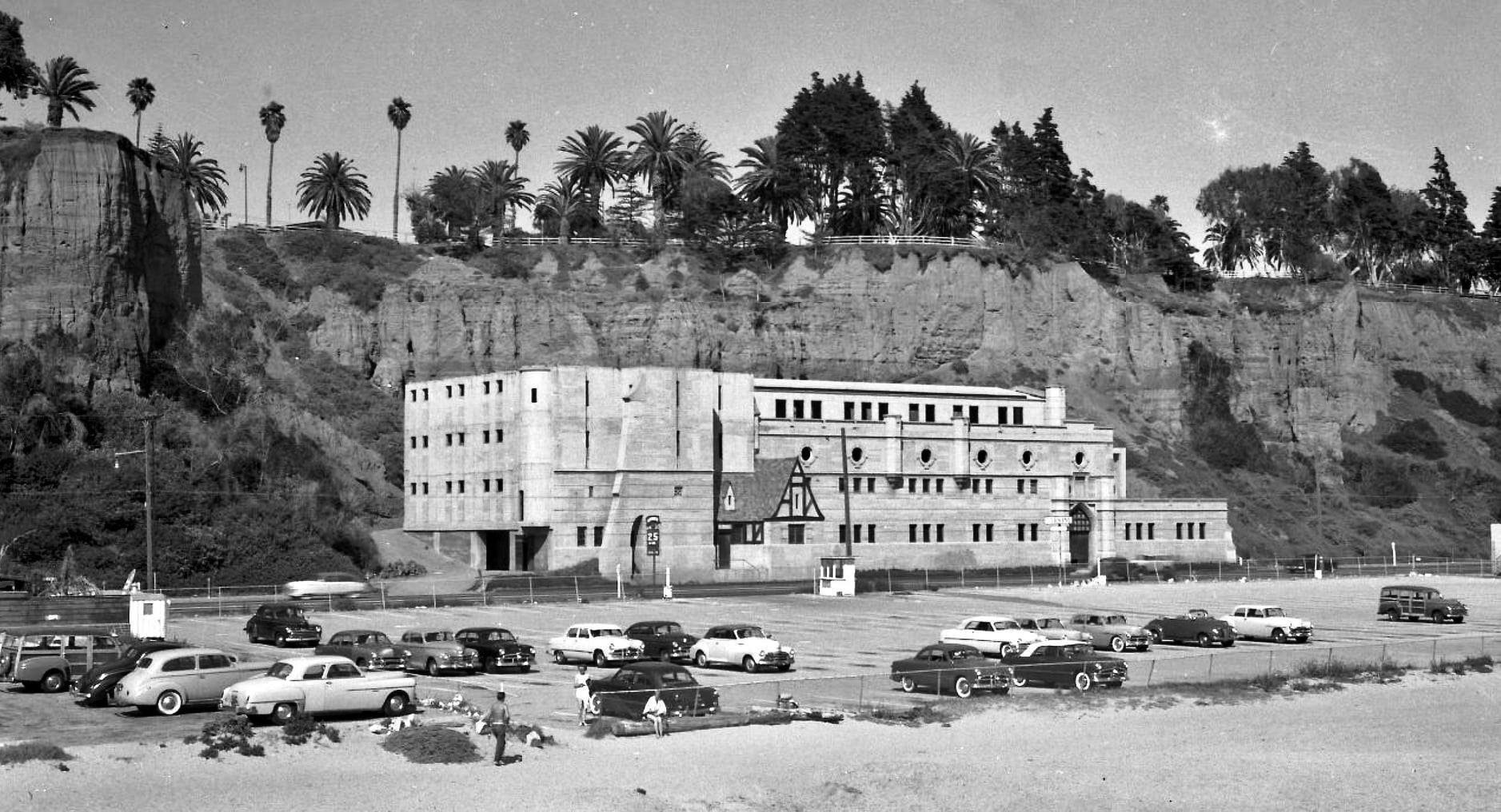 |
|
| (ca. 1950)^ – Panoramic view towards the Palisades bluffs, showing the ruins of the Sorrento Club parking structure with another parking lot visible in the foreground. |
Historical Notes Originally designed to be 21 storys tall, only three stories were completed (1928) when the Great Depression hit. The smaller building would be used as a garage for Gables Beach Club across the street until a fire partially destroyed the club (1930). Within two years the club was rebuilt and reopened as the Sorrento Beach Club and the 3-story building continued to be used as a parking garage until 1962. Click HERE to see a postcard illustration of the proposed 21-story Gables Hotel. |
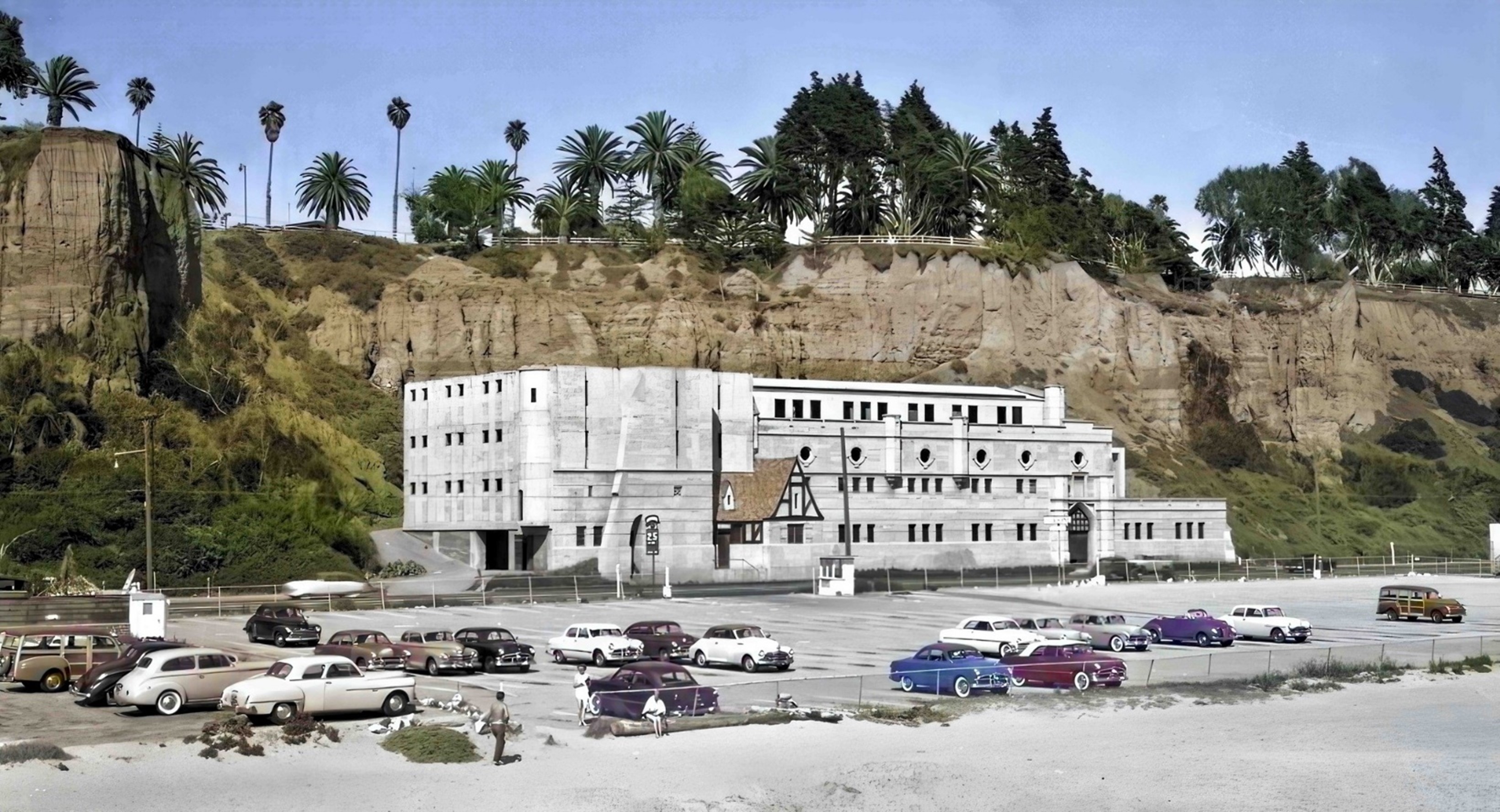 |
|
| (ca. 1950)^ – Panoramic view towards the Palisades bluffs, showing the ruins of the Sorrento Club parking structure with another parking lot visible in the foreground.Image enhancement and colorization by Richard Holoff. |
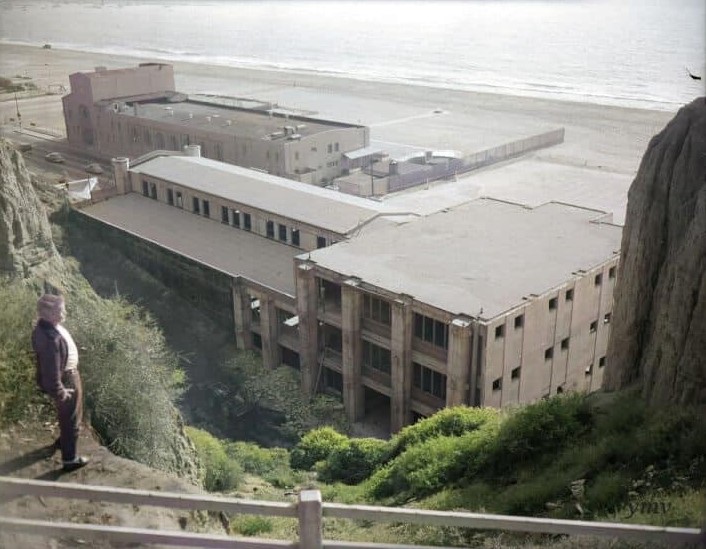 |
|
| (ca. 1950)* - Man standing at the edge of the Santa Monica Palisades bluffs looking down at the Sorrento Ruins. |
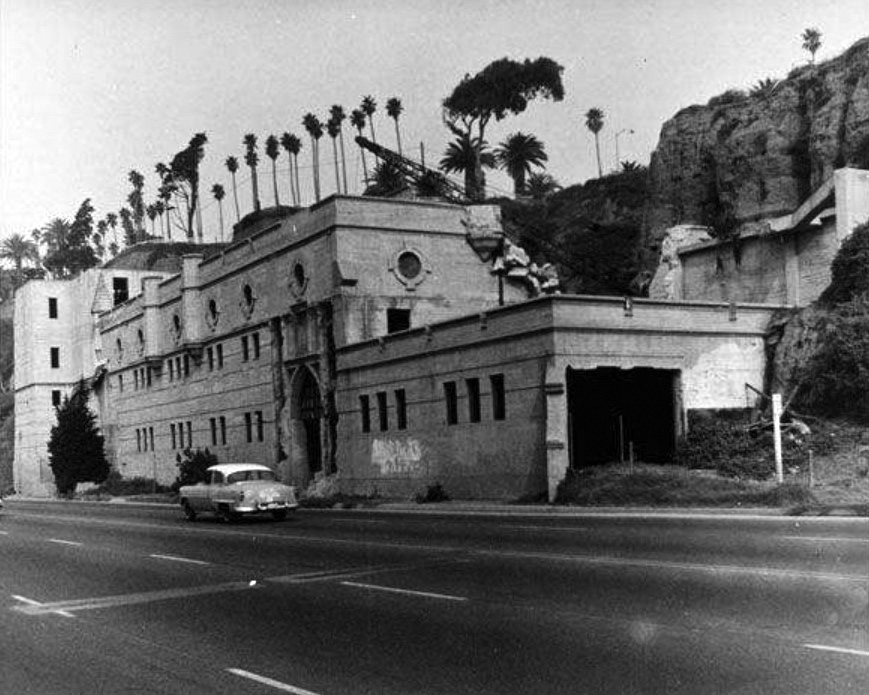 |
|
| (ca. 1952)* – View showing the ruins of the Gables Hotel, later Sorrento Club parking structure with the Palisades bluffs in the background. The structure was known as the Sorrento Ruins. |
Historical Notes The Sorrento Ruins were left standing until the 1970s and then demolished. Today, part of the foundation is still visible and is being used as a retaining wall. |
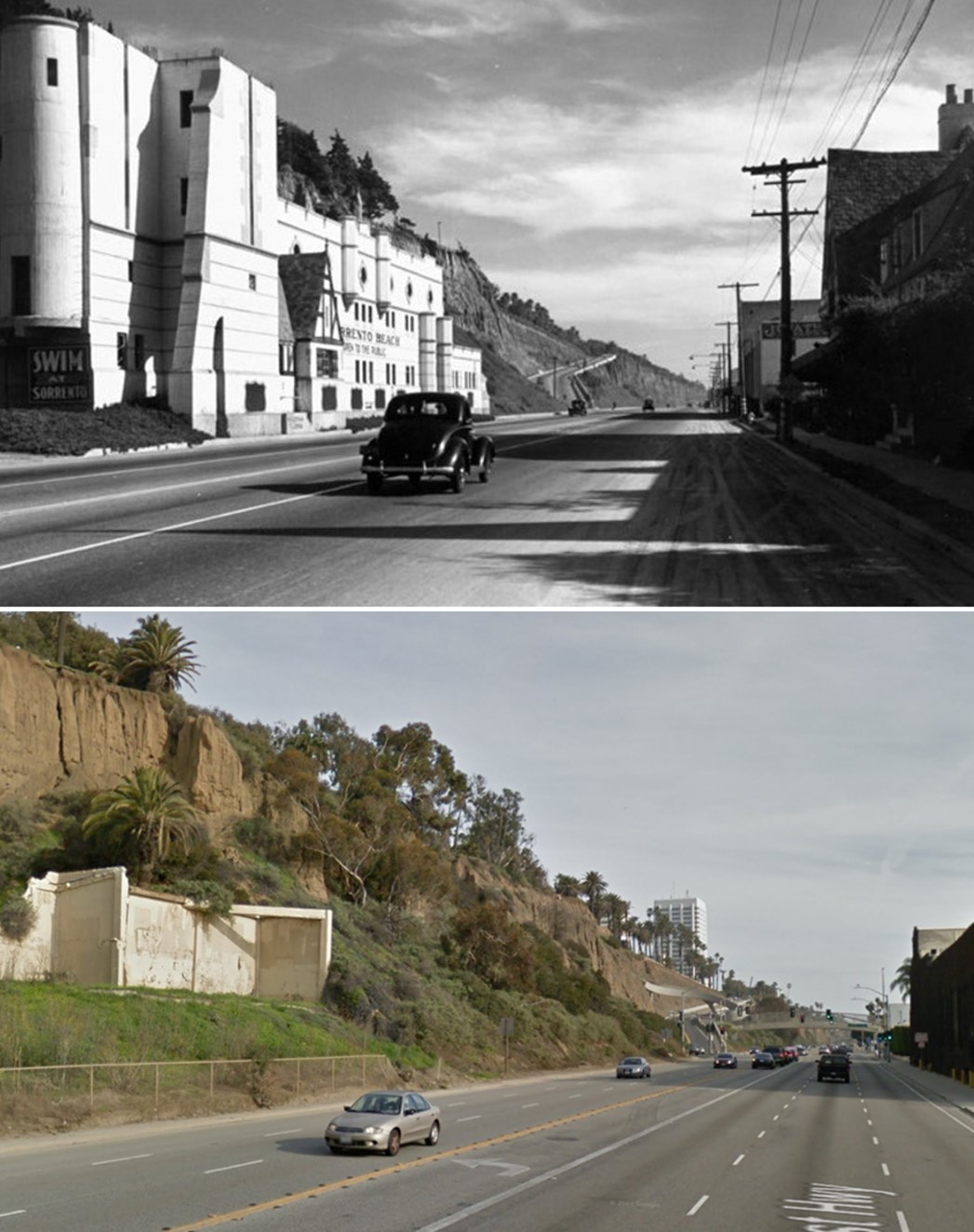 |
|
| (1936 vs. 2017)* - Looking south on PCH (CA-1) toward the California Incline showing the Sorrento Club and Ruins. |
* * * * * |
California Incline (1929 +)
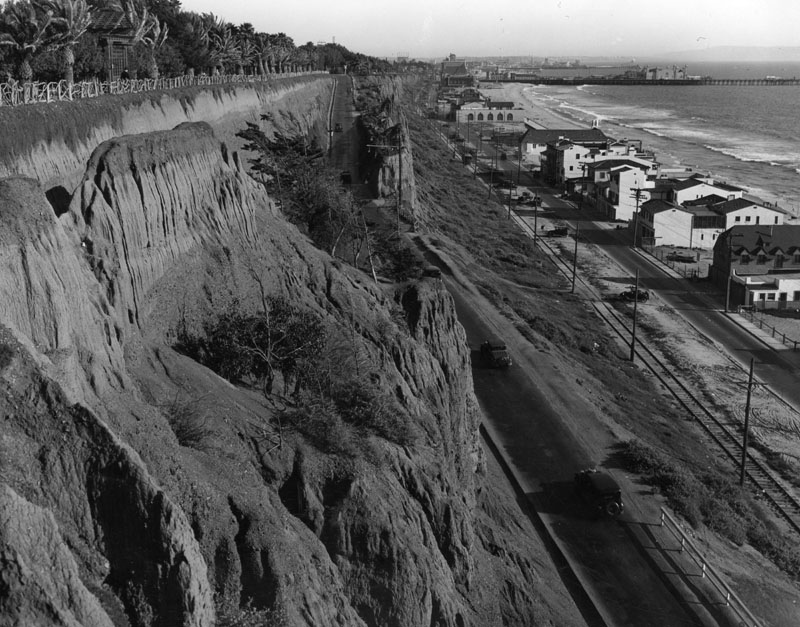 |
|
| (ca. 1929)* - View of Santa Monica looking south from Palisades Park. In the foreground the slope of the California Incline cuts diagonally downhill; below lie beach houses, the bathing-area buildings and the shoreline. The Santa Monica Municipal Pier appears faintly in the distance. |
Historical Notes Before the Incline existed, beachgoers reached the shore by footpaths such as the Sunset Trail or stairways like the 99 Steps. Around 1905, a rough dirt road called Linda Vista Drive was carved into the bluffs, giving automobiles a shortcut to the beach. It was later paved and renamed the California Incline, taking its name from the street it connected with at the top—California Avenue. |
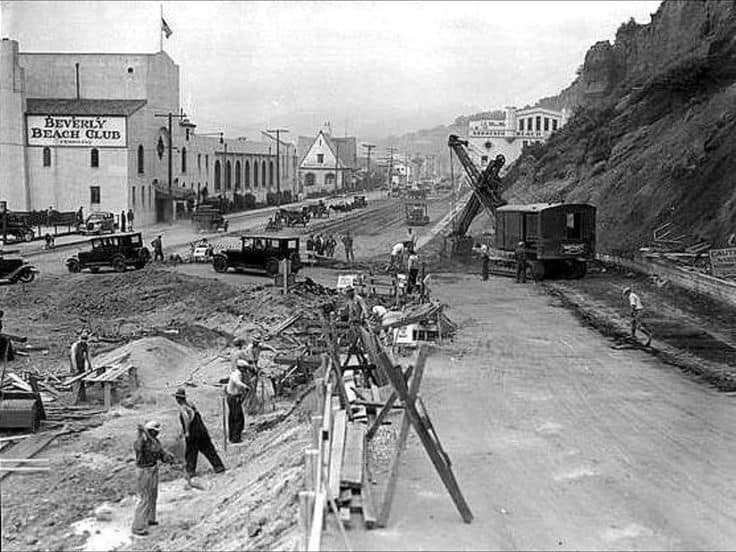 |
|
| (ca. 1929)* – Construction crews widening the Roosevelt Highway and the California Incline. |
Historical Notes During the late 1920s, the California Incline was widened and improved by the California Division of Highways as part of the coastal highway upgrade. Around the same time, the coast road was formally dedicated as the Theodore Roosevelt Highway, later known as the Pacific Coast Highway. These improvements modernized the Incline, doubling its width and turning it into a vital link between the expanding beach route and the city above. |
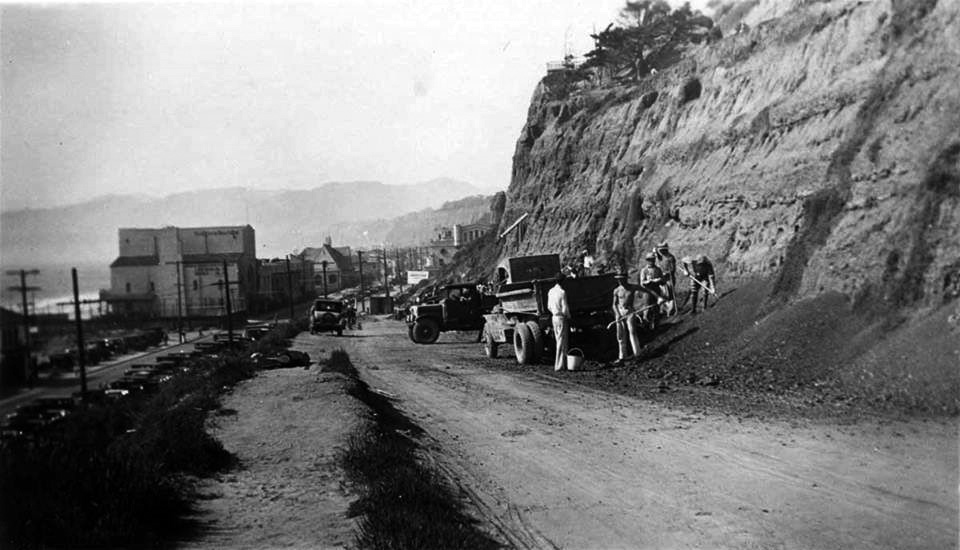 |
|
| (ca. 1929)* – Work crews widening the California Incline to improve automobile access from the bluffs to the beach road below. |
Historical Notes The widening of the Incline required reinforcing the soft sandstone cliffs that supported the road. Concrete retaining walls and surfacing were added to handle the growing number of vehicles using the route. The project transformed a narrow cliffside path into one of Santa Monica’s signature automobile approaches, reflecting the city’s rapid embrace of the motor age. |
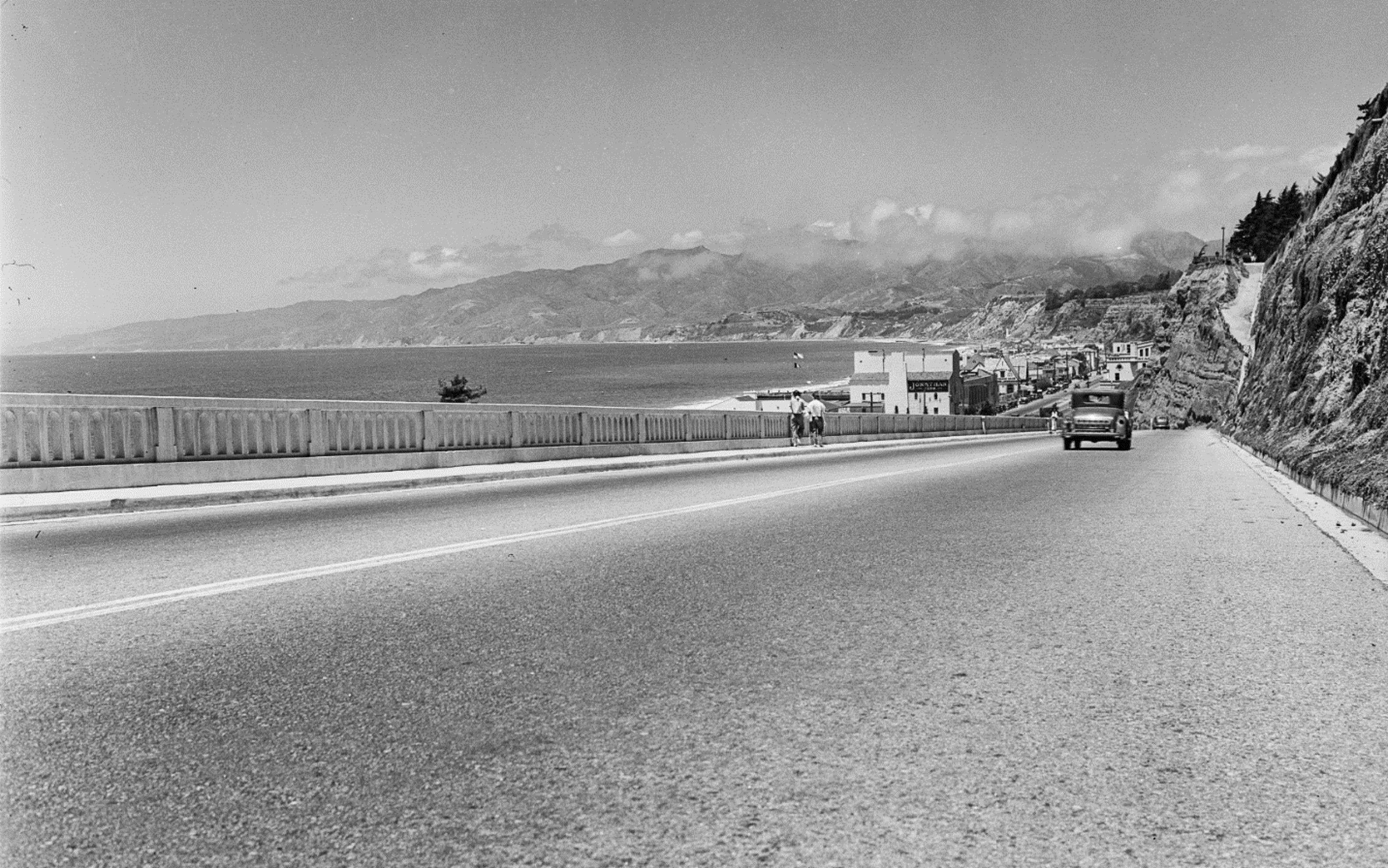 |
|
| (1930s)* - View looking north along the concrete California Incline, with early automobiles heading between the beach and Ocean Avenue. Photo from the Ernest Marquez Collection. |
Historical Notes By the 1930s, the California Incline was a fully paved concrete roadway carrying steady traffic between the Pacific Coast Highway and the bluff-top neighborhoods. The half-mile incline connected the growing coastal highway system to downtown Santa Monica and Palisades Park, making it an essential route for both residents and visitors. |
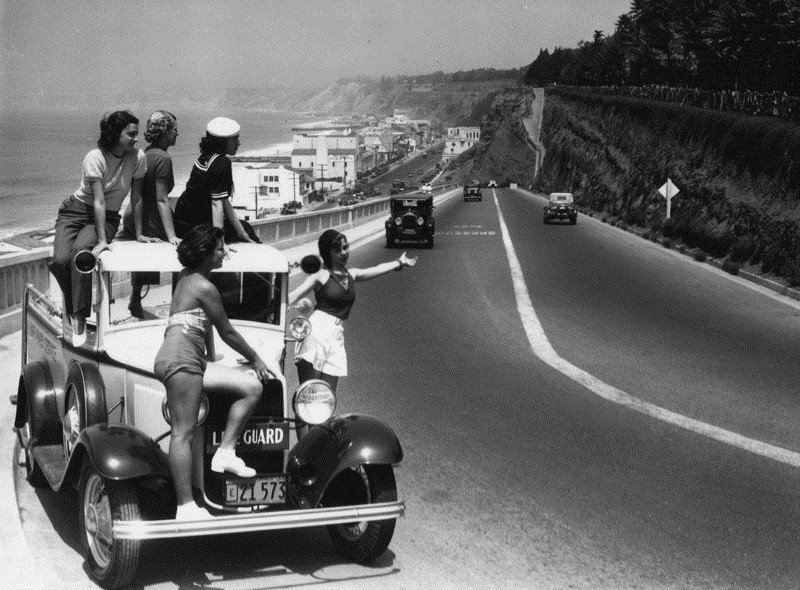 |
|
| (1930s)* - Five women ride in an open-bed lifeguard truck atop the California Incline, with the beach visible below. |
Historical Notes Scenes like this captured the spirit of the California Incline in its early decades—a place of sun, leisure, and local pride. The Incline linked Santa Monica’s beach life with its civic center, and became part of the city’s identity as a hub of recreation, lifeguard services, and coastal culture. |
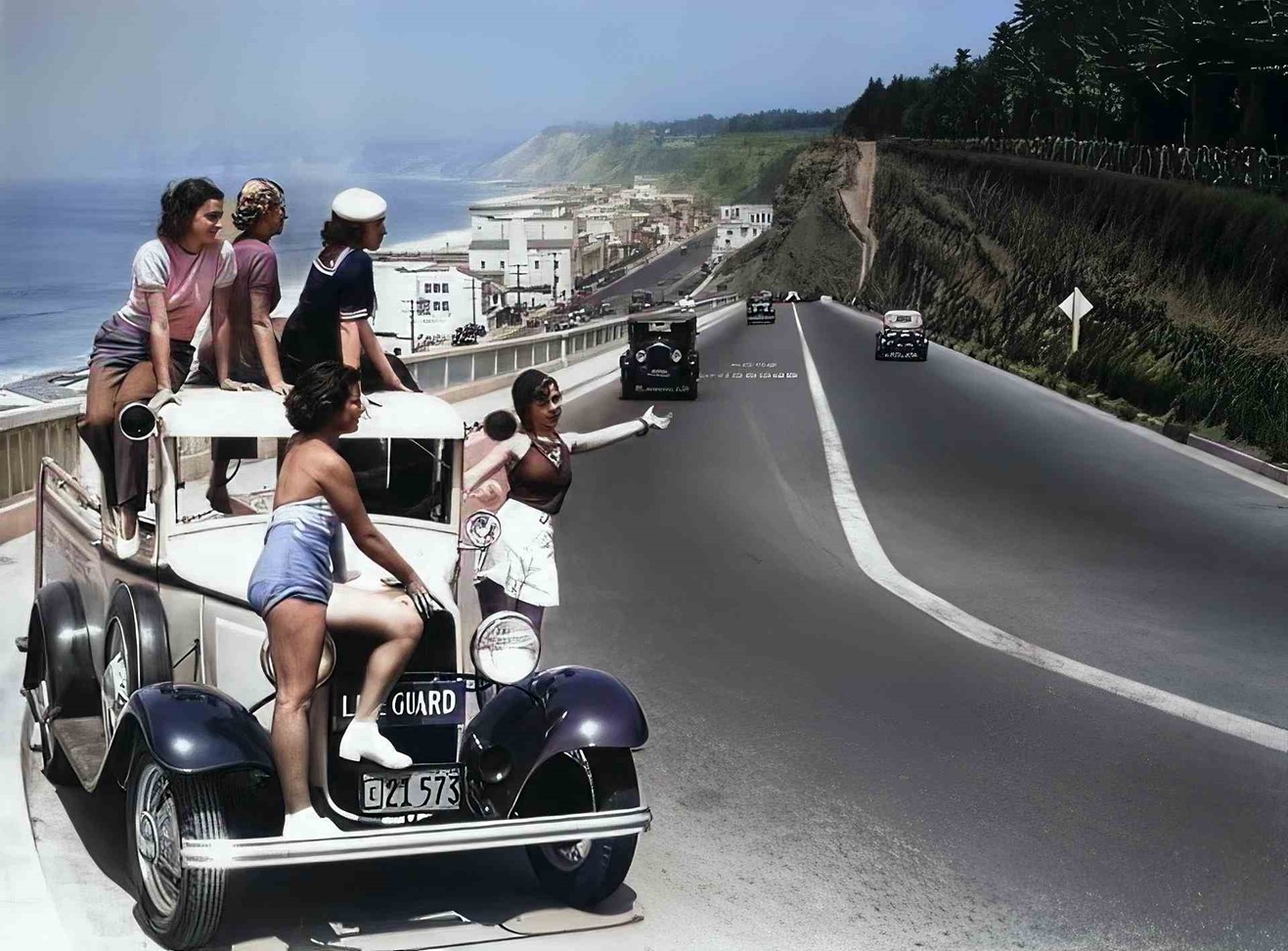 |
|
| (1930s)* - California Incline, Santa Monica (AI image enhancement and colorization by Richard Holoff). |
Historical Notes By this era, the Incline’s concrete balustrades and graceful curve down the bluff had become instantly recognizable. Its design reflected both function and beauty—a practical link to the beach and a scenic drive that framed sweeping ocean views. |
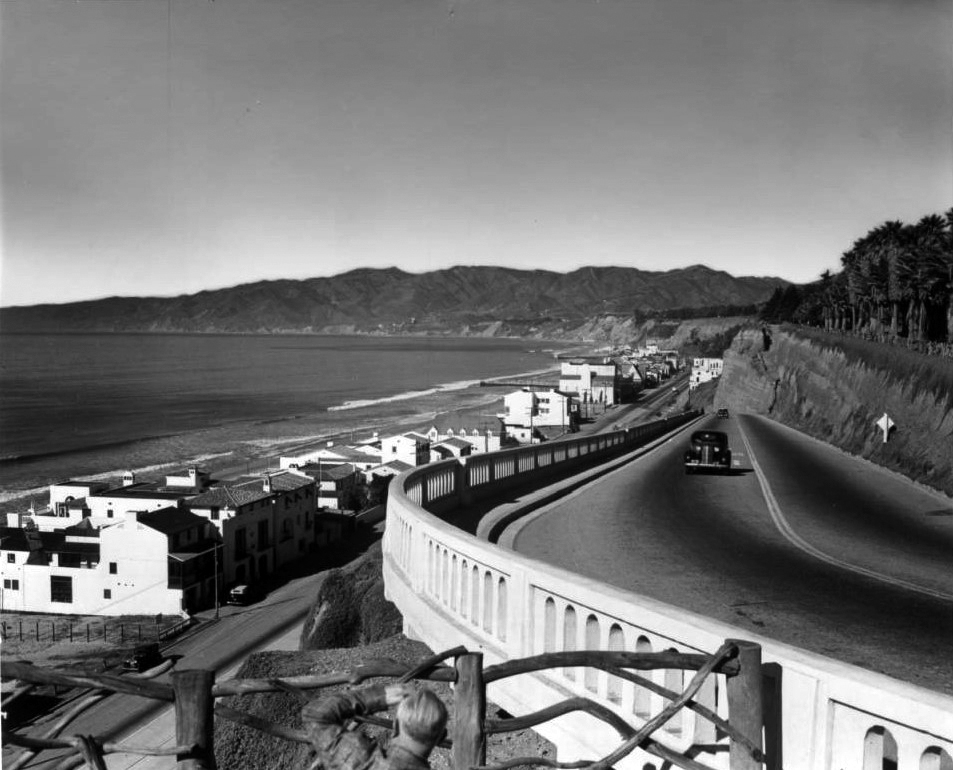 |
|
| (ca. 1938)* – A man looks down toward the Santa Monica coastline from the top of the California Incline. Photo by Dick Whittington. |
Historical Notes This quiet moment from the late 1930s shows the Incline’s dual purpose—as a transportation route and as a scenic overlook. From the top of the bluff, Palisades Park offered panoramic views of the ocean, while the Incline provided a graceful descent to the beach and the Pacific Coast Highway below. |
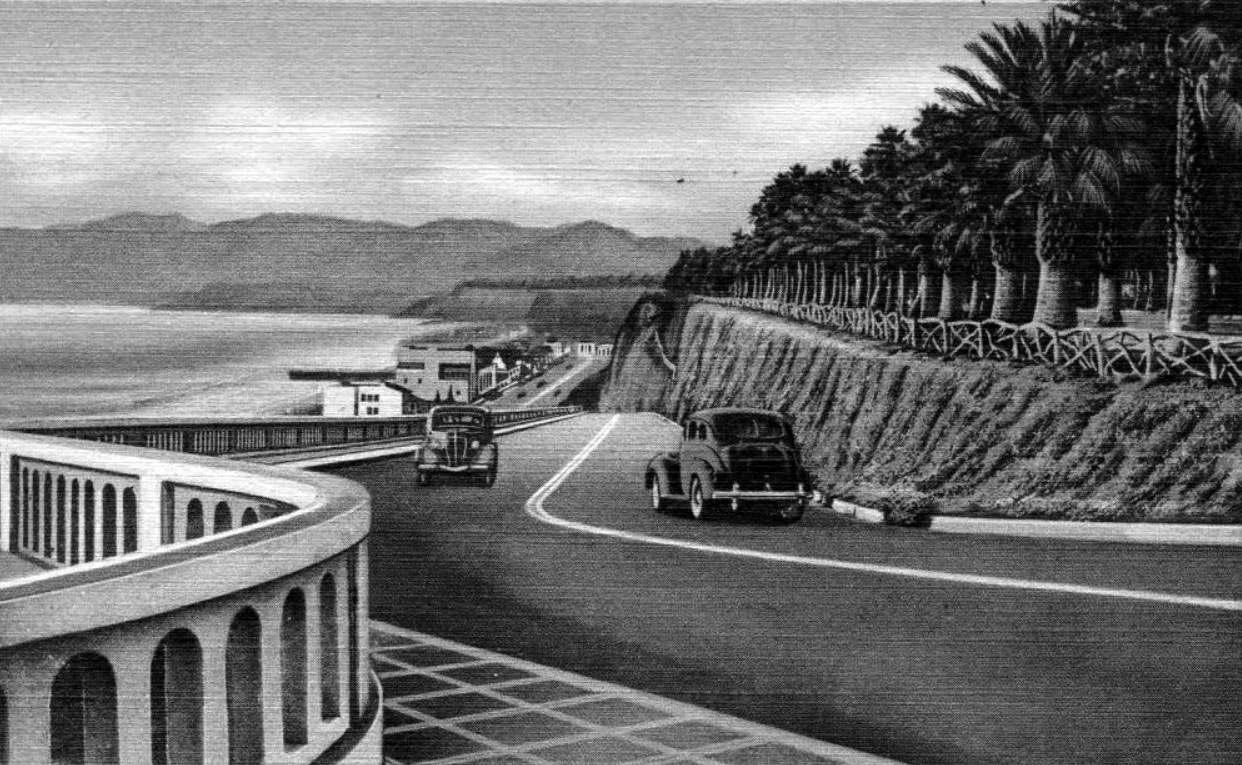 |
|
| (ca. 1938)* – Postcard view showing cars traveling up and down the California Incline, which runs between Ocean Avenue and Pacific Coast Highway. Palisades Park is on the right. |
Historical Notes Color postcards of this era often featured the Incline as a symbol of Santa Monica’s charm. The curving roadway, palm-lined park, and beach below captured the harmony between urban design and the natural coastline. The Incline was widely regarded as one of the most scenic gateways in Southern California. |
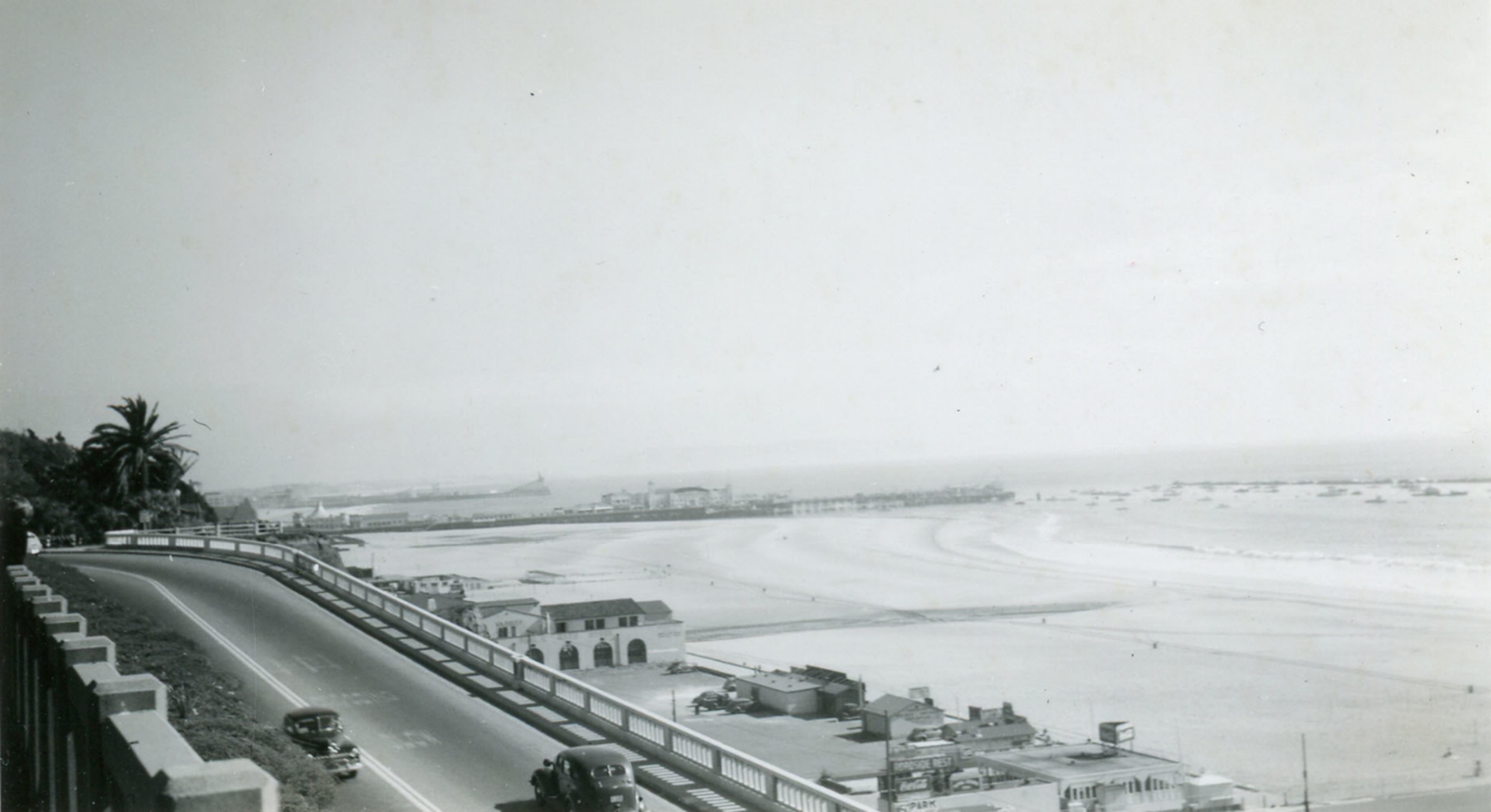 |
|
| (1949)* – Looking south from Palisades Park, this view takes in the California Incline, the Santa Monica Municipal Pier and Yacht Harbor, and the Ocean Park Pier. Photo from the Eric Weinberg Collection. |
Historical Notes By the post-war years, the Incline had become a fixture of Santa Monica’s beach culture, linking the bluff-top city streets to the busy piers and amusement zones below. The Santa Monica Municipal Pier and the adjacent Yacht Harbor were central gathering places for fishing, boating, and entertainment—easily reached by way of the California Incline. |
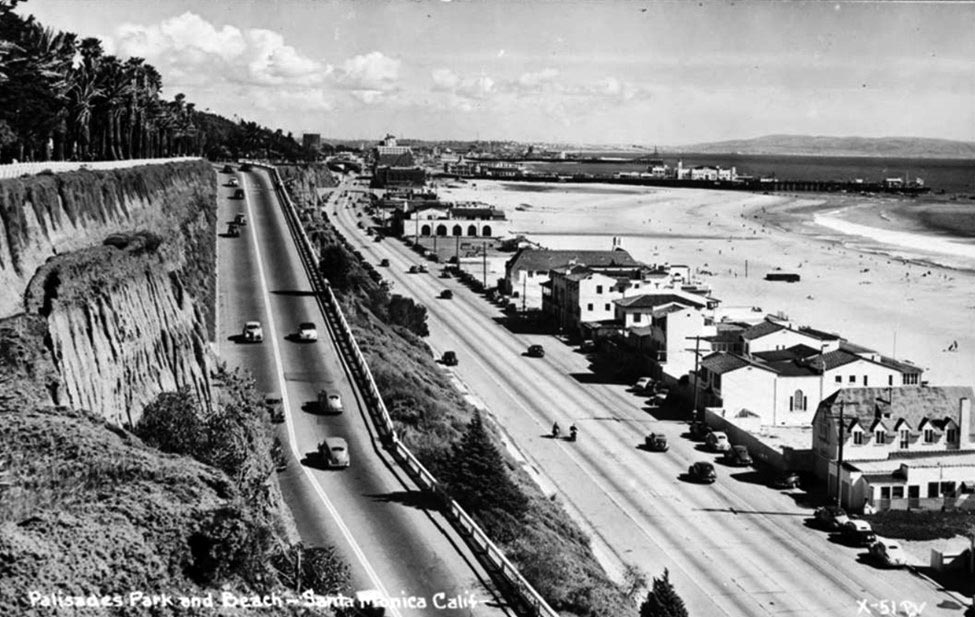 |
|
| (1940s)* - Postcard view showing the California Incline road with automobiles, leading down from bluffs and Palisades Park down to Pacific Coast Highway. Beach houses, the Santa Monica Pier with the La Monica Ballroom at its center, and other buildings are also in this view, with Ocean Park amusement piers in the distance. |
Historical Notes During the 1940s, the beach and pier area flourished with dance halls, restaurants, and small cottages along the shore. The California Incline served as the main link between downtown Santa Monica and the thriving beachfront, making it one of the most photographed stretches of roadway on the coast. |
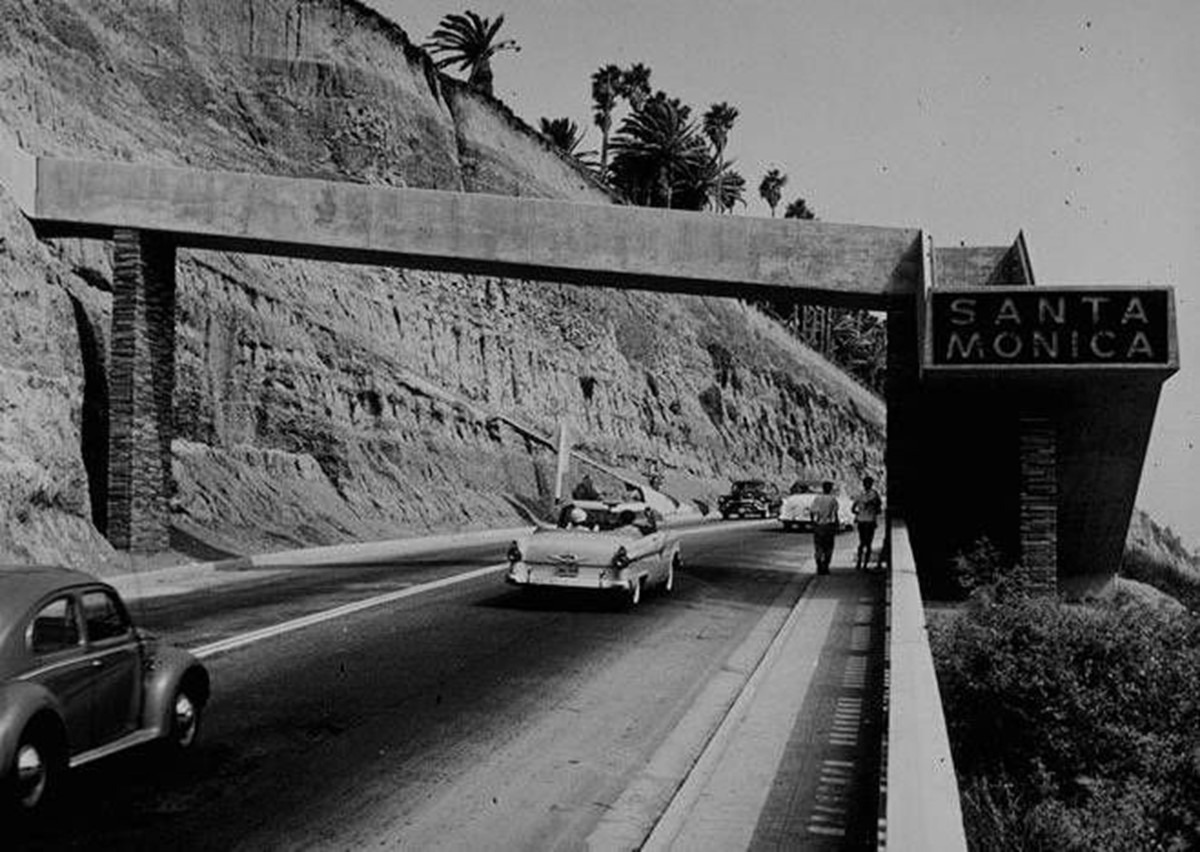 |
|
| (1957)* - Heading up the California Incline toward the pedestrian over-crossing that connects Palisades Park atop the bluff to the bridge across the Pacific Coast Highway below. |
Historical Notes In 1957, Santa Monica built its first dedicated pedestrian bridge across the California Incline to improve safety for beachgoers and residents. Before this bridge, pedestrians had to share the roadway or descend steep stairways cut into the bluffs. The new overcrossing, officially known as the Idaho Avenue Pedestrian Overcrossing, linked Palisades Park and Ocean Avenue at the top with a stairway and walkway leading to the beach and Pacific Coast Highway below. Constructed of reinforced concrete with steel railings, it reflected the city’s postwar commitment to both recreation and public safety as beach traffic and tourism surged. |
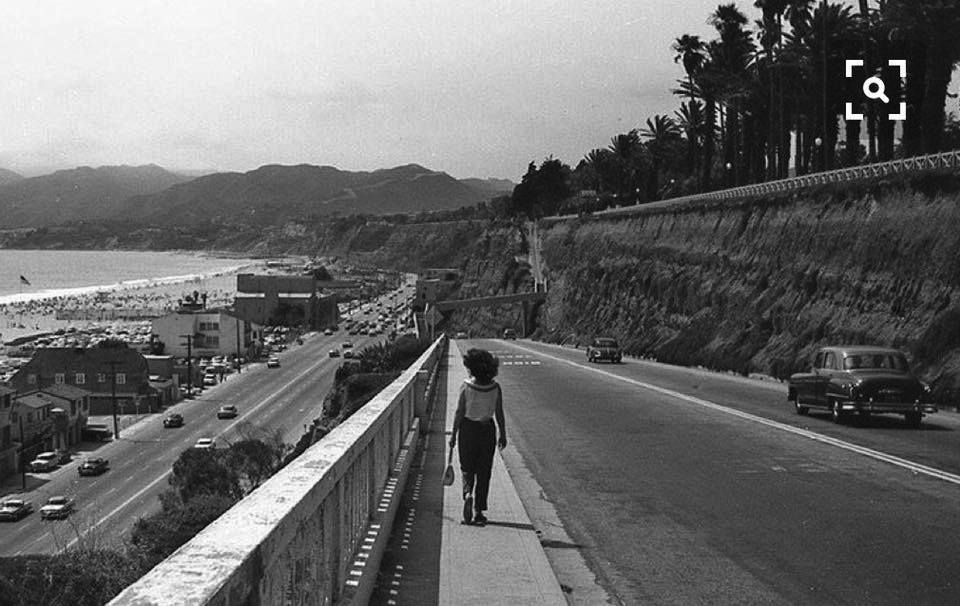 |
|
| (1959)* – A woman walks down the California Incline toward the Pacific Coast Highway and the beach below. |
Historical Notes This image reflects a quieter side of the Incline, showing it as part of everyday life for locals as well as tourists. For generations of residents, walking the Incline became a ritual—offering sea air, exercise, and one of the best views in town. |
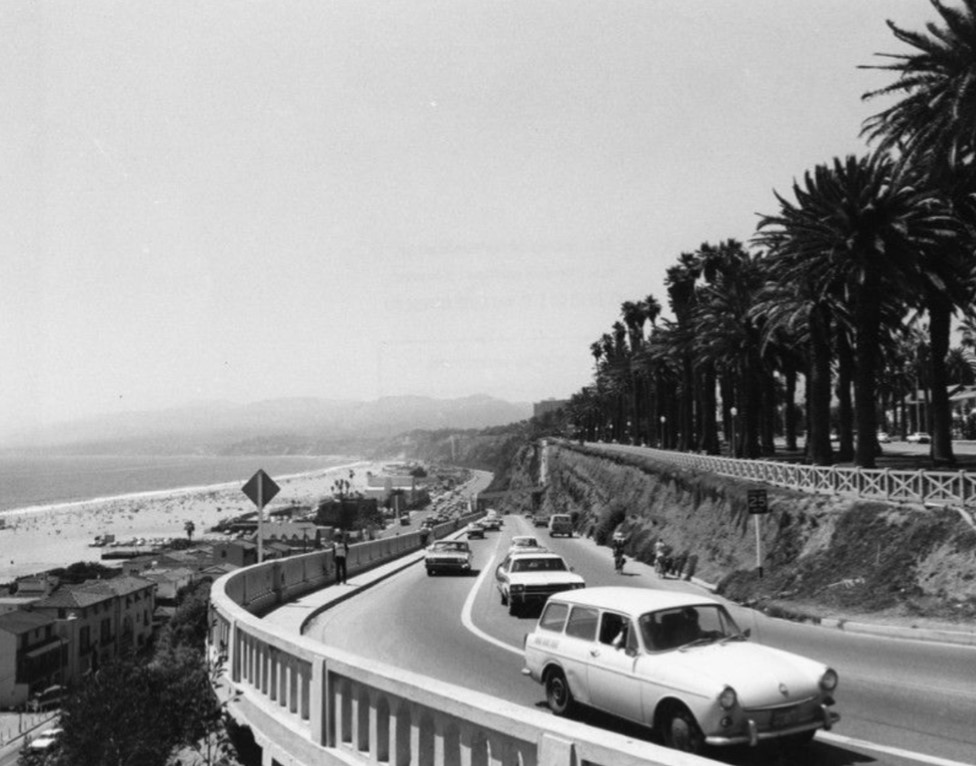 |
|
| (1972)* - Looking north along the Palisades bluffs from the California Avenue Incline Bridge, connecting Ocean Avenue to the Pacific Coast Highway. |
Historical Notes By the 1970s, the road was officially known as the California Avenue Incline Bridge. It remained a vital connector but was beginning to show its age after decades of coastal erosion and increasing vehicle loads. Plans for eventual reconstruction were already being discussed by city engineers. |
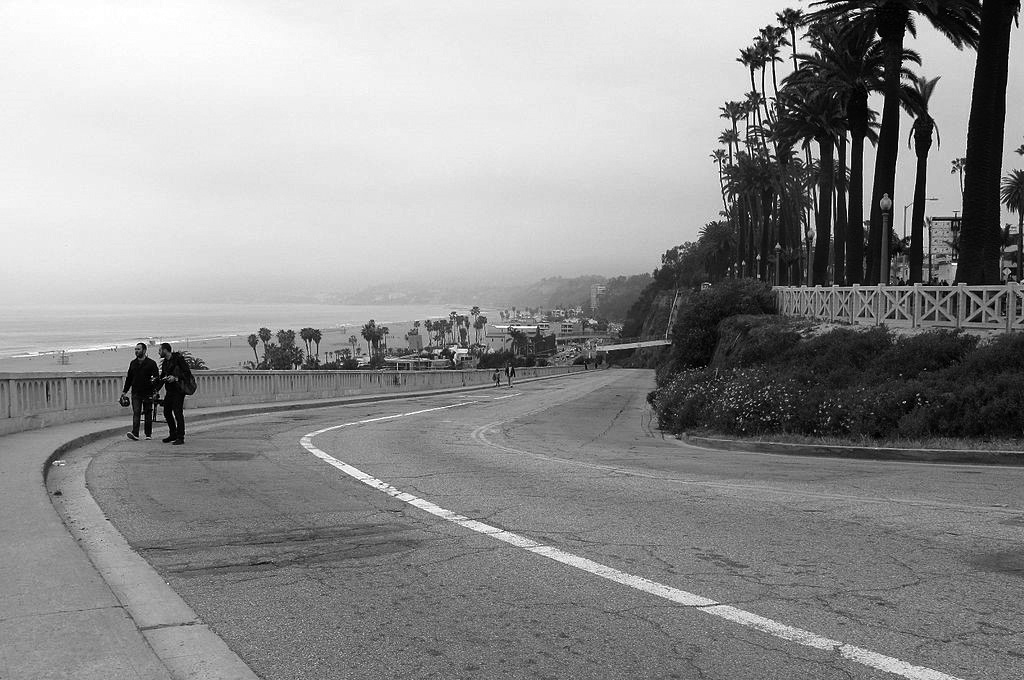 |
|
| (2013)* - Two men walk up the California Incline using the roadway instead of the narrow sidewalk. Photo by “Tinton5.”/ Wikipedia |
Historical Notes By the early 1990s, engineers had determined that the original Incline bridge no longer met modern seismic standards. Funding for its replacement was secured in 2007, but construction did not begin until 2015. This photo shows the old roadway shortly before demolition, capturing the familiar curve that had carried cars and pedestrians for more than a century. |
.jpg) |
|
| (2020)* – California Incline after its full reconstruction, featuring lanes for cars, cyclists, and pedestrians, along with two new bridges linking Palisades Park and the beach. Photo courtesy of Steve Loeper / Santa Monica Conservancy. |
Historical Notes Reopened with much celebration in 2016, the rebuilt California Incline was engineered to current seismic standards while preserving its classic appearance. The new structure is supported by deep concrete pilings and stabilized with more than a thousand soil anchors. Today the Incline serves as a multi-modal route—welcoming vehicles, cyclists, and walkers—and remains one of Santa Monica’s most iconic coastal landmarks. Click HERE to see more Early Views of the California Incline (1905+). |
Then and Now
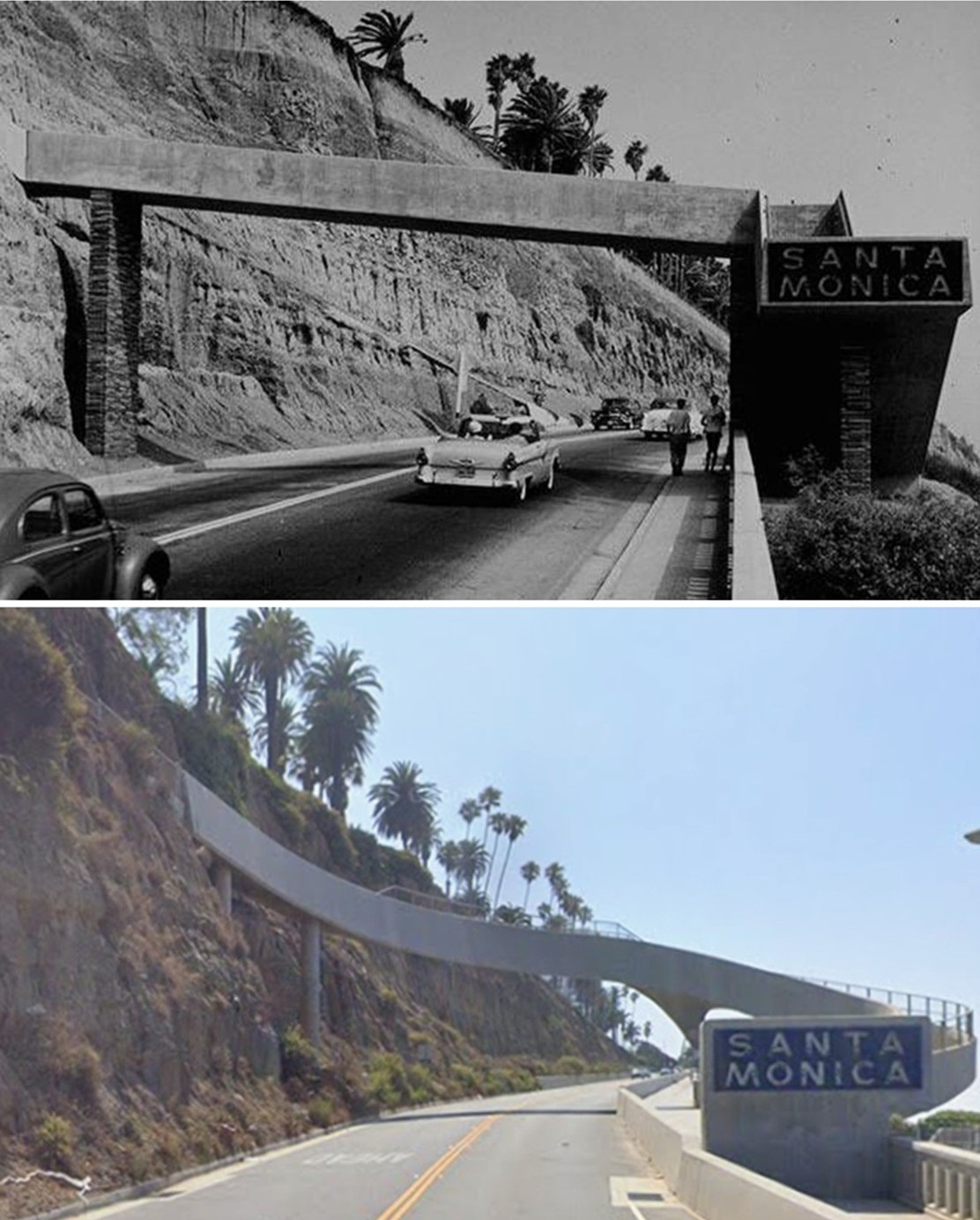 |
|
| (1957 vs. 2025)* – Looking up the California Incline toward the pedestrian crossing that connects the Palisades Park at the top to the bridge crossing Pacific Coast Highway. Photo comparison by Jack Feldman. |
Historical Notes The original Idaho Avenue Pedestrian Overcrossing was completed in 1957, giving beachgoers a safe way to cross the California Incline from Palisades Park without mixing with automobile traffic. It connected directly to a second structure, the California Incline Pedestrian Overcrossing, which spanned Pacific Coast Highway and led to the beach below. Together, the two bridges formed a continuous pedestrian route from Ocean Avenue to the shoreline. Both bridges were rebuilt in 2016 as part of the California Incline reconstruction project. The upper bridge was redesigned in a graceful curved form that follows the contour of the bluff, while the lower bridge over PCH was realigned and strengthened to meet modern seismic and accessibility standards. Today, the two crossings function as one continuous system linking Palisades Park with the beach, preserving the route’s historic purpose while enhancing its safety and visual appeal. |
* * * * * |
McClure Tunnel (originally Olympic Tunnel)
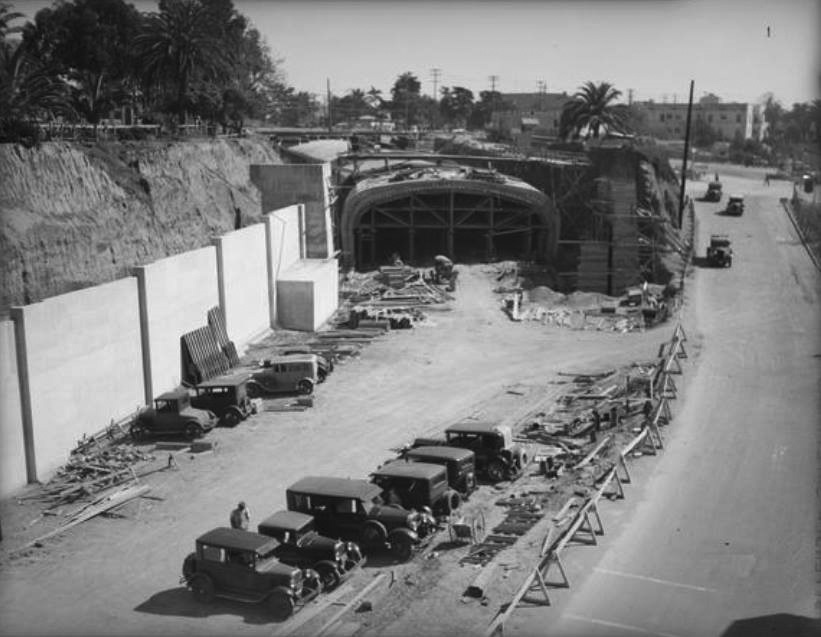 |
|
| (1934)^x^ – View showing the construction of the Olympic Tunnel (renamed the McClure Tunnel in 1969). |
Historical Notes The new tunnel connected Roosevelt Highway with Olympic Boulevard, which leads into Lincoln Boulevard. The tunnel was formerly used, before its reconstruction into a much larger capacity road, by Pacific Electric Streetcar system. |
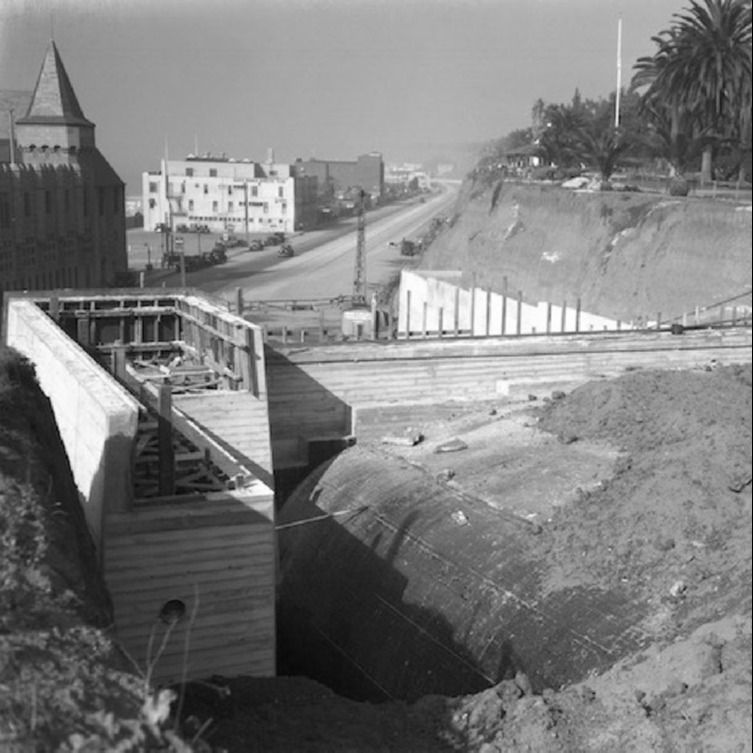 |
|
| (1935)* - Construction of the Roosevelt Highway Tunnel (Olympic Tunnel) under Ocean Avenue. One of the towers of the Deauville Club can be seen on the left. Photo date: December 2, 1935 |
Historical Notes Later named McClure Tunnel after Robert McClure who was a proponent of the Santa Monica Freeway, a member of the state highway commission and known locally as editor and publisher of the Santa Monica Evening Outlook. Roosevelt Highway of course, became known as Pacific Coast Highway. |
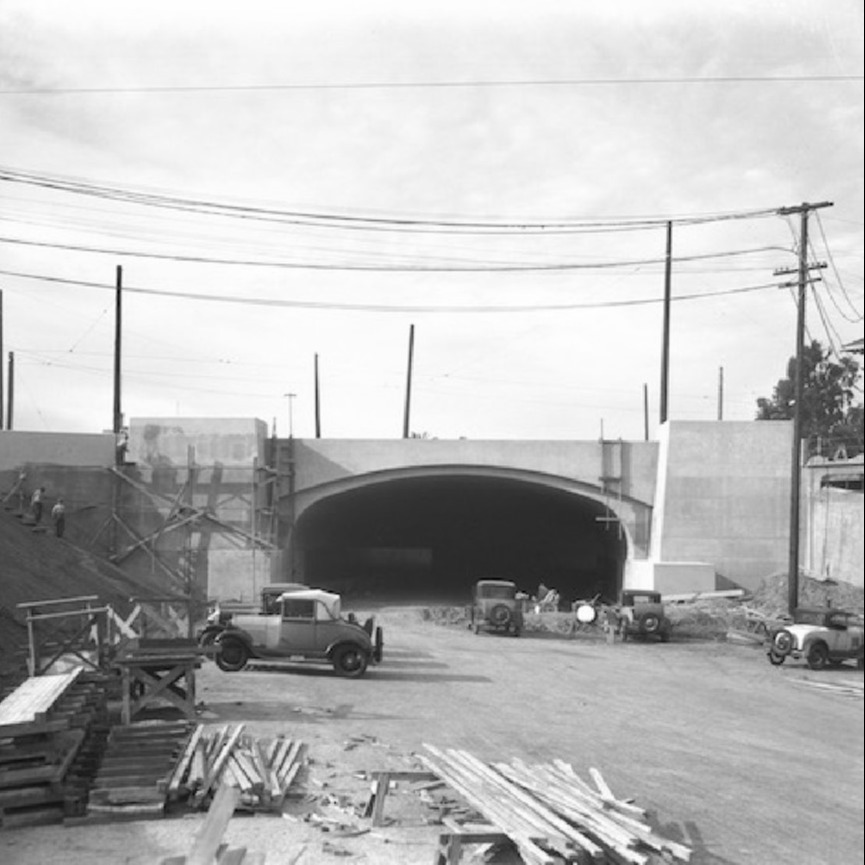 |
|
| (1935)* - Construction of the Roosevelt Highway Tunnel under Ocean Avenue on December 2, 1935. |
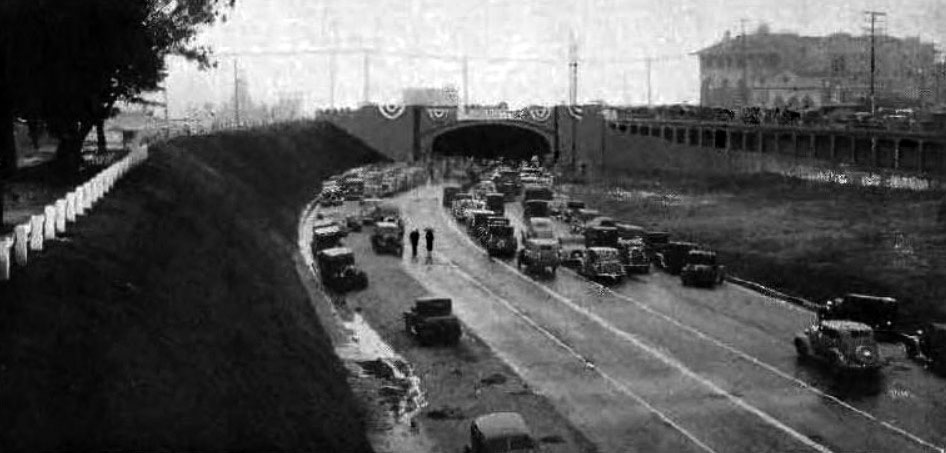 |
|
| (1936)#** – Ceremonies marking the opening of a 400-foot tunnel beneath Colorado and Ocean Avenues in Santa Monica on February 1, 1936. The tunnel, originally known as the Olympic Tunnel and later renamed McClure Tunnel, joins the Roosevelt Highway (later, Pacific Coast Highway) with Olympic and Lincoln boulevards. |
Historical Notes Photo caption reads: "Through tunnel to coast at Santa Monica went a cavalcade of autos when the ribbon was cut February 1st. Flat arch construction and four traffic lanes are features." "Plans for an elaborate dedicatory ceremony which included a parade and barbecue in the tunnel were called off shortly before the exercises were to commence because of the unfavorable weather conditions." #** |
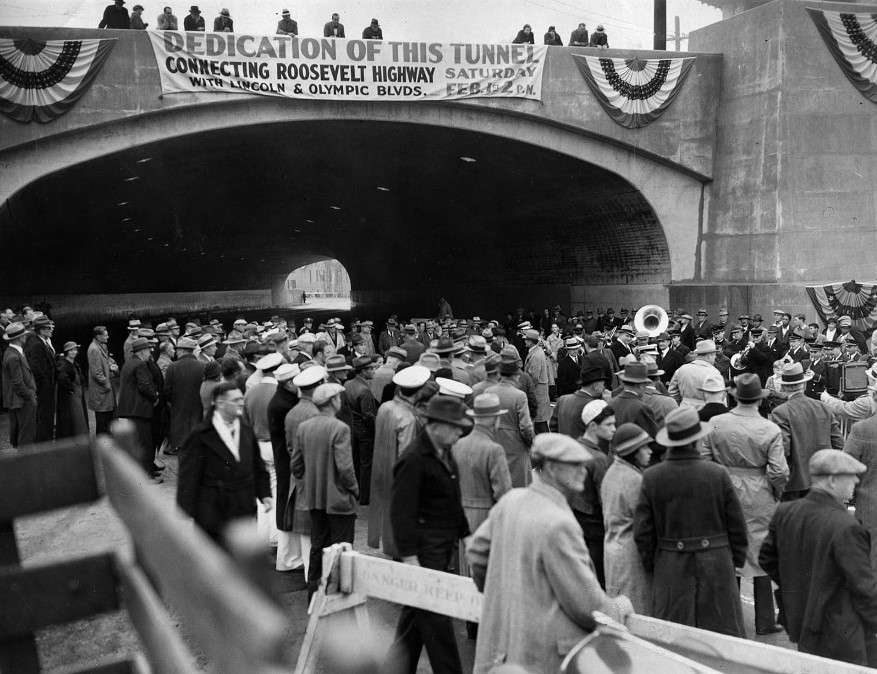 |
|
| (1936)^#^ – View showing hundreds of people at dedication of the new Santa Monica tunnel linking Roosevelt Highway with Olympic and Lincoln boulevards (Feb. 1, 1936). |
Historical Notes The tunnel became known as the Olympic Tunnel. In 1969, it was renamed the Robert E. McClure Tunnel – honoring the former editor of the Santa Monica Outlook. Today the tunnel connects the Santa Monica Freeway and Pacific Coast Highway.^#^ Actor Doug McClure was part of the family whose name is on this famous tunnel that leads to the sea. |
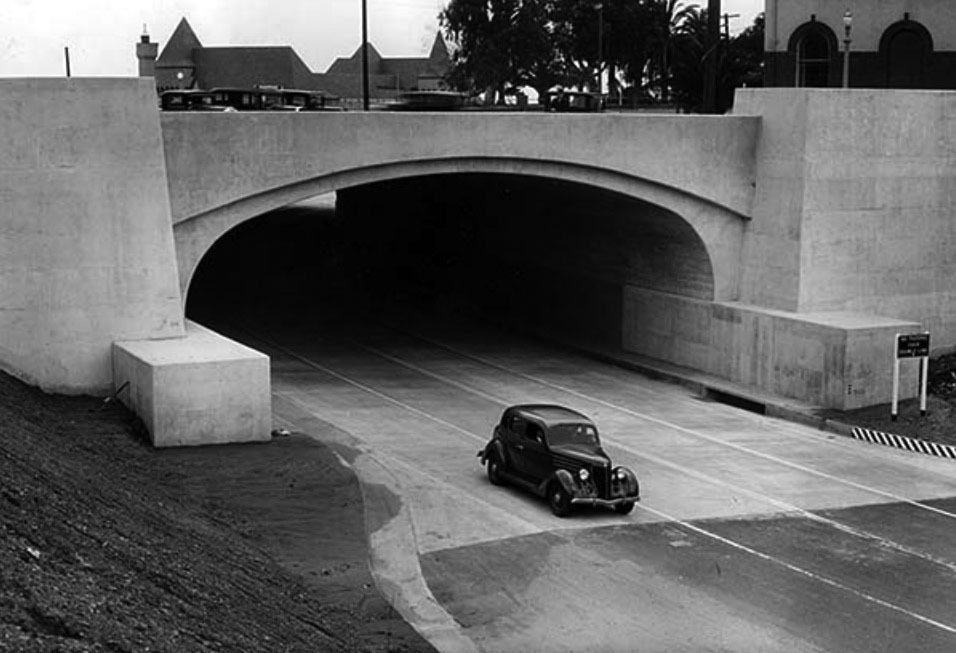 |
|
| (1936)^#^ – View showing a new Ford V-8 Fordor sedan as it exits the new tunnel in Santa Monica onto Olympic Boulevard, which leads to Lincoln Boulevard. The tunnel connected those streets with the Roosevelt Highway. The above photo was published in the Feb. 23, 1936 Los Angeles Times automotive page. |
Historical Notes The roof line of the Deauville Club located on Santa Monica Beach can be seen in the background. |
 |
|
| (1936)^ – Night view looking west toward the entrance to the new McClure Tunnel from the Olympic Boulevard side. Photo Date: May 22, 1936 |
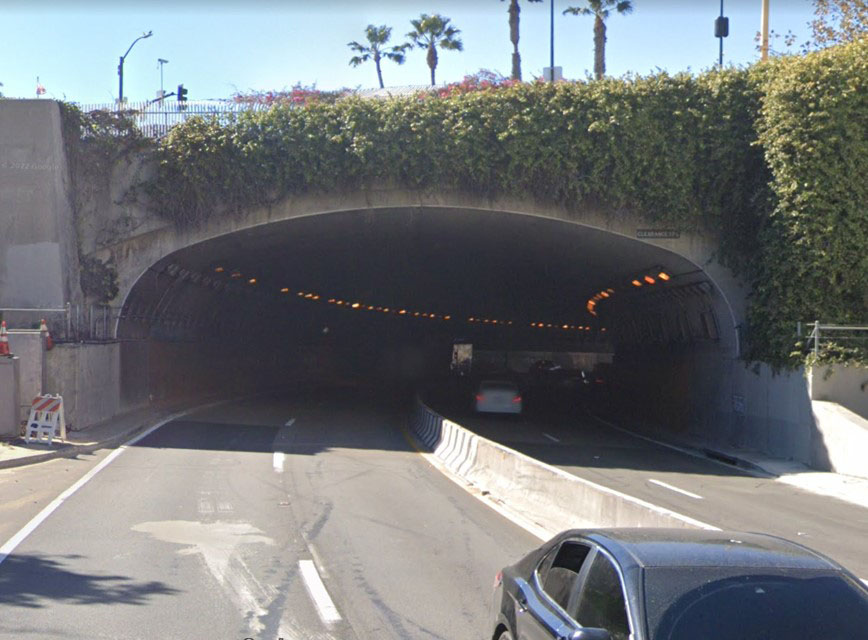 |
|
| (2022)* - Contemporary view of the eastern portal of the McClure Tunnel. |
* * * * * |
Route 66
.jpg) |
(1936)^**^ - Postcard view of the Santa Monica Pier and Beach looking from Palisades Park. Route 66, End of the Trail sign at lower right.
|
Historical Notes In 1936, Route 66 was extended from downtown Los Angeles to Santa Monica, today the intersection of Olympic Boulevard and Lincoln Boulevard (a segment of State Route 1). Even though there is a plaque dedicating Route 66 as the Will Rogers Highway placed at the intersection of Ocean Boulevard and Santa Monica Boulevard, the highway never terminated there. Route 66 was unofficially named "The Will Rogers Highway" by the U.S. Highway 66 Association in 1952, although a sign along the road with that name appeared in the John Ford film, The Grapes of Wrath, which was released in 1940, twelve years before the association gave the road that name. A plaque dedicating the highway to Will Rogers is still located in Santa Monica (Ocean and Santa Monica Boulevards).*^ |
* * * * * |
Palisades Park
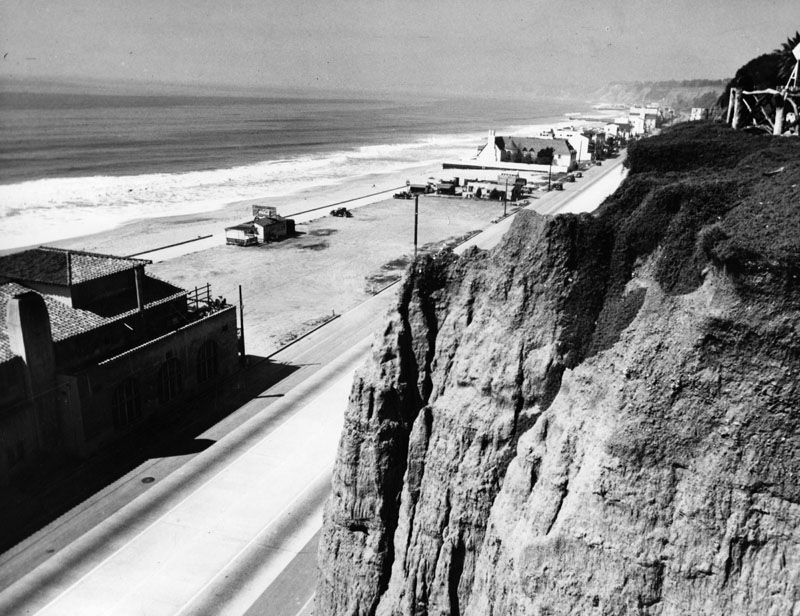 |
|
| (1937)* - Corner view of Palisades Park (right), shows the 297 foot drop-off onto the palisades. Parts of the Roosevelt Highway can be seen and the Santa Monica beach is in the background. |
Statue of Santa Monica
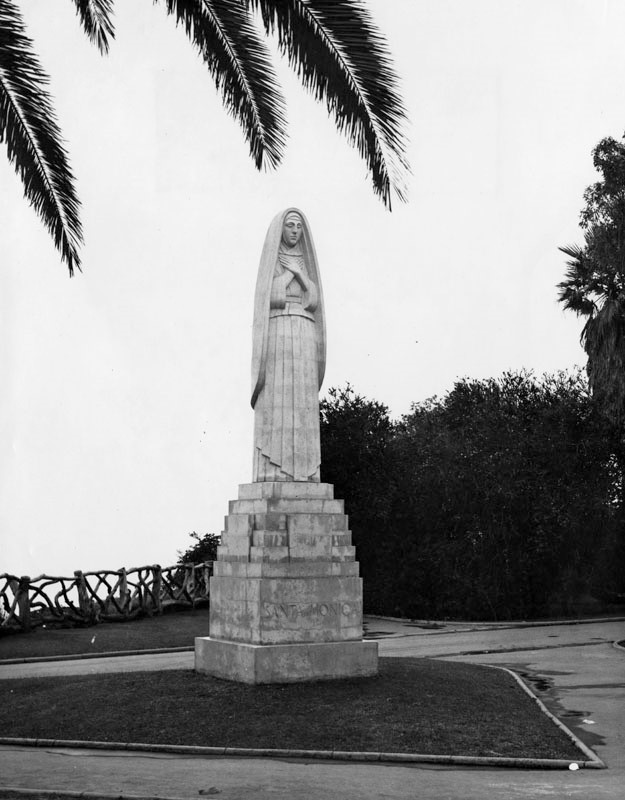 |
|
| (1937)* - View of the statue St. Monica for whom the city is named. The statue is located in Palisades Park in Santa Monica. Eugene Morahan is the sculptor. |
Historical Notes The 18-ft. high Art Deco Sculpture for whom Santa Monica was named was sculpted in 1934 by Eugene Morahan as a Public Works of Art project and presented to the citizens of Santa Monica by the Federal Government. Morahan and his wife (Grace) lived at the Tennis Club on Third Street in Santa Monica where the statue was caste in the backyard. It was to be installed during the celebration of Pioneer Day and as Morahan was under great pressure to complete his work by that deadline, he contacted his good friend and fellow sculptor, Gutzon Borglum to leave his work on Mount Rushmore and come down to help him finish his work on Saint Monica.+# |
.jpg) |
|
| (2007)*^ - Close-up view of the statue of Santa Monica by Eugene Morahan. Photo by Sharon Mollerus / Wikipedia |
Historical Notes The statue is located at the foot of Wilshire Boulevard just a block or so north of Santa Monica Boulevard. |
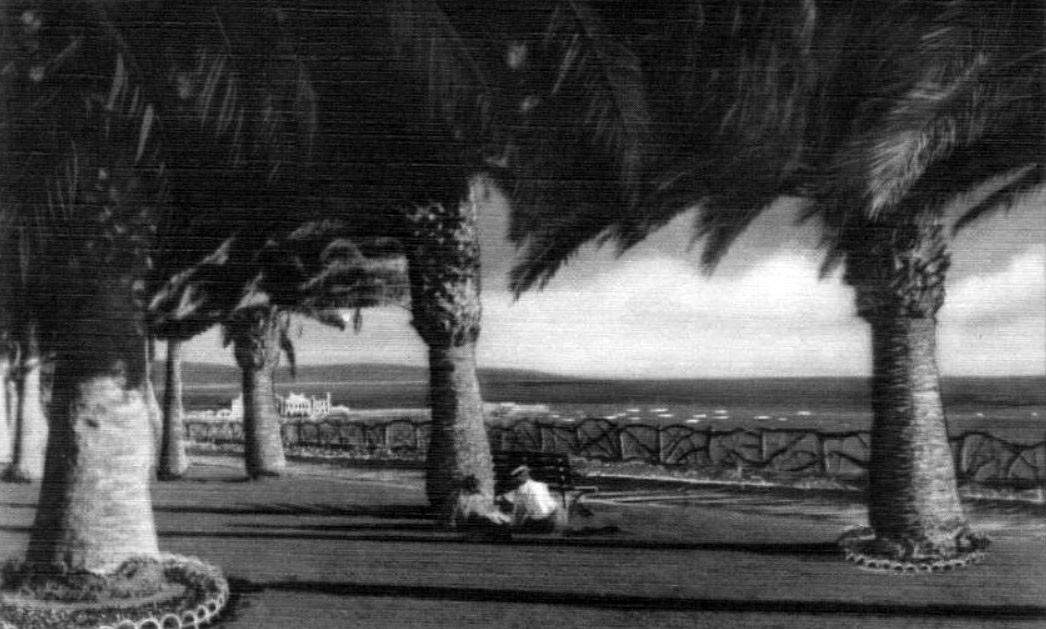 |
|
| (ca. 1940)#^# – Postcard view showing a couple enjoying a leisurely day in the shade of a palm tree at Palisades Park, Santa Monica. |
* * * * * |
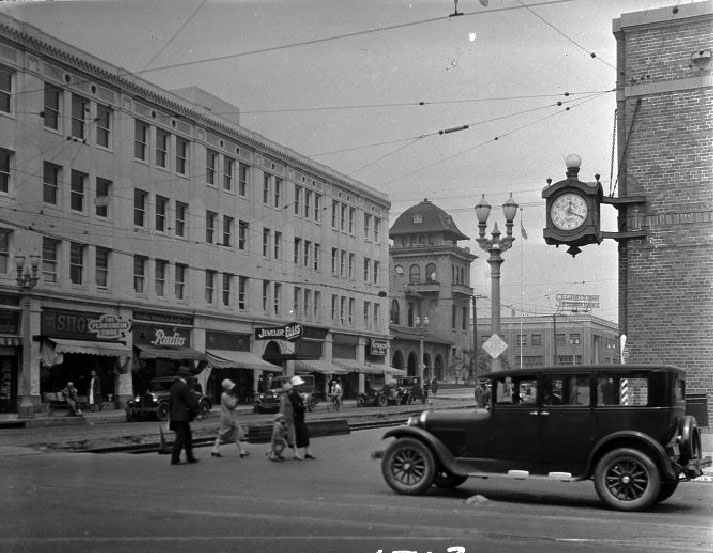 |
|
| (1928)^*^* - View of intersection of Santa Monica Blvd. and Third Street facing northeast, with pedestrians crossing street, vehicles in foreground and background, businesses, and Santa Monica City Hall. Legible business signs include: The Florsheim Shoe, Santa Monica Radio Co., Jeweler Ellis, Security Trust & Savings Bank. A clock on the right reads 12:20. |
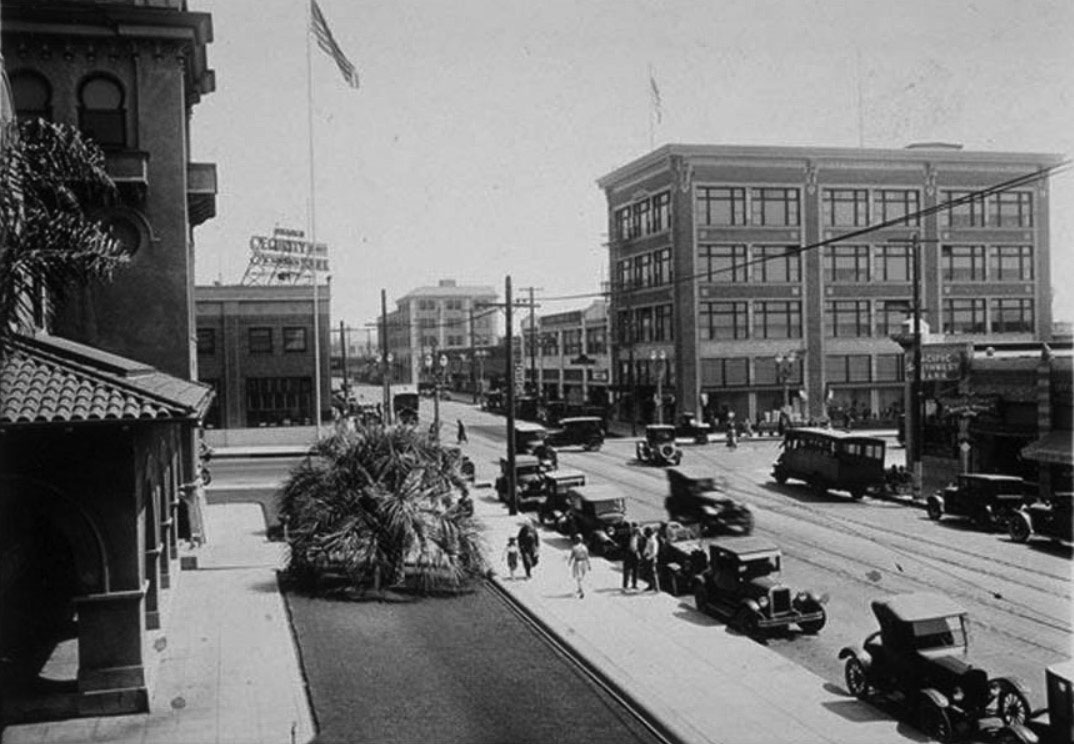 |
|
| (ca. 1926)#^ – View showing the intersection of Fourth Street and Santa Monica Boulevard with Santa Monica City Hall on the northwest corner, Security Trust and Savings Bank on the northeast corner, the Henshey-Tegner Building on the southeast corner, and Pacific Southwest Bank on the southwest corner. |
Historical Notes In the 1920s, Santa Monica was thriving both as a popular tourist destination and as home to a budding aviation industry and other businesses. Though Santa Monicans had long trekked to downtown Los Angeles for important shopping, Santa Monica’s downtown was at last coming into its own as a full-service retail center. Henshey’s Department Store, founded by Harry C. Henshey and his partners, was crucial to this change. *##^ |
Henshey's Department Store
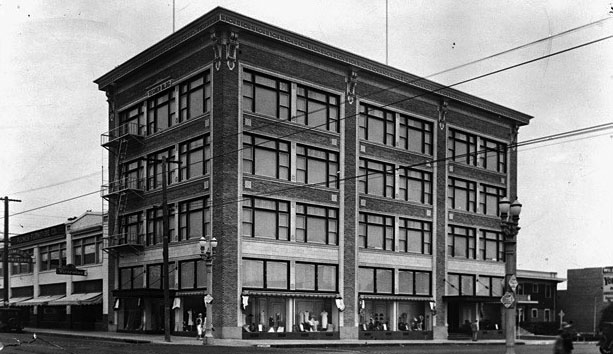 |
|
| (ca. 1925)*##^ - View looking at the southeast corner of Santa Monica Boulevard and Fourth Street showing the Henshey’s Department Store shortly after it was constructed. |
Historical Notes Henshey’s was Santa Monica’s first department store and, at four stories, one of the city’s tallest commercial buildings. The building itself was owned by Charles Tegner, one of Henshey’s partners. Tegner built many commercial structures in Santa Monica and was a key figure in the city’s business community at the time. The architect selected for the building was also well-known locally—Henry C. Hollwedel. Hollwedel began his career as an architect in New York but relocated here and completed many important commissions in Santa Monica, including the Santa Monica Bay Woman’s Club and the Mayfair Theatre. The Henshey’s store, as originally designed by Hollwedel, was a steel frame and brick structure in the Beaux Arts Classical Revival style, a grandiose style often used in public buildings of the time. The original store featured bays of paired windows embellished with terra cotta details, as well as an imposing cornice and a terra cotta frieze. Santa Monica’s Outlook newspaper reported at the time that Henshey’s was “one of the best advertisements Santa Monica has ever had…its imposing bulk, towering over the adjacent structures around it arouses interest and speculation.” Even more important, Henshey’s showed that “Santa Monica is no longer a village with village stores and standards. She has grown up and is now a big city.” *##^ |
* * * * * |
Central Tower Building
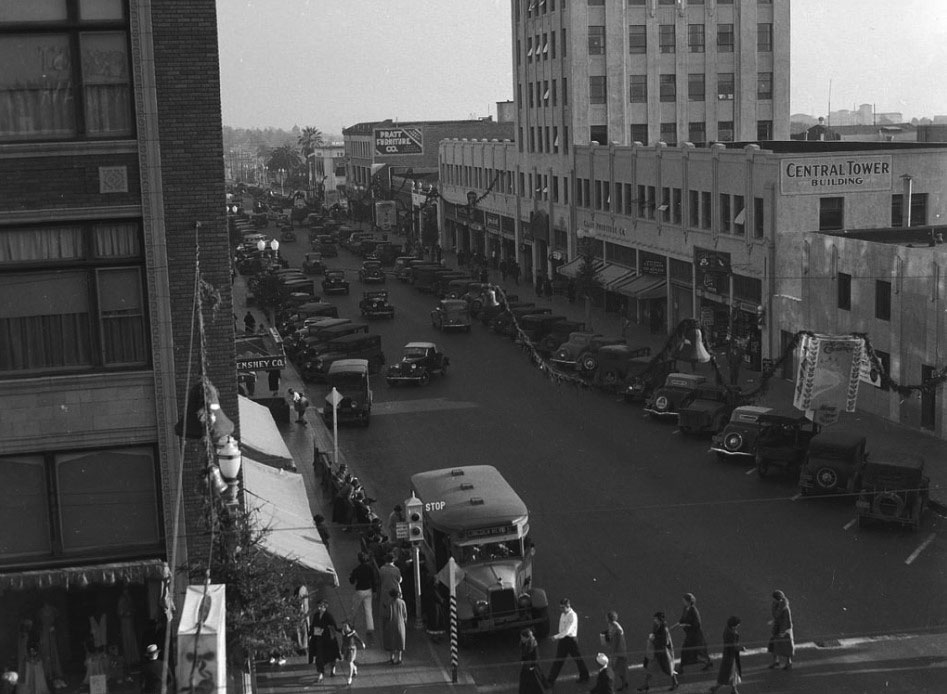 |
|
| (1928)^*^* – View looking south on 4th Street from Santa Monica Boulevard. The Central Tower Building is at upper right. |
Historical Notes Constructed in 1928, the symmetrical Central Tower Building is designed in the Art Deco style. The irregular-shaped building is comprised of two-story store fronts along the west side of 4th Street with an eight-story central tower rising from the middle of the 4th Street facing volume.**# |
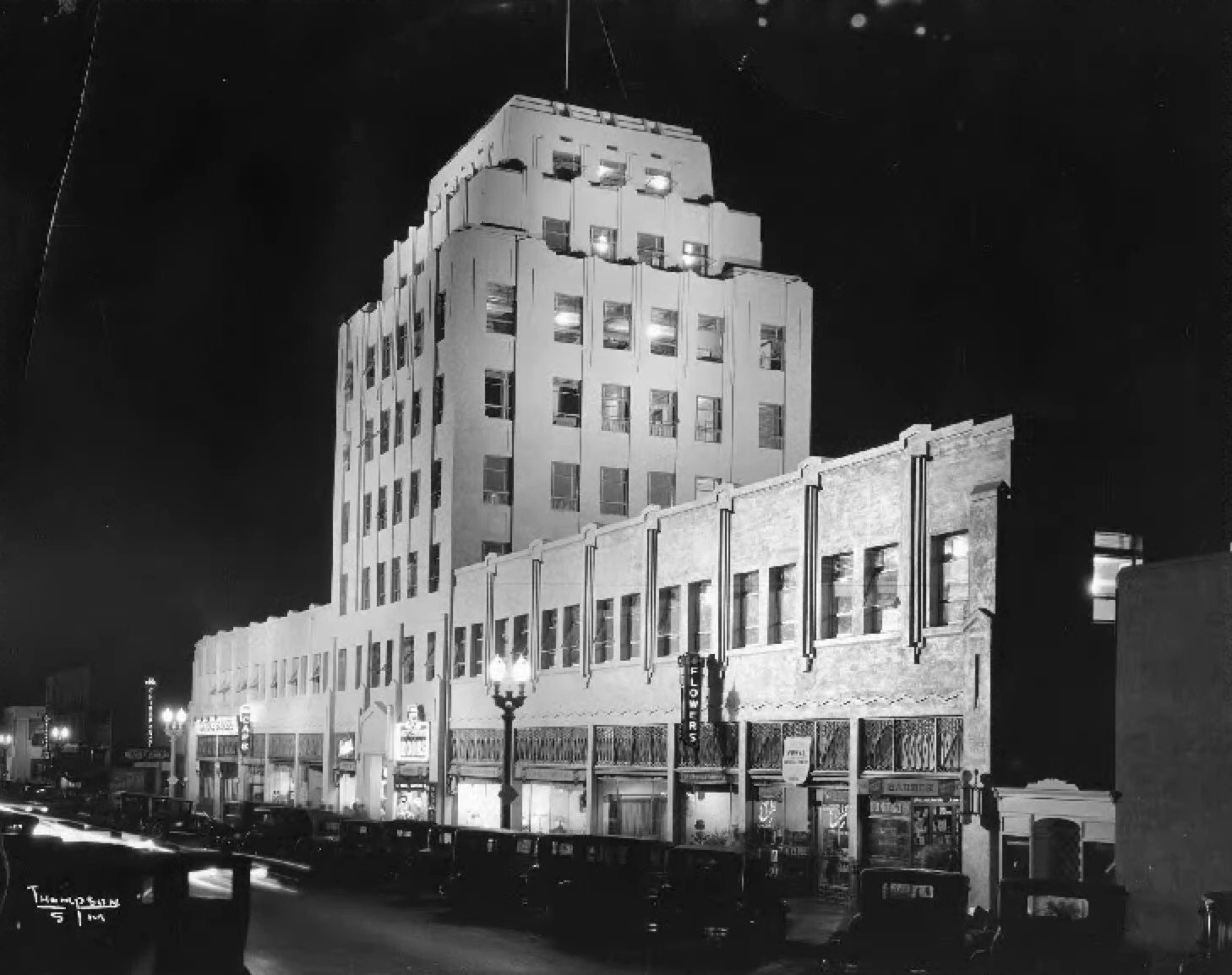 |
|
| (1928)* - Night view showing the newly construct Central Tower Building, 1424 Fourth Street. |
Historical Notes The beautiful Art-Deco style eight story commercial building was designed by Morien Eugene Durfee who was also the architect for the Georgian Hotel on Ocean Avenue. It was constructed by C.L. Freeman and J. Wesley Forder and developed by the Central Tower Investment Company and A.P. Creel. |
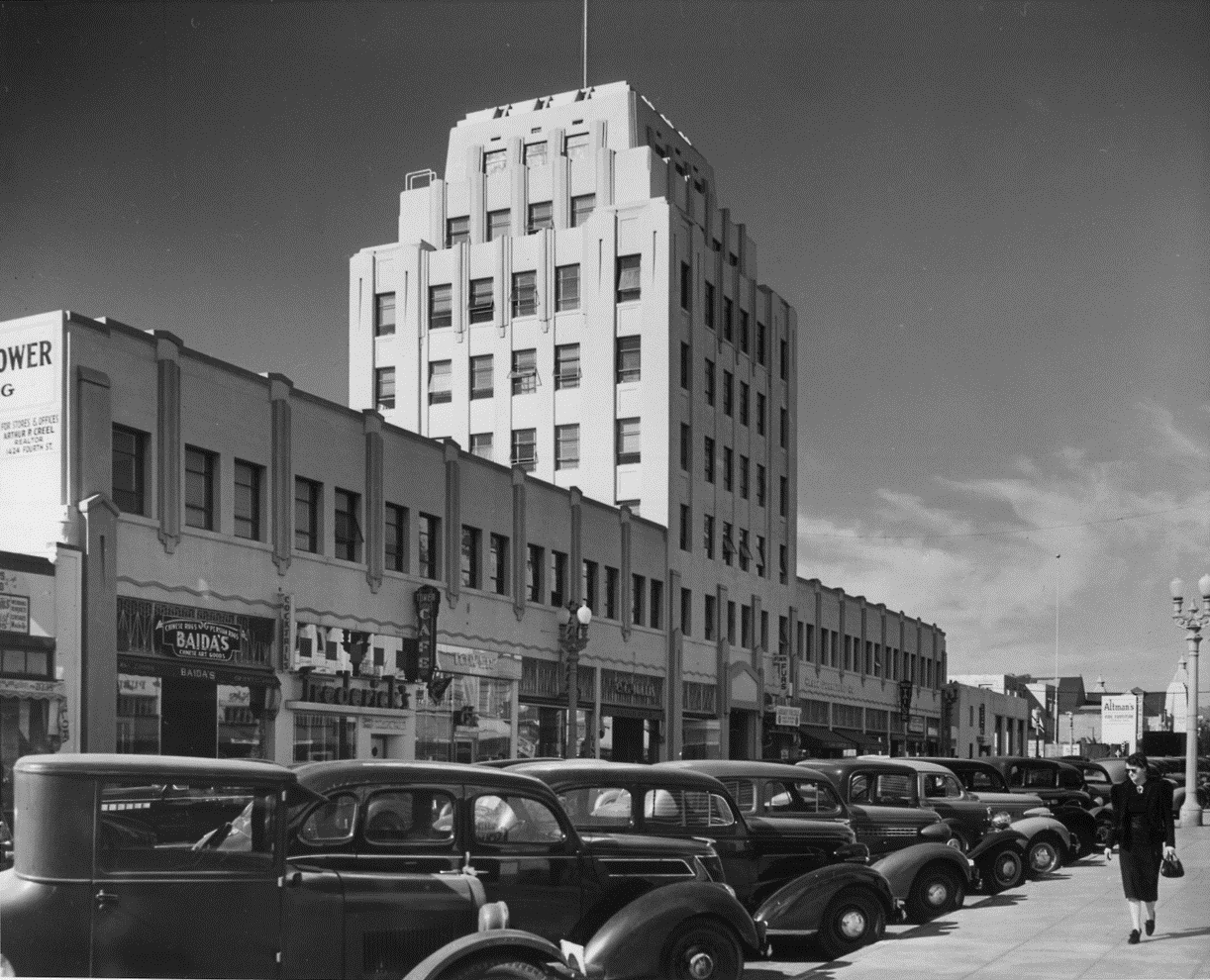 |
|
| (1930s)*^# - A woman walks by parked cars lining the street in front of the Central Tower Building in Santa Monica. The Art-Deco Central Tower Building was the beachfront city’s first skyscraper. |
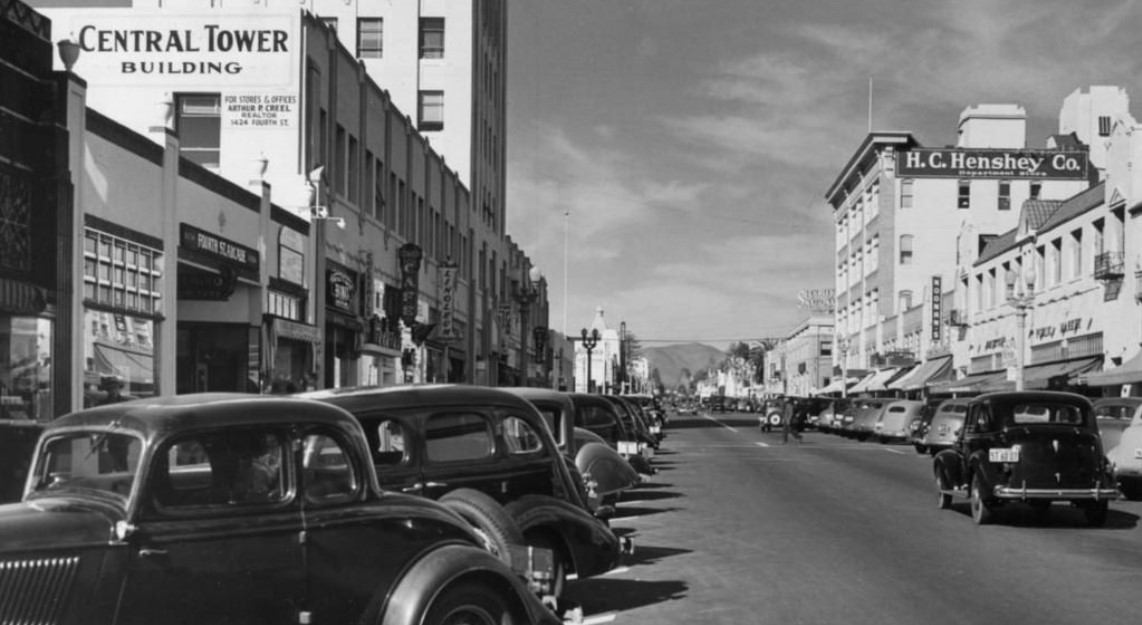 |
|
| (ca. 1939)#*#* – View looking north on 4th Street toward Santa Monica Blvd. with the Central Tower Building on the left and Henshey’s Department Store on the right. |
Historical Notes Although Henshey’s was praised when first constructed in 1925, the building was altered significantly as the years passed and architectural fashions changed. In 1936 it underwent a major remodel as the ground floor and mezzanine were remade in the Streamline Moderne style so popular in the 30s. At the same time, a one-story extension (also Streamline Moderne) was annexed to the building along Fourth Street. By the 1960s this look too was outdated, and in 1962 both the original four-story building and the annex were entirely encased behind punched aluminum screens, changing their look dramatically. Henshey’s Department Store occupied these buildings from 1925 until 1992 when recession and competition from other retailers led to the store’s closing. Then, in the 1994 Northridge earthquake, the Henshey’s building and annex were damaged beyond repair and the landmark was demolished soon after. *##^ |
* * * * * |
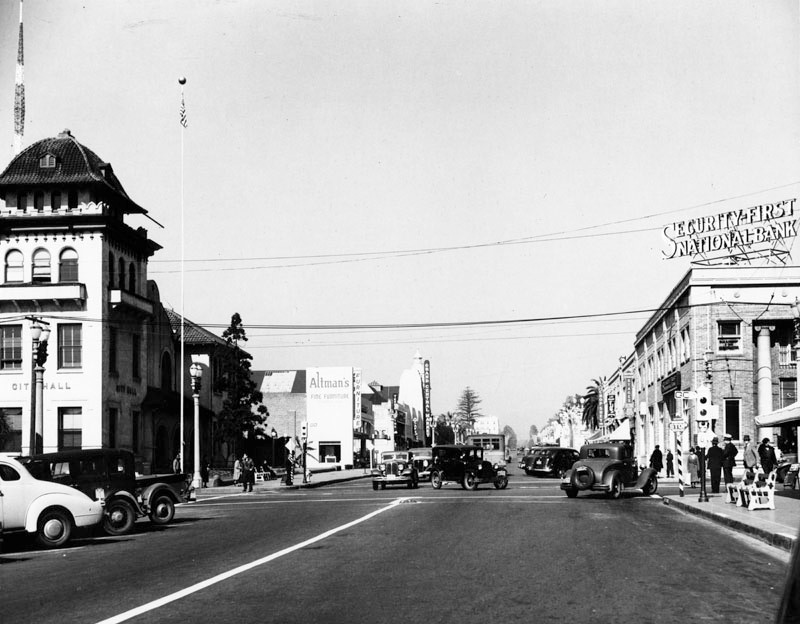 |
|
| (1938)* - View of Santa Monica Boulevard and 4th Street looking north. The City Hall, Altman's Fine Furniture store and a Grand Central Market is on the left. Security First National Bank, Stages Motor Coach and a Chop Suey restaurant can be seen on the right. |
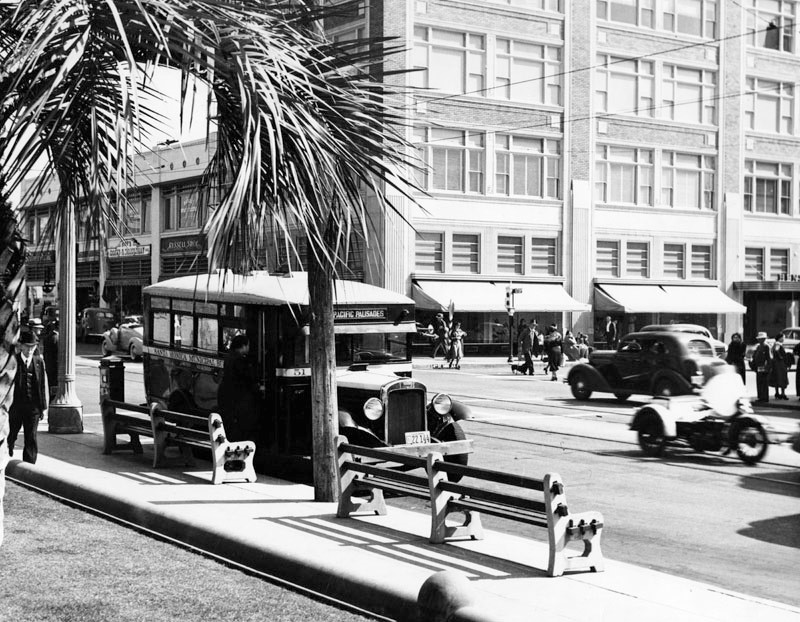 |
|
| (1938)* - General view of the main business intersection looking east from City Hall at Fourth Street and Santa Monica Boulevard. Hensley's Department Store can be seen in the background, and a bus is in the foreground. |
 |
|
| (1938)* - People getting off the bus in Santa Monica. It is one of the Bay Cities Transit Co. buses, which are used as a means of local transportation in Santa Monica. Across the street is a branch of Security-First National Bank. |
* * * * * |
Wilshire Theatre (later NuWilshire Theatre)
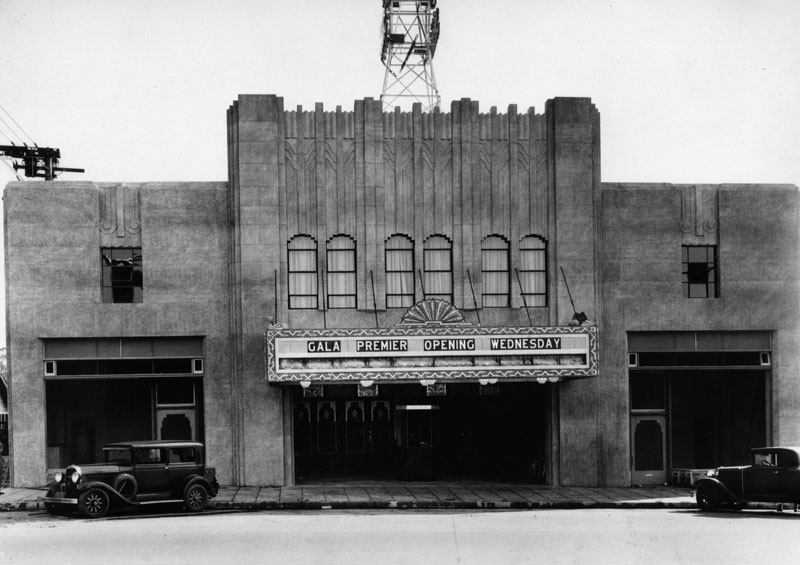 |
|
| (1931)* - Exterior view of the Wilshire Theatre (later NuWilshire Theatre), located at 1314 Wilshire Boulevard in Santa Monica. Marquee reads "Gala premier opening Wednesday." |
Historical Notes John M. Cooper designed this movie theater, which includes both Neoclassical and Art Deco architectural elements. When it opened in 1931 for stage and film productions, the theater had seating for 1,500 all in one auditorium, however two auditoriums were created in 1977 under the ownership of Mann Theatres. In the early 1990’s, Landmark Theatres took over operations and changed its name to NuWilshire. |
* * * * * |
El Miro Theatre
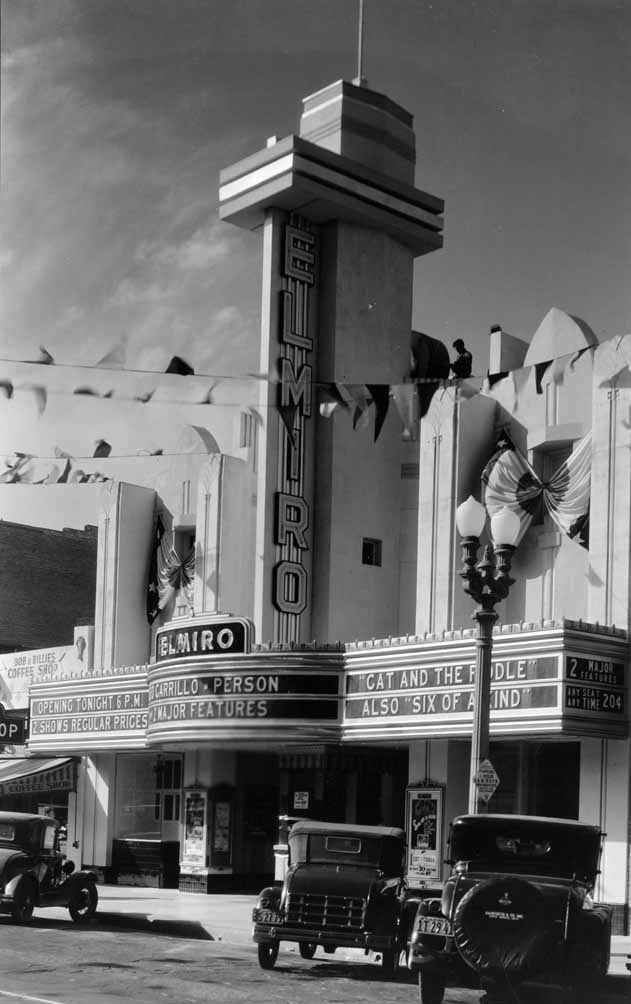 |
|
| (1938)^^^- View of the newly opened El Miro Theatre decorated with banners. A man on the roof appears to be installing additional banners. Bob and Millie's Coffee Shop is seen on the left. Sign reads: 2 Major Features - ANY SEAT - ANY TIME - 20 CENTS |
Historical Notes Opened in 1938, the only part of the old El Miro Theatre that is left is the facade. The theater was razed in the late 80’s and the newer Cineplex Broadway 4 Theatre is located on that site now.*** |
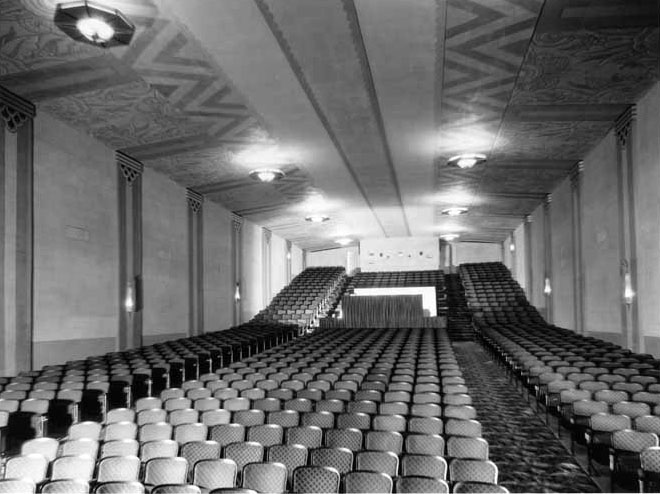 |
|
| (1938)^^^ - Interior view of the El Miro Theatre showing the Art Deco design on walls and ceiling. |
Historical Notes The El Miro Theatre was designed by Norman W. Alpaugh. |
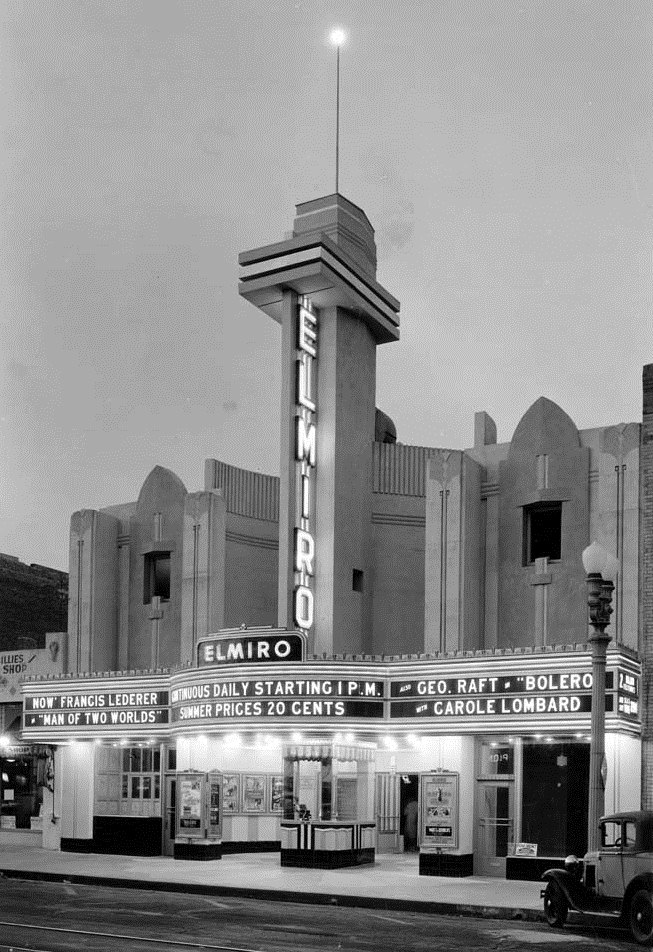 |
|
| (1938)^^^ - The Streamline Moderne El Miro Theatre located at 1441 Third Street in Santa Monica. |
Historical Notes From the 60’s thru the 80’s, the El Miro Theatre was part of many chains including Century, Loew’s, GCC, and Metropolitan Theatres (Metropolitan being the last). Loew’s redressed the house in the early 70’s with those purple and blue curtains of that era. That was the last time this theater received a makeover before it was closed and demolished.*** |
* * * * * |
Clock Tower Building (aka Bay Cities Guaranty Building and Crocker Bank Building)
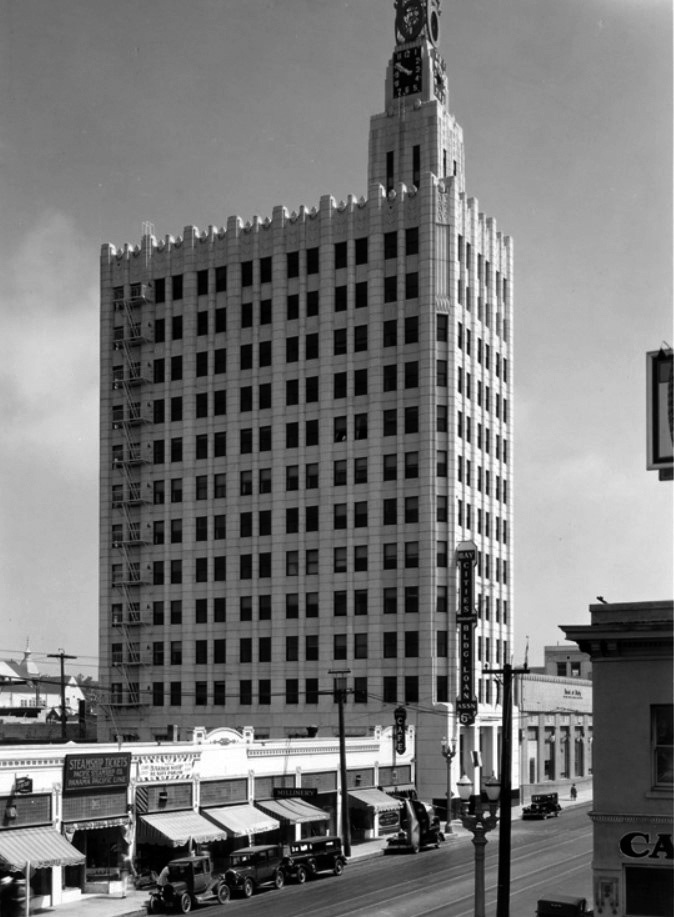 |
|
| (ca. 1930)* - Elevated view of the twelve story Clock Tower Building, located at 225 Santa Monica Boulevard. Various businesses and storefronts in foreground including: Bank of Italy, Harney Travel Bureau, Elizabeth Haynes Millinery, Los Angeles Times, barber shop, and Rials Cafe. |
Historical Notes The Clock Tower Building was built between 1929 and 1930 in Art Déco style. For around 40 years it held the record for the tallest building in the Santa Monica skyline. The skyscraper was commissioned by the Bay Cities Guaranty and Loan Association to the Californian architects Albert Raymond Walker and Percy Augustin Eisen, whose firm, Walker & Eisen, with a staff of more than 50 draughtsmen, was the most important leading practice in California in the 1920s. Among its many completed projects, the firm had recently designed the extraordinary skyscraper in the Romanesque Revival style known as the Fine Arts Building in Los Angeles (now owned by Sorgente Group of America), one of the most representative buildings in the city.^ |
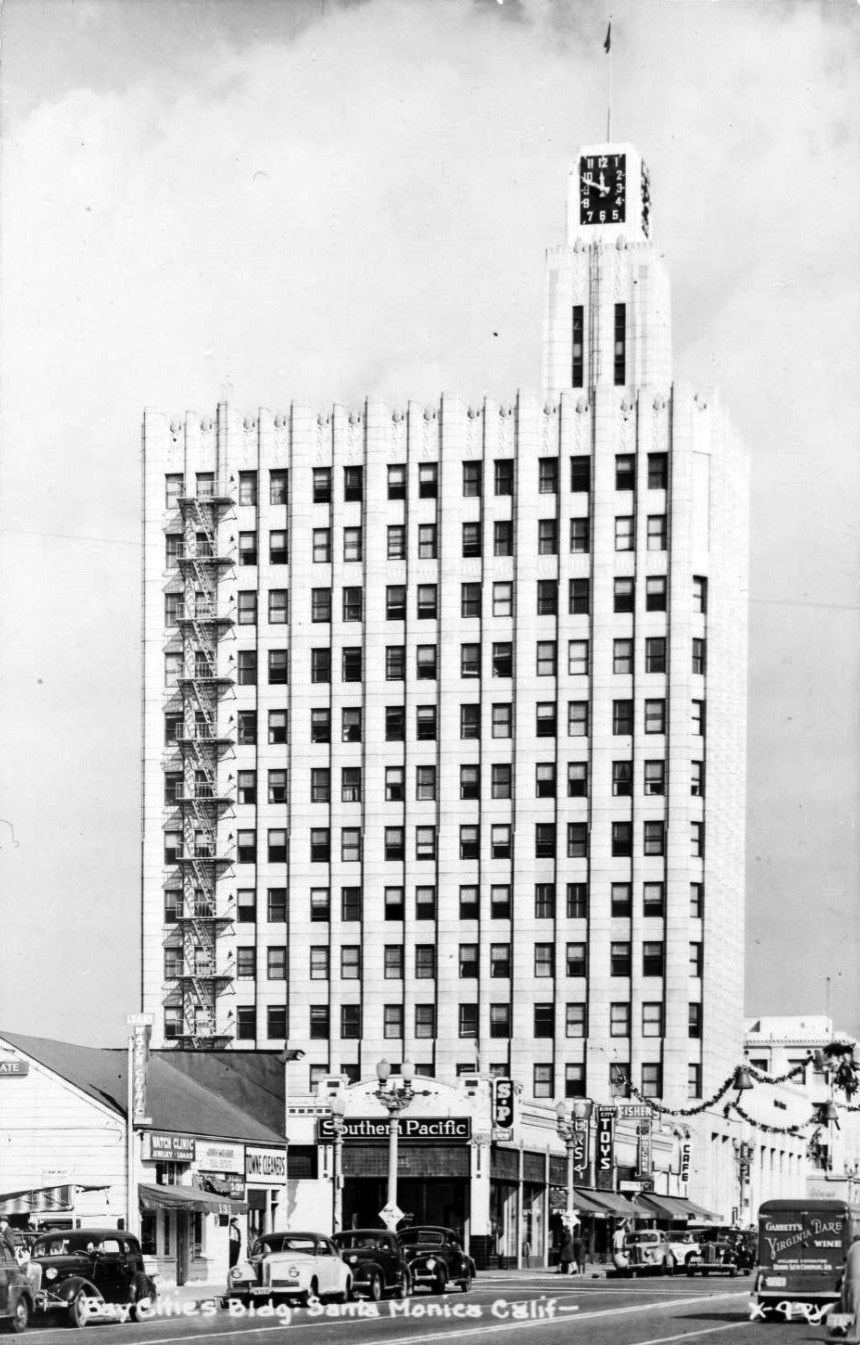 |
|
| (ca. 1940)^^ - Image of the Bay Cities Guaranty Building, also known as the Clock Tower Building or Crocker Bank Building, located at 225 Santa Monica Boulevard in Santa Monica. Signs around the building read "Southern Pacific," "Toys," "Towne Cleaners," "Watch Clinic," and "Garretts Virginia Dare Wine" printed on a van across the street from the building. |
Historical Notes The Clock Tower Building, not far from the beaches washed by the ocean and with an unobstructed view of the nearby mountains, occupies a rectangular lot located at 225 Santa Monica Boulevard, in the heart of the city’s business district and close to the main thoroughfare Third Street Promenade. The ground floor of the skyscraper, in the form of a compact parallelepipedal block surmounted by a tower, is occupied by retail spaces, and the upper stories by offices.^ |
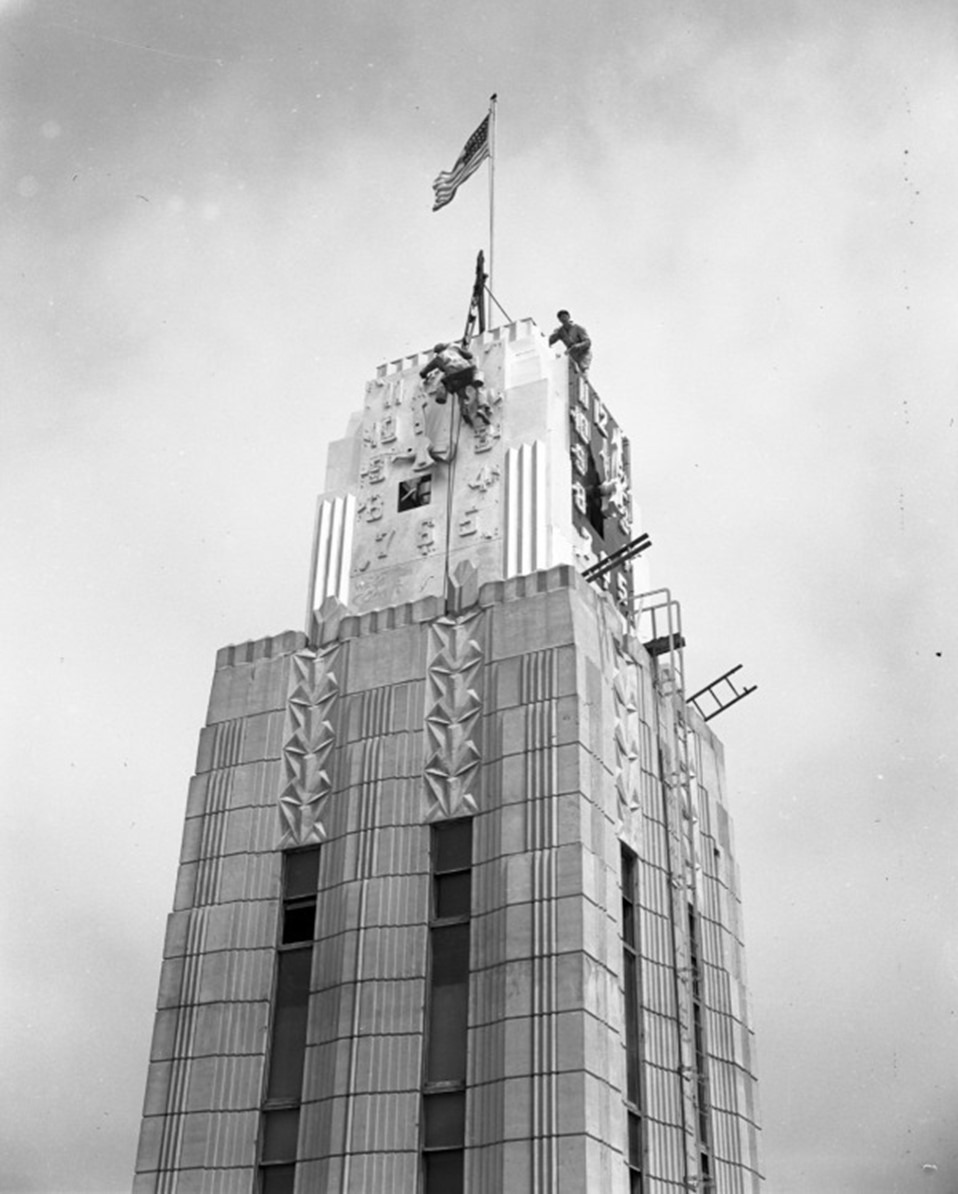 |
|
| (1945)* - Painting the top of the Bay Cities Guaranty Building clock tower. Santa Monica History Mueseum |
Historical Notes Constructed in 1929 it was the first high-rise in Santa Monica. It was designed by Albert Walker and Percy Eisen in the Art Deco style. Walker and Eisen were responsible for numerous notable structures in Los Angeles, such as the home of the former United Artists Theatre in downtown Los Angeles now the Ace Hotel, the Beverly Wilshire hotel in Beverly Hills.* |
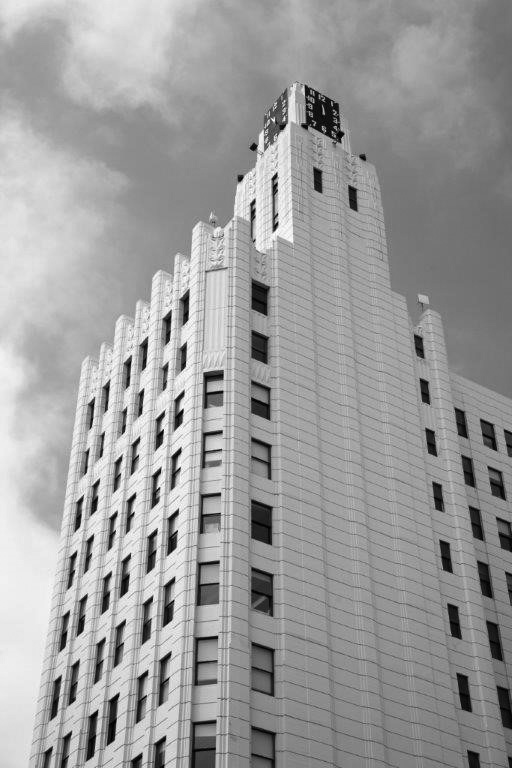 |
|
| (2001)* – Closer view of the Art Deco eight story apartment hotel designed by architect M. Eugene Durfee. Wikipedia Commons |
Historical Notes The twelve office floors are crowned by a crenellated border, where the most ornate decorations on the cladding are concentrated. The tapered, stepped tower on the top is also faced with white marble slabs, which form a zigzag pattern in relief on the sides and around the edge of the summit; it is visible from everywhere in the city and rendered instantly recognizable due to its rectangular clock with four black dials (one on each side of the tower), and whose shining hands mark the exact time and are an urban signal in the city.^ |
.jpg) |
|
| (2014)*^ – Close-up detail view of both clock and tower of the Clock Tower Building, 225 Santa Monica Blvd. Sorgente Group / Wikipedia |
Historical Notes Due to its height, its imposing volumes and the immediate recognizability of its architecture, the Clock Tower Building has possessed a powerful urban identity since it was built. This makes it a true landmark that acts as a compass and guide in the boundless Santa Monica cityscape.^ |
* * * * * |
Georgian Hotel
 |
|
| (2001)* – View looking up at the front of the Georgian Hotel, 1415 Ocean Avenue, Santa Monica. |
Historical Notes The Georgian Hotel was established in 1931. Built during the peak of California's coastal expansion in the 1920s and 1930s, the historic hotel was the vision of Attorney and Judge, Harry J. Borde. Showcasing Romanesque Revival and Art Deco architecture, the hotel was among the first skyscrapers to call Ocean Avenue home.^ The Art Deco eight story Georgian Hotel was one of the first high rise hotels in Santa Monica. It sits on Ocean Avenue and looks out on the Pacific Ocean. The bar downstairs was frequented by Hollywood luminaries such as Clark Gable and Carole Lombard. The Georgian was also home base for the Kennedy clan with First Mother Rose Kennedy a fixture at the hotel while she entertained Hollywood royalty and journalists.^ |
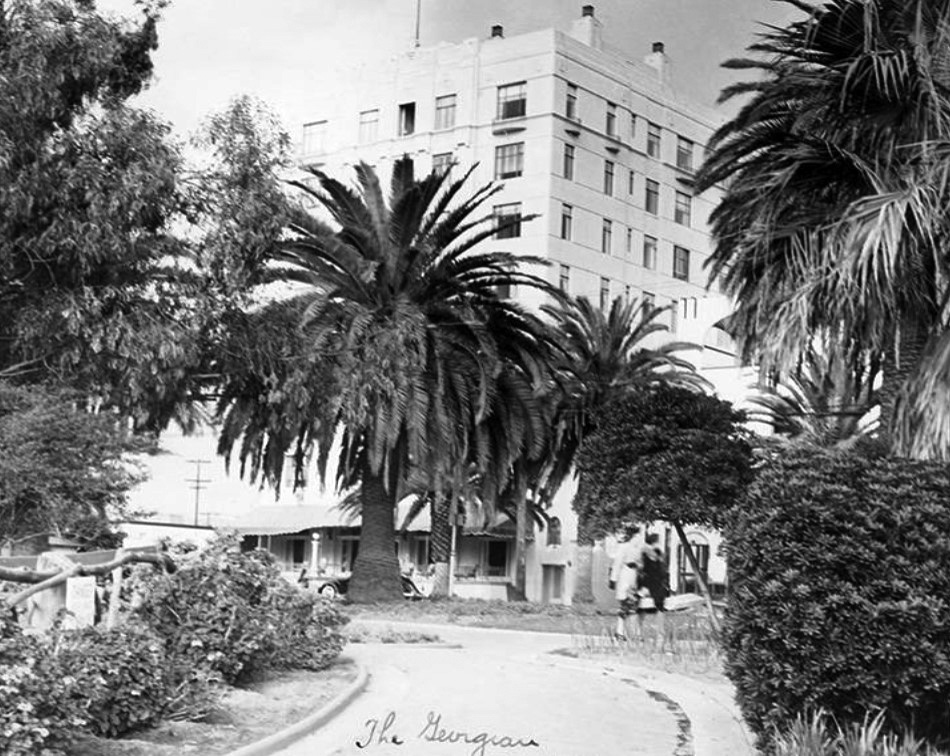 |
|
| (1941)#^ – View showing the rustic driveway leading to what appears to be the rear of the Georgian Hotel located at 1415 Ocean Avenue in Santa Monica. |
Historical Notes In the 1940s and 1950s, Santa Monica was taken by a technological and industrial boom, led by the Donald Douglas Aircraft Factory. Guests of Douglas Aircraft's would call The Georgian their temporary home while in LA. Those taking up residence included aircraft designers, servicemen during WWII, and gamblers who would take a motorboat offshore to spend an evening aboard the casino barges anchored a few miles offshore in Santa Monica Bay. In the late 1960s, The Georgian reinvented itself as a modern upscale apartment residence, with unheard of amenities like a bathroom in every guest room. |
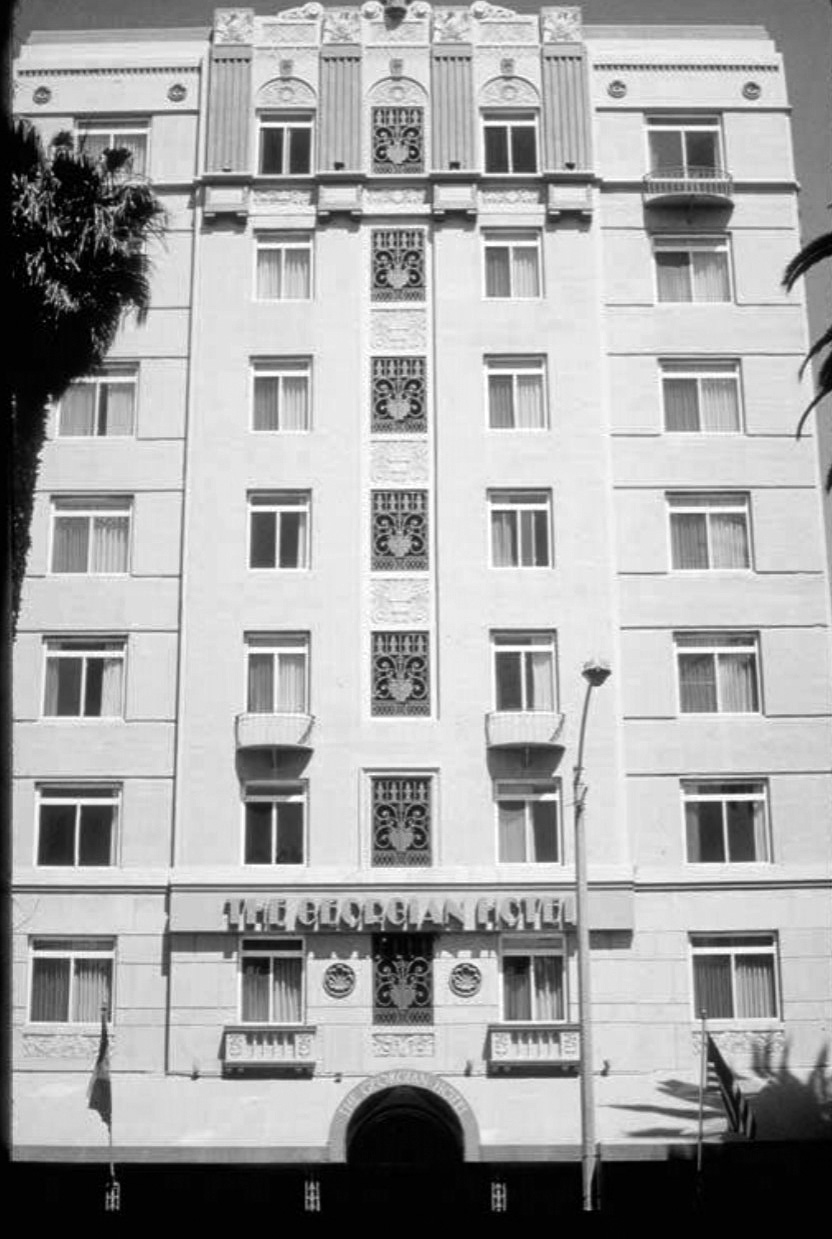 |
|
| (2001)* – Closer view of the Art Deco eight story apartment hotel designed by architect M. Eugene Durfee. |
Historical Notes As Hollywood's elite flocked to the beach to escape the valley heat, The Georgian's popularity grew. It was nicknamed "The Lady" in honor of Mr. Borde's mother, Rosamond Borde, who was a modern woman who had opened a hotel called The Windermere on the adjacent lot. |
.jpg) |
|
| (2001)* - The Georgian Hotel, 1415 Ocean Avenue, Santa Monica, Calif. |
Historical Notes As time passed, the basement restaurant of the Georgian Hotel earned a great deal of attention. One of the last strongholds of the Prohibition Era, it was considered a true Speakeasy, which hosted the likes of "Bugsy" Siegel, Clark Gable, Roscoe "Fatty" Arbuckle, Carole Lombard, and dozens of other film stars and industry moguls. |
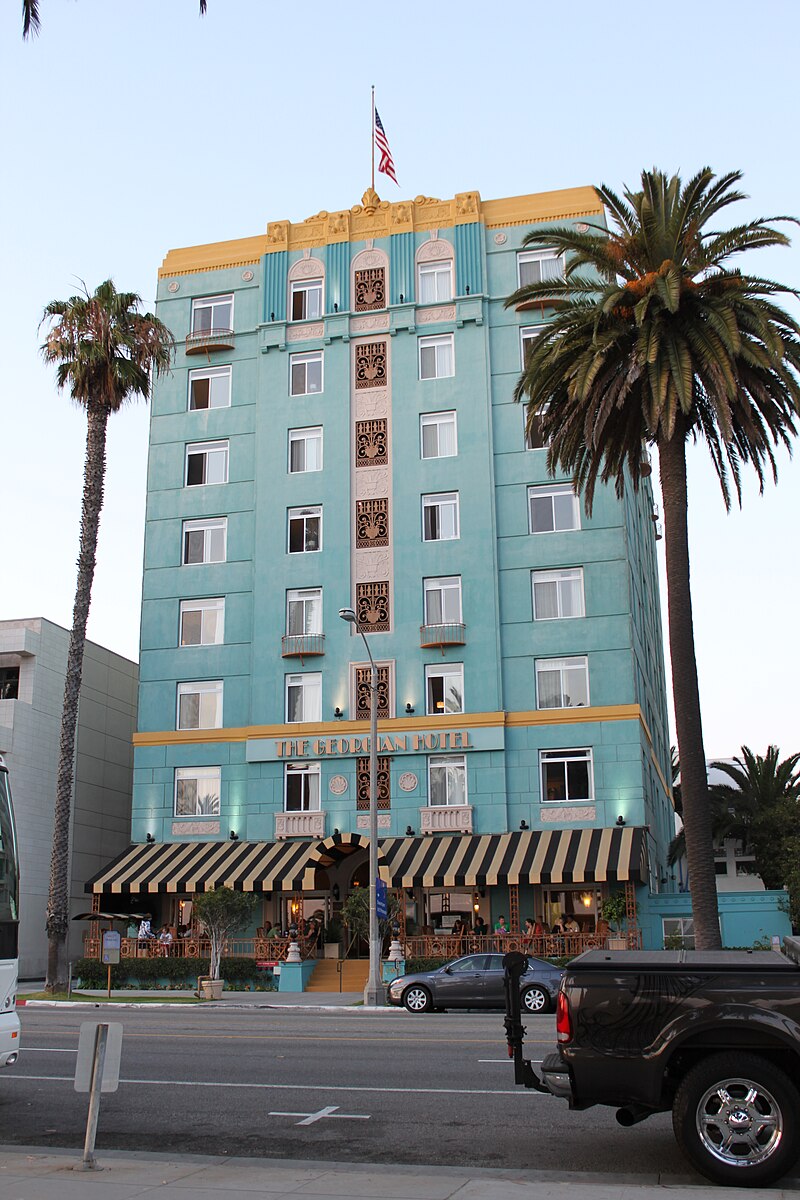 |
|
| (2009)* - Looking up at the beautiful Georgian Hotel, 1415 Ocean Avenue, Santa Monica. Photo by 'Jeson25' / Wikipedia |
Historical Notes The Georgian Hotel was designated a Santa Monica historical landmark on February 22, 1995.* |
* * * * * |
Santa Monica Beach Clubs
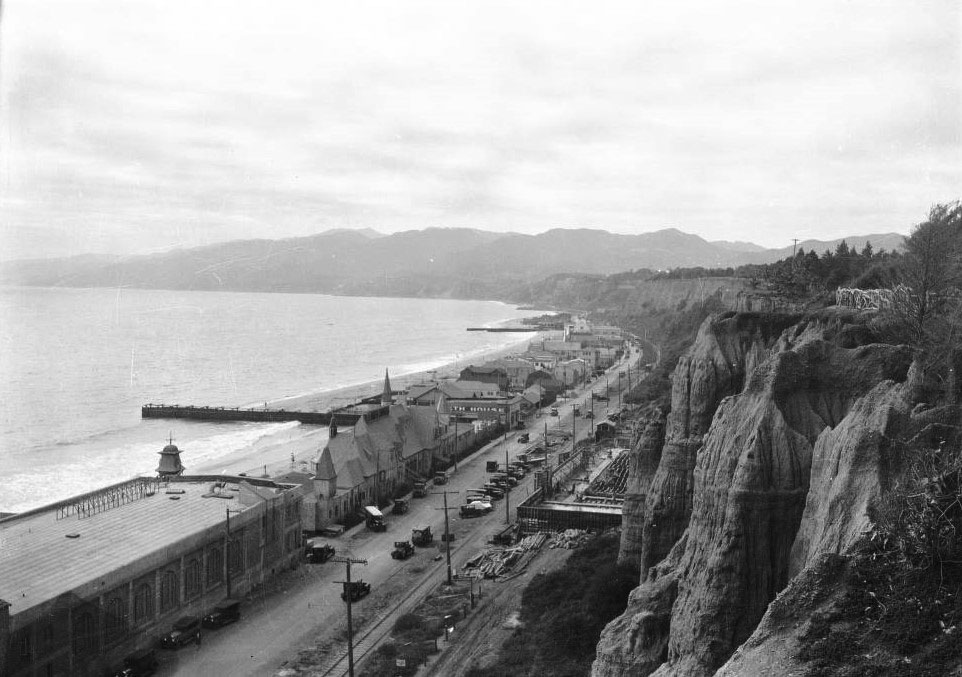 |
|
| (ca. 1926)* - Birdseye view of Roosevelt Highway (later Pacific Coast Highway) in Santa Monica from Palisades Park. The steep cliffs of Palisades Park are visible at right, and a wooden fence can be seen running along the top edge. Below, a long line of buildings, including a bath house and the Gables Beach Club can be seen on the left side of Pacific Coast Highway. At the base of the Palisades (center-right) can be seen the foundations for the new Gables Hotel. |
Historical Notes IIn the 1920s and 30s, a number of fancy beach clubs were built along Santa Monica beach including the aptly named Santa Monica Athletic Club, the Beach Club, the Santa Monica Swimming Club, the Deauville, the Wavecrest, the Edgewater, and the Breakers. There was also the Gables Beach Club, a grand Tudor-style building (seen above) constructed in 1926. |
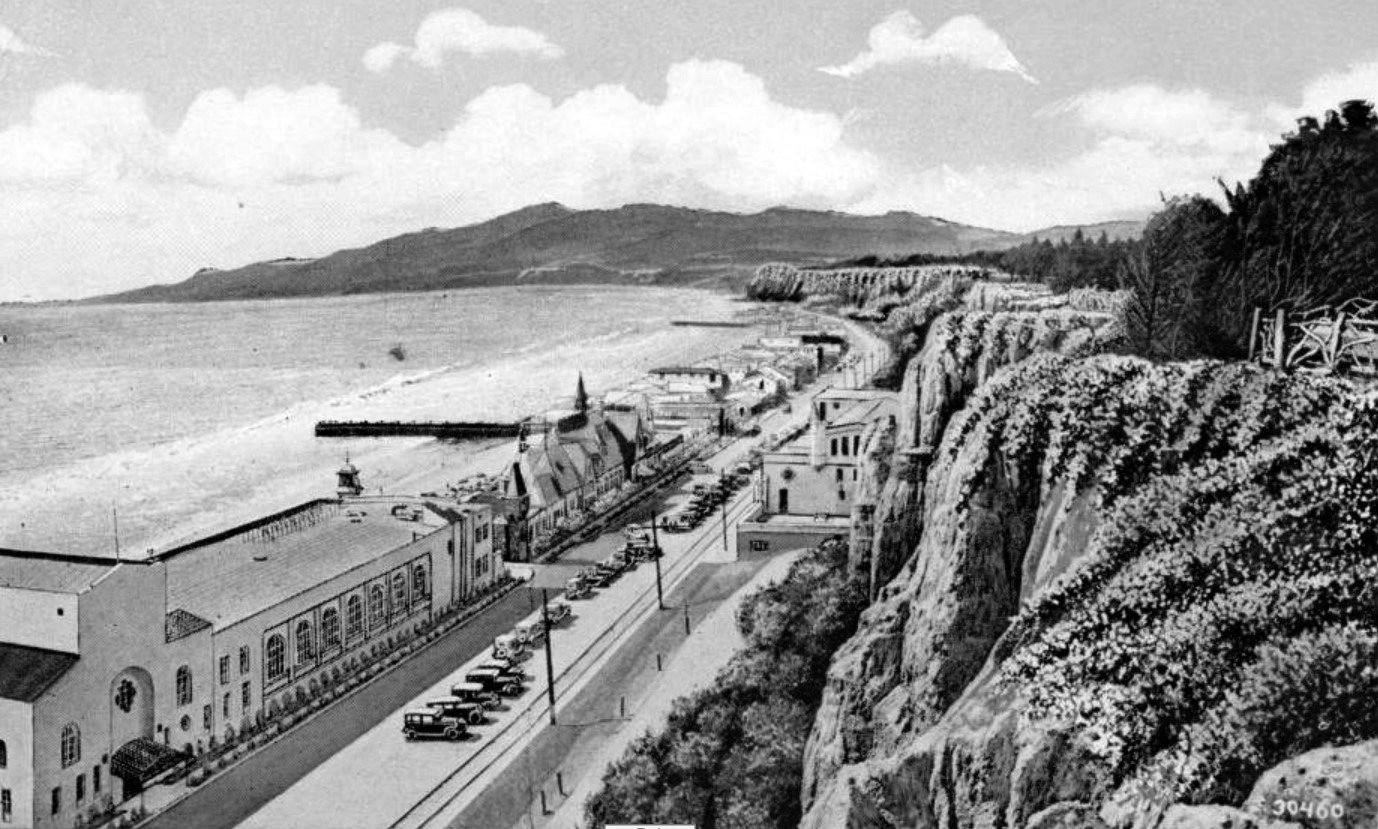 |
|
| (ca. 1927)* – Panoramic postcard view looking north toward Malibu showing several beach clubs as seen from Palisades Park. The Jonathan Club, opened in 1927, is on the lower left. Next to it is the Gables Beach Club, which burned in a fire in 1930, only to reopen with a new building. Across the Roosevelt Highway is the unfinished Gables Hotel, later known as the Sorrento Ruins. |
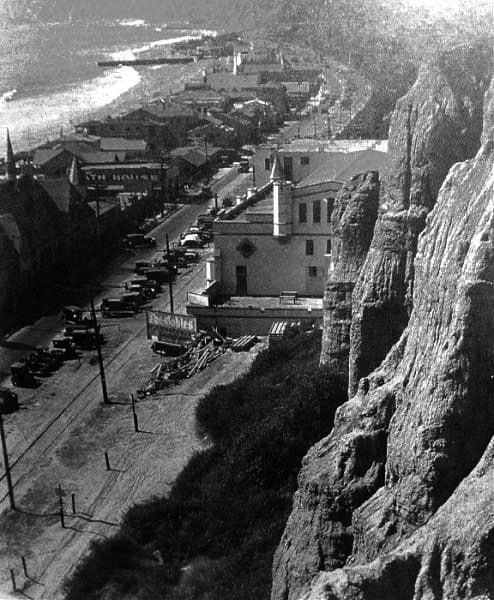 |
|
| (ca. 1927)^.^ – View showing the Gables Hotel on the Palisades in Santa Monica. The hotel was never finished due to the Great Depression and eventually became known as the Sorrento Ruins. |
Gables Beach Club and Hotel
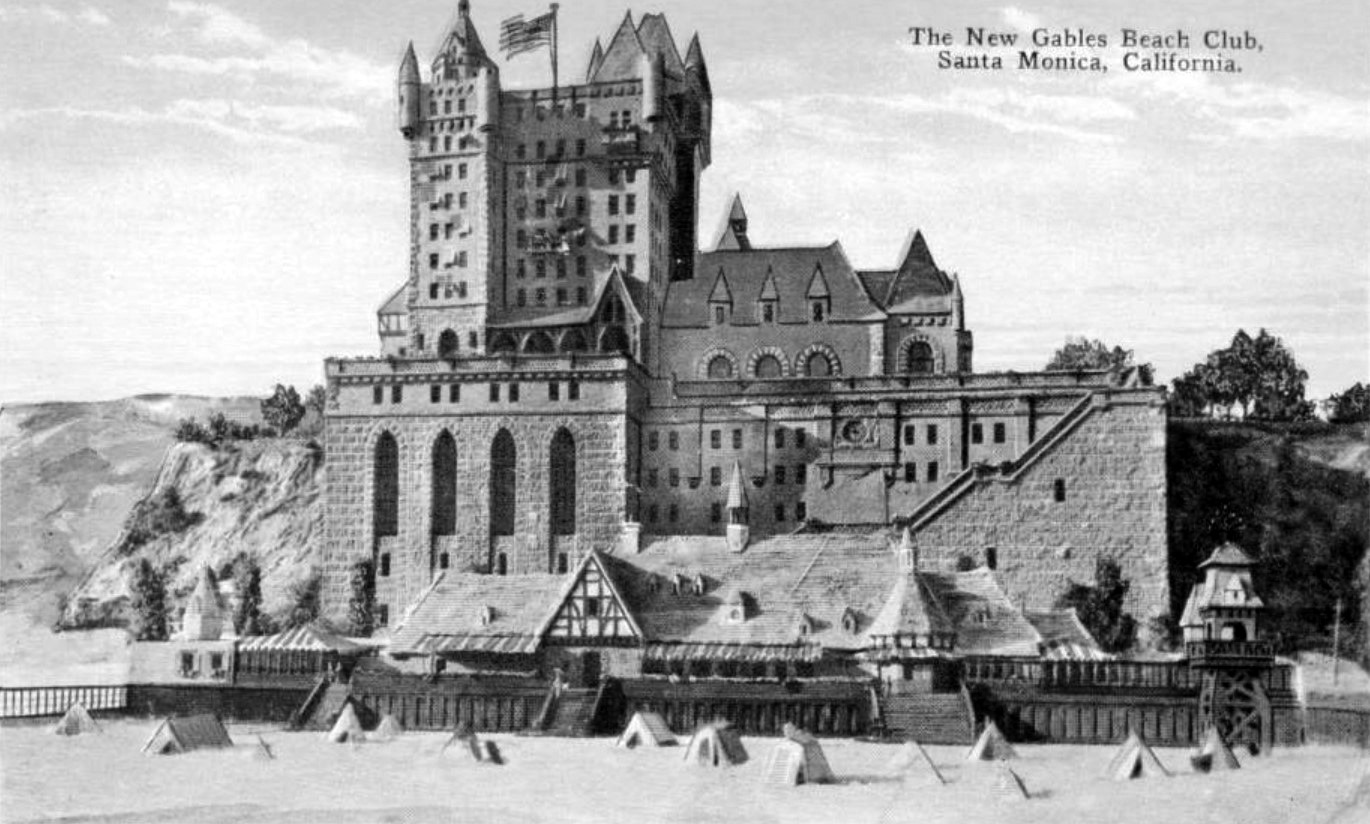 |
|
| (ca. 1926)* – Postcard view showing an illustration of the proposed Gables Beach Club and Hotel. The hotel was never completely built. |
Historical Notes The Gables Beach Club, seen on the beach in the foreground, was completed in 1926 and flourished until it burned in a fire in 1930. It reopened a few years later as the Sorrento Beach Club. The 21-story Gables Hotel began construction in 1926 also but only reached the third story before the project was halted by the Great Depression. The hotel was never completed, and the three-story structure was later used as a parking facility for the Sorrento Beach Club located across the street until 1962. The building was demolished in the 1970s, except for the foundation, which is still visible today and now serves as a retaining wall. It is now known as the Sorrento Ruins. |
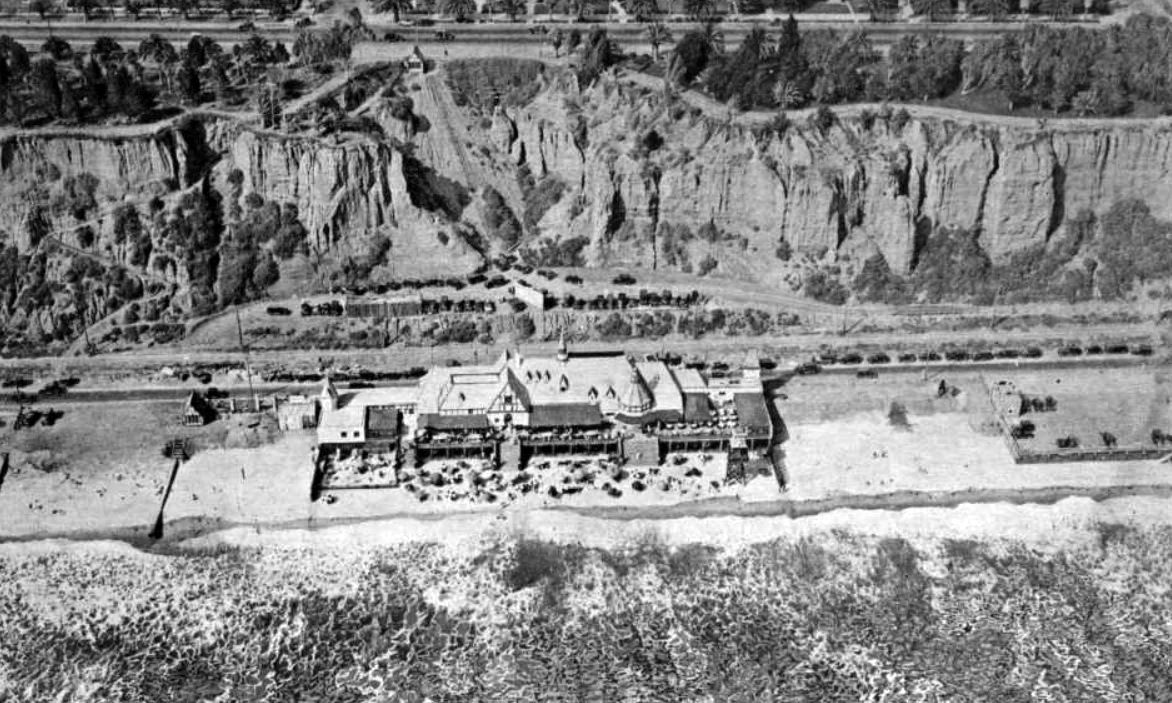 |
|
| (ca. 1926)* – Aerial view showing the buildings and site of the Gables Beach Club and beach in Santa Monica, with the Palisades bluffs in the background. Cars are parked across the highway where the 21-story hotel was planned to be constructed. |
.jpg) |
|
| (ca. 1926)* - View of the Santa Monica beach from the palisades, showing the Gables Beach Club. A short pier or breakwater extends into the sea at center, and another can be seen in the distance at right. |
Historical Notes The grand Tudor-style Gables Beach Club was constructed in 1926. It was a popular filming location. After a fire partially destroyed it in 1930, the club was rebuilt and reopened as the Sorrento Beach Club in 1932. |
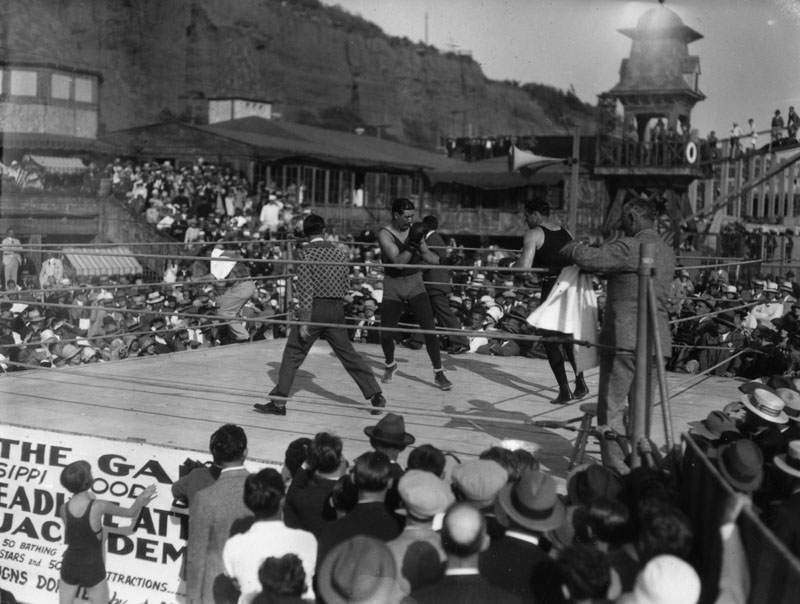 |
|
| (1920s)* - View showing Jack Dempsey boxing for a fund raiser in a ring outside the Gables Beach Club. |
Historical Notes William Harrison "Jack" Dempsey became a cultural icon of the 1920s. He held the World Heavyweight Championship from 1919 to 1926, and his aggressive style and exceptional punching power made him one of the most popular boxers in history. Many of his fights set financial and attendance records, including the first million-dollar gate.*^ |
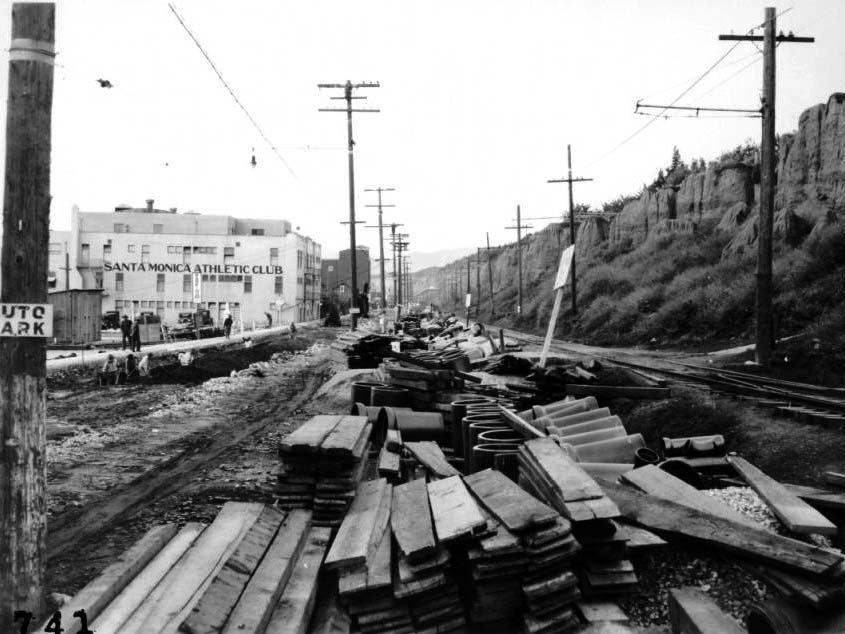 |
|
| (1927)* - View looking north along Coast Highway from point just north of Colorado Street, Santa Monica. Also visible are: lumber and other construction supplies, workmen, pedestrians, railroad tracks, embankment at the top of which are palm trees, utility poles and lines, buildings (businesses mostly), a few parked automobiles. Legible signs include: "Auto Park", "Santa Monica Athletic Club", "Parking 25¢". |
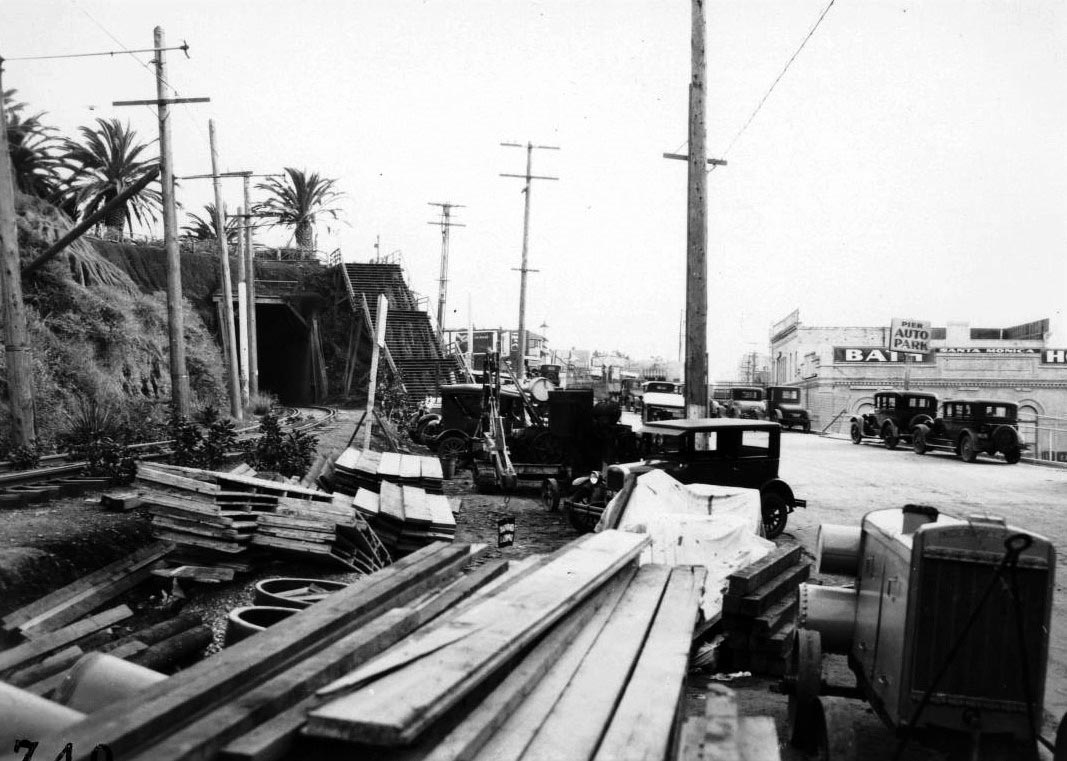 |
|
| (1927)* - View looking south along Coast Highway from point just north of Colorado Street, Santa Monica, showing entrance to the Pacific Electric Railway tunnel under Ocean Avenue. Also visible are: lumber and other construction supplies, generator, parked automobiles, embankment, utility poles and lines, stairs up to Ocean Avenue, businesses, a few palm trees along Ocean Avenue. Legible signs include: "Lunch..., "Pier auto park", "Santa Monica Bath House". To the right (out of view) is the Deauville Club, which is still under construction. |
* * * * * |
Deauville Club
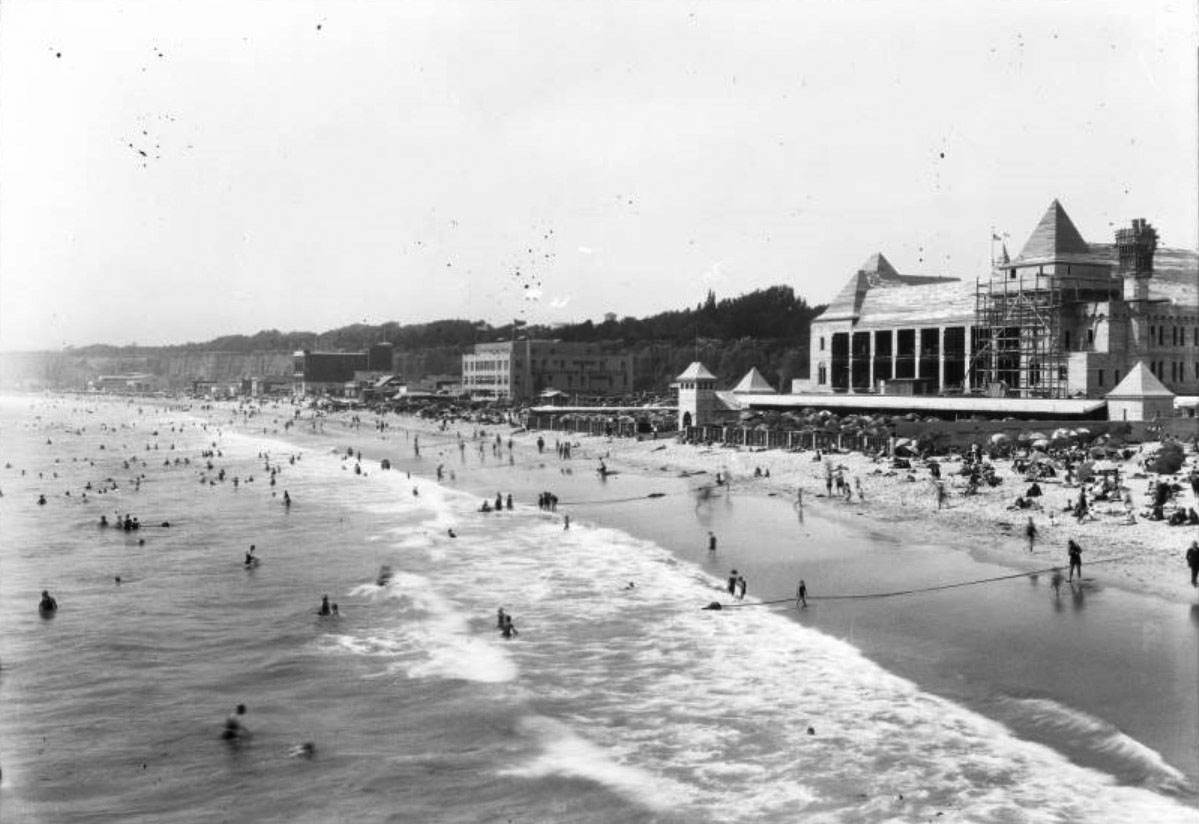 |
|
| (1927)* – View of beachgoers and the under-construction Deauville Club on the beach in Santa Monica. The large building is at right and is mostly complete except for the wall facing the beach. There is scaffolding around one of the two large towers on the corners of the buildings. The beach in front of the club is crowded with bathers playing in the sand and the surf. Further down the beach at center are other beach clubs, including the Santa Monica Athletic Club. |
Historical Notes The Deauville Club was located north of the Santa Monica Pier. It opened to the public in 1927 and was built on the site of the old North Beach House. It was modeled after a casino in Deauville, France, and considered to be one of the most beautiful beach clubs. |
.jpg) |
|
| (ca. 1927)* – View of the beach in Santa Monica in front of the Deauville Beach Club. The wide sandy beach is at center and is crowded with bathers and their umbrellas. A pair of bicycles is leaning against a post at center. The beach is bordered at right by several large buildings, including the Deauville club in the foreground and the Santa Monica Athletic Club further in the distance. |
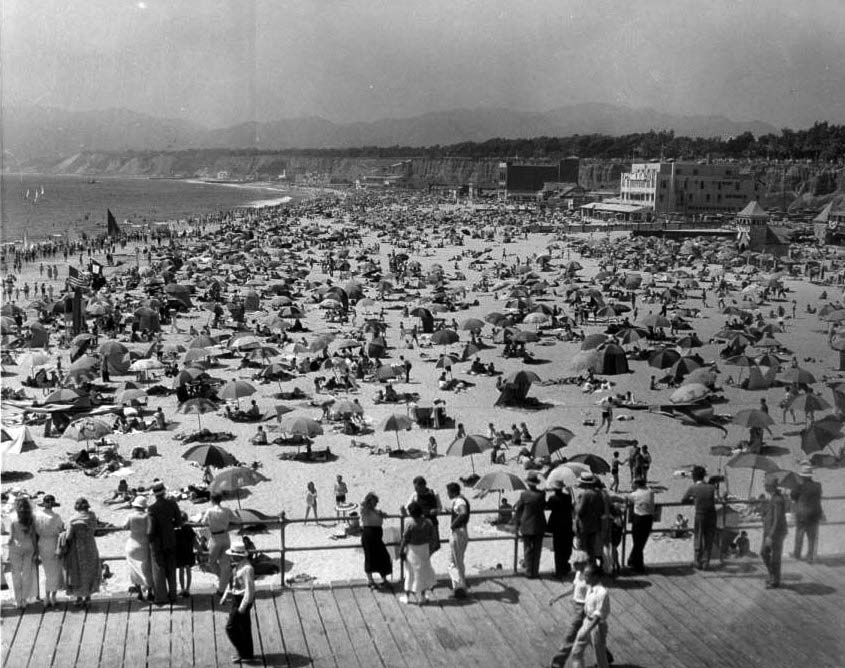 |
|
| (ca. 1930)* - View of Santa Monica Beach and Pier showing people standing at the rail of the wood-planked pier in the foreground as they look at the beach at center. People in bathing suits with umbrellas over them flood the sandy beach into the distance. The Santa Monica Athletic Club and part of the Deauville Club are in view at upper right. |
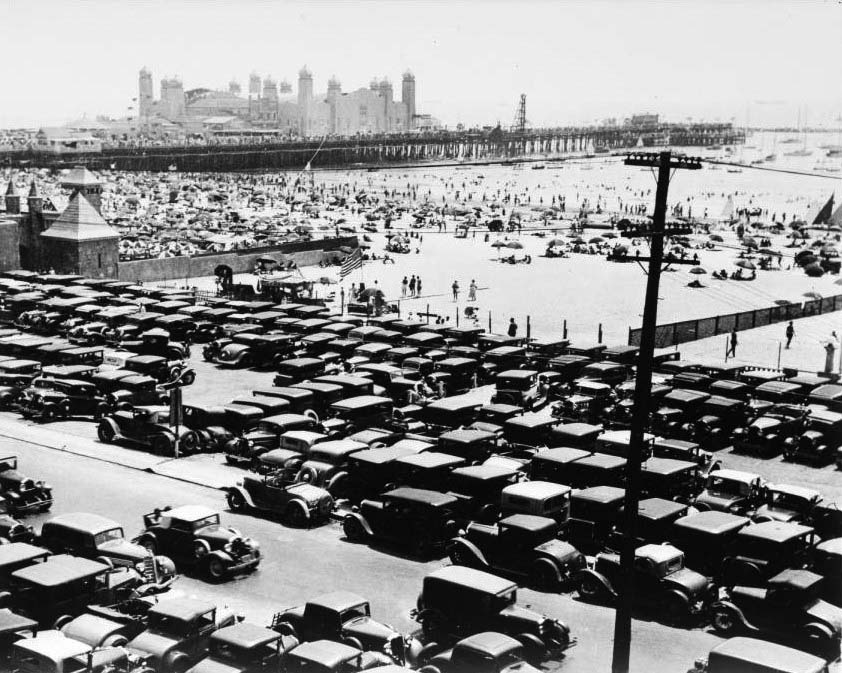 |
|
| (1934)* - View of the Santa Monica Pier showing a jammed-packed parking lot in the foreground. Hundreds of beachgoers can be seen under umbrellas and in the water. In the background the pier can be seen, with several structures on it. The most notable building on the pier is the La Monica Ballroom with minarets topping each of its many towers. At upper left can be seen part of the castle-style Deauville Club. |
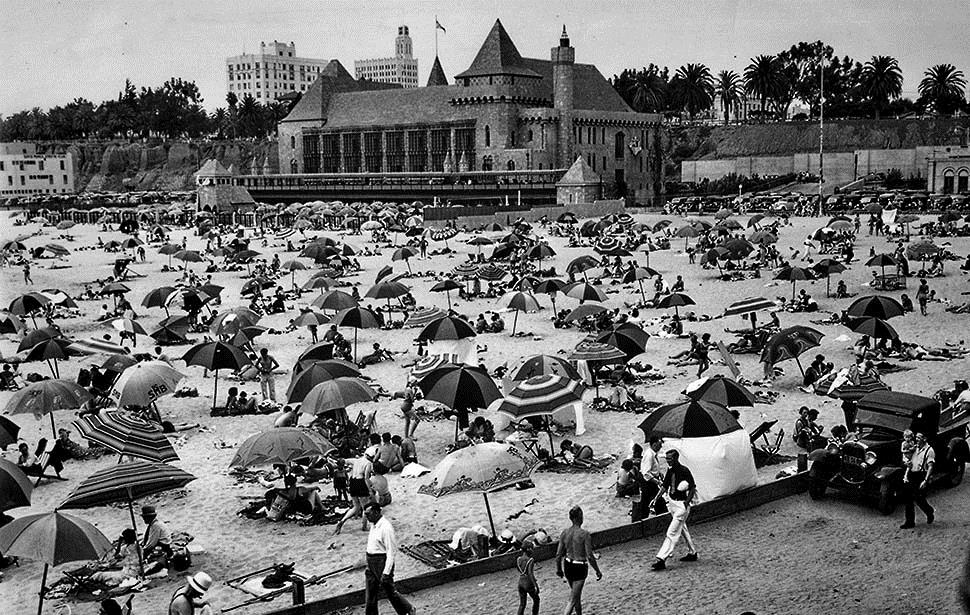 |
|
| (1936)* - A summer day at Santa Monica beach in front of the Deauville Beach Club. In the background, behind Palisades Park, can be seen the Georgian Hotel and thet Bay Cities Guaranty Building with its clock tower. |
Historical Notes The Deauville Beach Club was a significant landmark in Santa Monica, established in 1927. Designed by Morgan, Walls and Clements in a style reminiscent of a European castle. The club offered an impressive array of amenities including guest rooms, a gymnasium, a saltwater plunge, and various recreational facilities. It quickly became a popular destination for Hollywood stars and high society events. |
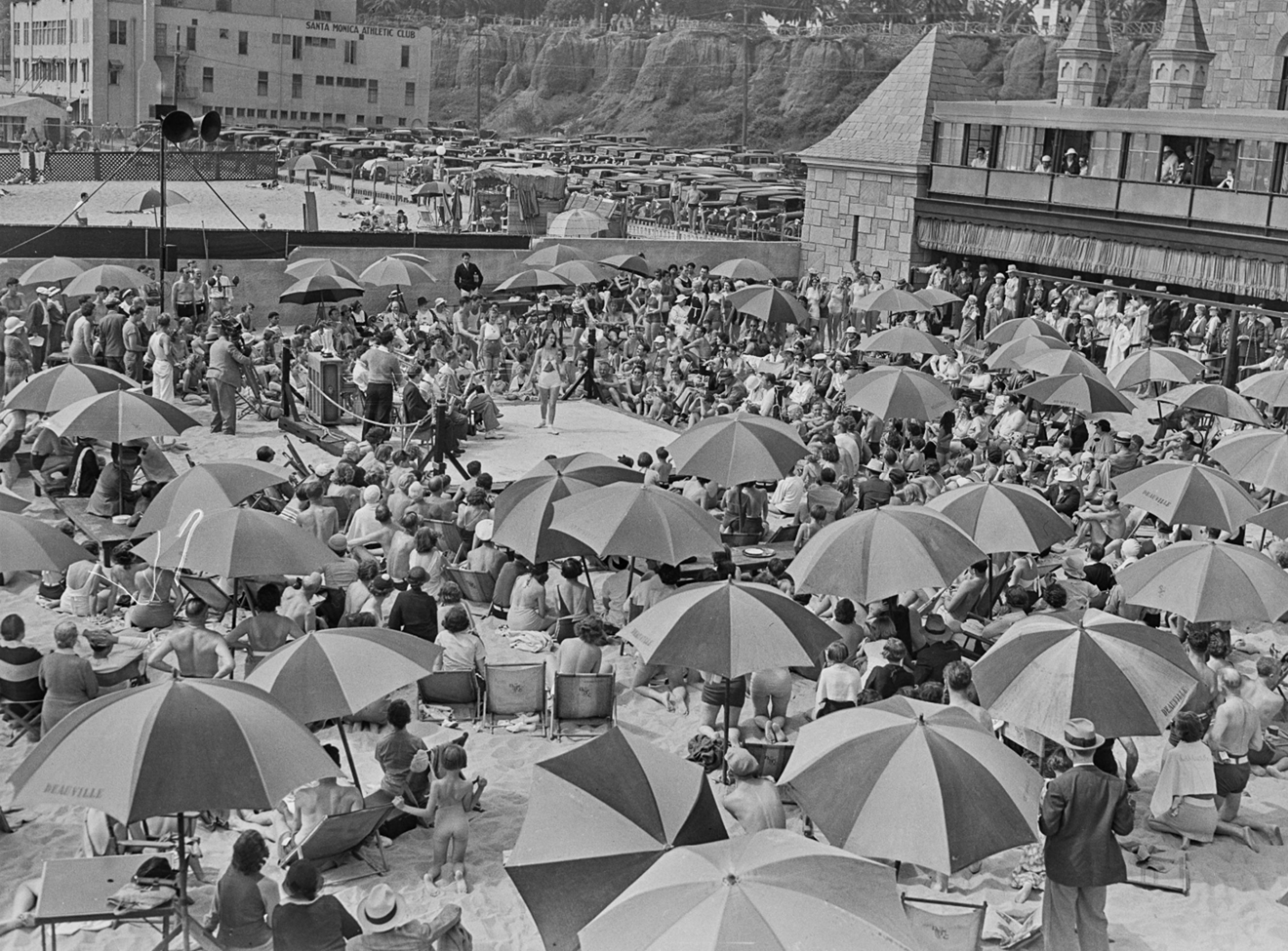 |
|
| (1934)* - View showing a crowd watching a beauty contest at the Deauville Club, with contestants lined up to walk on stage and a contestant modeling a bathing suit next to a musical band. The Georgian Hotel (built in 1933) is seen behind Palisades Park at upper right edge of image. Photo from the Ernest Marquez Collection. |
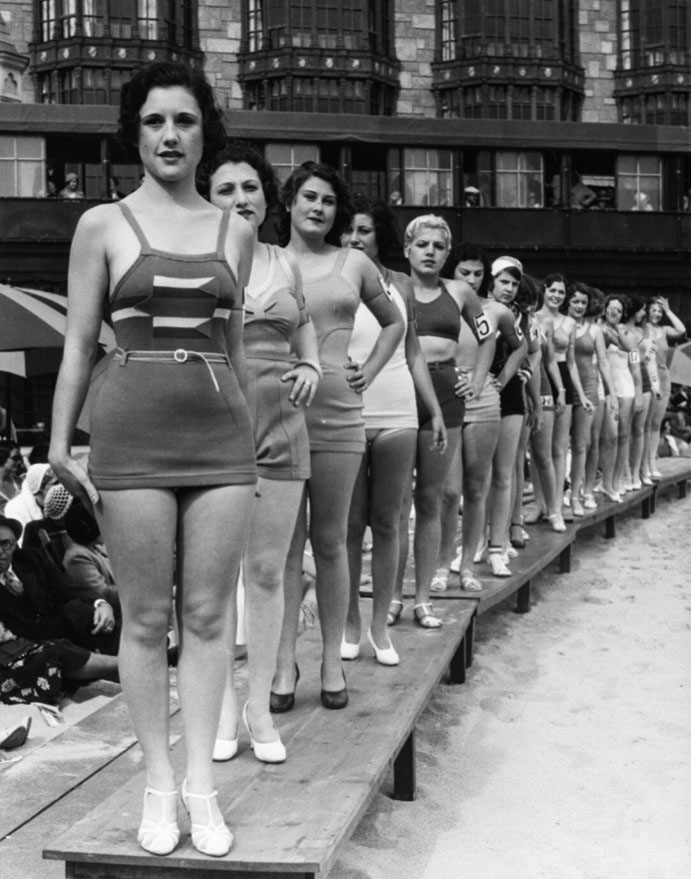 |
|
| (1932)^ - Image of contestants walking on elevated planks in bathing suits for a beauty contest at the Deauville Club in Santa Monica. |
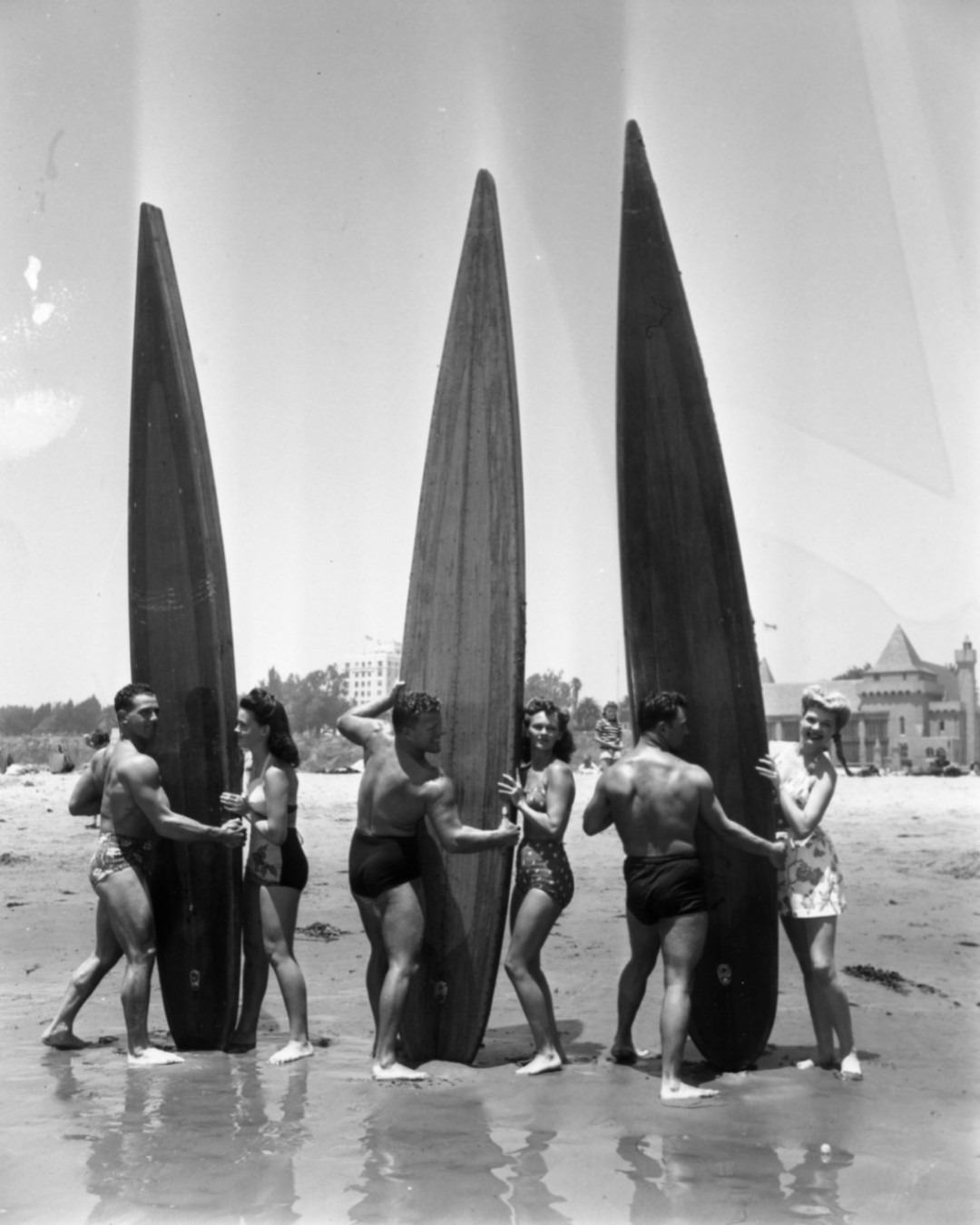 |
|
| (1930s)* – Three couples posing for the camera by their longboards at Santa Monica Beach with the Deauville Club in the background. |
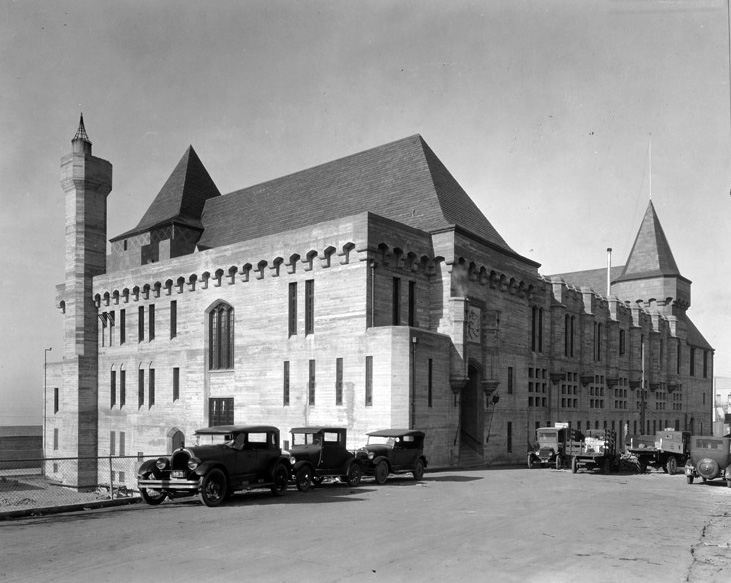 |
|
| (ca. 1930s)* - Street side view of the castle-style Deauville Club located at the junction of the Roosevelt Highway and Olympic Blvd. |
Historical Notes In 1930, the Los Angeles Athletic Club bought the Deauville Club and, in 1933, a breakwater built in the bay expanded the sandy beaches, creating more oceanfront space for the multitude of visitors to the area. |
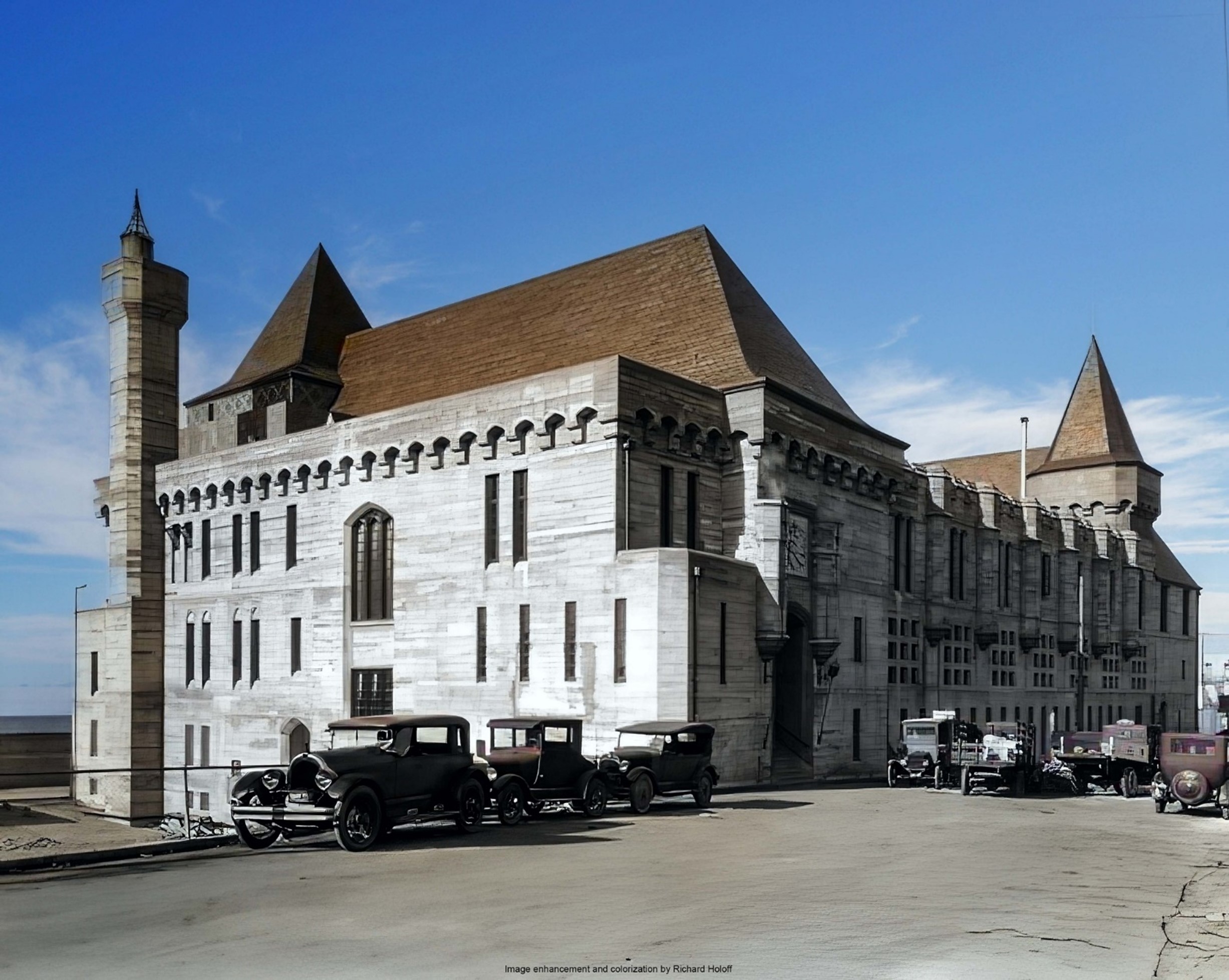 |
|
| (ca. 1930s)* - Street side view of the castle-style Deauville Club located at the junction of the Roosevelt Highway and Olympic Blvd. Image enhancement and colorization by Richard Holoff. |
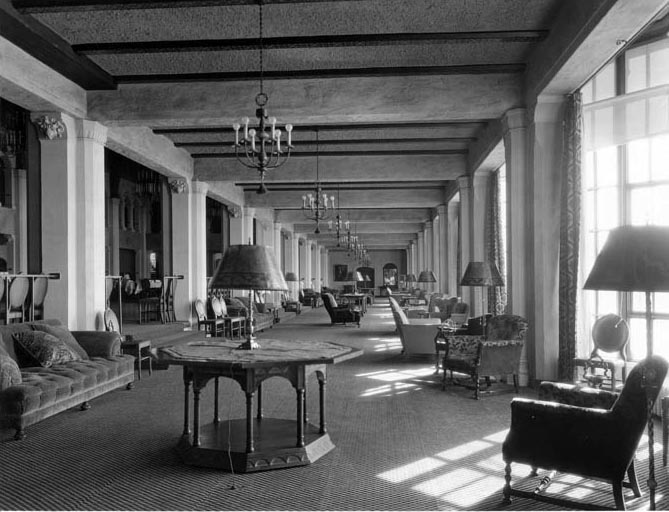 |
|
| (ca. 1930s)^^ - Interior view of the Deauville Club's lounge area with views of the surf. |
Historical Notes The Deauville offered guest rooms, a gymnasium, a saltwater plunge, lockers and showers, lounge rooms, game rooms, private dining rooms, and a restaurant. |
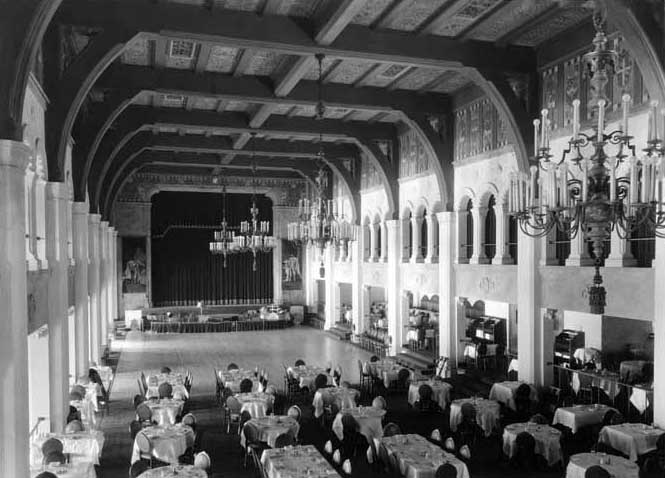 |
|
| (1930s)^^ - Interior view of the large, ornate dining hall at the Deauville Club. Chandeliers are seen hanging down from the high ceiling exposed beams. |
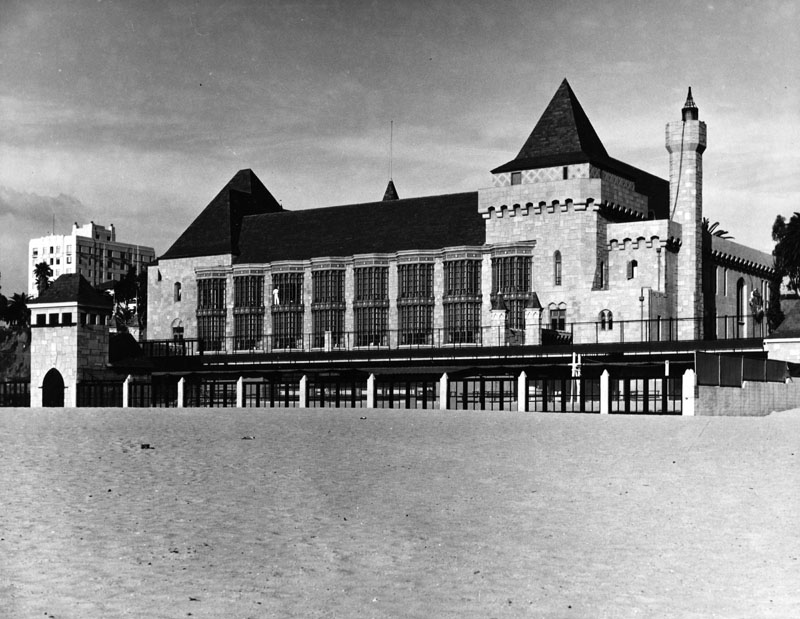 |
|
| (1937)* - Close-up view of the Deauville Club as seen from the beach. |
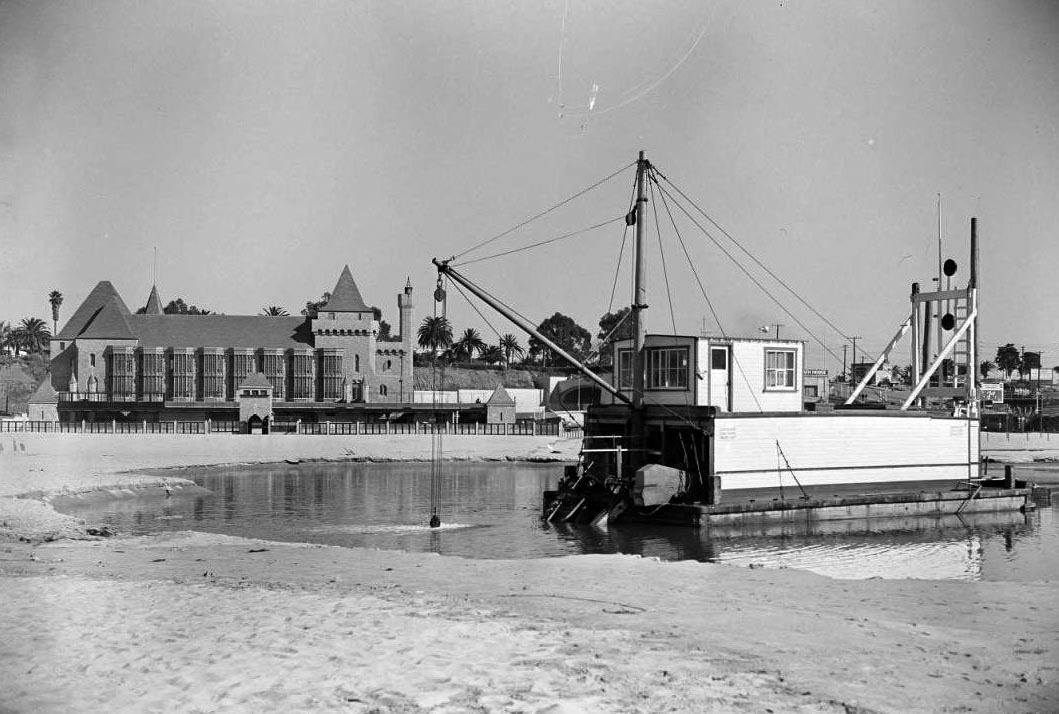 |
|
| (1938)* – View showing an electric dredge in a pool of water in front of the Deauville Club. To the right of the Deauville Club and behind the dredge can be seen the west end of the McClure Tunnel. |
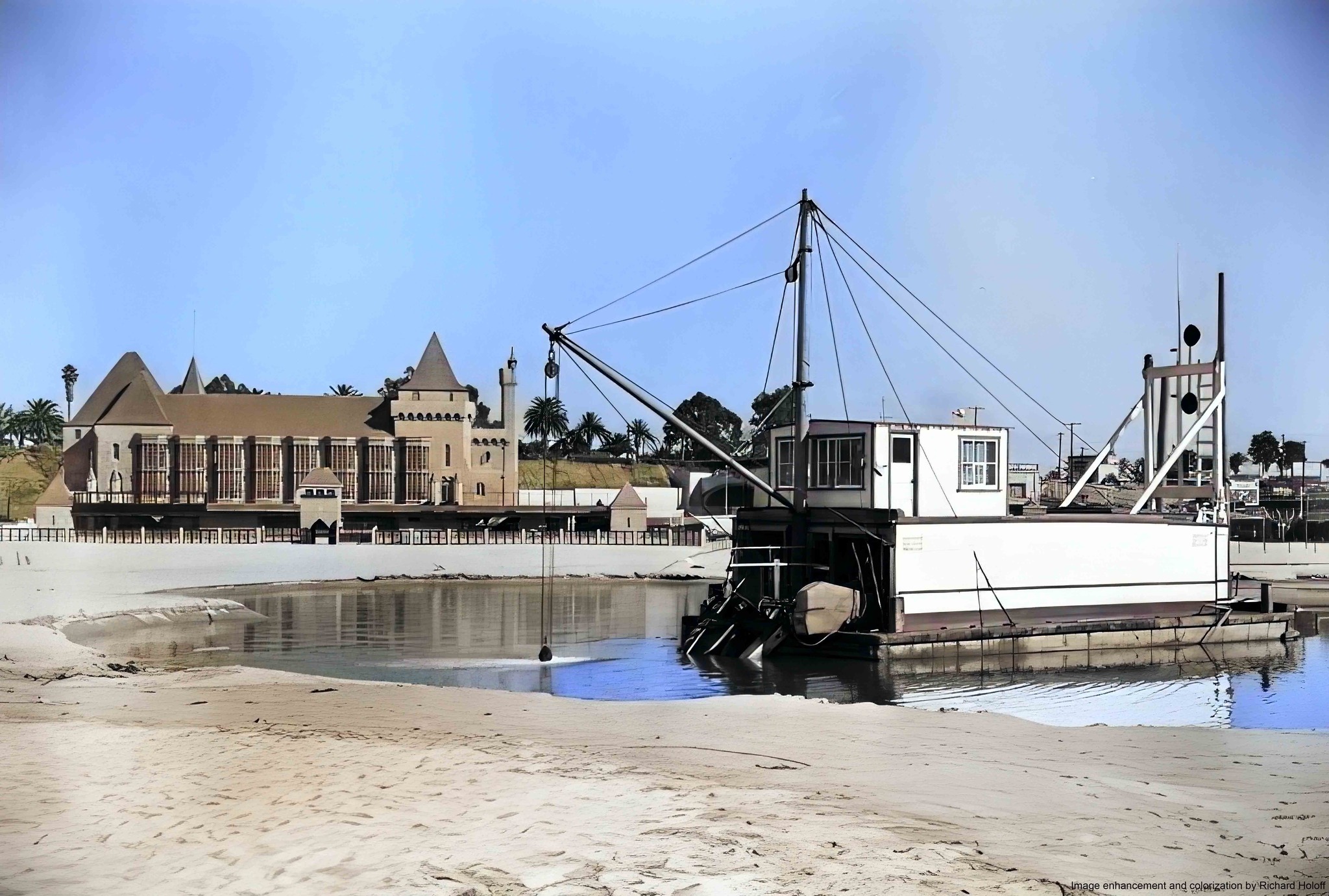 |
|
| (1938)* – View showing an electric dredge in a pool of water in front of the Deauville Club. To the right of the Deauville Club and behind the dredge can be seen the west end of the McClure Tunnel. Image enhancement and colorization by Richard Holoff |
 |
|
| (1930s)^ - Image of spectators on the beach watching a fencing match in front of the Deauville Club in Santa Monica, with the Looff Hippodrome seen at right on the Santa Monica Pier. |
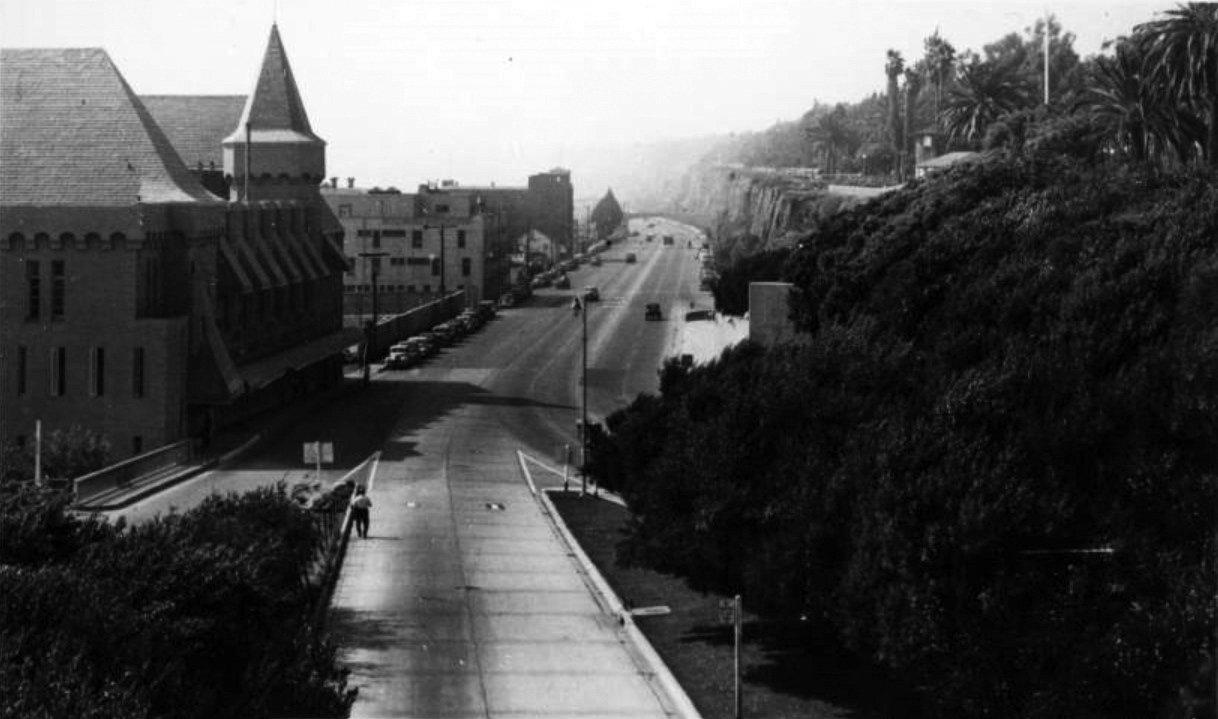 |
|
| (1940s)^ - View looking north showing Palisades Beach Road (part of the Roosevelt Highway and later Pacific Coast Highway), with the Deauville Club (with tower), Santa Monica Athletic Club, and Wavecrest Club, at left, and Palisades Park and bluffs at right. |
 |
|
| (1945)* - Jewish Community Center founders and guests gather for a dinner at the Deauville Club. The attached newspaper article states: "Halfway at the outset was the quota status of the subscription pledges announced for the proposed new Santa Monica Jewish Community Center Building when the Jewish leaders...and 245 others gathered for a dinner program at the Deauville Club." The word "aloha" is visible in the back of the room. |
 |
|
| (ca. 1948)* – Looking down from above PCH toward the Deauville Club with cars turning into the McClure Tunnel. Photo courtesy of Eric Wienberg Collection via Pepperdine University Special Collections. |
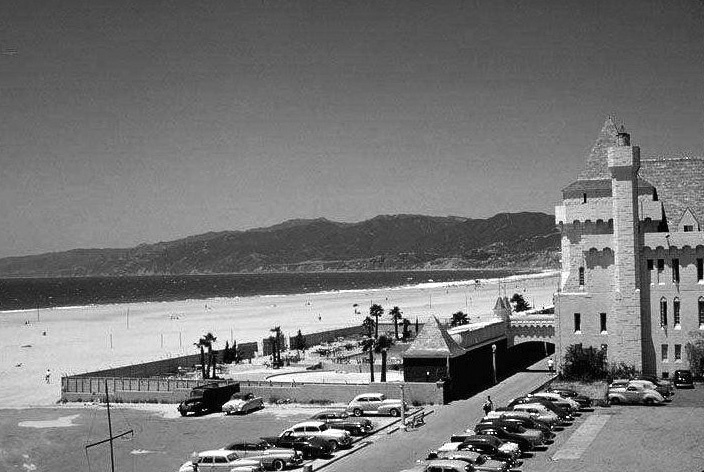 |
|
| (ca. 1955)* – View looking at the Deauville Beach Club near the end of its life. |
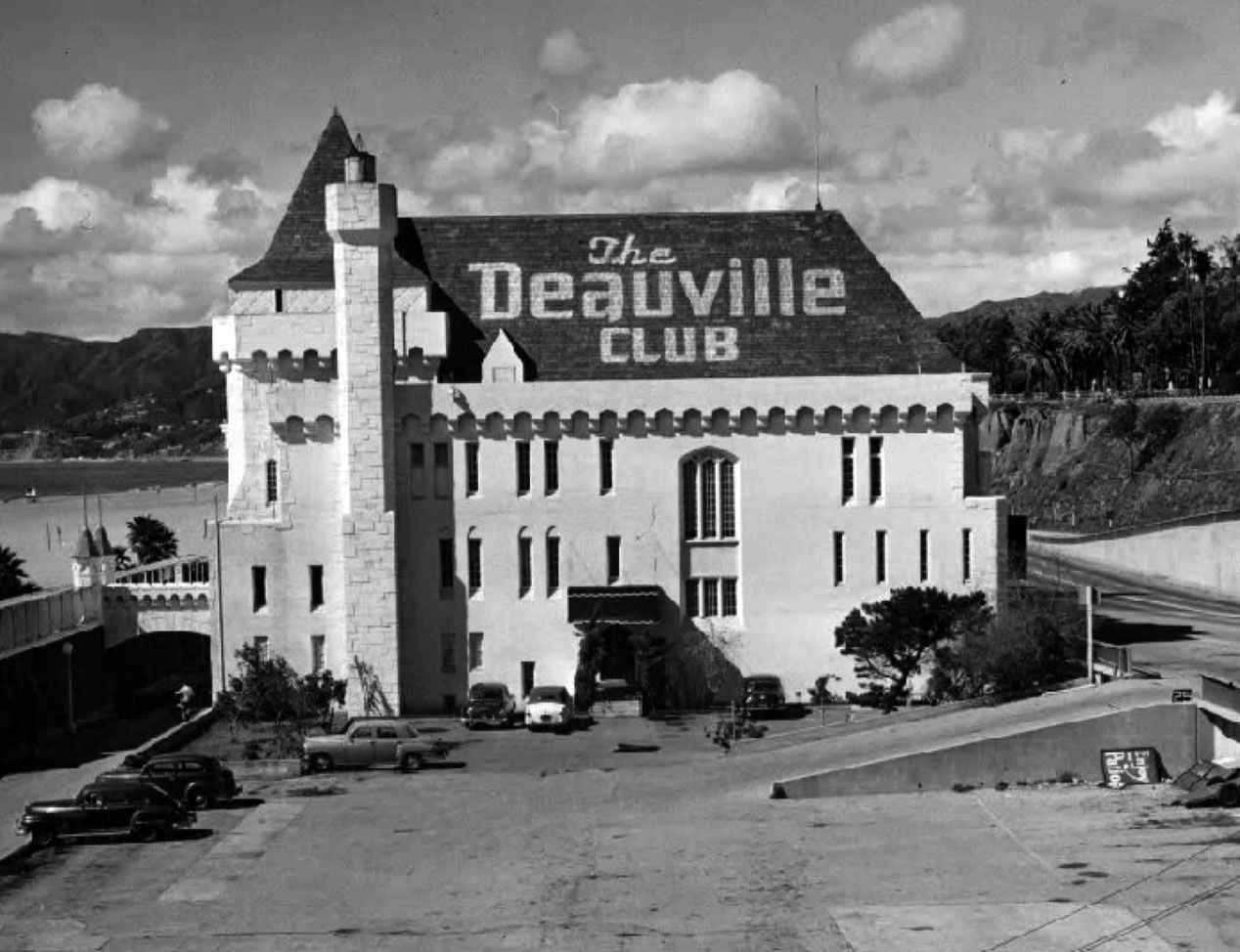 |
|
| (ca. 1950)* - The Deauville Club located just north of the Santa Monica Pier, opened in 1927 on the former site of the North Beach Bath House. Its design was inspired by a castle styled casino in Deauville, France. |
Historical Notes The club hosted bands, beauty contestants, dances, high school proms and banquets. It had several owners over the course of its nearly 40 year life. It was ultimately demolished in the mid-1960s following a devastating fire on April 5th, 1964. |
* * * * * |
Santa Monica Yacht Harbor and Pier
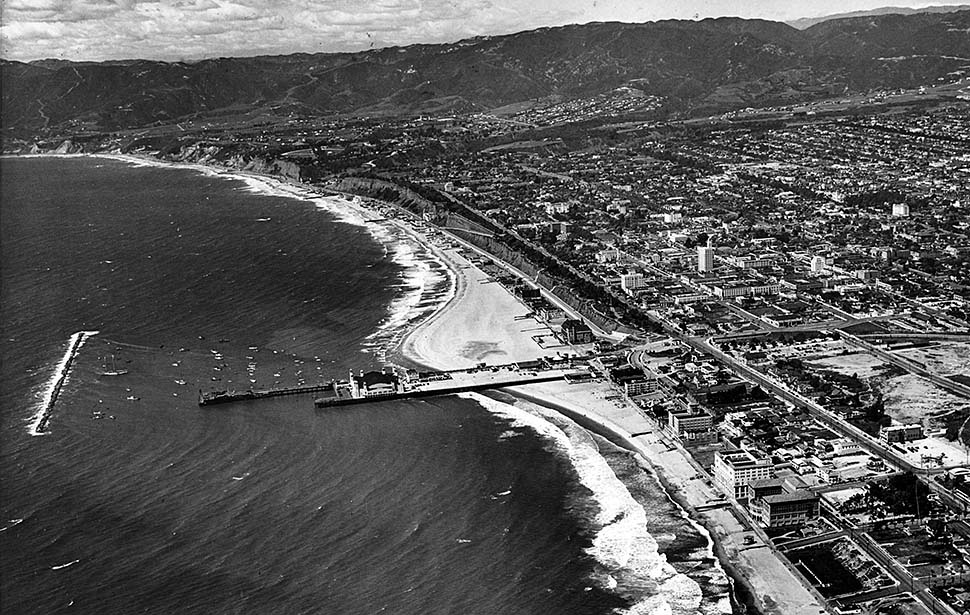 |
|
| (1937)* - Aerial photo of the Santa Monica Pier shoreline looking northwest. The Deauville Club sits to the north of the pier. The Casa del Mar Club is the first building located in the lower right corner. Photo by Spencer Air Service |
Historical Notes The Santa Monica Yacht Harbor was officially established in 1933 with the completion of the breakwater, a WPA project that transformed the pier into a working harbor. At 37 feet high and over 100 feet wide at its base, the breakwater provided a calm basin for yachts, fishing boats, and cruise services. This harbor not only altered the coastline—expanding the beach north of the pier—but also attracted tourists, boaters, and even floating casinos. |
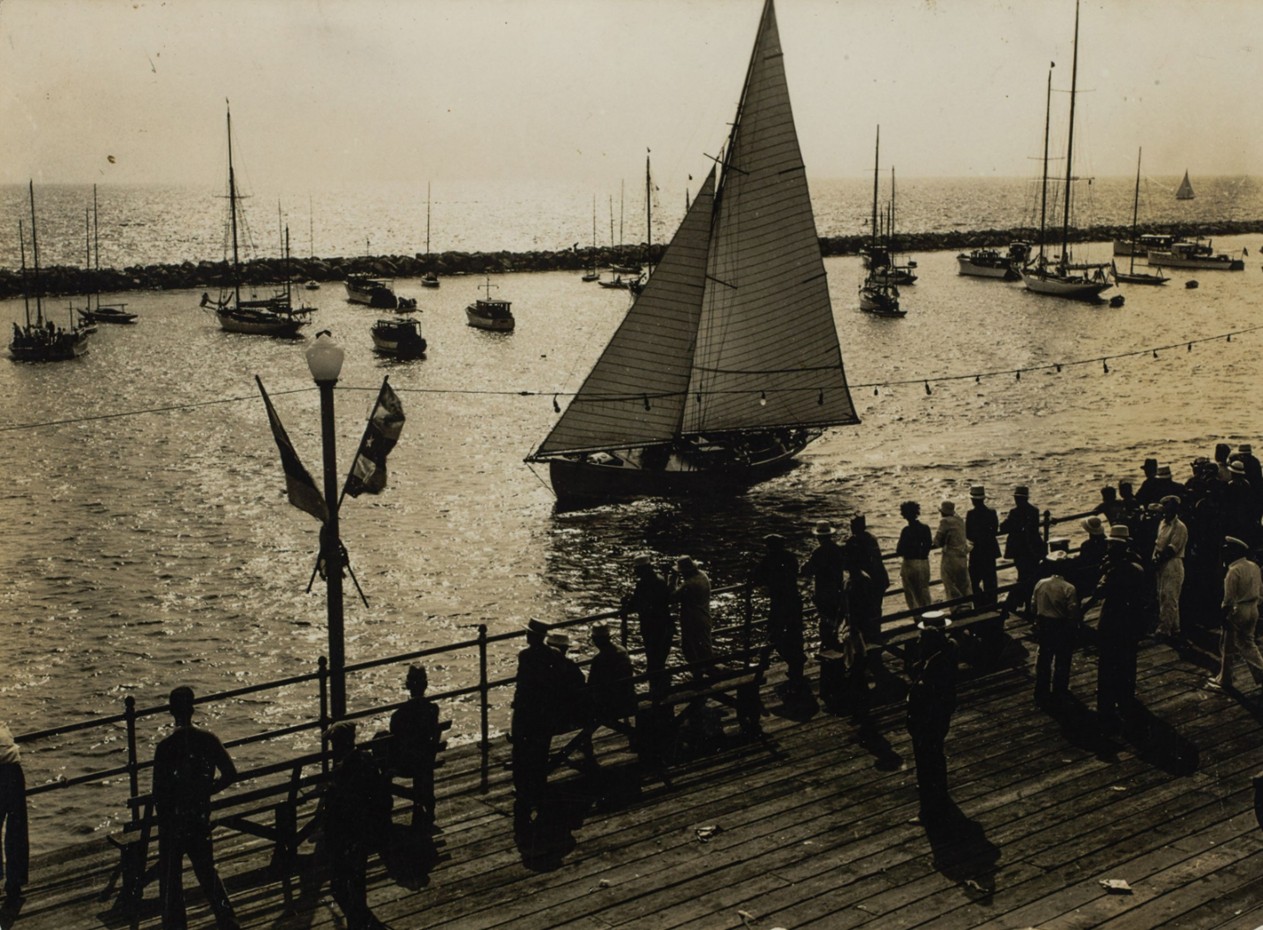 |
|
| (ca. 1935)* - Santa Monicans line the end of the pier to watch boats sail through the newly protected Santa Monica Yacht Harbor. The breakwater curves across the horizon, forming a calm and sheltered anchorage. Photo by Adelbert Bartlett. |
Historical Notes This ca. 1935 image captures the public engagement with the brand-new harbor. The protective breakwater—completed in 1934 as part of a WPA coastal improvement project—transformed the Santa Monica Pier into a functional marina. Small craft and sailboats could now moor safely just offshore, drawing both locals and tourists. The pier became not only a launch point for boats but also a popular place to watch them come and go. |
* * * * * |
The Battle of Santa Monica Bay
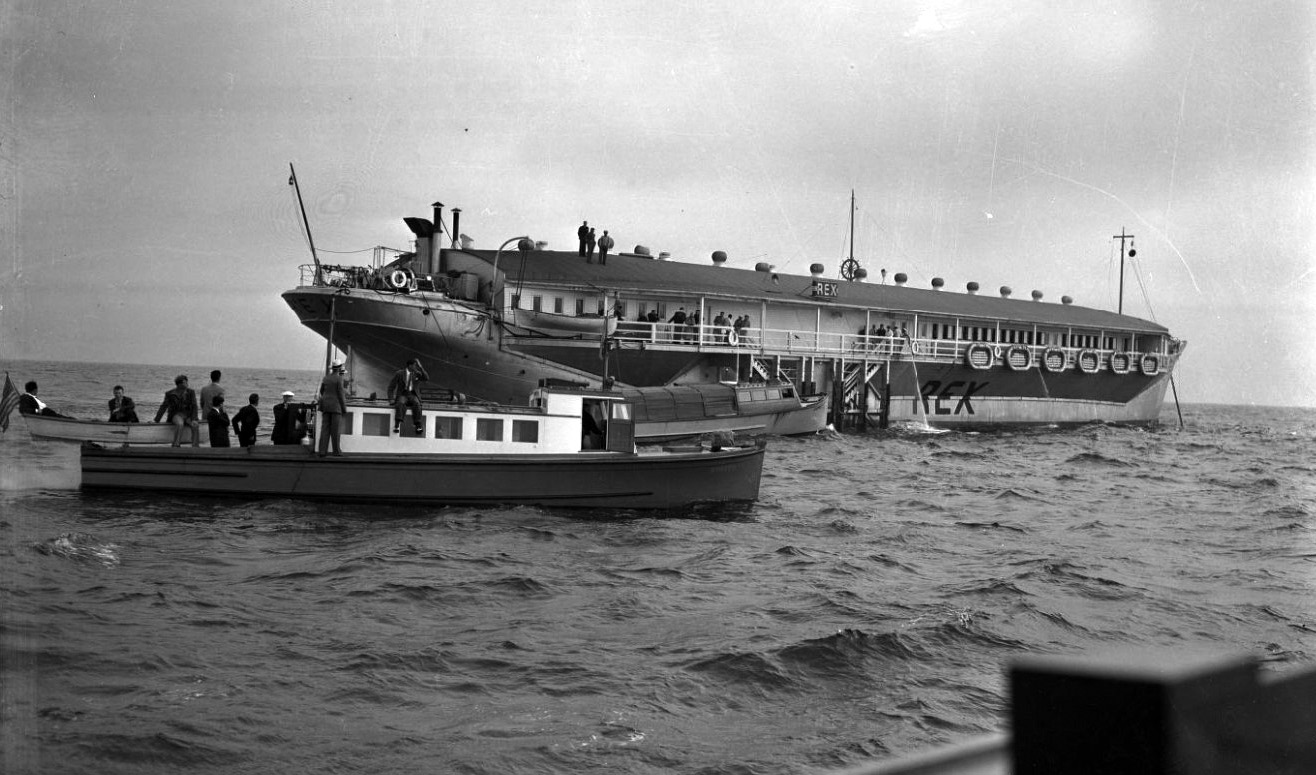 |
|
| (1939)* - The "Rex," one of Tony Cornero’s floating casinos, fends off law enforcement boats off the Santa Monica coast during “The Battle of Santa Monica Bay.” |
Historical Notes In the 1930s, gambling mogul Tony Cornero exploited legal loopholes by operating floating casinos just beyond California’s three-mile limit. His flagship vessel, The Rex, was a fully outfitted luxury gambling ship anchored off Santa Monica. The Santa Monica Yacht Harbor served as the primary launch site for water taxis shuttling gamblers to the offshore vessel. Boats based in the harbor made frequent trips, loading guests directly from the pier. The newly built breakwater provided calm waters for these shuttles, making the harbor a critical base of operations. This came to an end in 1939, when then–Attorney General Earl Warren initiated a raid dubbed “The Battle of Santa Monica Bay.” After a tense three-day standoff, Cornero surrendered—reportedly saying he “needed a haircut.” Agents boarded the Rex, dumped slot machines overboard, and set fire to the gambling tables. The episode marked the end of the harbor’s brief but colorful association with offshore gambling. |
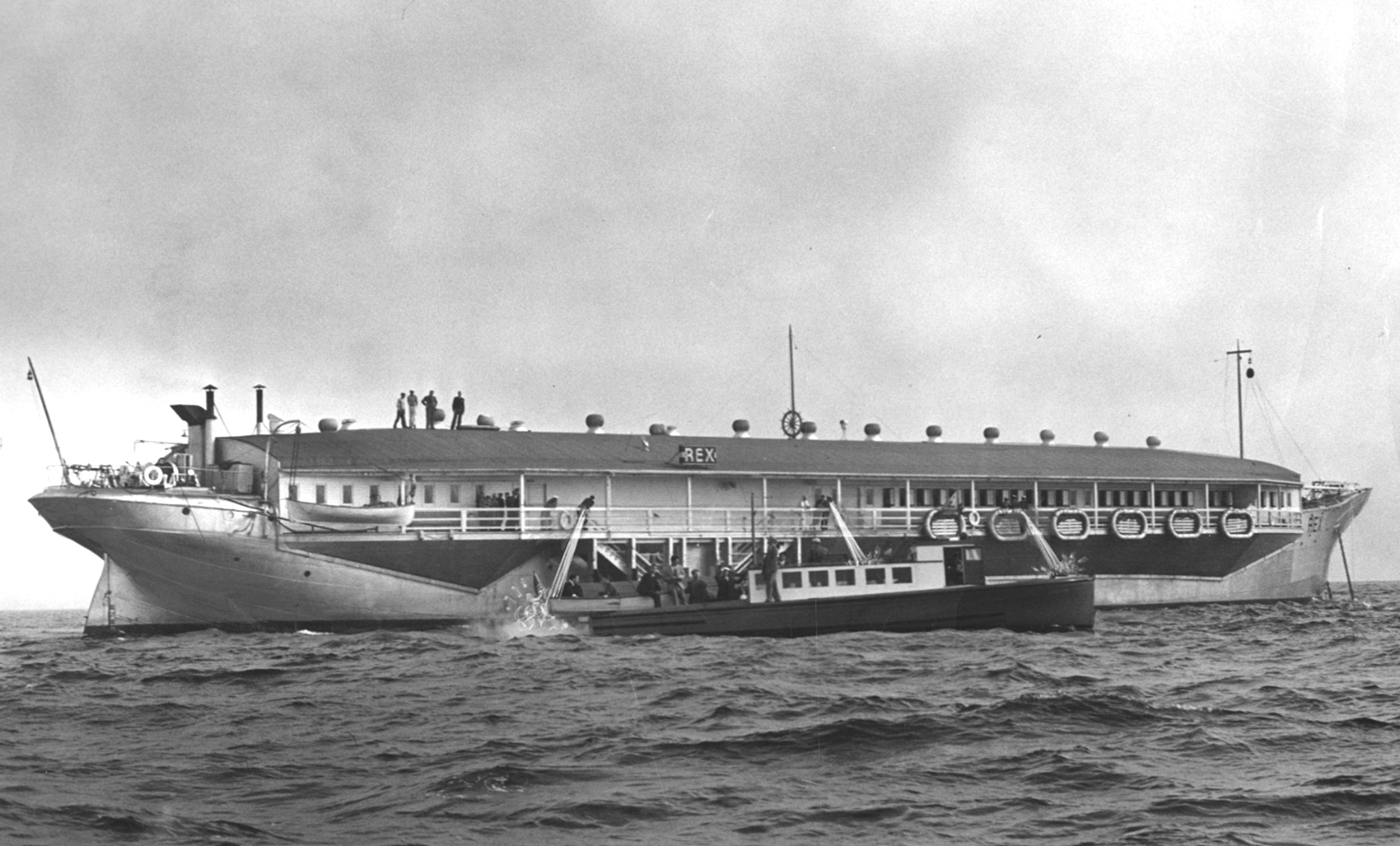 |
|
| (1939)* - The crew of the Rex turned fire hoses on law enforcement boats in a last-ditch attempt to keep them from boarding. |
Historical Notes In a dramatic show of defiance, the crew of The Rex used high-pressure fire hoses to repel law enforcement officers attempting to board the ship during the 1939 raid known as The Battle of Santa Monica Bay. For three days, Tony Cornero held off state agents as they circled his floating casino just beyond California’s legal reach. The confrontation drew national attention, symbolizing the clash between vice, legality, and spectacle off the coast of Santa Monica. Eventually, Cornero surrendered peacefully, but not before giving one last splash of resistance. Tony Cornero went on to become a pioneer in early Las Vegas, founding the Stardust Resort and Casino, but died in 1955 at the craps table of the Desert Inn—some say under suspicious circumstances. Earl Warren’s career soared. He became Governor of California and later served as Chief Justice of the U.S. Supreme Court, where he presided over landmark rulings like Brown v. Board of Education and Miranda v. Arizona, transforming the legal and civil rights landscape of the United States. |
* * * * * |
Santa Monica Pier (1930s)
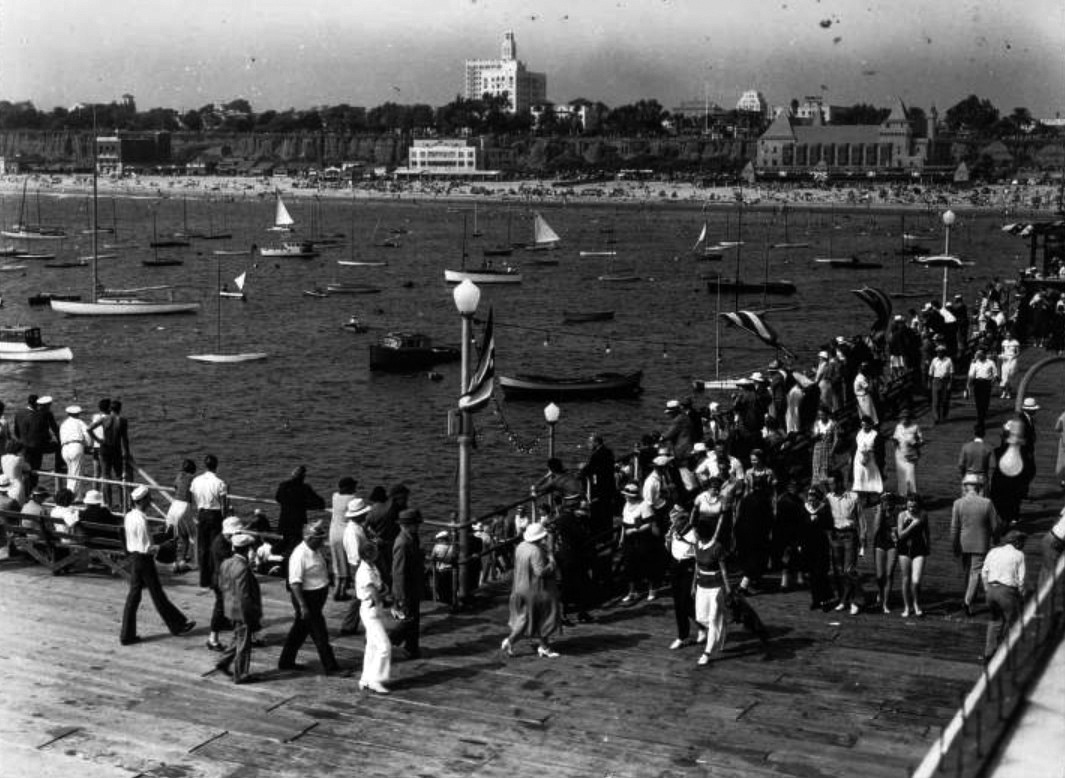 |
|
| (ca. 1935)* - View showing the Santa Monica Yacht harbor with boats in the water and people standing at the end of the Santa Monica Pier looking toward the beach. The Deauville Club (at right with towers), Santa Monica Athletic Club (center) and Wavecrest Club (at far left) are visible on the beach and the Bay Cities Guaranty Building (also known as the Clock Tower Building or Crocker Bank Building) is visible beyond the Palisades bluffs and Palisades Park. Photo by Adelbert Bartlett. |
Historical Notes This image captures the public’s excitement around the harbor. The new breakwater not only protected boats but also boosted the pier’s status as a social, recreational, and commercial hub. |
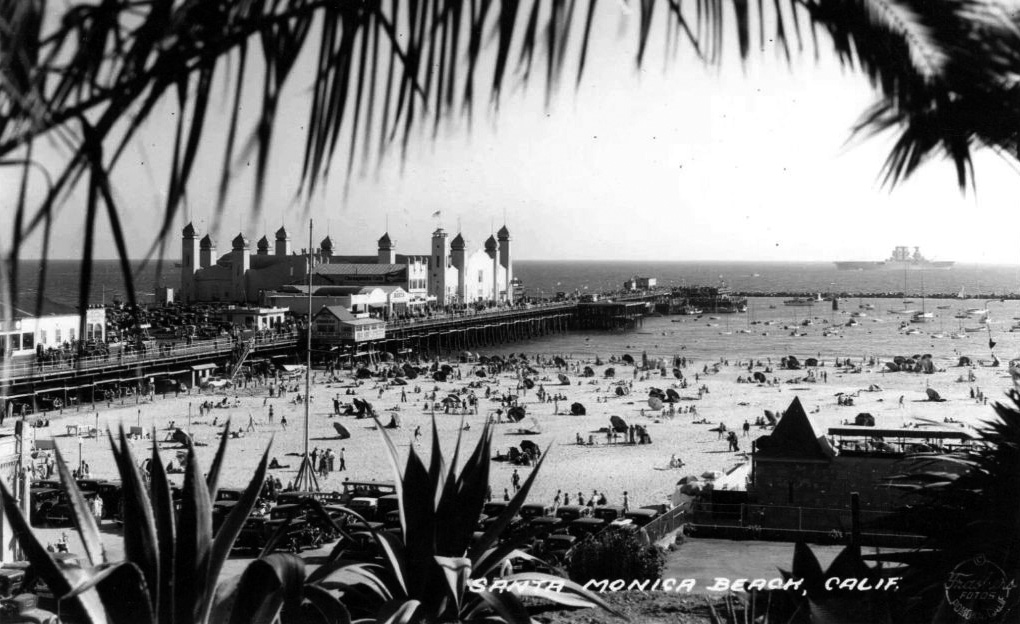 |
|
| (1940s)* - Postcard view showing the Santa Monica Pier and Harbor. The Spanish and French Renaissance style La Monica Ballroom stands out. Also, an aircraft carrier can be seen off in the distance. Frasher's Fotos. |
Historical Notes The La Monica Ballroom (opened in 1924) was the pier’s signature landmark for decades. During the war years, the nearby harbor also served patriotic functions, as local residents observed both pleasure boats and military vessels in Santa Monica Bay. |
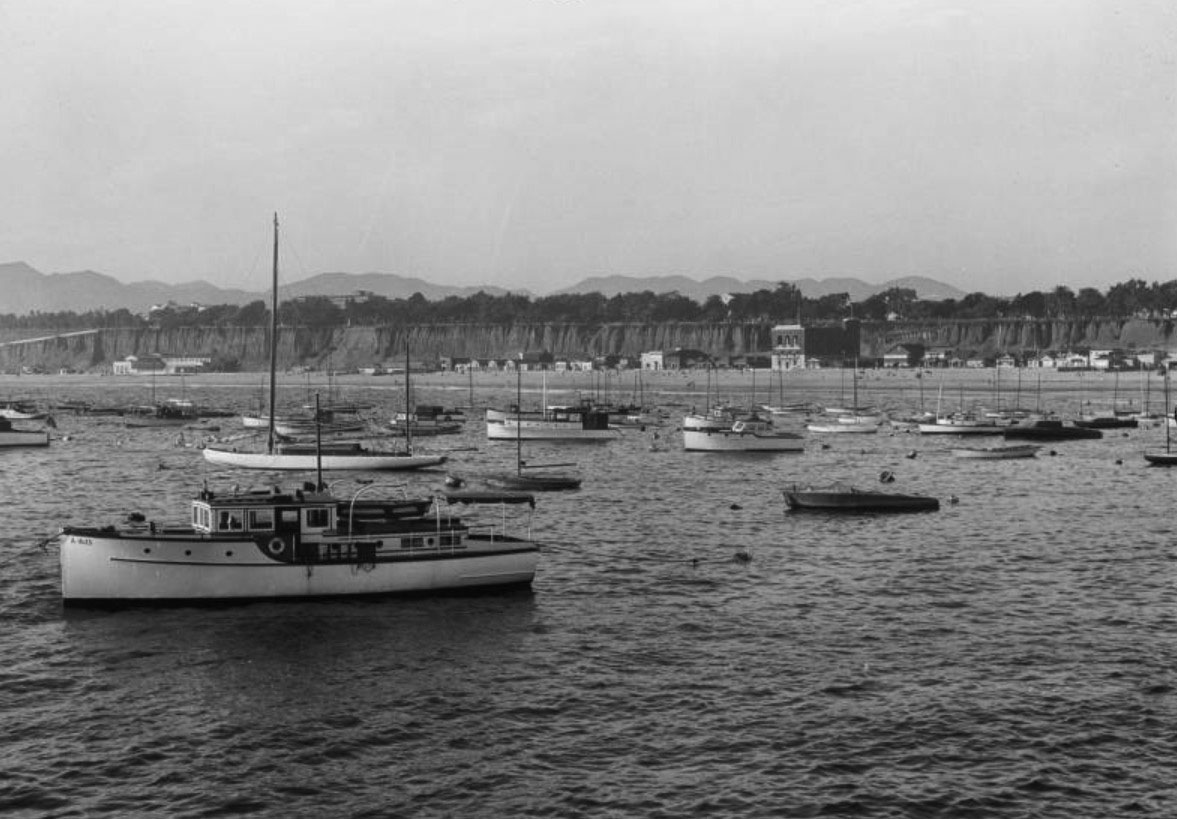 |
|
| (ca. 1935)* - View of the Santa Monica Yacht Harbor looking back to Santa Monica beach, with the California Incline seen at left, the two-story Wavecrest Club at center and the edge of the Santa Monica Athletic Club at right. |
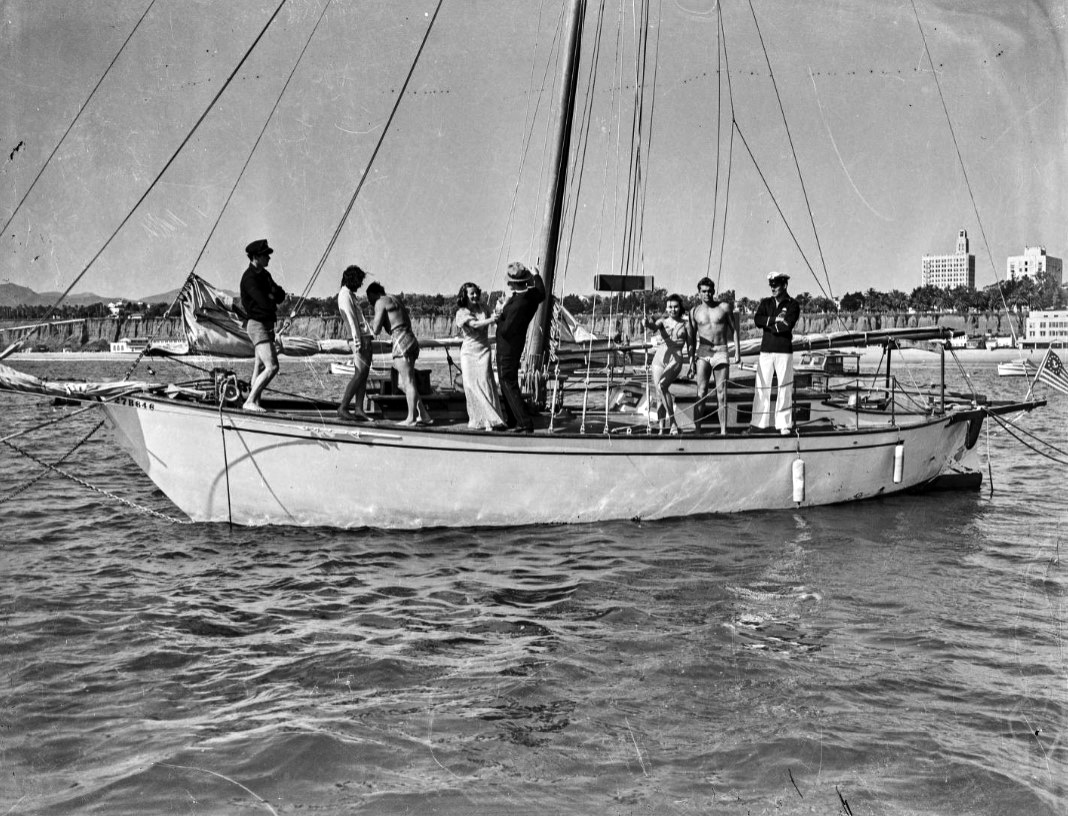 |
|
| (1930s)* - Image of a lifeguard, man in a tuxedo, woman in an evening dress, man in a sailor suit, and others in swimsuits standing on the deck of a sailboat in the ocean, with the Santa Monica Athletic Club, the Georgian Hotel, the Crocker Bank Building, and the bluffs below Palisades Park in the distance. |
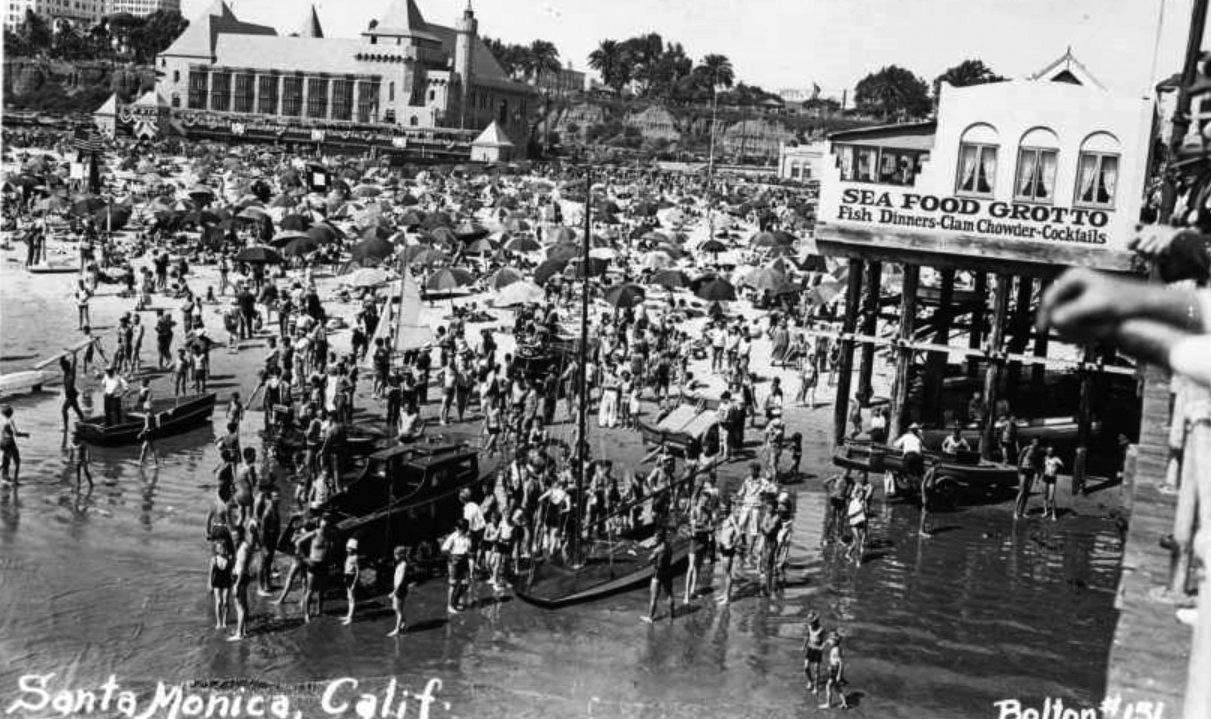 |
|
| (ca. 1934)* - Image of a beach crowded with people, small boats, and beach umbrellas just north of the Santa Monica Pier. The Deauville Club (on the beach with towers) is in front of the bluffs of Palisades Park with a sign for "Yachtsmen" and a sign advertising "Sea Food Grotto, fish dinners, clam chowder and cocktails" is seen on a restaurant situated at the edge of the pier at right. |
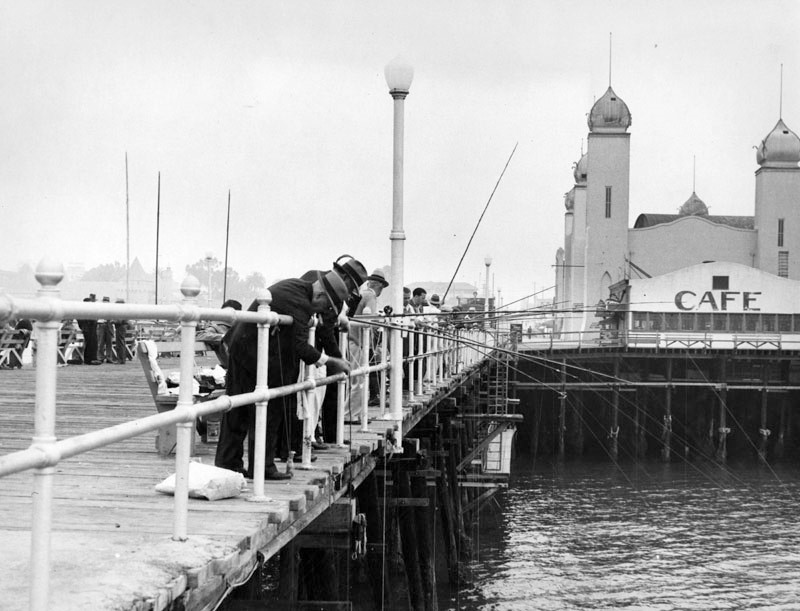 |
|
| (1937)* - Fishermen are angling from the pier with the La Monica Ballroom seen on the right. |
Historical Notes The Spanish and French Renaissance style La Monica Ballroom was designed by T.H. Eslick; it opened on July 23, 1924 and was demolished in 1963. |
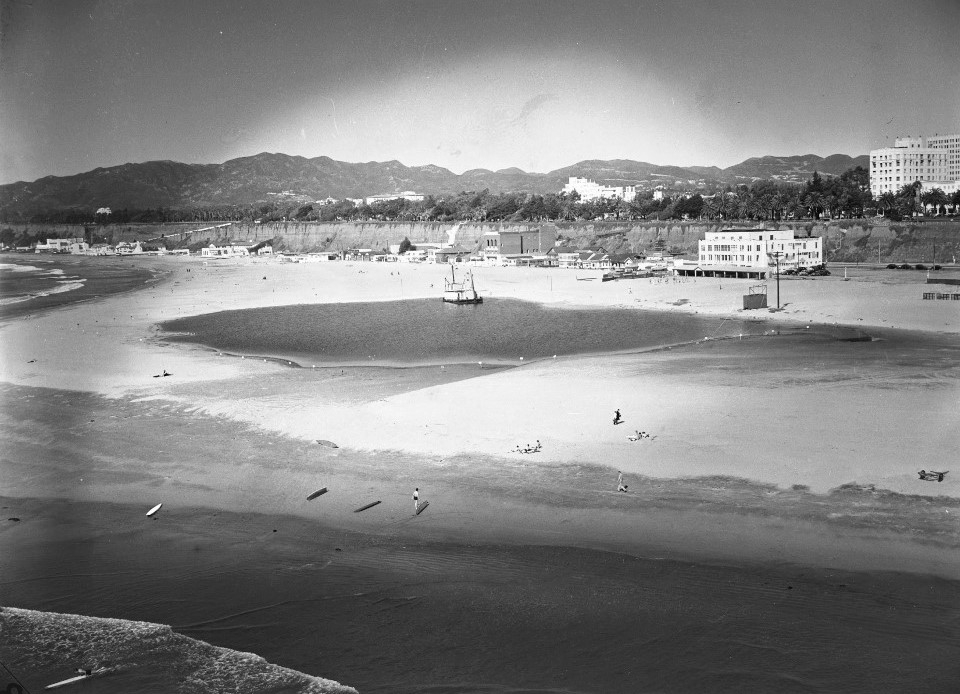 |
|
| (1942)* – Low tide in Santa Monica just north of the pier with the Palisades and California Incline seen in the distance. What appears to be a dredge sits in pool of water surrounded by sand. |
Historical Notes A post-construction scene reflecting how sand and water dynamics shifted after breakwater installation. |
* * * * * |
Santa Monica Pier (1939–1958)
Historical Overview
From 1939 to 1958, the Santa Monica Pier transitioned from its golden era of seaside amusement to a period of decline and reinvention. Wartime restrictions, changing public tastes, and the aging of key attractions such as the Looff Hippodrome and La Monica Ballroom all contributed to the shifting character of the pier. What began as a bustling entertainment hub—filled with dance halls, cafes, and carnival rides—slowly evolved into a more modest, community-oriented destination. Yet even in its later years, the pier remained a cherished landmark, reflecting both the endurance of Santa Monica’s coastal identity and the city’s broader struggle to balance preservation with progress. The developments of this period set the stage for the pier’s near-demolition in the 1970s and its eventual restoration as one of California’s most beloved historic icons.
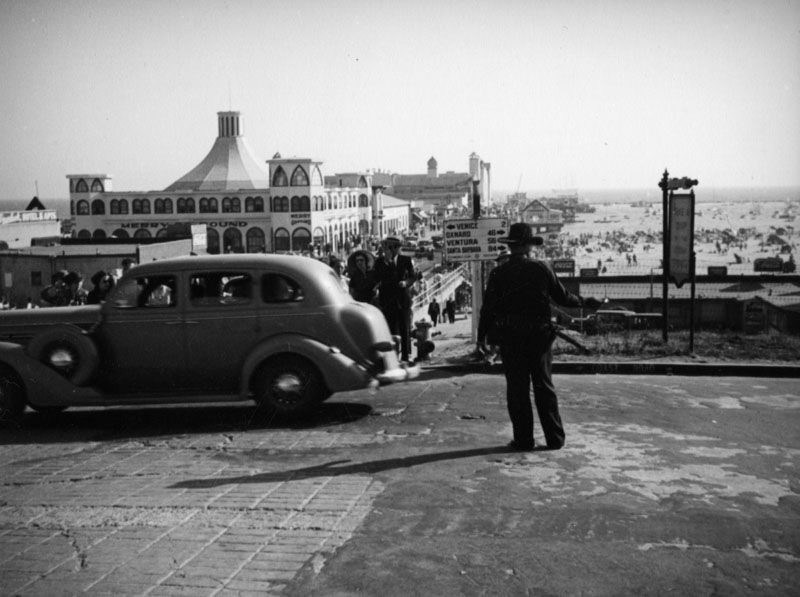 |
|
| (ca. 1939)* – View showing a crowded Santa Monica Pier with the Looff Hippodrome seen in the upper-left and the La Monica Ballroom in the distance. |
Historical Notes From 1939 to 1958, the Santa Monica Pier underwent several significant changes, including the sale and replacement of its iconic carousel, the conversion of the La Monica Ballroom into a roller skating rink, and shifts in ownership and management. These changes were indicative of broader social and economic trends and set the stage for future redevelopment efforts that would eventually restore the pier to its former glory. |
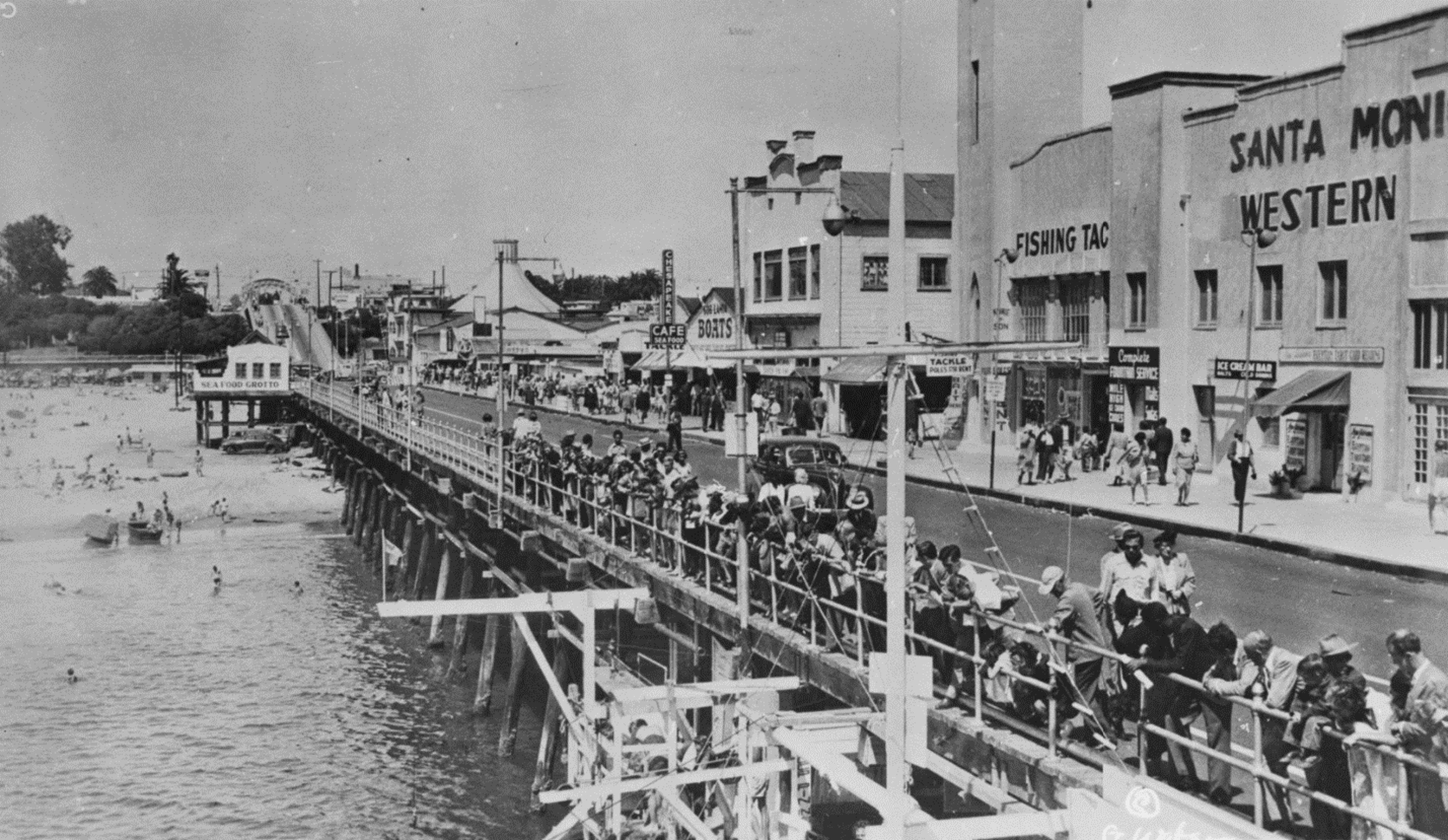 |
|
| (1940s)* – View of Santa Monica Pier, with people peering over the railing in the foreground and others walking in front of shops across the pier. Signs for stores on the pier include "Sea Food Grotto," "Chesapeake Cafe," "Fishing Tackle," and "Ice Cream Bar." |
Historical Notes Despite wartime restrictions, visitors continued to flock to the pier whenever possible, and its festive atmosphere endured even during difficult times. The 1940s were a transformative decade for the Santa Monica Pier, marked by significant events and changes. During World War II, the La Monica Ballroom was repurposed for military use, serving as a shelter and hosting dances for troops. Maintenance of the pier was minimal due to material and manpower shortages. Post-war, the pier experienced a revival in entertainment, notably with Spade Cooley's televised weekly show from the La Monica Ballroom in 1948, drawing renewed attention and visitors. Despite wartime challenges, the pier remained a popular leisure destination. Structural improvements included the Works Progress Administration (WPA) building a bridge over Pacific Coast Highway in 1940 and the erection of the iconic arched sign at the foot of Colorado Avenue. |
 |
|
| (1940s)* - View looking toward the shoreline from the Santa Monica Pier showing cars parked and people walking. The Deauville Club can be seen in the distance. |
Historical Notes Parking at the end of the Santa Monica Pier ceased in 1975. This decision was part of broader efforts to preserve the pier and improve safety and accessibility for visitors. The cessation of parking on the pier itself marked a shift towards prioritizing pedestrian access and the overall visitor experience, which has continued to evolve over the years. |
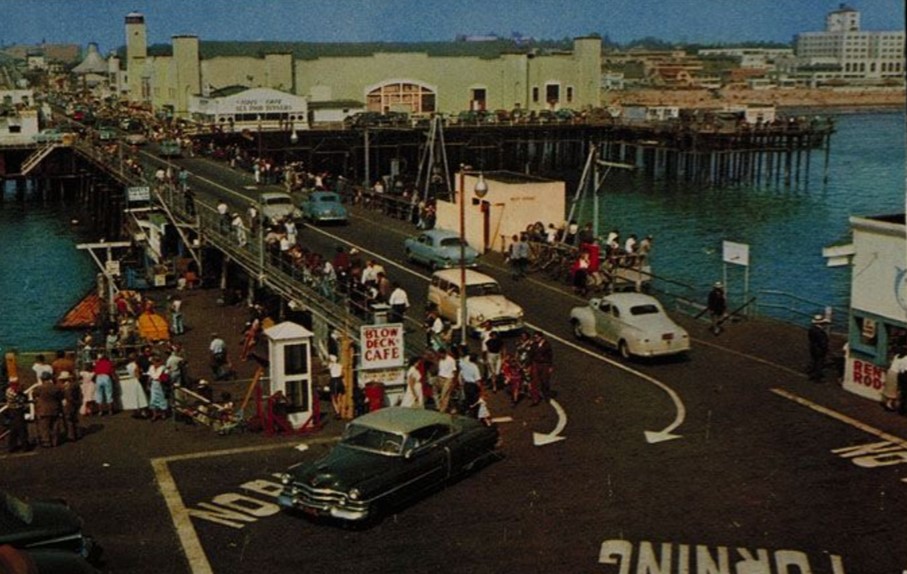 |
|
| (1950s)* - Postcard view showing Santa Monica Pier. |
Historical Notes The 1950s were a transitional period for the Santa Monica Pier, marked by significant changes and challenges. In 1953, the City of Santa Monica took over ownership of the Looff Pier, leasing it to a private operator. The La Monica Ballroom, showing signs of wear, was converted into a roller skating rink in 1958, reflecting shifting entertainment preferences. The pier arcade was revitalized by a new family, becoming a long-running attraction. Despite efforts to maintain the pier, it faced dilapidation and economic struggles, with declining popularity due to competition from other venues. However, the pier remained a beloved community hub and a site of historical significance, setting the stage for future preservation and redevelopment efforts. |
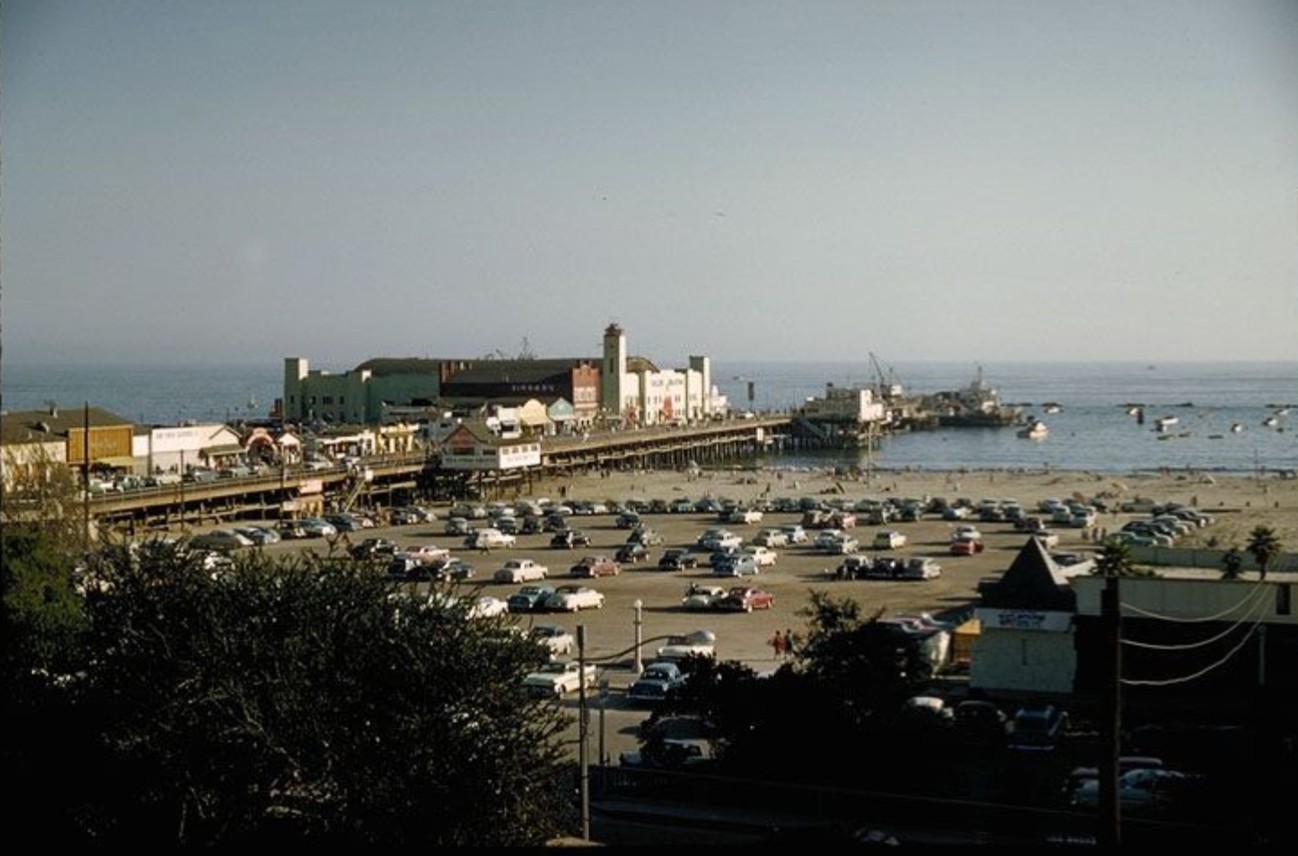 |
|
| (1958)* - Looking down toward the Santa Monica Pier with the La Monica Ballroom during its final years of operation. The Deauville Club appears at lower right, while the beach parking lot below is filled with classic 1950s automobiles lined up beneath the late afternoon sun. |
Historical Notes By 1958, the Santa Monica Pier was showing the effects of age and neglect, as shifting leisure patterns and competition from newer attractions drew visitors elsewhere. The once-grand La Monica Ballroom, opened in 1924 as one of the largest dance halls on the West Coast, was nearing the end of its life as a public venue and would soon be converted into a roller skating rink. It was ultimately demolished in 1963. The Deauville Club, seen at lower right, remained a glamorous but fading reminder of the pier’s early resort era until it was destroyed by fire in 1964. The sunlit beach parking lot and fading pastel tones of the structures capture the last years of postwar optimism before the pier entered a period of decline. Within a decade, portions of the pier would be threatened with demolition—sparking the preservation movement that ultimately saved it. |
 |
|
| (1958)* - Looking down the access ramp to the Santa Monica Pier with the Merry-Go-Round in the left foreground. |
Historical Notes The access ramp to the Santa Monica Pier, constructed as part of the 1939 Colorado Grade Separation Project, was completed on June 12, 1940. This project aimed to improve traffic flow between the Pacific Coast Highway and Santa Monica streets by providing direct access from Colorado Avenue to the pier, replacing the old access route. To highlight the new route, the Santa Monica Pier Business Men’s Association unveiled a neon sign reading "Santa Monica Yacht Harbor – Sport Fishing – Boating – Cafes" on June 17, 1941. |
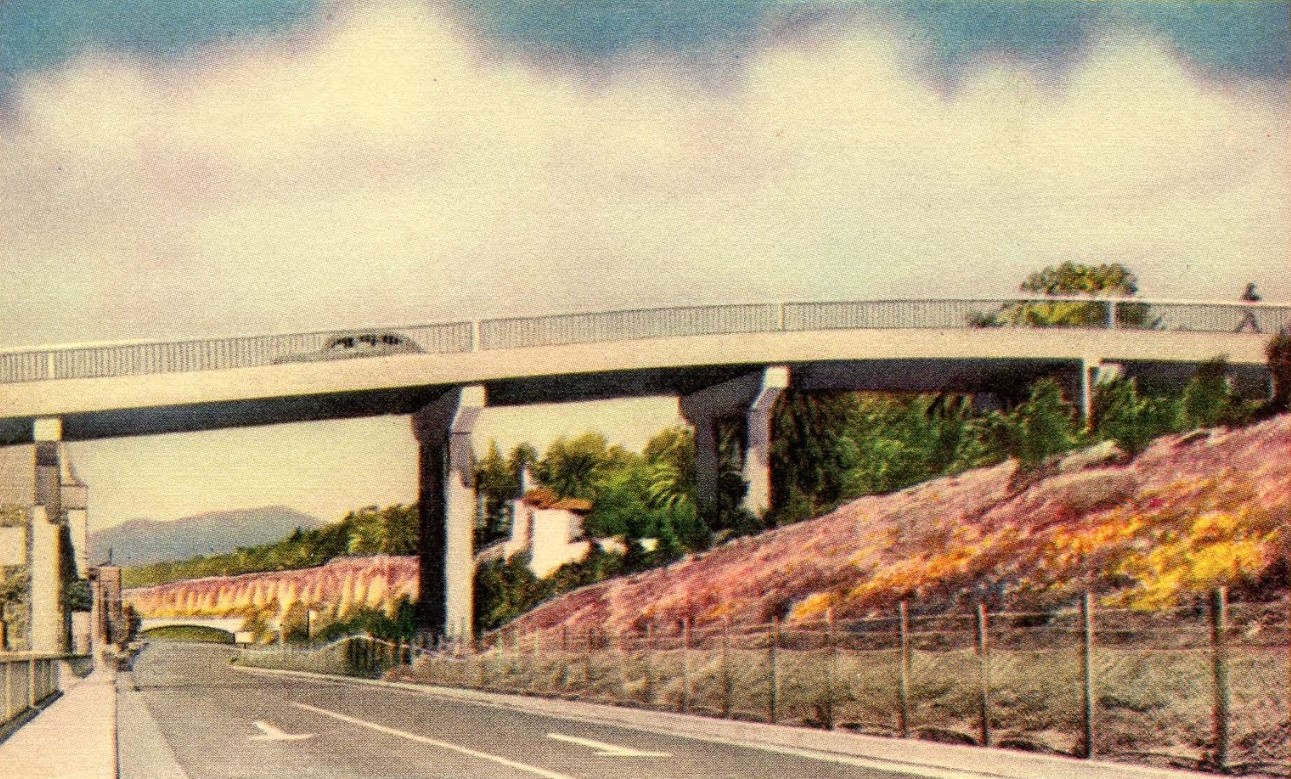 |
|
| (1940s)^ - Postcard view looking northwest showing the Colorado Avenue access ramp to the Santa Monica Municipal Pier. The overpass was opened in 1940. |
Historical Notes The bridge and entry gate to Santa Monica Pier were built in 1939 by the federal Works Project Administration, and replaced the former grade connection. |
Then and Now
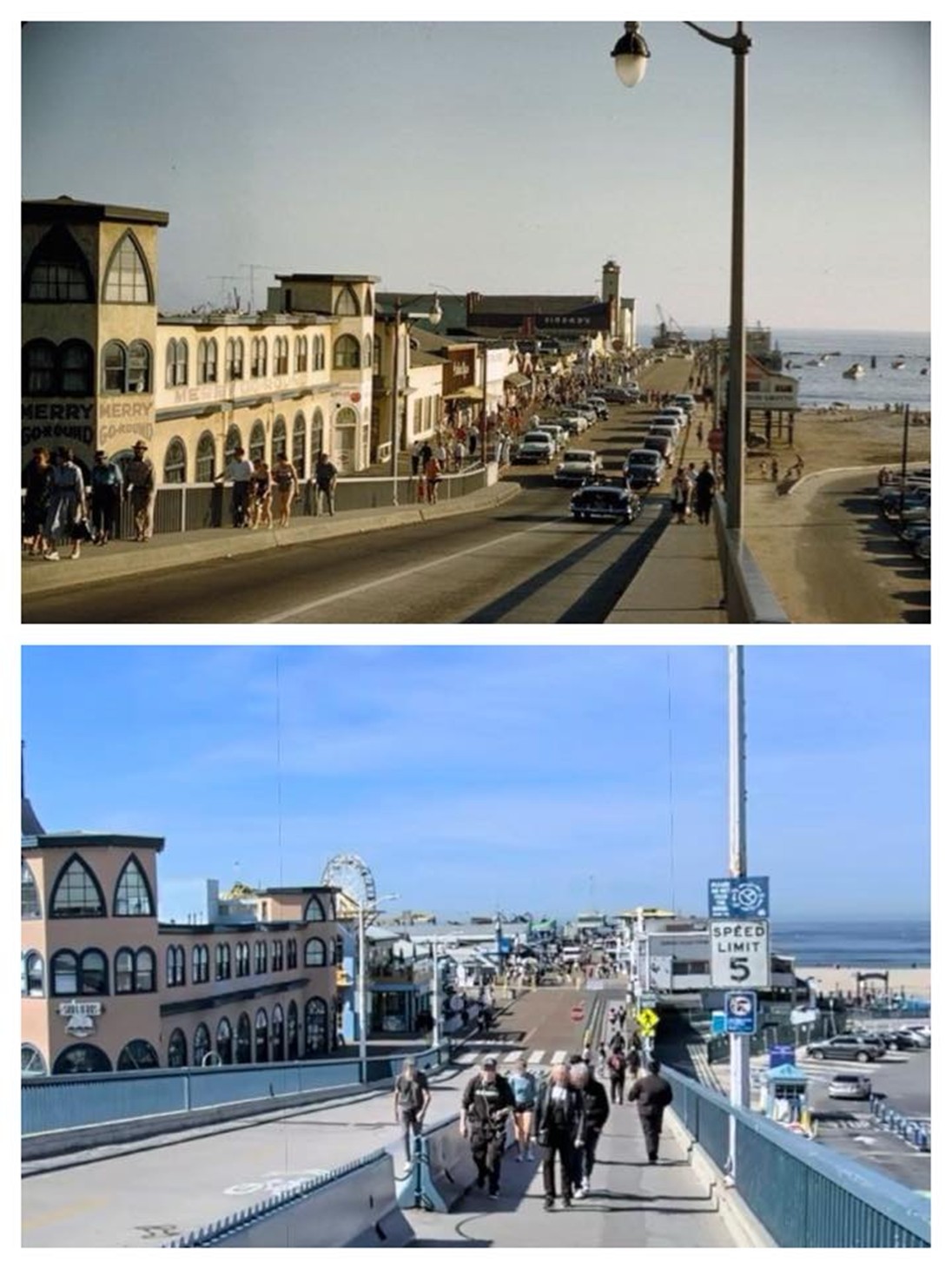 |
|
| (1958 vs. 2018)* – Then & Now: Santa Monica Pier. Photo comparison by Trey Callaway. |
Historical Notes The 1958 view shows the Santa Monica Pier near the end of its postwar years, when landmarks like the La Monica Ballroom and Deauville Club still stood but were beginning to fade. By that time, the pier was showing signs of age and facing competition from newer attractions along the coast. The 2018 image shows how the pier was brought back to life through decades of community effort and preservation. The restored Hippodrome, new amusement rides, and bustling walkways reflect how the pier has remained a symbol of Santa Monica’s spirit—linking the city’s colorful past with its vibrant present. |
* * * * * |
Santa Monica Pier Sign
.jpg) |
|
| (1941)^ - Image of a line of people waving while standing under a neon sign for the Santa Monica Pier. The sign reads "Santa Monica Yacht Harbor Sport Fishing and Boating Cafes." |
Historical Notes In 1941 the famous neon sign at the top of the Pier ramp was installed by the Santa Monica Pier Businessmen’s Association to celebrate the opening of the newly-built ramp. It is an internationally-recognized tourist destination and a symbol of the Southern California lifestyle. |
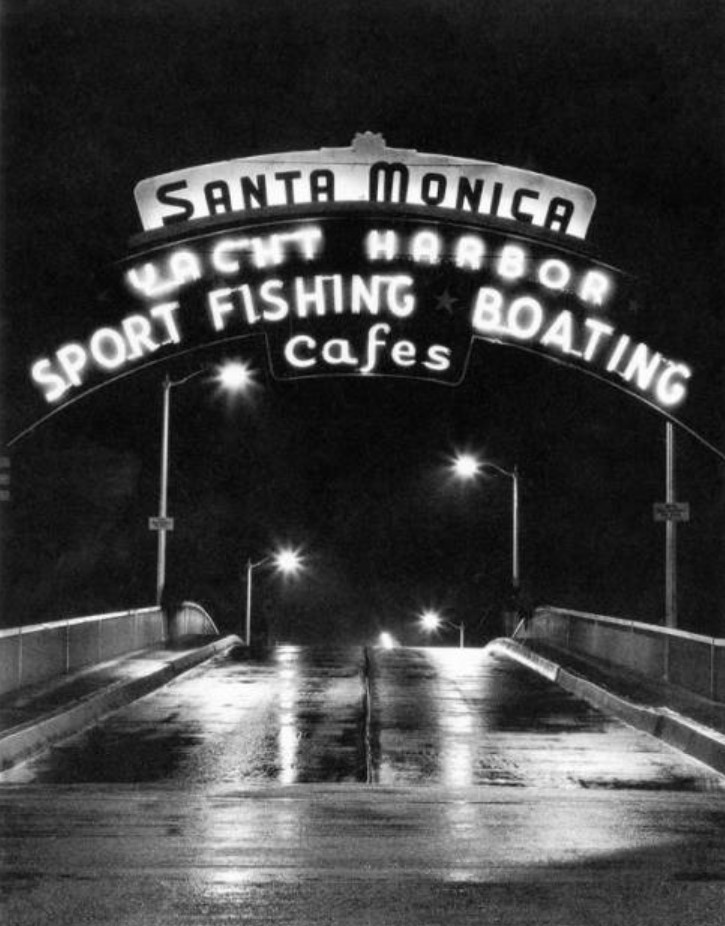 |
|
| (n.d.)#^ - Nigth view of the Santa Monica Pier neon sign (installed in 1941). |
Historical Notes The iconic Santa Monica Pier sign, commissioned by the Santa Monica Businessmen's Association in 1940, was designed by Fred Lehman in the Streamline Moderne style and unveiled in 1941. Originally intended to promote the Pier as a tourist destination, its neon lights were extinguished during World War II. Despite changes and repairs, including a relocation in the 1950s, the sign retains much of its original structure. In 2012, it was designated a historic landmark by the City of Santa Monica, ensuring its preservation. |
Then and Now
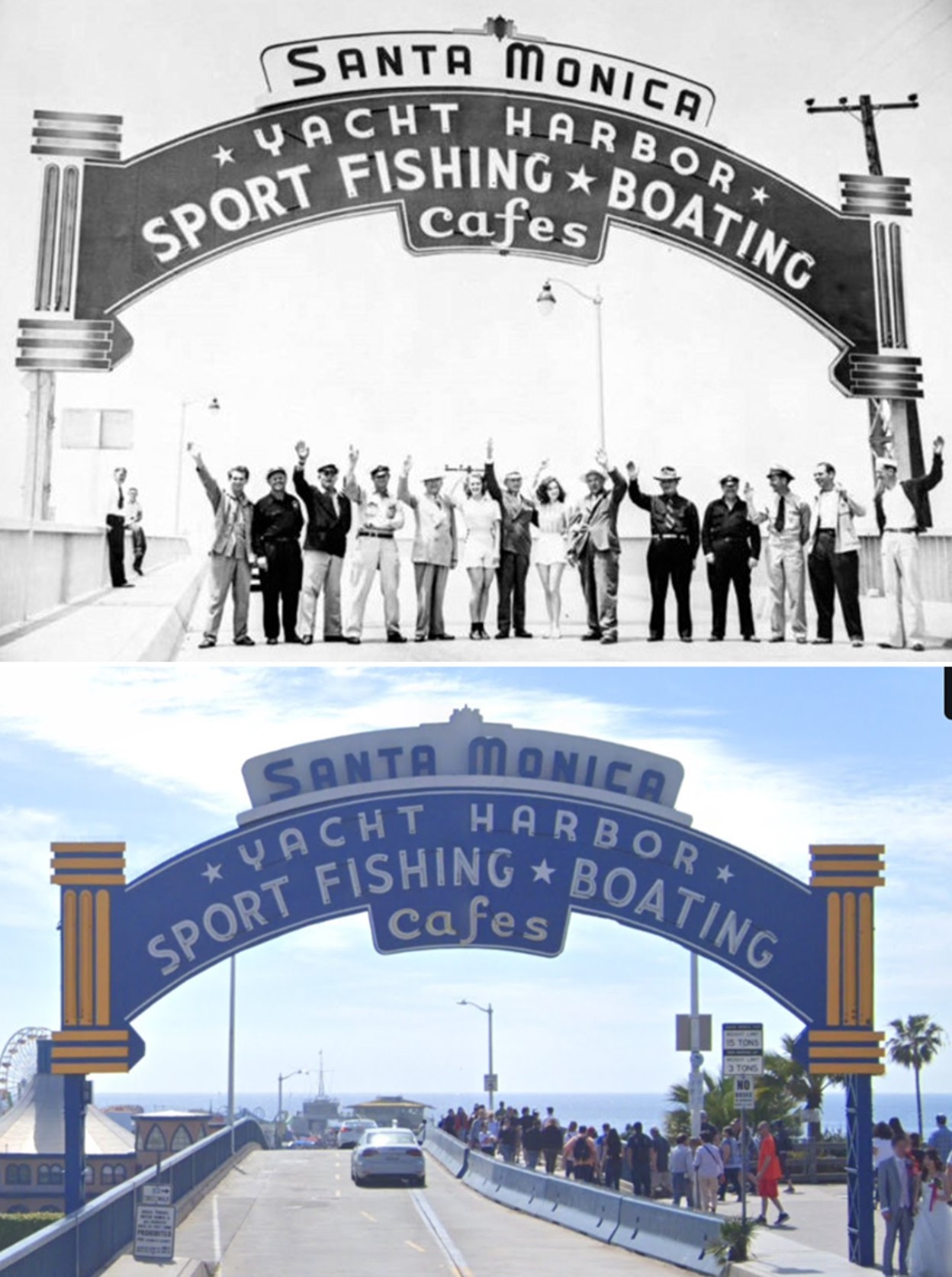 |
|
| (1941 vs 2019)* - Santa Monica Pier Sign, installed in 1941. Photo comparison by Jack Feldman. |
* * * * * |
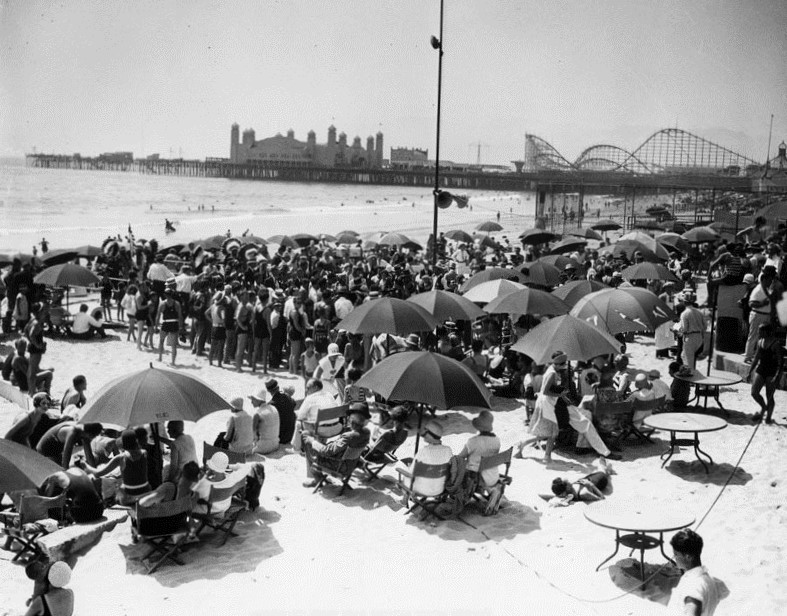 |
|
| (1930s)* - Members of one of the private clubs at a beach party; in the background is the Santa Monica Pier. |
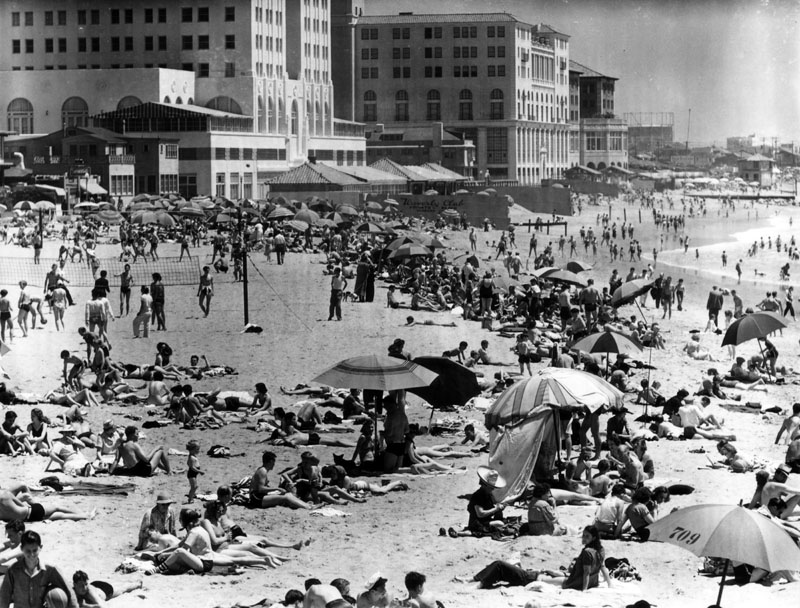 |
|
| (1938)* - Sunbathers, beach volleyball players, and umbrellas crowd the beach before a line of private beach clubs interrupts their spread. A sign on the first wall, center, reads "Waverly Club, private beach, members only". The eight story building formerly was Breakers Beach Club, 1725 Promenade in Santa Monica. The next six story building is the Jonathan Club, formerly the Edgewater Beach Club, 1855 Promenade. |
Historical Notes The Breakers Beach Club opened in 1926. The 8-story building had over 300 sleeping apartments and a full complement of amenities for guests. As ownership changed, it was also known as Club Lido. Eventually the club transitioned into a hotel, used to house military personnel during World War II. Later it was also known as the Chase Hotel. The structure became an apartment building known as the Sea Castle Apartments in the 1960s. The building was completely destroyed by fire in 1996. |
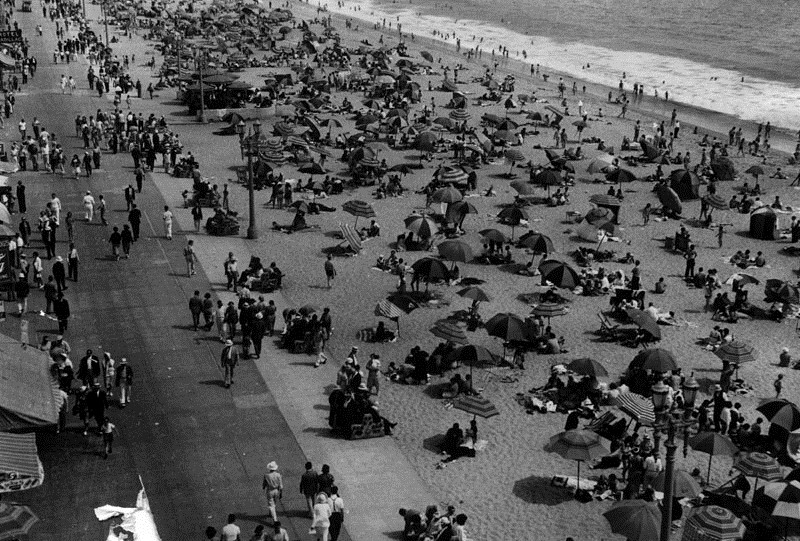 |
|
| (1939)* - Miles of public beach serve millions of recreation-seekers along the Pacific shores of Los Angeles County. This scene is between Ocean Park and Venice on June 26, 1939. |
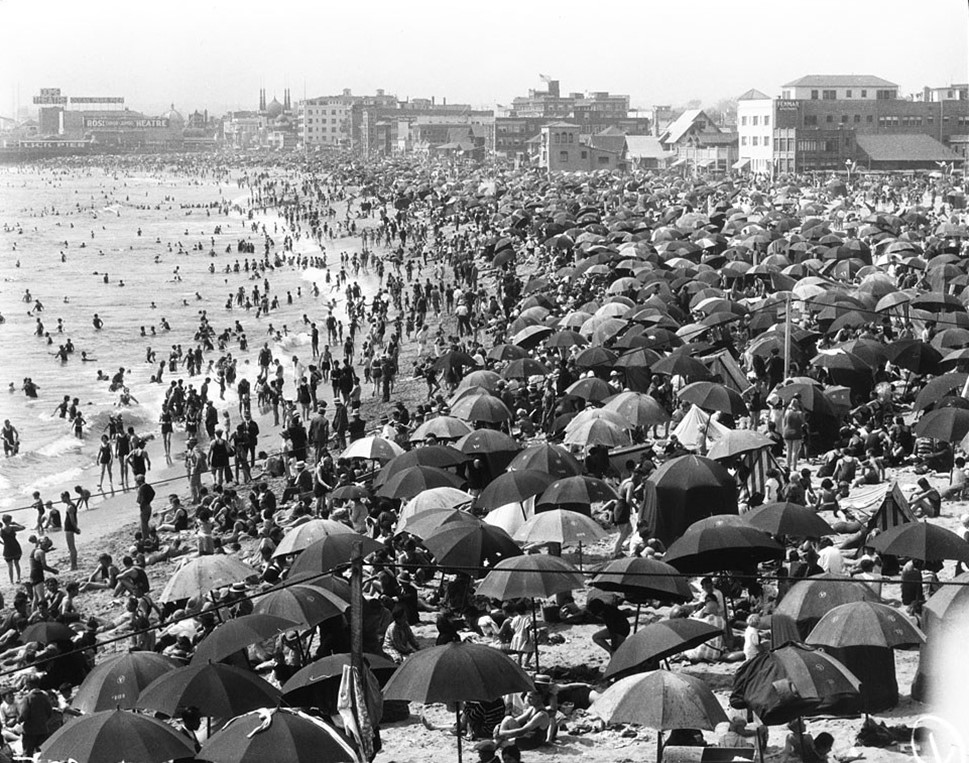 |
|
| (1930s)* - Crowded day at Ocean Park beach in Santa Monica. |
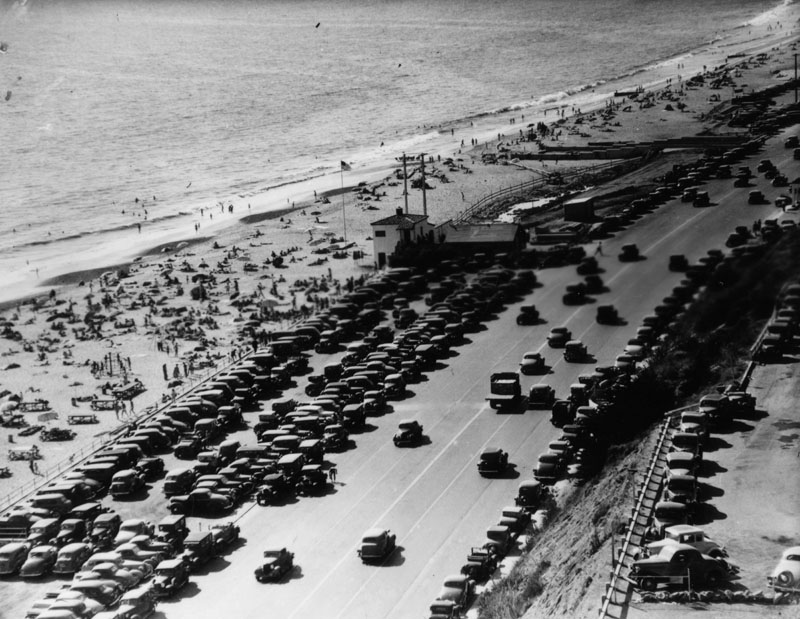 |
|
| (1939)* - Not a parking space to be had. Another busy day at the beach in Santa Monica. |
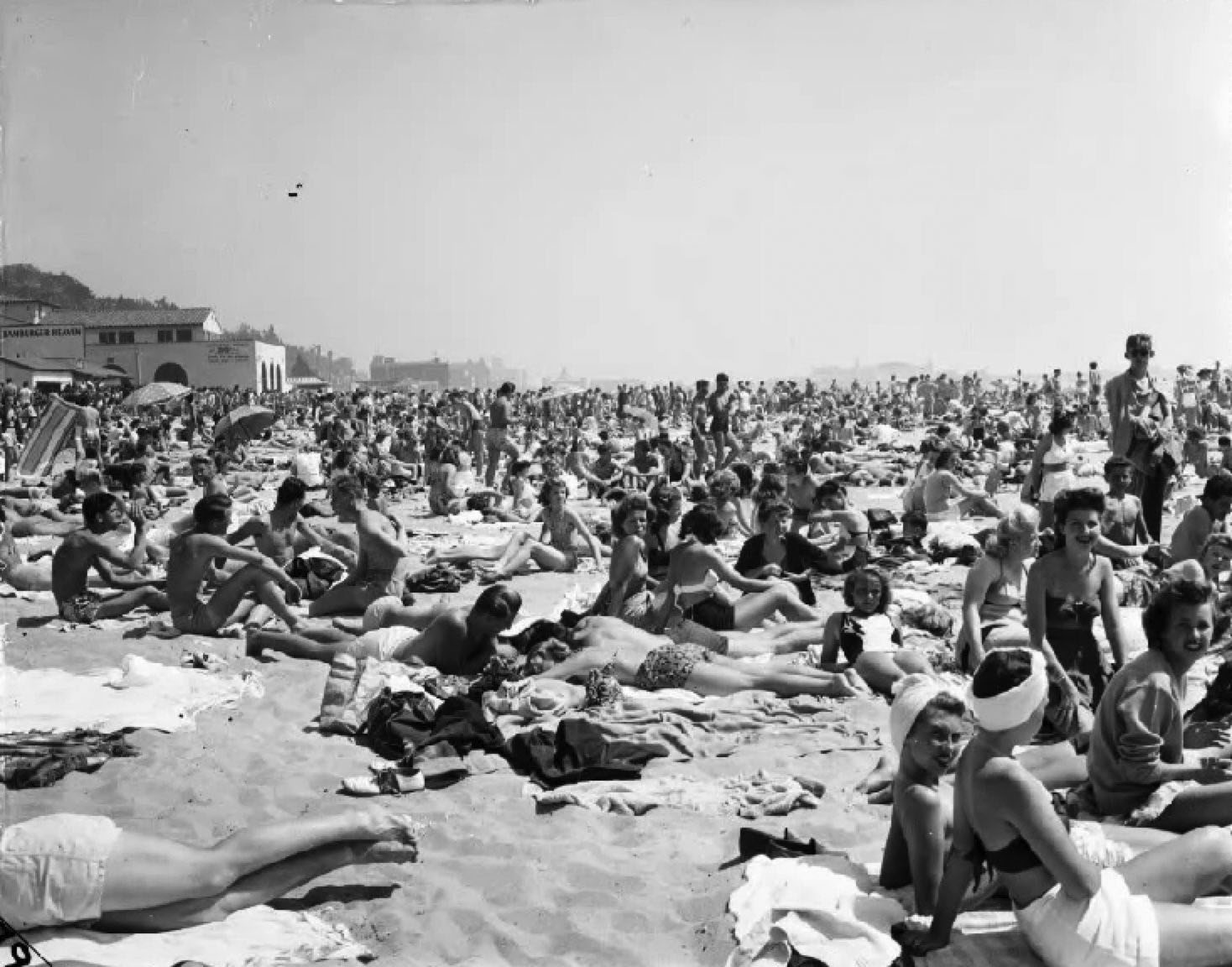 |
|
| (1945)* – Santa Monica Beach…’This is how we Winter’. |
* * * * * |
Beach Volleyball
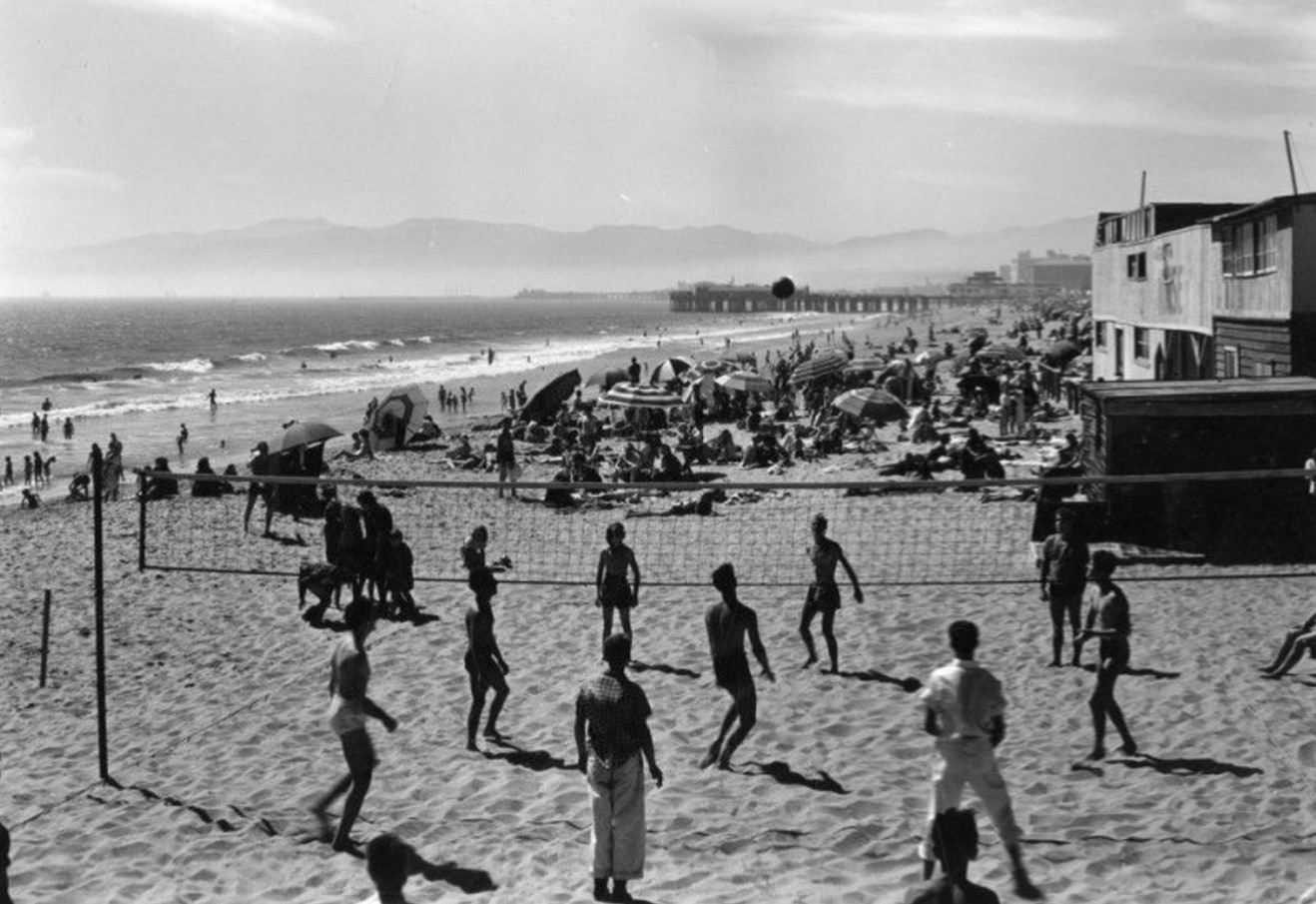 |
|
| (ca. 1930)* - A group of people play volleyball on Santa Monica beach. In the background, crowds of people relax on the beach and under umbrellas, while the pier is visible in the distance. |
Historical Notes Beach volleyball has deep roots in Santa Monica, often regarded as the birthplace of the sport. The origins of beach volleyball can be traced back to the 1920s when the city added new jetties, creating more space for public recreation. This led to the installation of public and private volleyball nets along the coast, setting the stage for the sport's evolution. In the 1930s, beach volleyball was primarily played by men. |
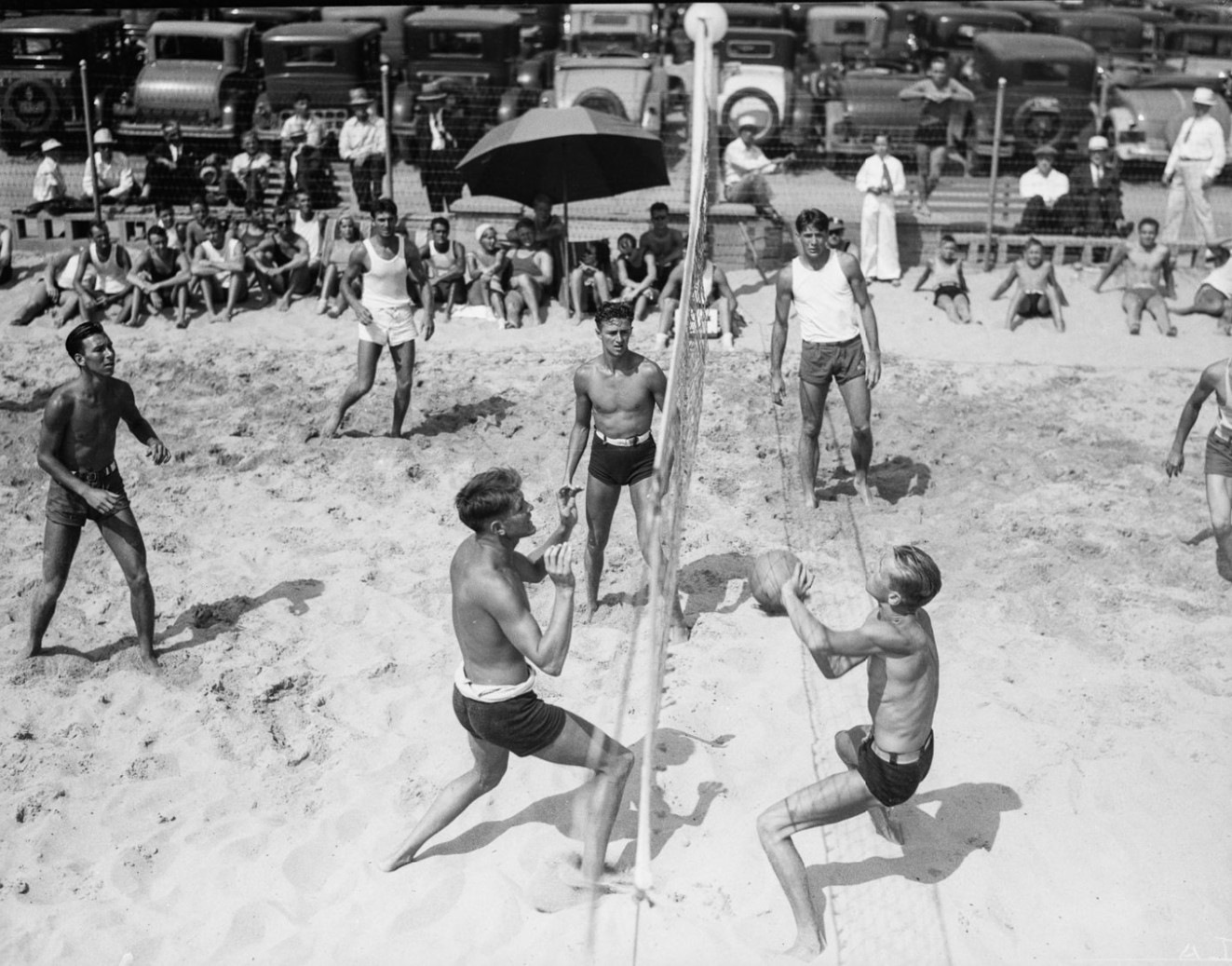 |
|
| (1930s)* – A beach volleyball game in Santa Monica draws a crowd, with a parking lot full of automobiles visible in the background. Photo: Ernest Marquez Collection |
Historical Notes Volleyball became an official Olympic event at the 1964 Summer Olympics in Tokyo. This marked the debut of both men's and women's volleyball competitions at the Games. The sport had previously been featured as a demonstration event at the 1924 Summer Olympics in Paris, but it took another 40 years before it was officially included in the Olympic program. |
* * * * * |
Santa Monica Lifeguard Service
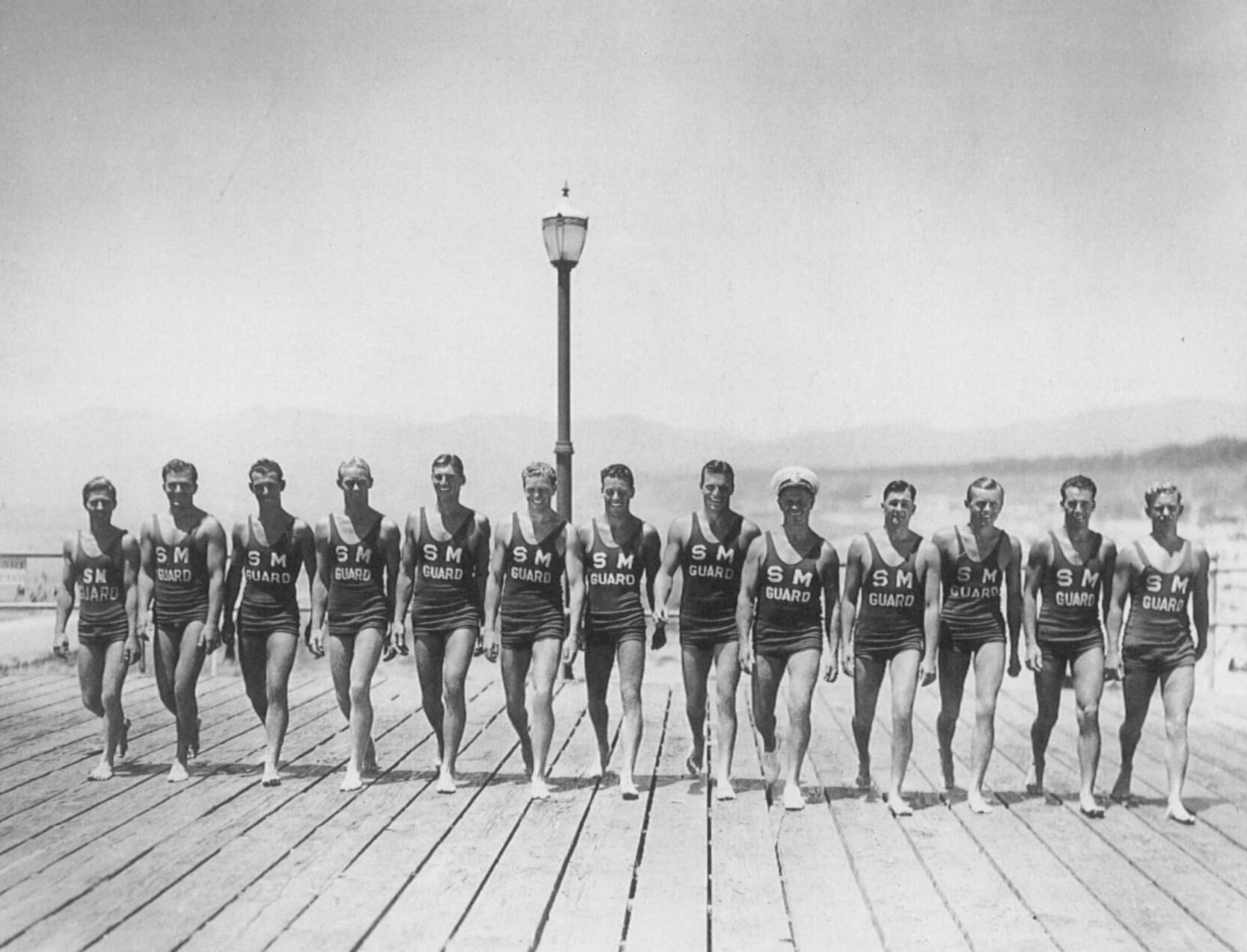 |
|
| (1934)* – Lifeguards march in line in front of Santa Monica Pier. |
Historical Notes The Santa Monica Lifeguard Service was founded in the 1920’s under Captain George Watkins. In 1934, it established a home on the Santa Monica Pier in the former Bowling and Billiards Building. A year later they moved to the La Monica Ballroom and, while there, operated an aquarium. |
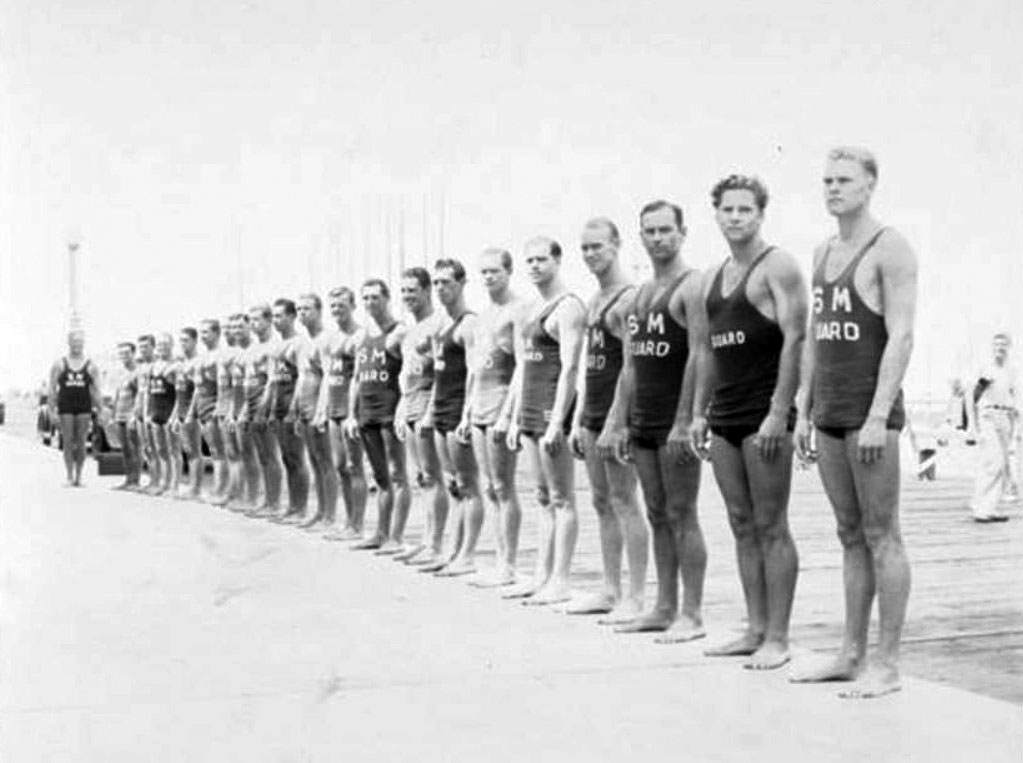 |
|
| (1935)* - Santa Monica Lifeguards line up at the edge of Santa Monica Pier. |
Historical Notes In the early years of the lifeguard service, it attracted a following of Hollywood heavyweights and swimming champions. Duke Kahanamoku of Hawaii brought surfing to Santa Monica. Johnny Weismuller was made an honorary lifeguard, since so many of the team would stunt double for him in the Tarzan films. Gary Cooper was a fan, along with Marion Davies, Darryl Zanuck and Cary Grant, who kept houses by the beach. The lifeguard service expanded along with the explosion of coastal real estate development in the early part of the 20th century. Abbot Kinney hired lifeguards to patrol the beach to help sell his beachfront properties. Kinney’s wife was responsible for raising funds to purchase the first lifeguard boat in Venice and organized lifeguards into a crew. Back then, lifeguards would carry long metal cans – or rescue tubes (invented by a Santa Monica lifeguard) on rescues. Today, the tubes are made of plastic polymers, but the essentials of the job remain unchanged – vigilant eyes on the surf, anticipating problems and steering crowds away from dangerous behaviors, like drinking.^ In the mid-1930s the Santa Monica Lifeguard Headquarters was located in the La Monica Ballroom Building located on the pier. In the late 1950s a New Headquarters Building would be built at 1642 Ocean Front Walk, which is still in use today. |
* * * * * |
Muscle Beach
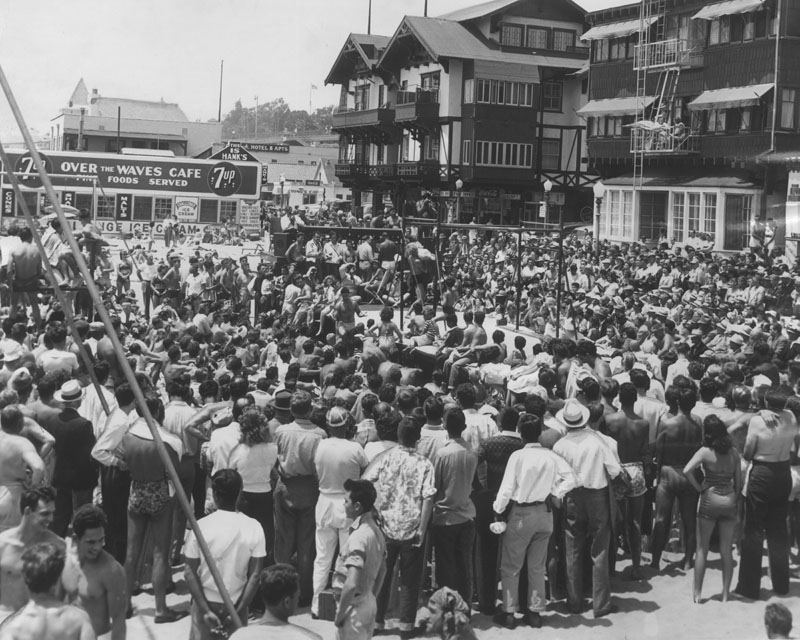 |
|
| (1948)* - View of the original Muscle Beach, located south of the Santa Monica pier, at a long, wooden platform constructed by the Works Progress Administration. |
Historical Notes Muscle Beach is where the body was celebrated in its sunbaked glory as young men (and more than a few women) showed off their physical prowess by performing acrobatic and gymnastic routines. The original Muscle Beach disappeared in the late 1950s; the modern-day version is now located in Venice Beach. |
 |
|
| (1948)* - Mr. Muscles contestant performing acrobatic move as crowd watches at Muscle Beach in Santa Monica. |
Historical Notes Beginning in 1934, the fantastic gymnastics shows held here made the site a major attraction and center of the international fitness movement led by Jack LaLanne, Steve Reeves and Joe Gold. |
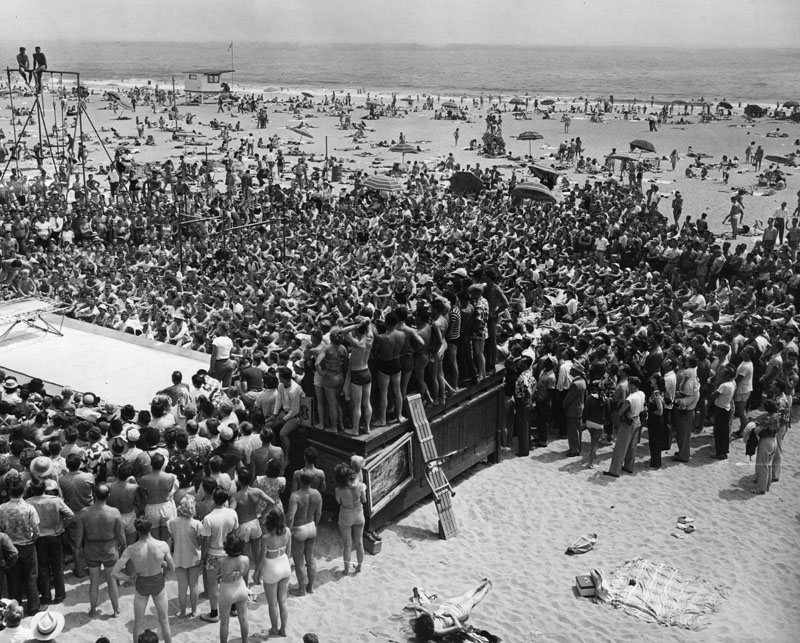 |
|
| (1951)* - Two thousand people watch acrobatics during a program at which Downey dairyman Ken Cameron, 23, was chosen "Mr. Muscle Beach of 1951." He won over 15 others in the contest sponsored by the Santa Monica Recreation Department on July 4, 1951. |
Historical Notes Acrobats, gymnasts and bodybuilders performed before large crowds, which often included Jayne Mansfield and Mae West. Santa Monica's Muscle Beach reached the height of its popularity in the 1940s before moving to its current location in Venice Beach in 1959. |
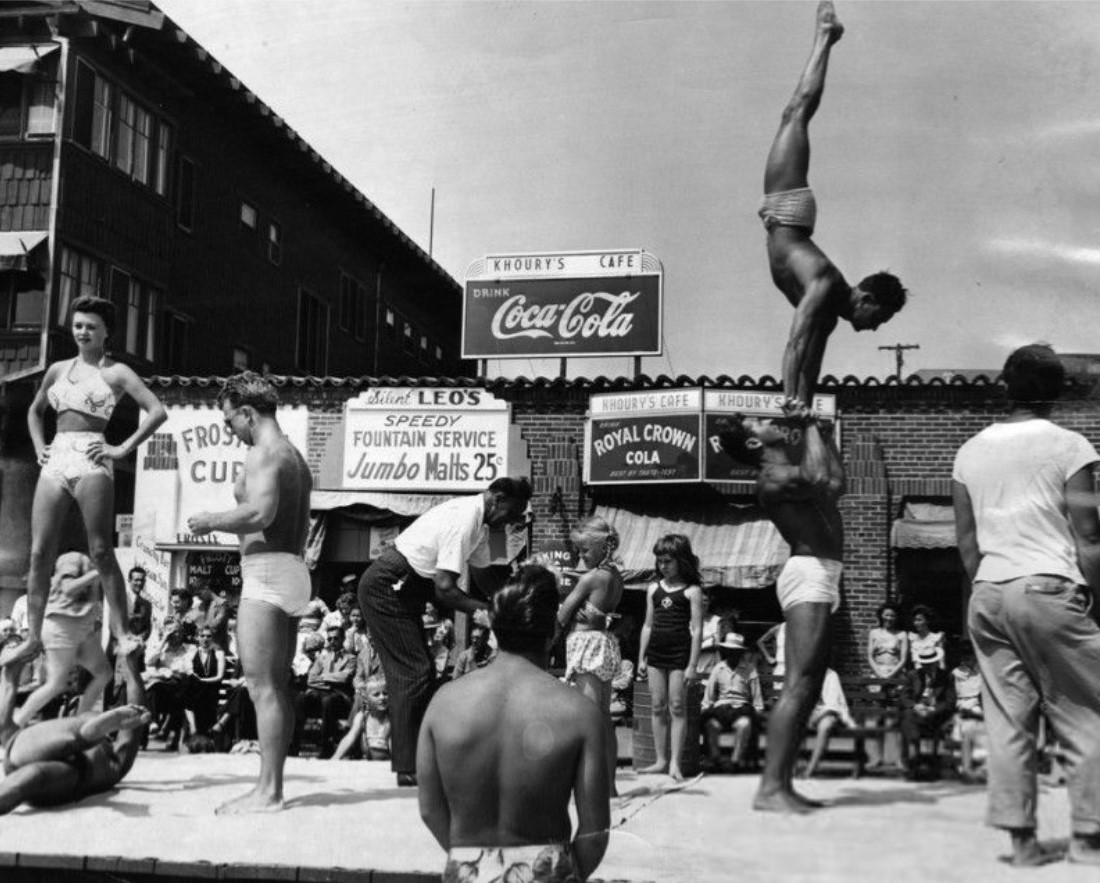 |
|
| (1948)* - Entertainment aplenty, Muscle Beach. |
Historical Notes The 1940 opening of the first of an eventual nationwide chain of weightlifting gyms by famed pioneer gym chain operator, Vic Tanny, only two city blocks from Muscle Beach in Santa Monica is commonly considered a key contributor to the increasing attraction of bodybuilders and strength lifters to Muscle Beach from across the nation. By the 1950s Muscle Beach established worldwide fame and helped to popularize and bring legitimacy to physical culture with acrobatics and bodybuilding and contribute to a nationwide health and fitness movement continuing into the 21st century. |
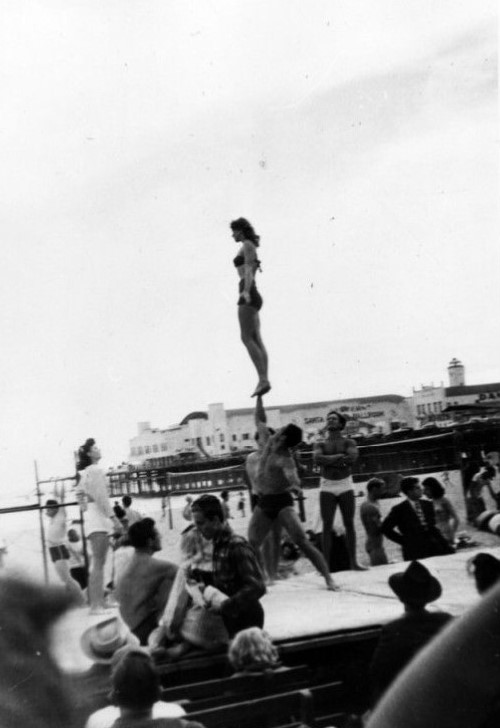 |
|
| (ca. 1949)* - Acrobats on Muscle Beach. |
Historical Notes Male and female gymnasts regularly put on public shows, dazzling beachgoers with their displays of strength and balance. |
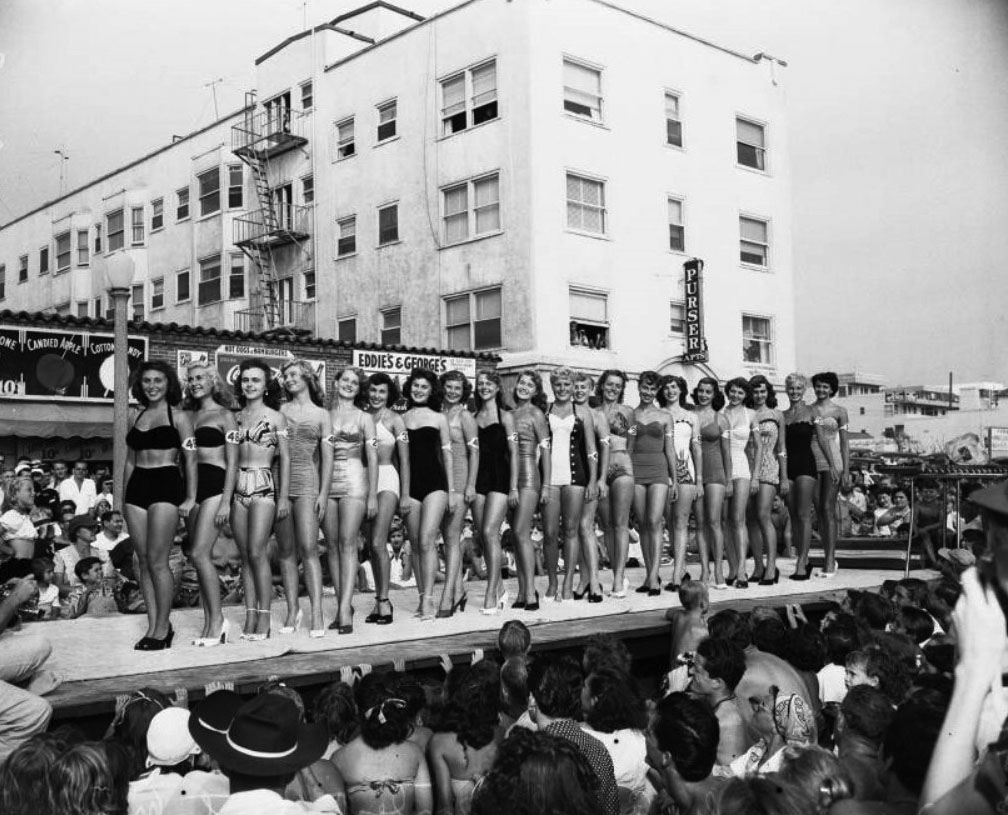 |
|
| (1951)* - Miss Muscle Beach contest with the Purser Apartments in the background. |
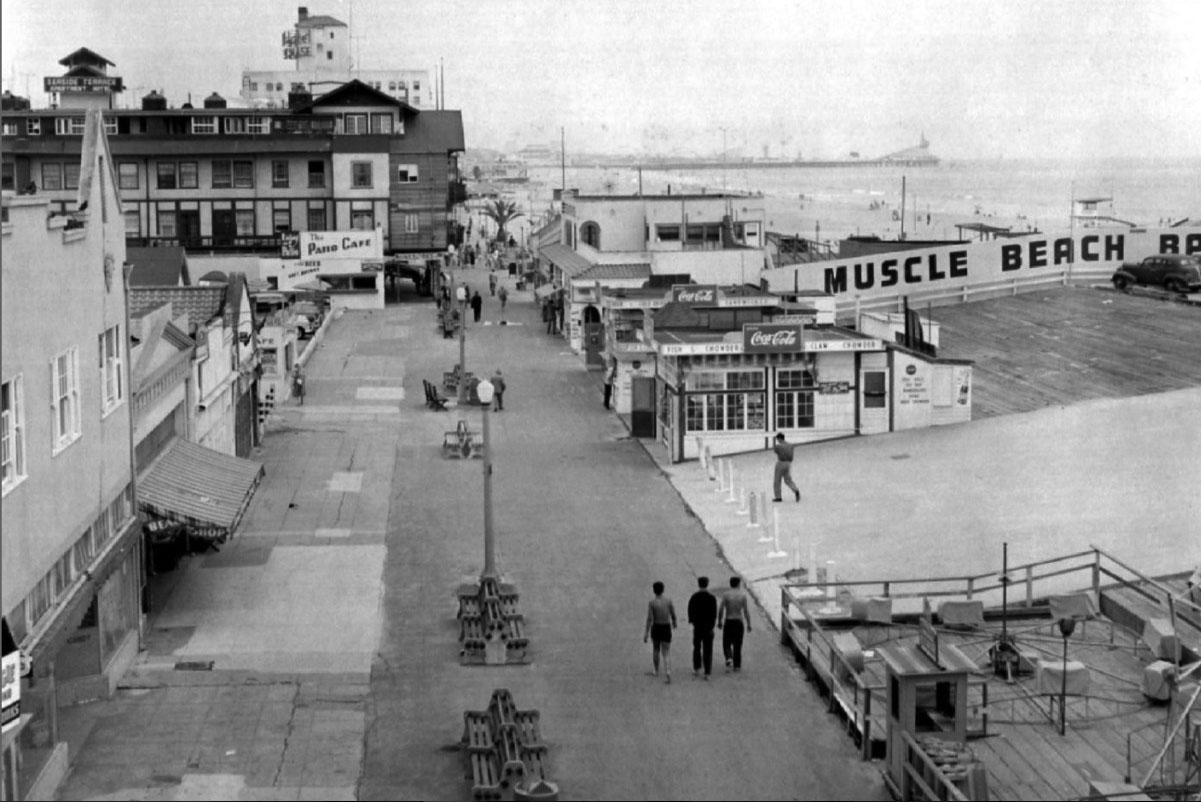 |
|
| (1954)* - View showing a not so crowded Muscle Beach. The original Muscle Beach disappeared in the late 1950s; the modern-day version is now located in Venice Beach. |
* * * * * |
View From the Top
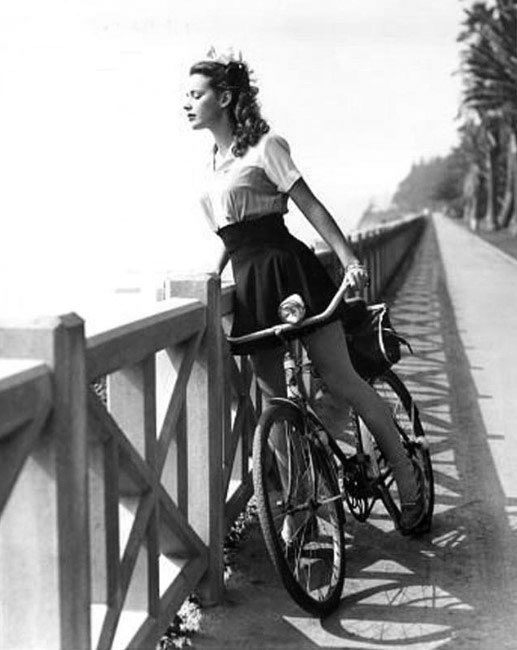 |
|
| (1943)* – Actress Susan Peters Looking down at Santa Monica beach from the palisades. |
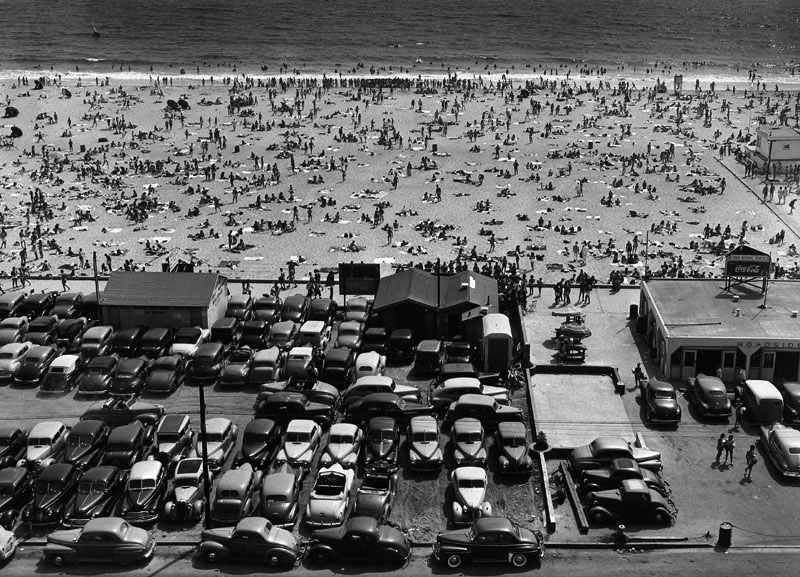 |
|
| (1949)**^ - View of the beach in Santa Monica on a summer day. |
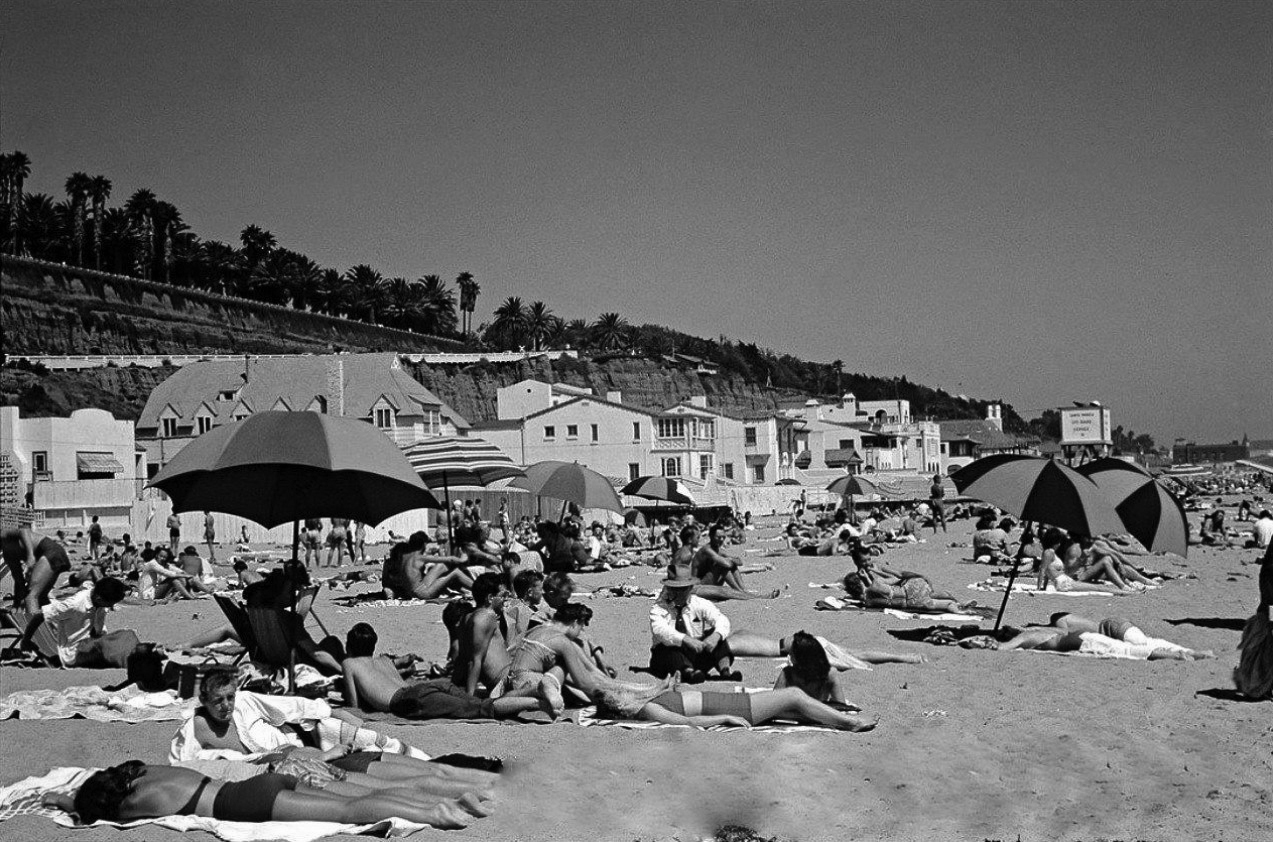 |
|
| (1940s)^ - Closer view showing sunbathers enjoying a day at Santa Monica Beach, with the California Incline and Palisades Park in the background. |
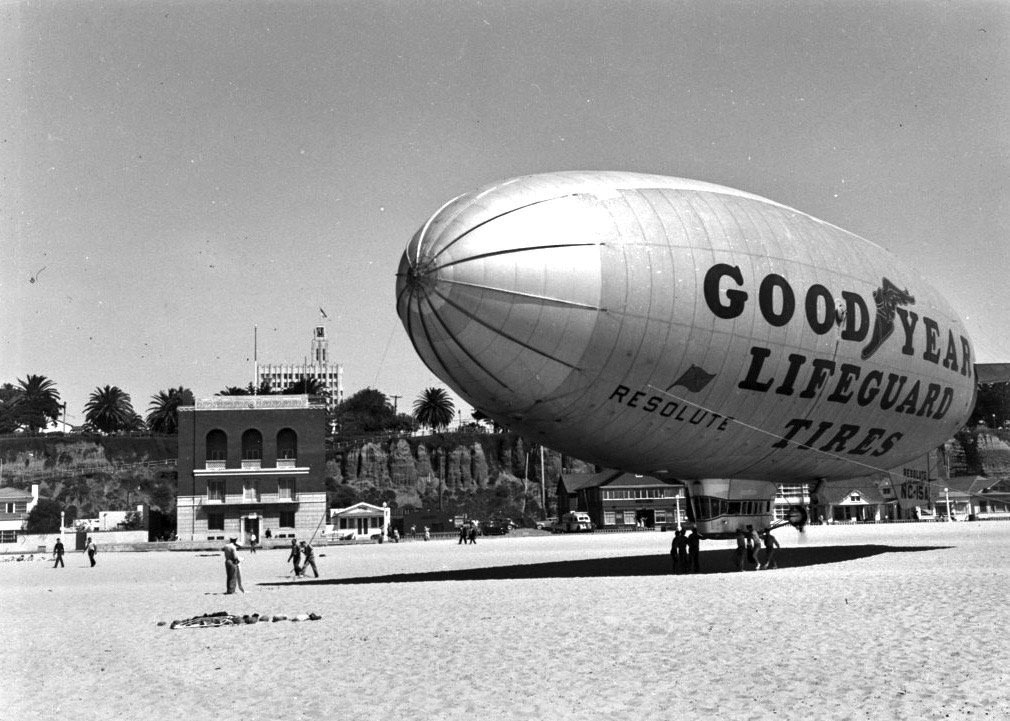 |
|
| (1940)* – Goodyear blimp, ‘Resolute’, lands on the sand at Santa Monica Beach. The Cities Guaranty Clock Tower Building (Crocker Bank Building) can be seen in the background. |
Historical Notes That building with the arched windows to the left of the blimp, was the old armory building that became an officers club during WWII and for a time after. By the late 50s, Synanon took it over. That was 'the Synanon house on the beach,' throughout the 60s, prior to their moving into Casa del Mar. |
* * * * * |
Along the Santa Monica Bluffs: PCH Through Time
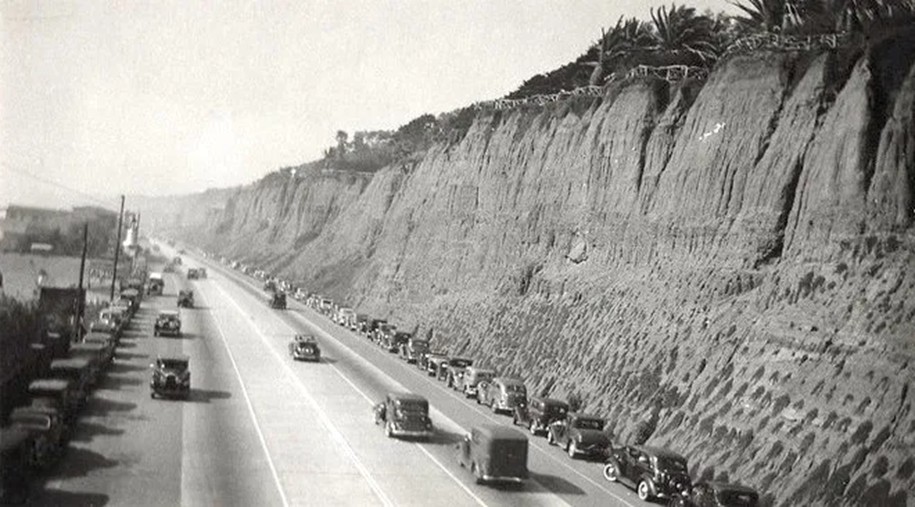 |
|
| (ca. 1940)* - Looking north along Pacific Coast Highway (U.S. 101A) from the base of the Palisades cliffs in Santa Monica, with roadway, bluffs, and early coastal development visible. |
Historical Notes By 1940, the highway running beneath the Santa Monica bluffs was officially designated U.S. 101 Alternate, or 101A. The “A” signified its role as the scenic option to inland U.S. 101, which crossed the San Fernando Valley and Ventura via the Cahuenga Pass. This coastal road had earlier roots as the Theodore Roosevelt Highway, dedicated in 1929. In 1964, a statewide renumbering converted U.S. 101A into California State Route 1, more commonly known today as the Pacific Coast Highway (PCH). |
 |
|
| (1949)* - The sandstone cliffs of Palisades Park rise at right while small roadside businesses line the highway at left. |
Historical Notes In 1949, this section of roadway was still marked U.S. 101A. The designation drew tourists and motorists who preferred a drive beside the ocean. Businesses such as motor courts, restaurants, and filling stations clustered along the shoulder to serve them. When California renumbered its highways in 1964, U.S. 101A was retired and this stretch was redesignated State Route 1. From that point forward, the familiar name Pacific Coast Highway took hold permanently. |
 |
|
| (1940s)* - View overlooking Pacific Coast Highway. Palisades Park is above the cliffs on the left, the Santa Monica beach is on the right, La Monica Ballroom is on the pier in the distance, and a pedestrian bridge spans the highway in the center. |
Historical Notes Beach access was a constant challenge once the coastal highway opened in 1927. Wooden stairs and crossings gave way to concrete steps and an early overpass. By 1935, the city built the more substantial pedestrian bridge seen here, which allowed residents and visitors to reach the sand safely despite heavier automobile traffic. The La Monica Ballroom on the pier, opened in 1924, was a landmark of this era, hosting dances, exhibitions, and community events until it closed in 1962 and was demolished the following year. |
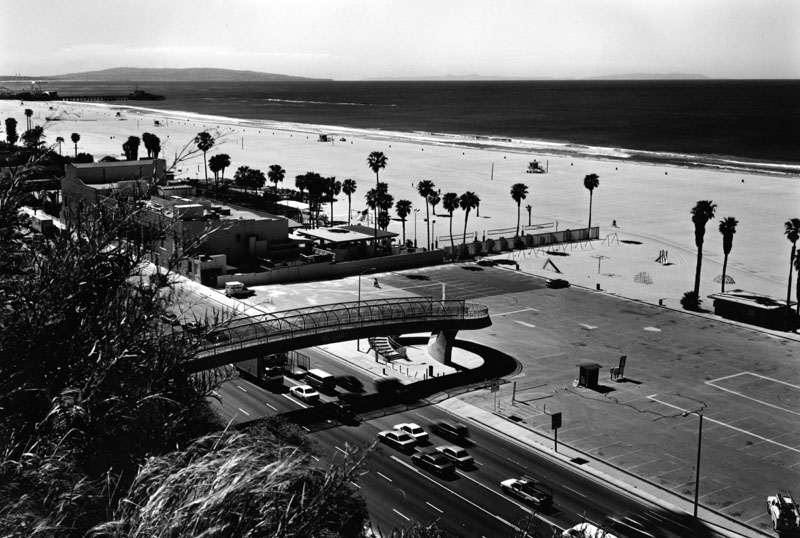 |
|
| (1997)* - Looking over the Pacific Coast Highway from the Santa Monica bluffs, with the Jonathan Club, the pier, and the Palos Verdes Peninsula visible in the upper left. A steady stream of cars moves along PCH beneath the pedestrian bridge while the beach parking lot on the right sits empty. |
Historical Notes By the late 20th century, the Pacific Coast Highway was firmly established as both a scenic drive and a vital traffic artery. Santa Monica maintained multiple pedestrian bridges, including the long-standing Arizona Avenue span, to preserve access from Palisades Park down to the sand. The California Incline continued to serve as a main route from Ocean Avenue to PCH, modernized over the decades to handle greater volumes. In this photograph, the balance between heavy automobile traffic and quieter stretches of beach illustrates the enduring tension between mobility and recreation that has shaped the history of the Santa Monica coast. |
* * * * * |
Santa Monica Lifeguard Headquarters
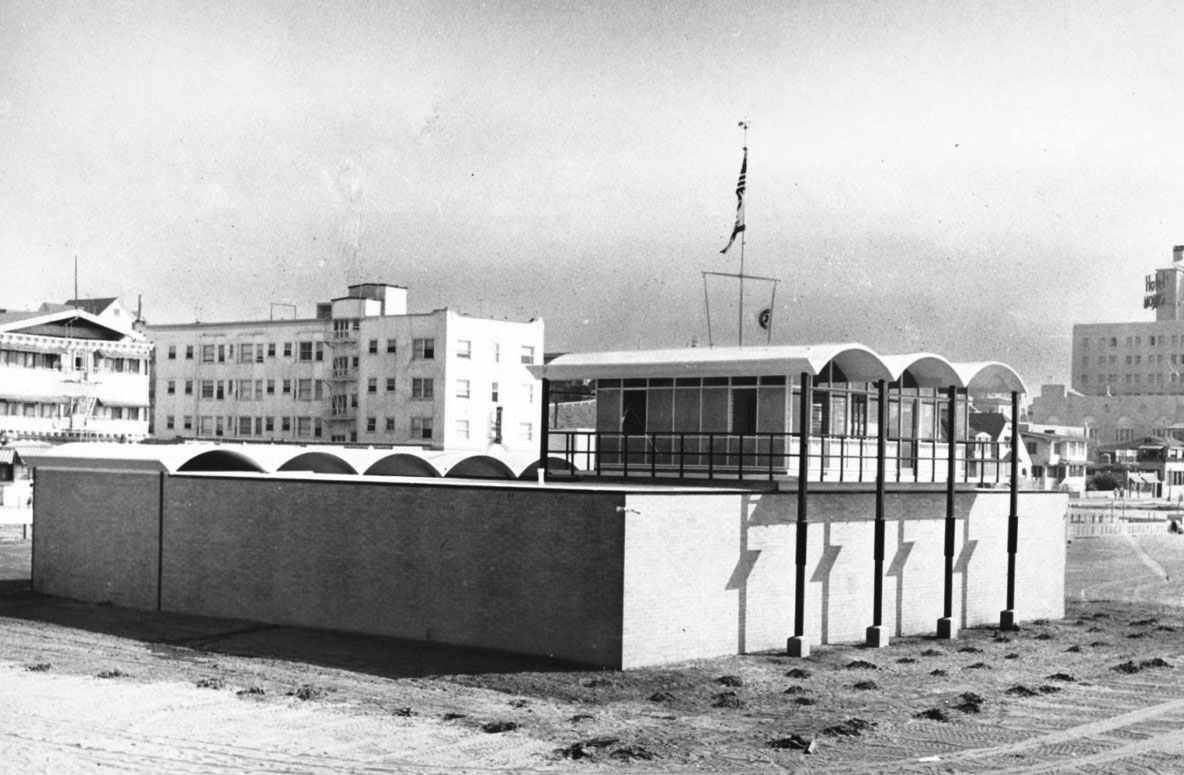 |
|
| (1959)^ - Santa Monica Lifeguard Headquarters off Pacific Coast Hwy. The building was designed by Welton Becket and Associates. |
Historical Notes The lifeguard facility was originally constructed in the late 1950’s and has been staffed by Los Angeles County since the 1970’s. The County Fire Department provides year-round lifeguard coverage for the beach seven days a week, as well as round the clock emergency response and paramedic support.* |
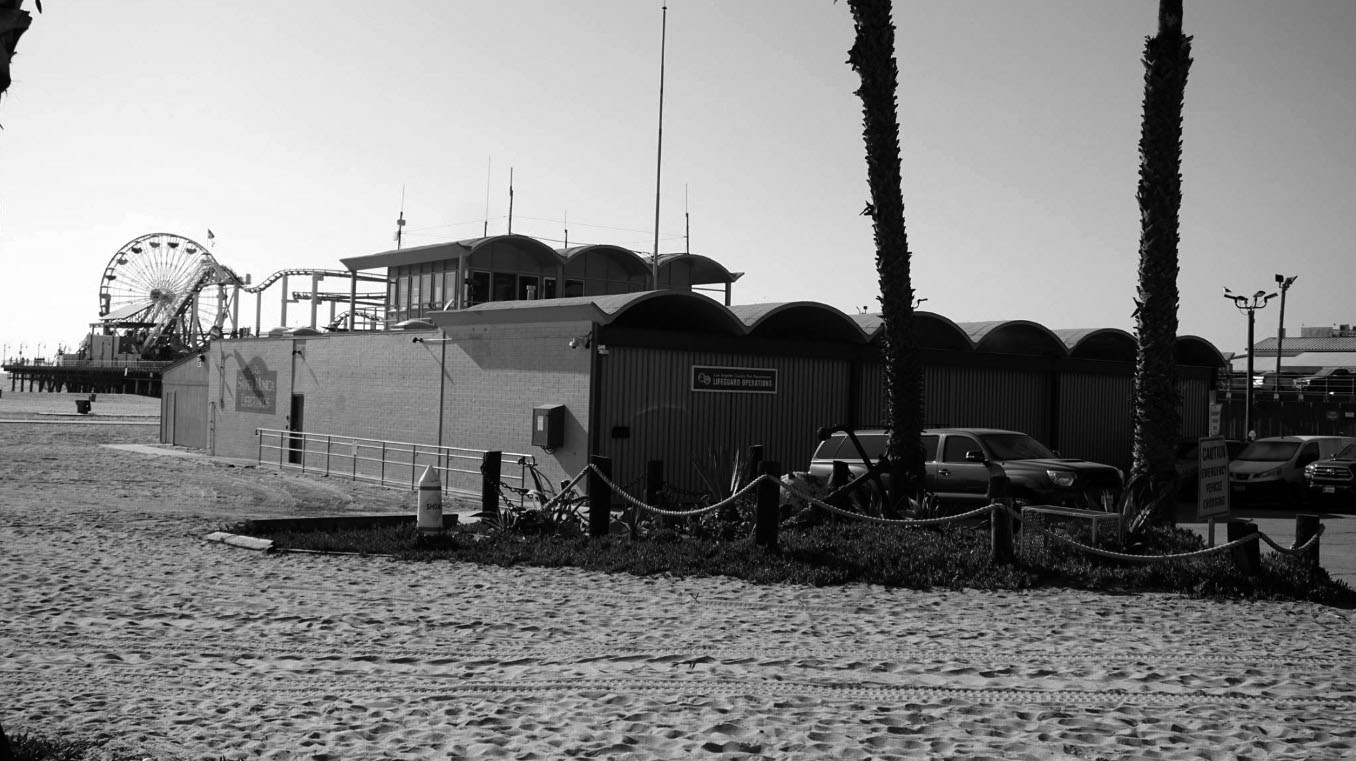 |
|
| (2018)^ - Santa Monica Lifeguard Headquarters at 1642 Ocean Front Walk with Santa Monica Pier seen in the background. |
Historical Notes The Los Angeles County Fire Department Lifeguard Division is the largest professional lifeguard service in the world. In 2018, the Los Angeles County Lifeguard Service employed 177 year-round lifeguards (chiefs, captains and ocean lifeguard specialists) and over 650 seasonal lifeguards (recurrents). Operating out of four Sectional Headquarters, located in Hermosa, Santa Monica, Marina Del Rey and Zuma beach. Each of these headquarters staffs a 24-hour response unit, and are part of the 911 system. In addition to providing marine firefighting, LA County Lifeguards have specialized training for fire boat operations. Prior to July 1, 1994, Los Angeles County Lifeguards were part of the Department of Beaches and Harbors.*^ |
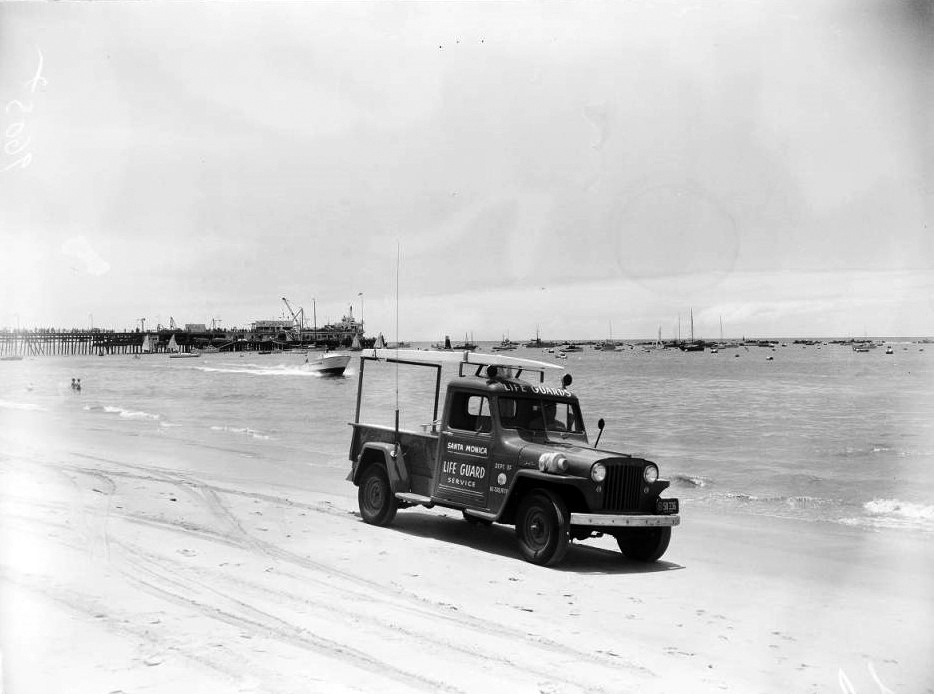 |
|
| (1952)* - View showing a life guard jeep and rescue boat at Santa Monica Beach. Caption reads: “Rescue jeep's newest radio equipment to talk to (1) radio equipped lifeguard power rescue boat on emergency call and (2) lifeguard headquarters station (extreme right end of pier). Santa Monica is the only guard station on the coast with its own frequency, assigned by the Federal Communication Commission". |
* * * * * |
Surfing
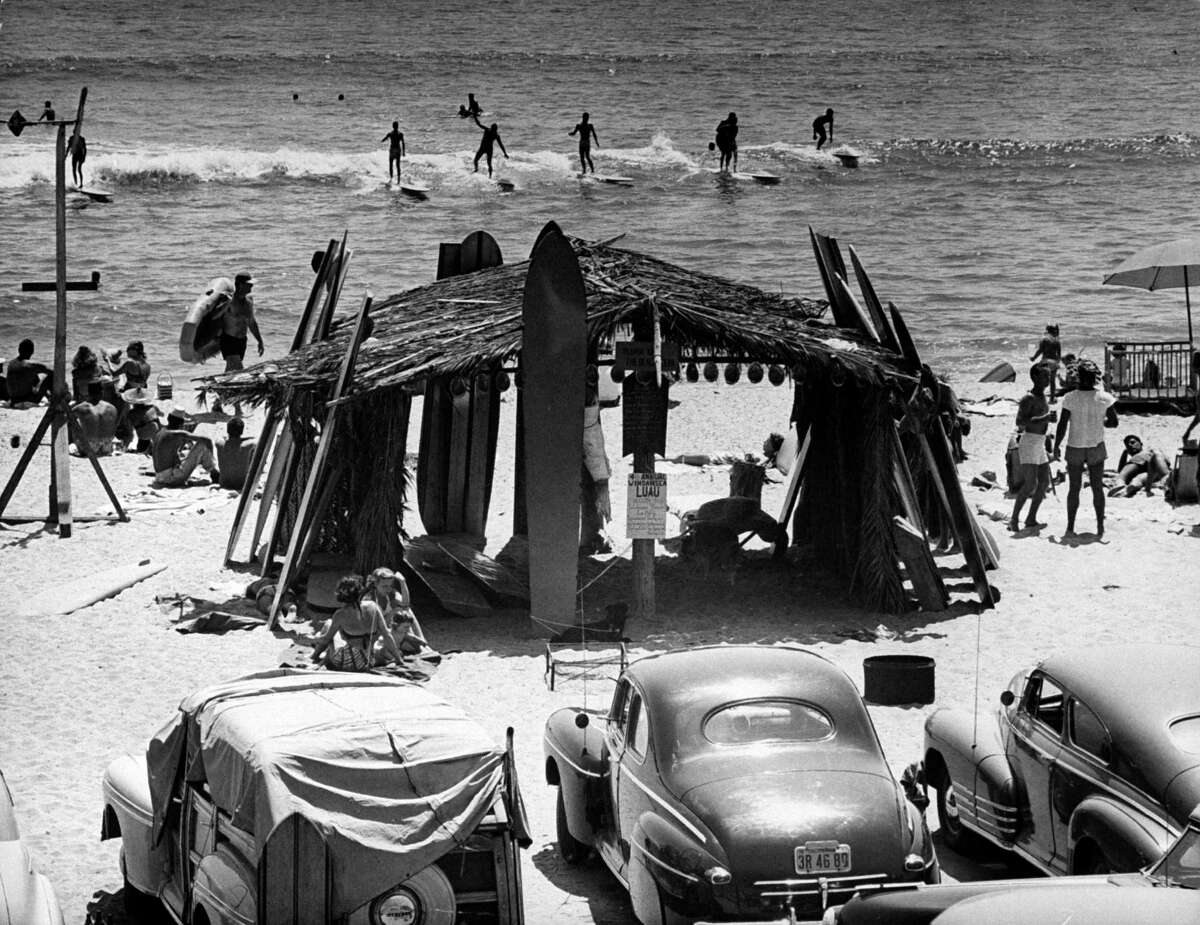 |
|
| (1950)* - Surfing California. Surfing is more than a sport....it's a way of life! |
Historical Notes “Out of water, I am nothing.” — Duke Kahanamoku “Surfing’s one of the few sports where you look ahead to see what’s behind.” — Laird Hamilton “One of the greatest things about the sport of surfing is that you need only three things: your body, a surfboard, and a wave.” — Naima Green |
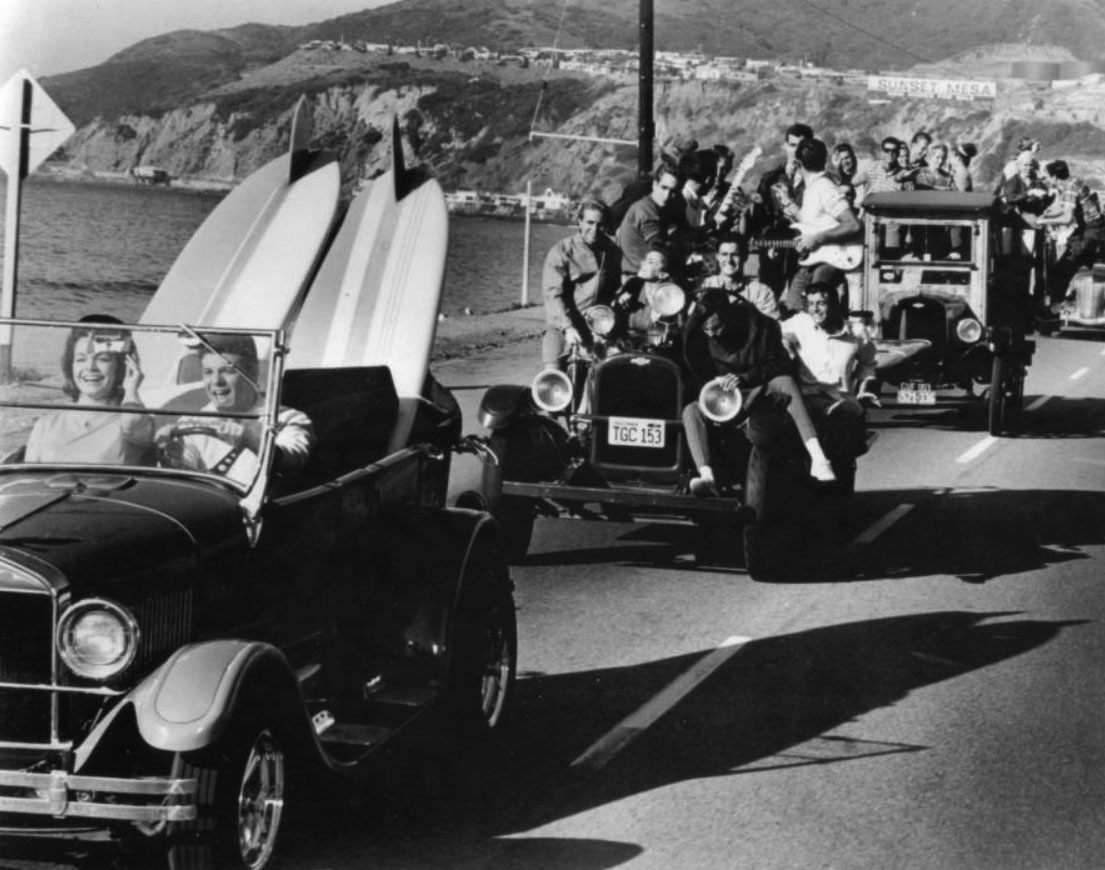 |
|
| (1964)^ - Still image from the Frankie and Annette beach movie "Muscle Beach Party" from 1964. The Jalopy caravan moves down the Pacific Coast Highway in Pacific Palisades with the Sunset Mesa development in the background. |
Historical Notes Muscle Beach Party (1964) is the second of seven beach party films produced by American International Pictures. It stars Frankie Avalon and Annette Funicello and was directed by William Asher, who also directed four other films in this series.*^ |
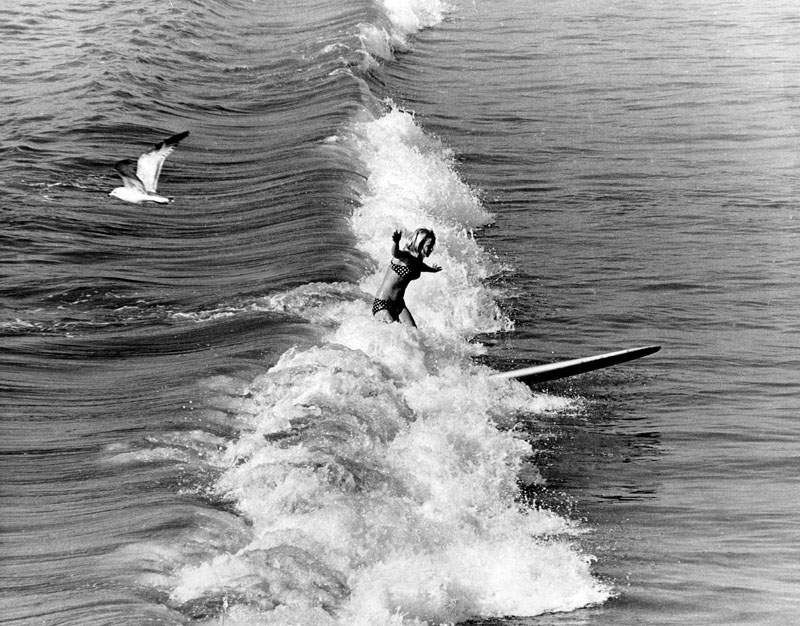 |
|
| (1968)* - View of a young surfer riding a wave in Santa Monica. |
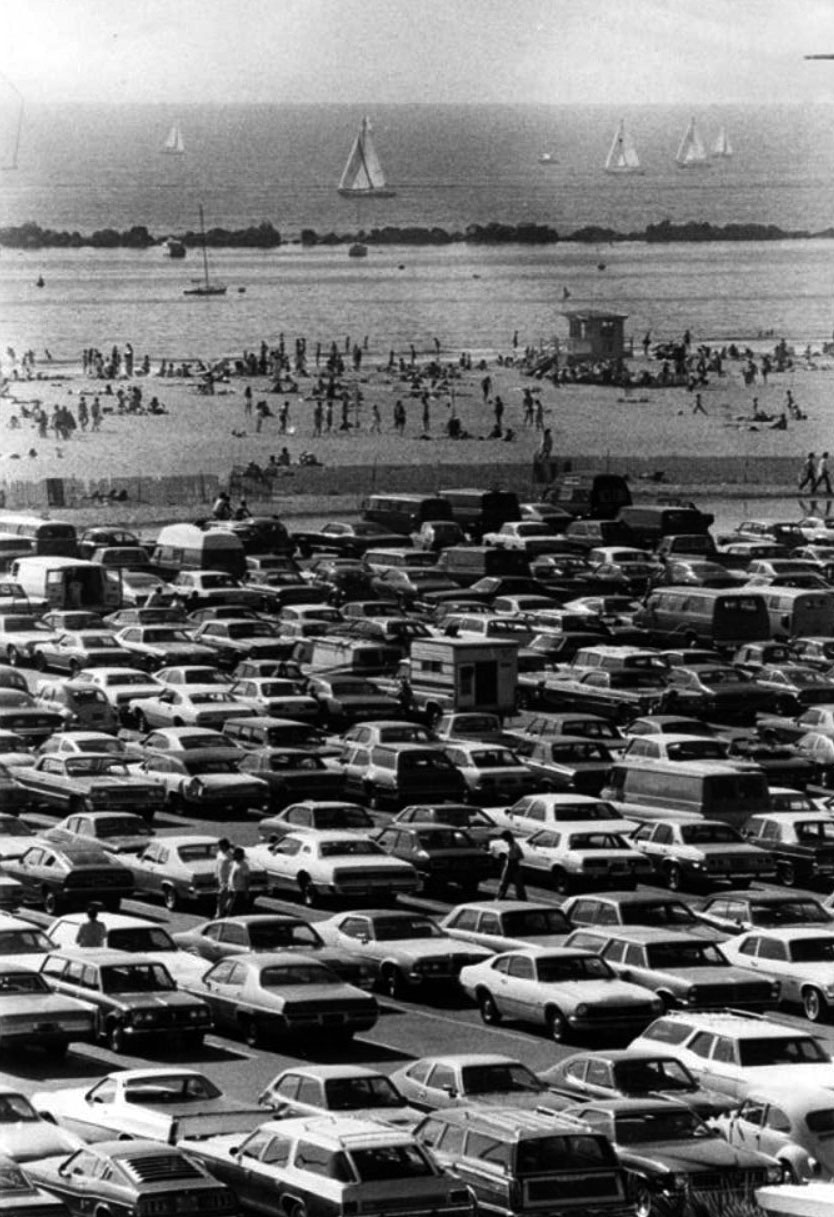 |
|
| (1977)* - The parking lot at the beach in Santa Monica has only a few empty spots. People are strolling or sunbathing or playing beach volleyball as sailboats pass by. |
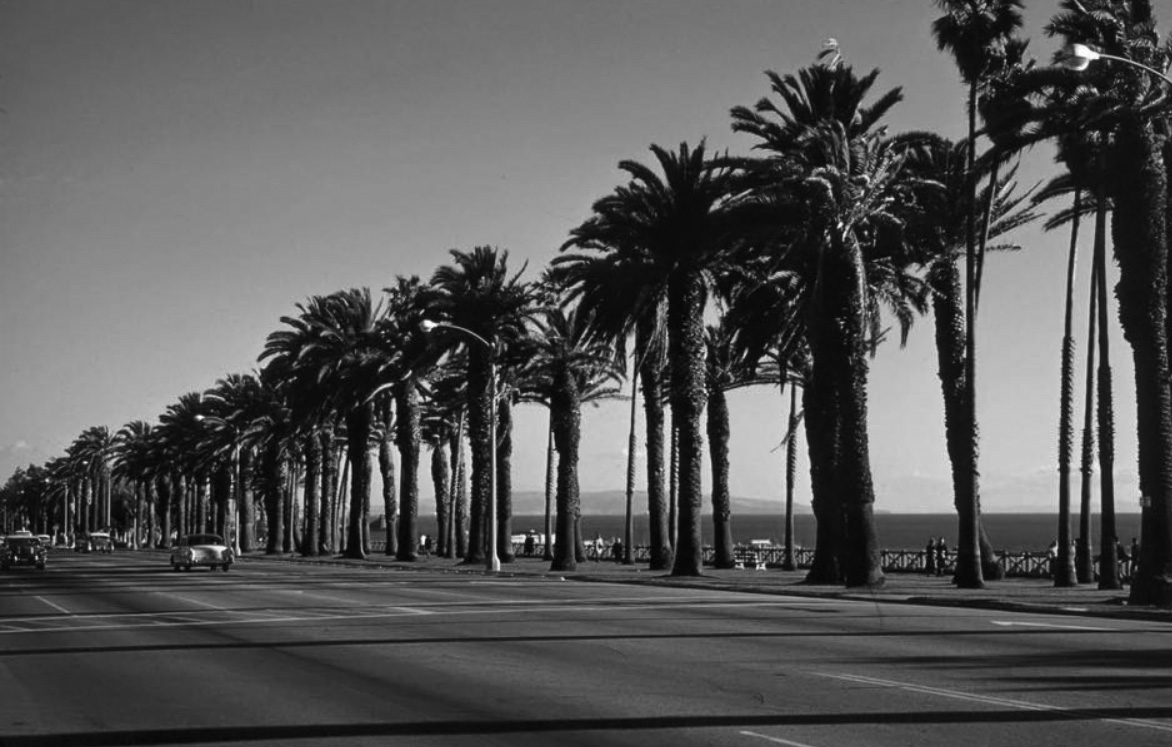 |
|
| (1950s)* - View showing a palm tree-lined Ocean Avenue with the Palos Verdes Peninsula in the distance. |
Historical Notes Ocean Avenue is a road in Santa Monica that starts at the residential Adelaide Drive on the north end of Santa Monica and ends at Pico Boulevard. Ocean Avenue is the westernmost street in Santa Monica, and for most of its course it runs parallel to Palisades Park, whose bluffs overlook Pacific Coast Highway and Santa Monica State Beach.*^ |
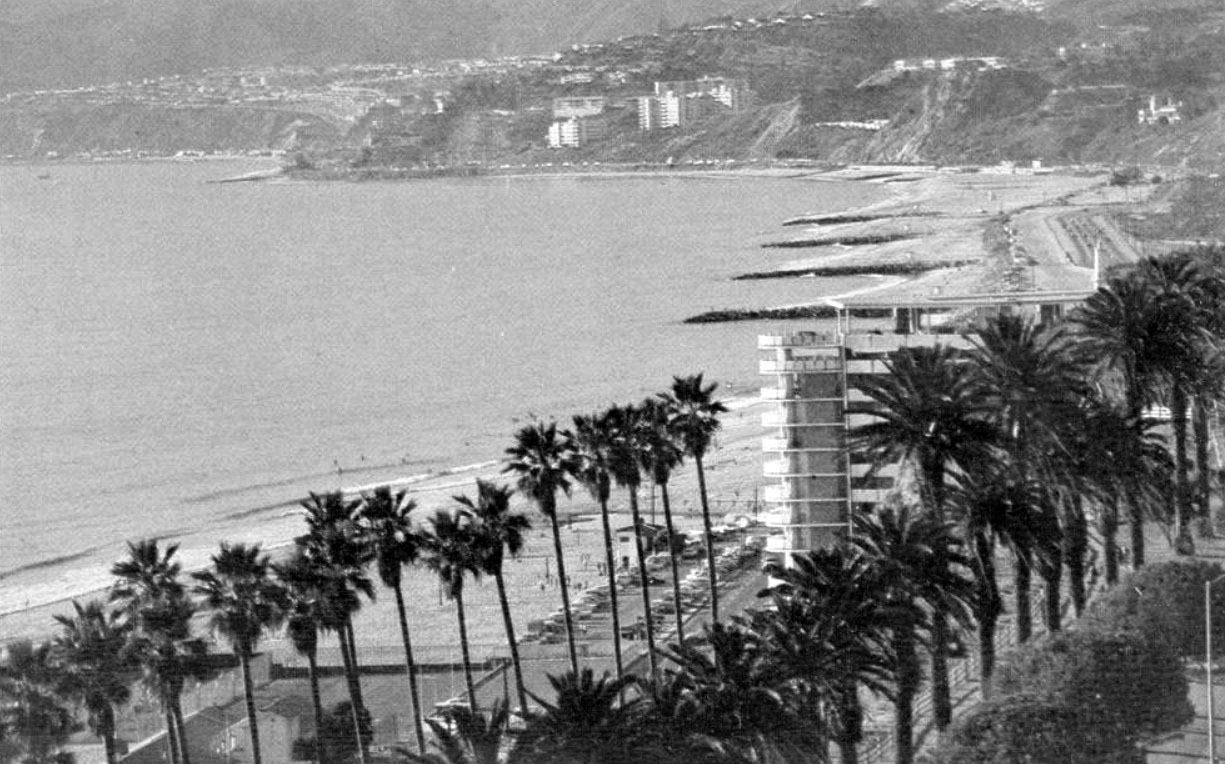 |
|
| (1960s)^ – Postcard view from Palisades Park near Inspiration Point of the Pacific Coast Highway stretching northward along the beach. The building seen through the palm trees is the 101 Ocean Avenue condo complex. |
Historical Notes Built in 1963, the 101 Ocean Ave condo complex is made up of 59 units in a 10-story building. |
Third Street (now Third Street Promenade)
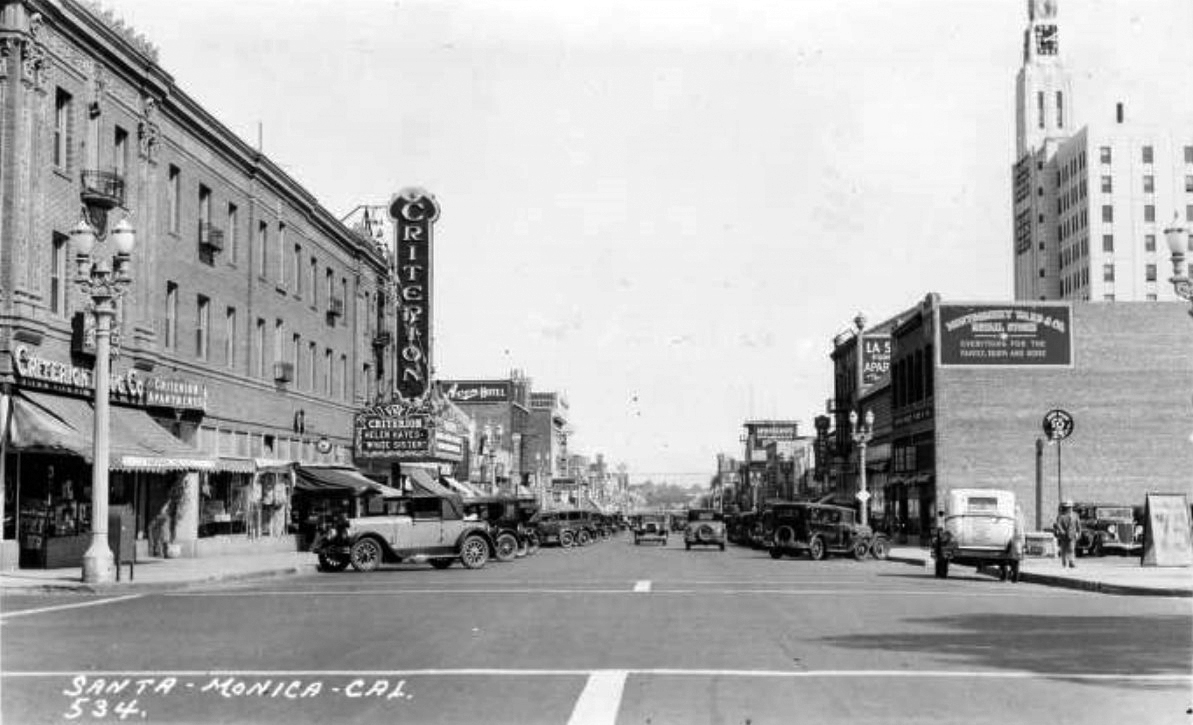 |
|
| (1933)^ – Postcard view looking south on Third Street from Arizona Avenue showing streetlights, automobiles, pedestrians and storefronts. The Bay Cities Guaranty Clock Tower Building (Crocker Bank Building) is seen at right and the Criterion Theatre is seen at left advertising "The White Sister" with Helen Hayes. Signs on the street read "Criterion Drug Co." "Criterion Apartments" "Avon Hotel" "Sponberg's Department Store" "Montgomery Ward & Co" and "J.C. Penny Co." |
Historical Notes The Criterion Theatre was built in 1924 and was part of the Fox West Coast Thetres ciruit. In 1983, the theatre was rebuilt to make way for a new 6-plex.*** |
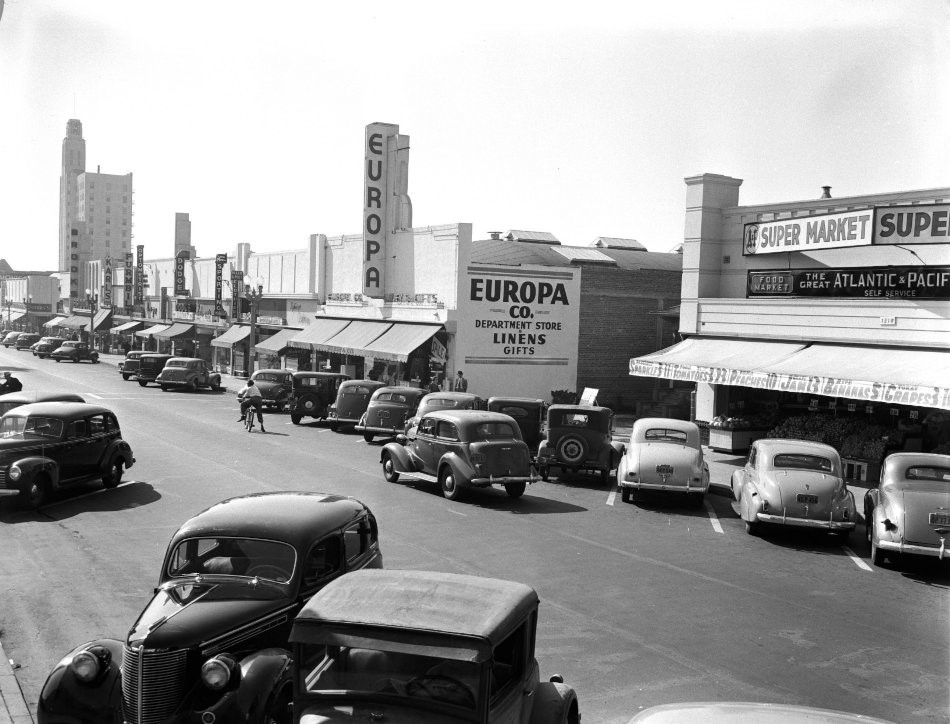 |
|
| (1940)* – Looking down Third Street, showing A&P Supermarket, Bay Cities Guaranty Building and Europa Company Department Store. |
.jpg) |
|
| (ca. 1950)##^* – View looking south down Third Street showing the Fox Criterion Theatre on the left, located at 1315 Third Street. |
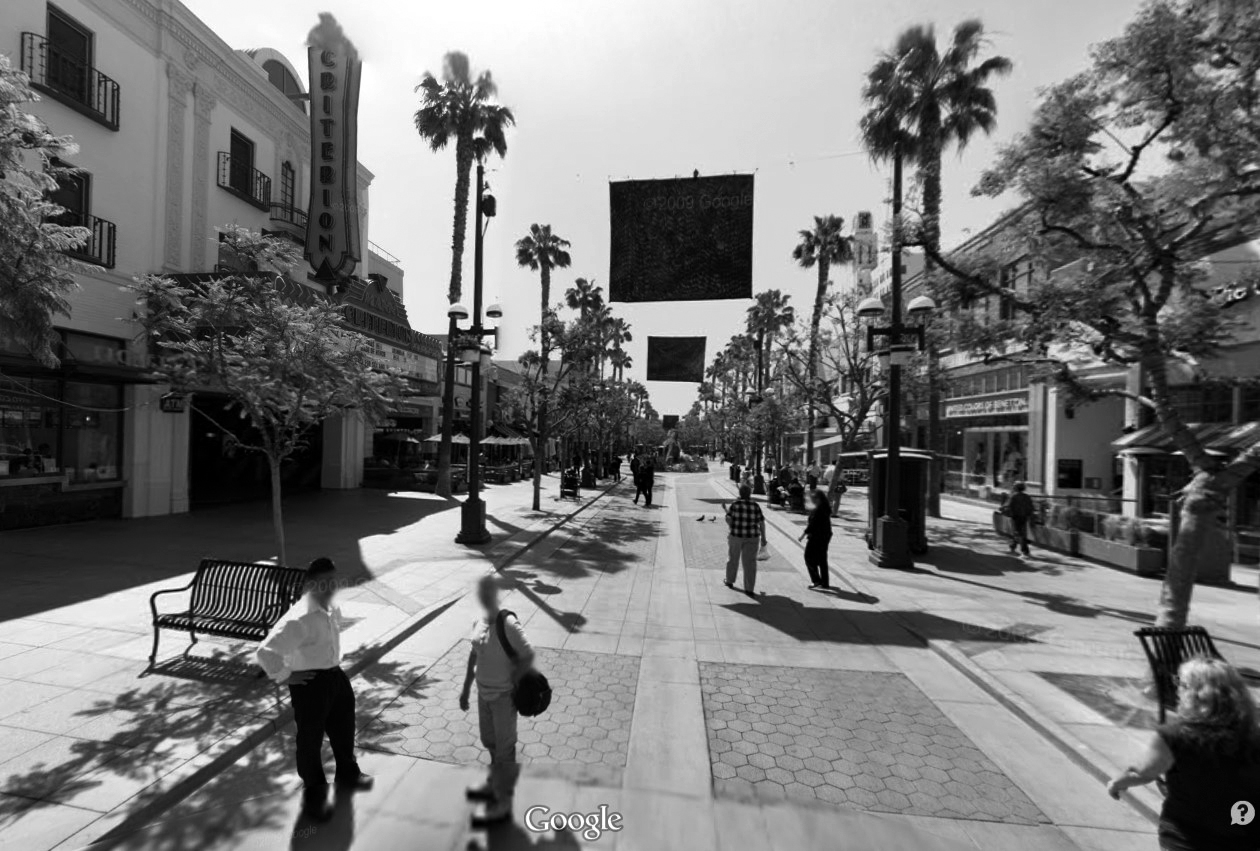 |
|
| (2008)#*^# - Google street view of the Third Street Promenade showing the Criterion Theatre on the left. |
Historical Notes Mann Theatres took over the Criterion in 1991 and in 2001, remodeled the interior and exterior of the theater. The architectural firm Behr Browers Architects of Westlake CA were responsible for the remodel. It was one of the most successful theaters in the circuit. The Criterion Theatre was closed on March 30, 2013 to make room for more retail stores.*** |
Before and After
.jpg) |
 |
|
| (ca. 1950)##^* – View looking south down Third Street with the Fox Criterion Theatre on the left. | (2008)#*^# - View of the Third Street Promenade with the Criterion Theatre on the left. |
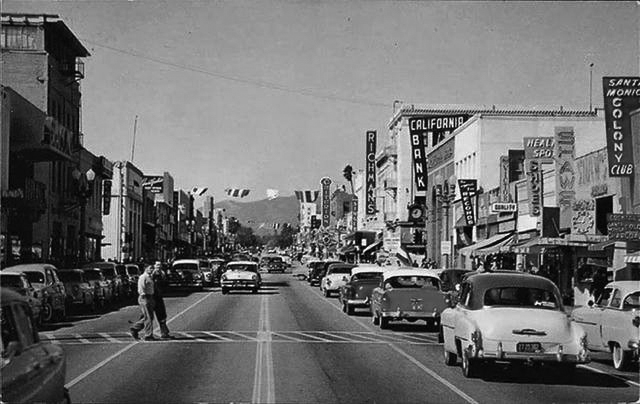 |
|
| (ca. 1955)*** – View looking north on Third Street in Santa Monica (now the Third Street Promenade). On the right legible signs include: Santa Monica Colony Club, California Bank, Richmond’s, and in the distance, the Criterion Theatre. |
Historical Notes Third Street Promenade has been a center of business in Santa Monica since the town's inception in the late 19th century. The Promenade's roots date back to the 1960s when three blocks of Third Street were converted into a pedestrian mall.*^ |
 |
|
| (1965)* - View showing the Third Street Promenade under construction. |
Historical Notes “A 'pedestrians' paradise' is in the making in this Santa Monica Street. A three-block-long mall, free of vehicular traffic, is under construction in this area”. - Herald Examiner - July 27, 1965.* |
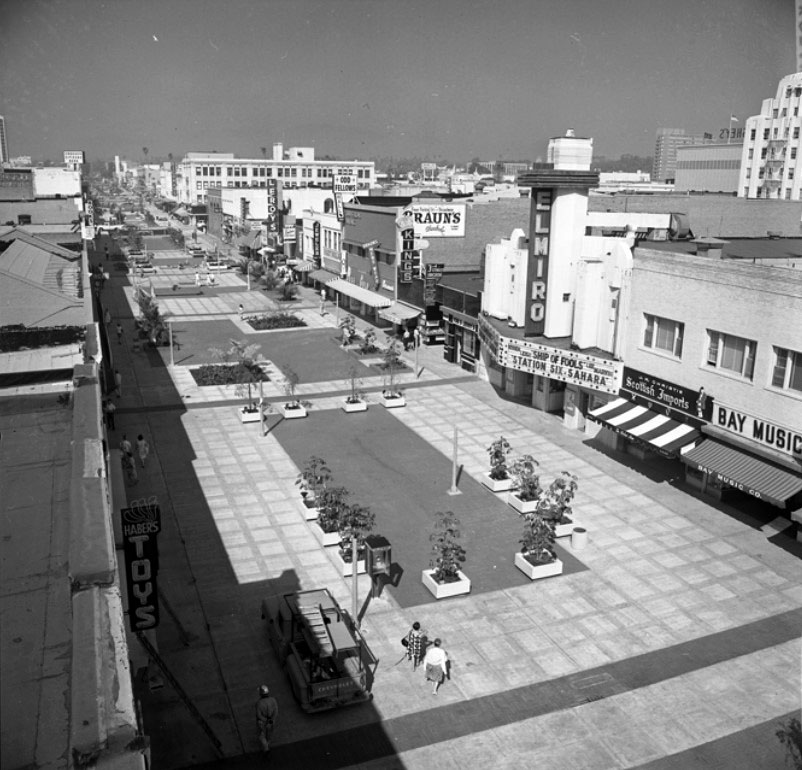 |
|
| (1965)^ - The 3rd Street Promenade in Santa Monica, when it first opened as a pedestrian-only street. The El Miro Theatre is seen on the right. UCLA image archive |
Historical Notes It wasn’t called the 3rd Street Promenade until they revamped it in the late 80s. Before that it was called The Santa Monica Mall. |
Then and Now
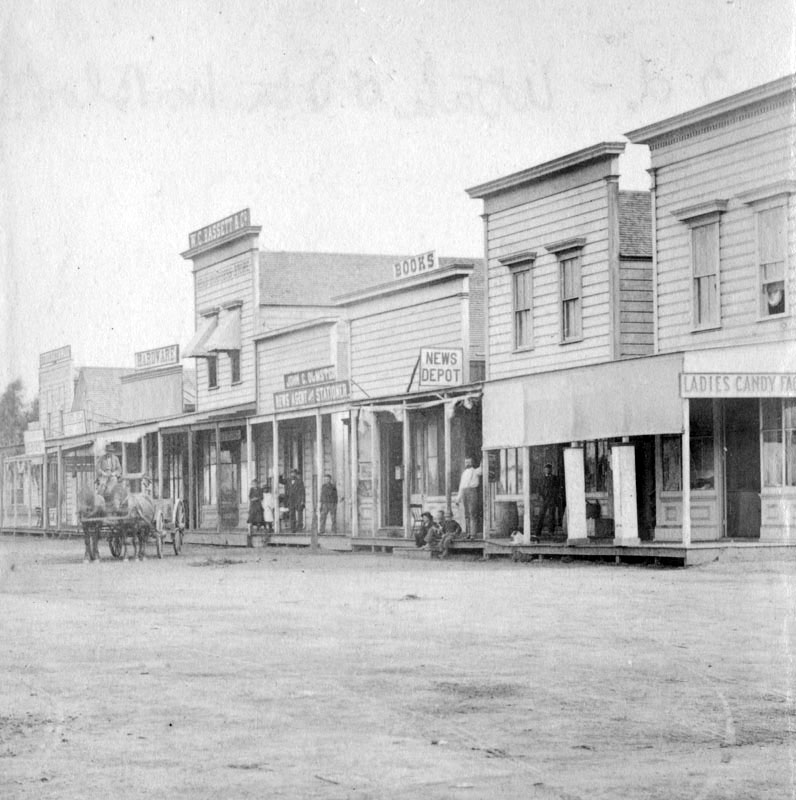 |
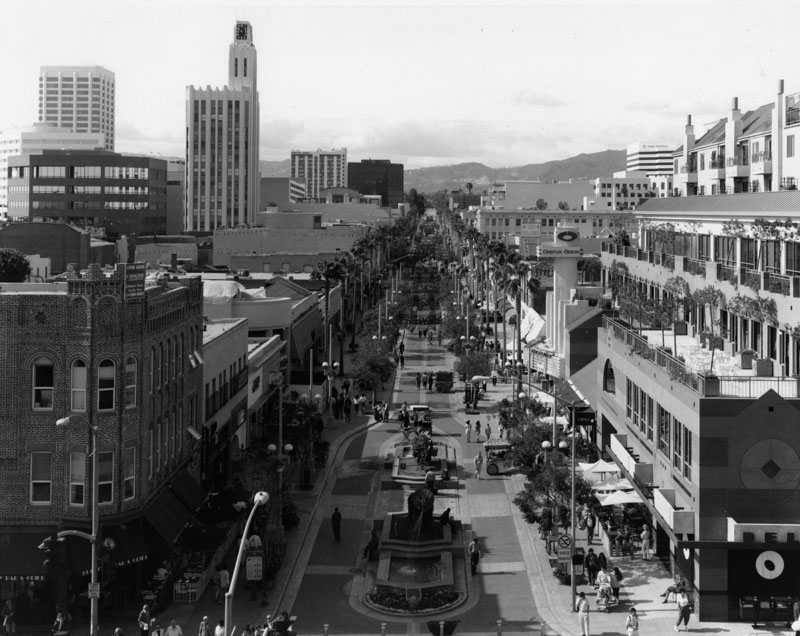 |
|
| (1880)* - View of Third Street, between Utah and Oregon (now Santa Monica Boulevard). | (ca. 2010s)* - View of the Third Street Promenade. |
Then and Now
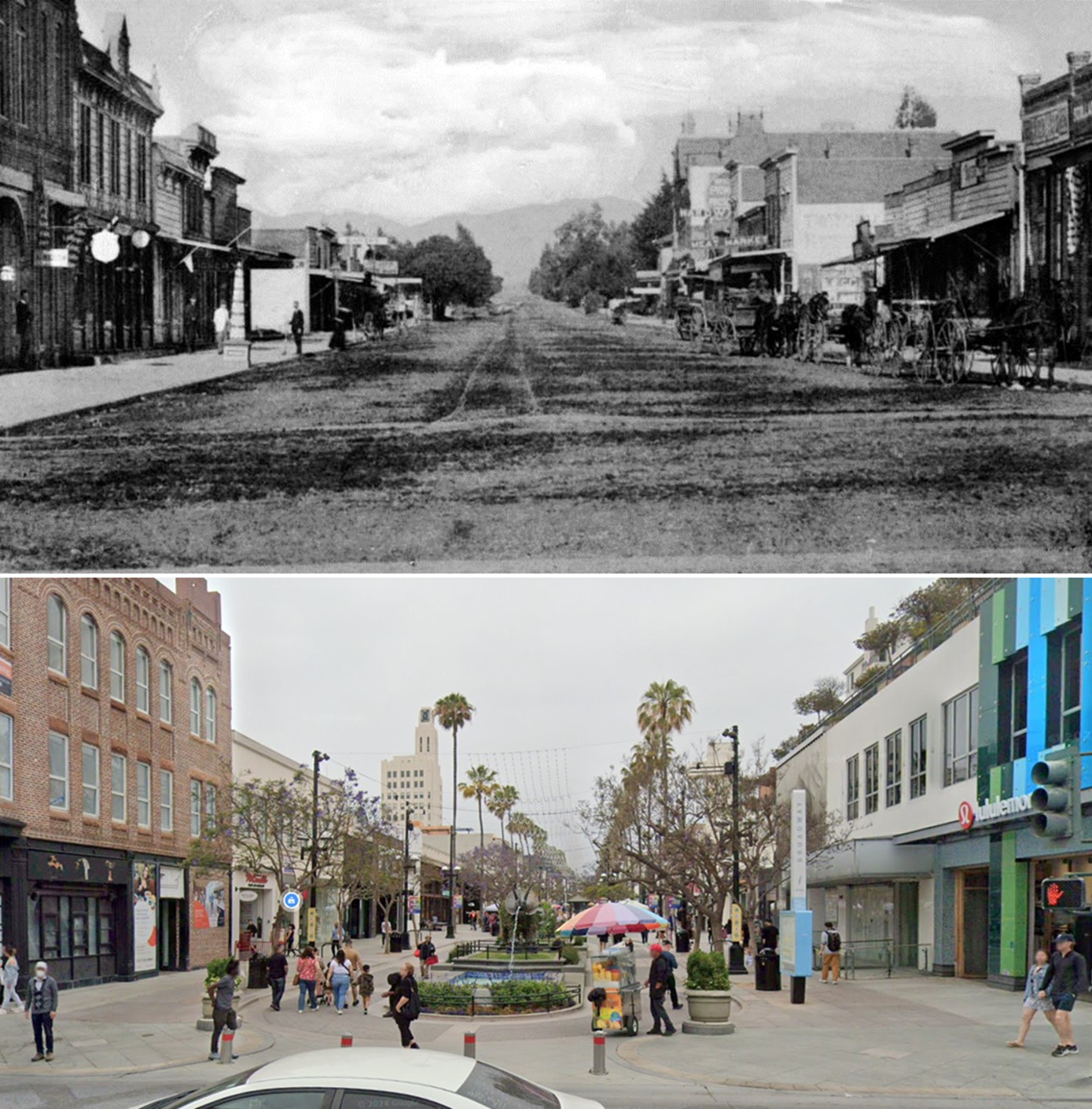 |
|
| (1891 vs 2024)* - Third Street Promenade in Santa Monica, looking northwest on Third Street at Utah (now Broadway). |
 |
|
| (2010s vs. 1920s)^.^ - Then and Now - Third and Broadway, Santa Monica . |
 |
|
| (ca. 2010s)* - Third Street Promenade in Santa Monica. A Bar and Grill can be seen on the left side. Two fountains with art sculptures are in the middle of the mall. A Cineplex theater and a Broadway's Deli is on the right side. Three vendors with push carts can be seen towards the middle of the mall, with many people walking throughout the area. The Santa Monica beach is 3-4 blocks away. |
Historical Notes Third Street Promenade's roots date back to the 1960s when three blocks of Third Street were converted into a pedestrian mall. Although successful, by the late 1970s, the Santa Monica Mall (as it was then called), was in need of modernization and a redesign. A new enclosed shopping center, Santa Monica Place (1980–2007), designed by Frank Gehry was added at the Promenade's southern end. A citywide bond measure was issued and architectural firm ROMA Design Group was hired to redesign Santa Monica Mall. The renamed Third Street Promenade opened on September 16, 1989. The project was part of a larger redevelopment effort, encompassing several blocks of Downtown Santa Monica. Santa Monica Place has since been renovated into a new open-air shopping and dining experience that re-opened on August 6, 2010.*^ |
Route 66 - End of the Trail
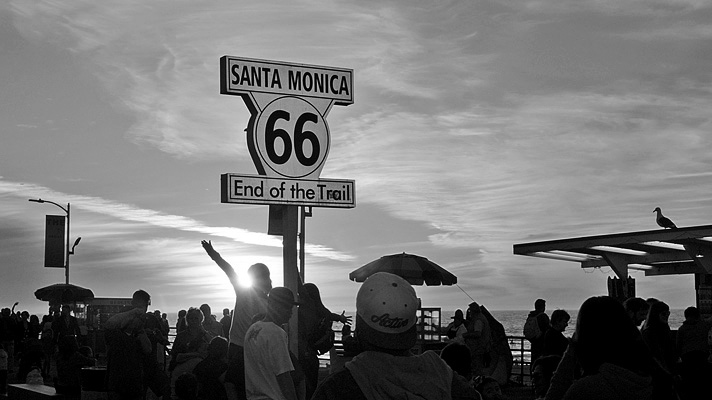 |
|
| (2013)* - The Route 66 End of the Trail sign is one of Santa Monica’s hidden gems, located on one end of the Santa Monica Pier. Photo courtesy of C H Ogawa |
Historical Notes Known as the Will Rogers Highway, the Mother Road and the Main Street of America, the 2,450-mile-long Route 66 was originally built to connect Chicago to Los Angeles. Though the actual end of the legendary highway has been debated for decades, this replica of the long-lost End of the Trail Sign officially marks the Western terminus of the great highway. |
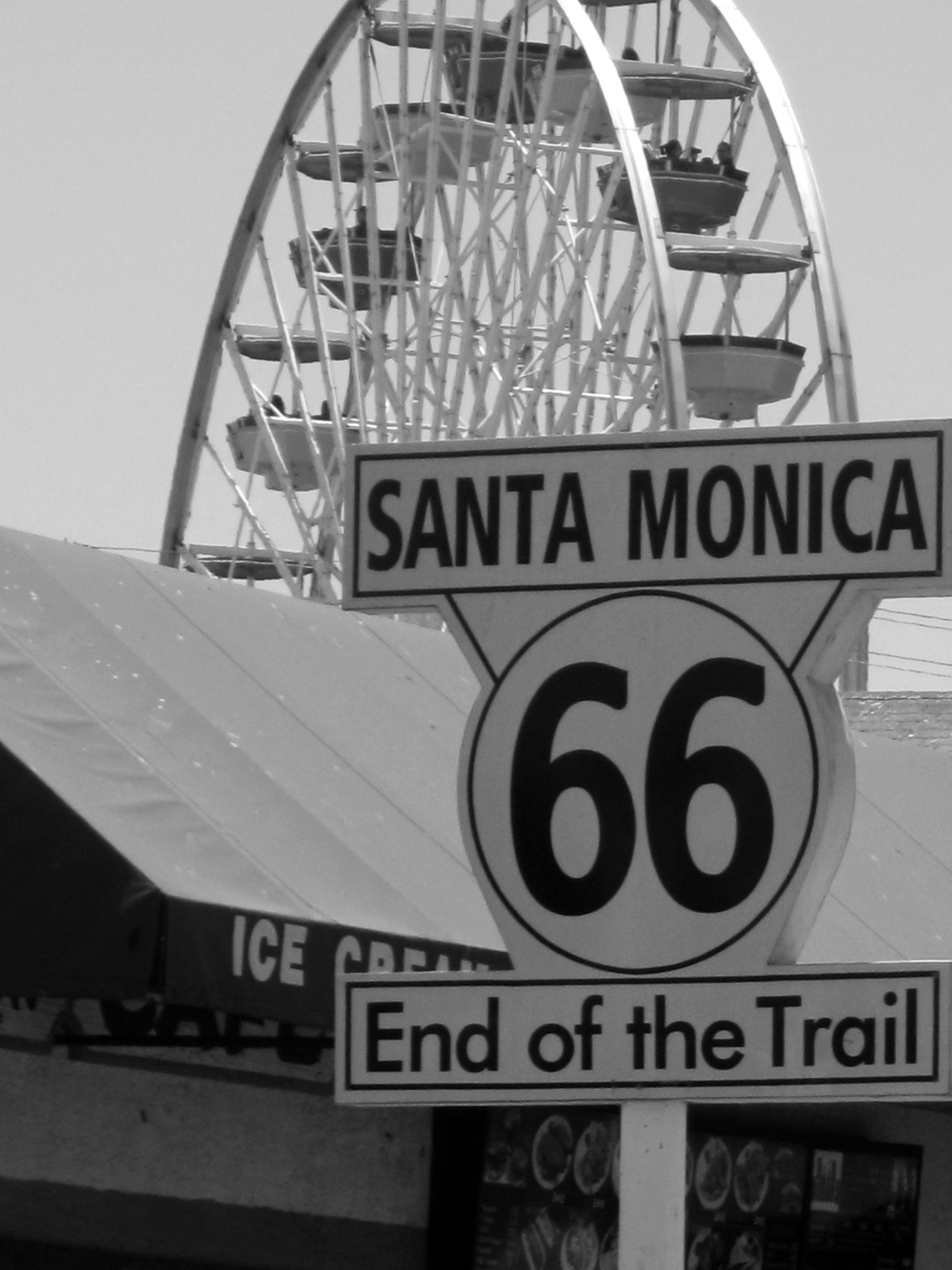 |
|
| (2014)* - Route 66 - End of the Trail sign at the Santa Monica Pier with Ferris wheel in the background. Photo courtesy of Marie Christin |
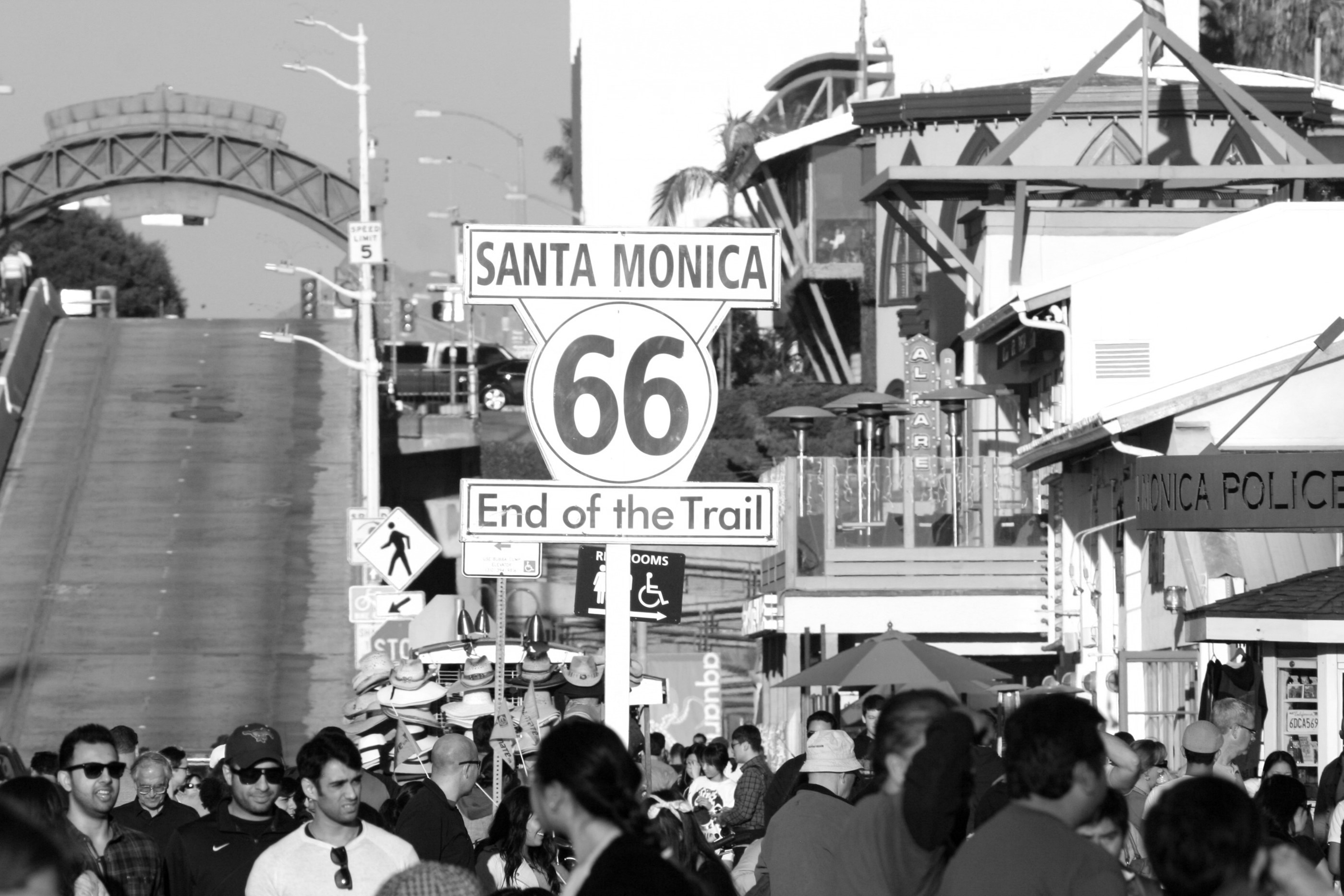 |
|
| (2013)* - The sign of US 66's western terminus at the Santa Monica Pier. Photo by Christian Beiwinkel / Wikipedia |
Santa Monica Pier
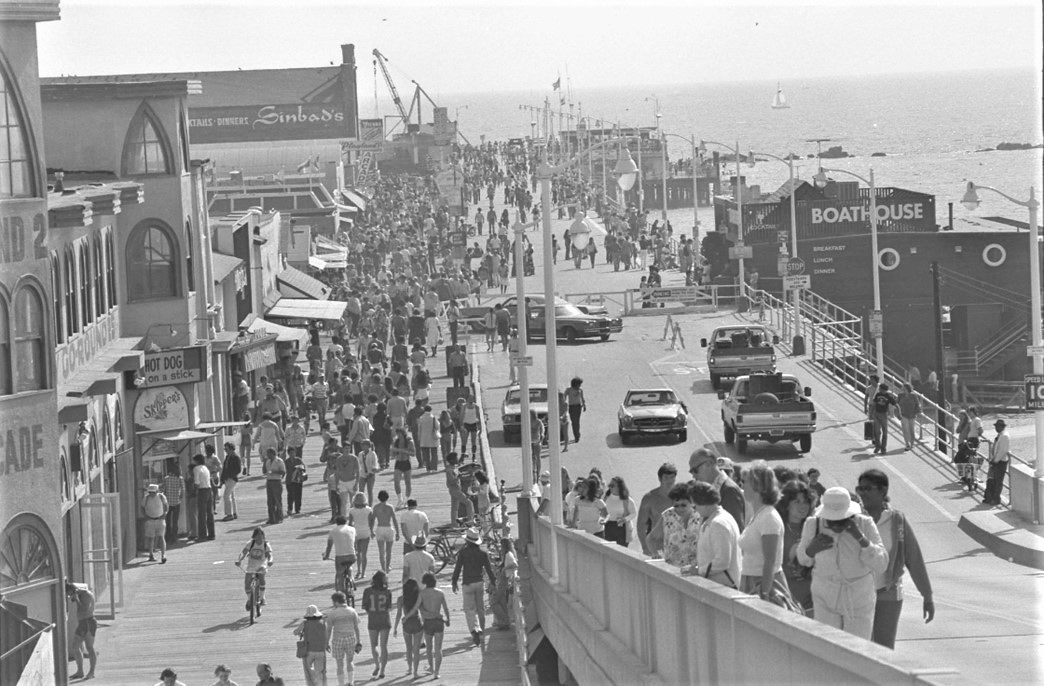 |
|
| (1979)* - PIER PRESSURE--A summery weekend brought throngs of people to the shops, restaurants and beach along the Santa Monica Pier. |
Historical Notes The Santa Monica Pier faced significant challenges and transformations during the 1970s and 1980s. In the early 1970s, the pier narrowly escaped demolition when plans for a resort development threatened its existence. However, community activism, particularly the formation of the "Save Santa Monica Bay" group, led to the city council revoking the demolition order in 1973, marking a crucial turning point in the pier's preservation. |
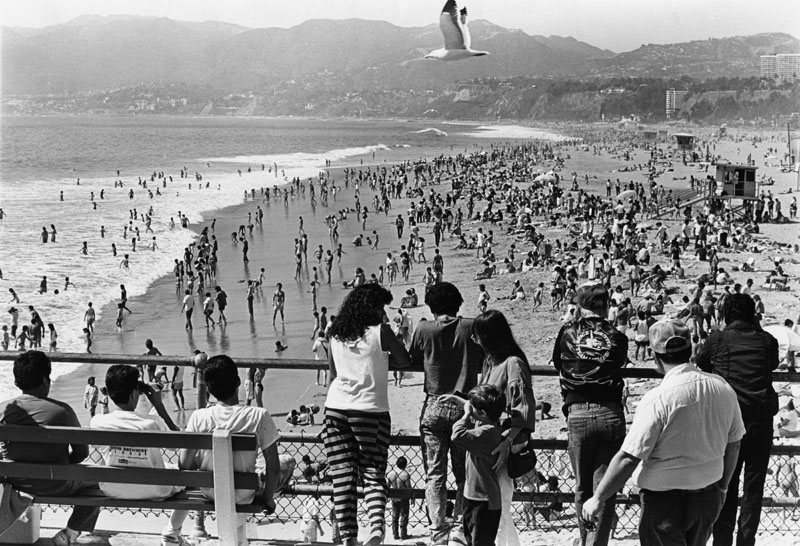 |
|
| (1988)* - Santa Monica Pier looking north on the first day of Spring. Photograph dated: March 21, 1988. |
Historical Notes The 1980s brought both destruction and renewal to the iconic landmark. In 1982, storms destroyed the protective breakwater, leaving the pier vulnerable. The following year, in early 1983, violent winter storms caused severe damage, destroying over one-third of the pier. This devastation prompted a comprehensive revitalization effort by the city. The restoration included adding concrete structures for improved stability and planning new attractions such as restaurants, retail stores, and the beginnings of an amusement park. As part of its rebirth, the Santa Monica Pier evolved into a popular event venue. The city began hosting concerts and events to attract visitors, including Cirque du Soleil's first touring show, which enhanced the pier's reputation as an entertainment destination. These efforts paid off, and by the late 1980s, the pier was drawing around 2 million visitors annually, mostly summer tourists. |
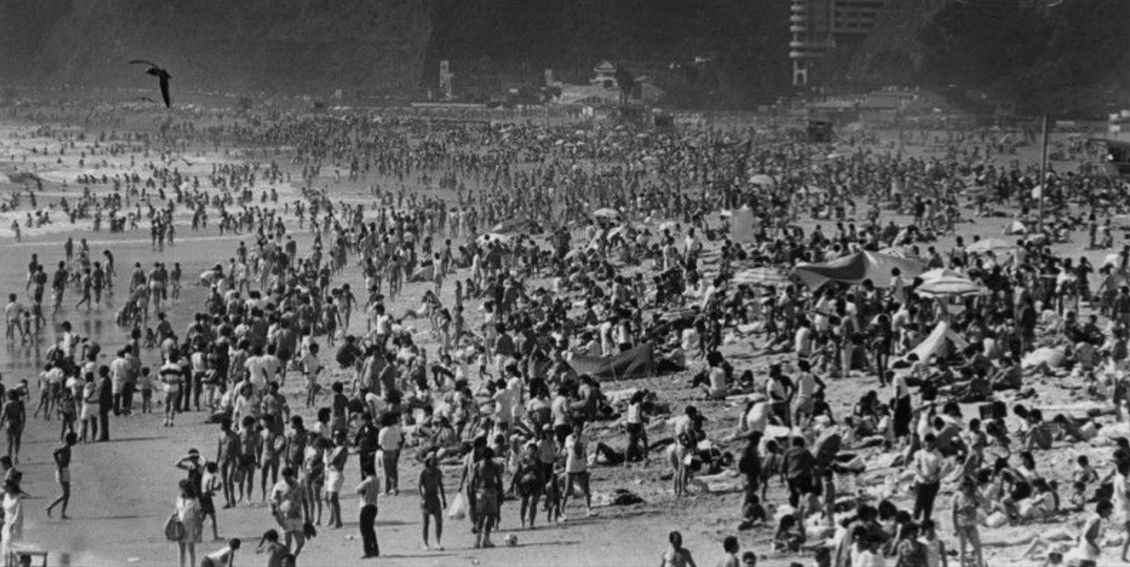 |
|
| (1988)* - Photograph caption reads: "A place in the sun became scarce as the human tide rolled in at Santa Monica Beach". The view is looking north from the Santa Monica Pier. Los Angeles Herald Examiner Photograph dated: March 28, 1988. |
Historical Notes During the 1980s, Santa Monica beaches adjacent to the pier were renowned for drawing massive holiday crowds, reflecting Southern California's vibrant beach culture. While precise crowd numbers are challenging to pinpoint, historical records suggest that holiday weekends like Memorial Day, Fourth of July, and Labor Day would transform the shoreline into a densely packed recreational landscape. The pier and surrounding beaches became magnets for locals and tourists alike, with families, young people, and beach enthusiasts converging in large numbers to enjoy the sun, surf, and festive atmosphere. The area's popularity was driven by its picturesque setting, accessible location, and the pier's numerous attractions. Lifeguard reports and local media from that era consistently described these holiday periods as times when beaches were "wall-to-wall" with people, creating a vibrant, energetic environment that epitomized Southern California's beach lifestyle. The crowds were so significant that they became a defining characteristic of Santa Monica's summer and holiday scenes, drawing people from across the greater Los Angeles metropolitan area seeking recreation, relaxation, and community celebration. |
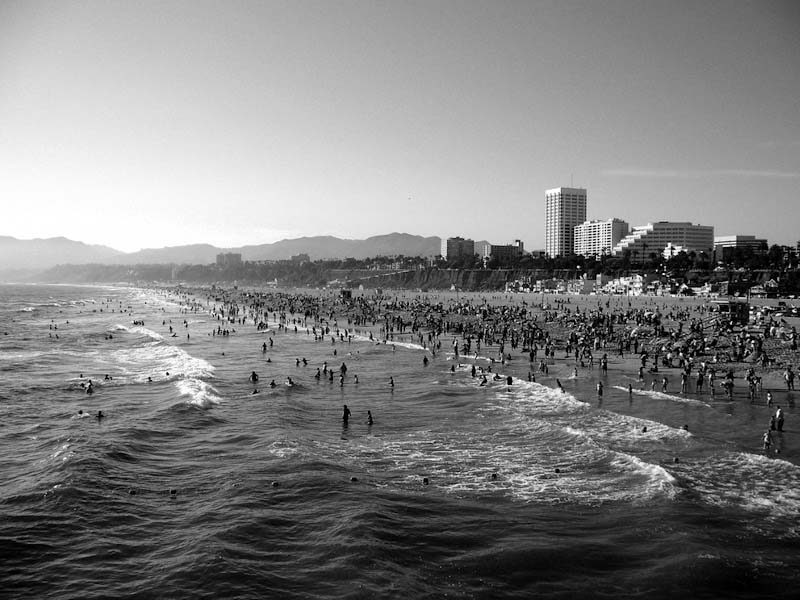 |
|
| (2008)*^ - View of Santa Monica Beach from the pier on a crowded day. In the distance can be seen the California Incline and some of the City's skyline. |
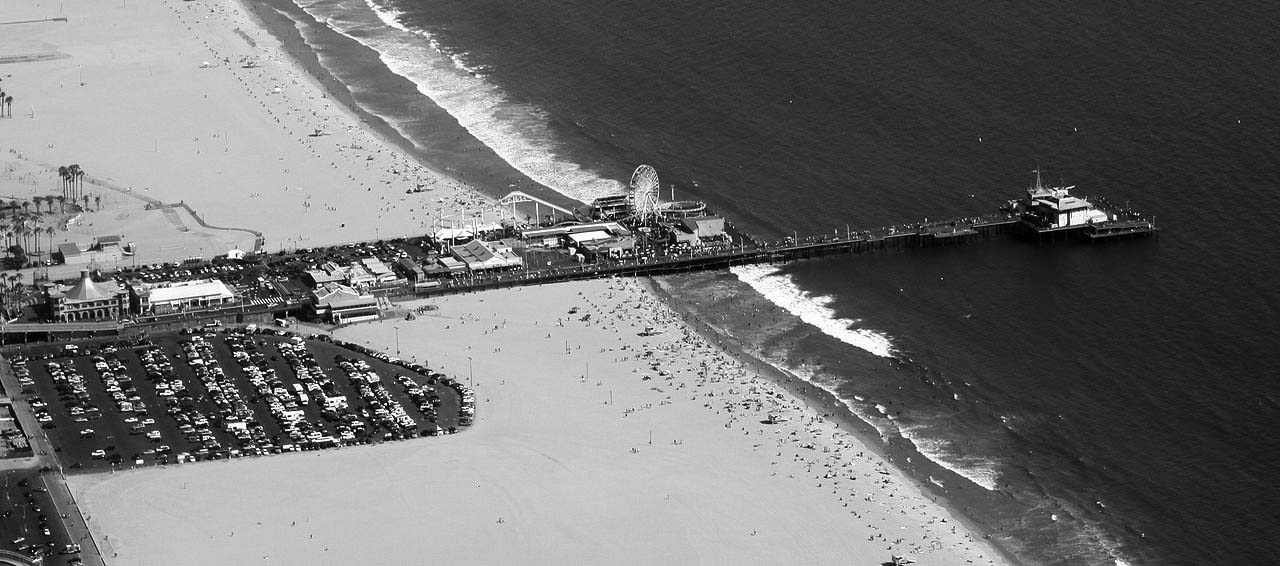 |
|
| (2009)*^ - Panoramic view of the Santa Monica Pier as seen from an altitude of 2,000', looking south. Several rides of the pier’s amusement park, Pacific Park, can be seen including the large Ferris wheel. Photo by 'Jelson25' / Wikipedia |
 |
|
| (2009)* - Panoramic view of the beach and pier in Santa Monica. The City's skyline can be seen in the background. Photo by Matthew Field / Wikipedia |
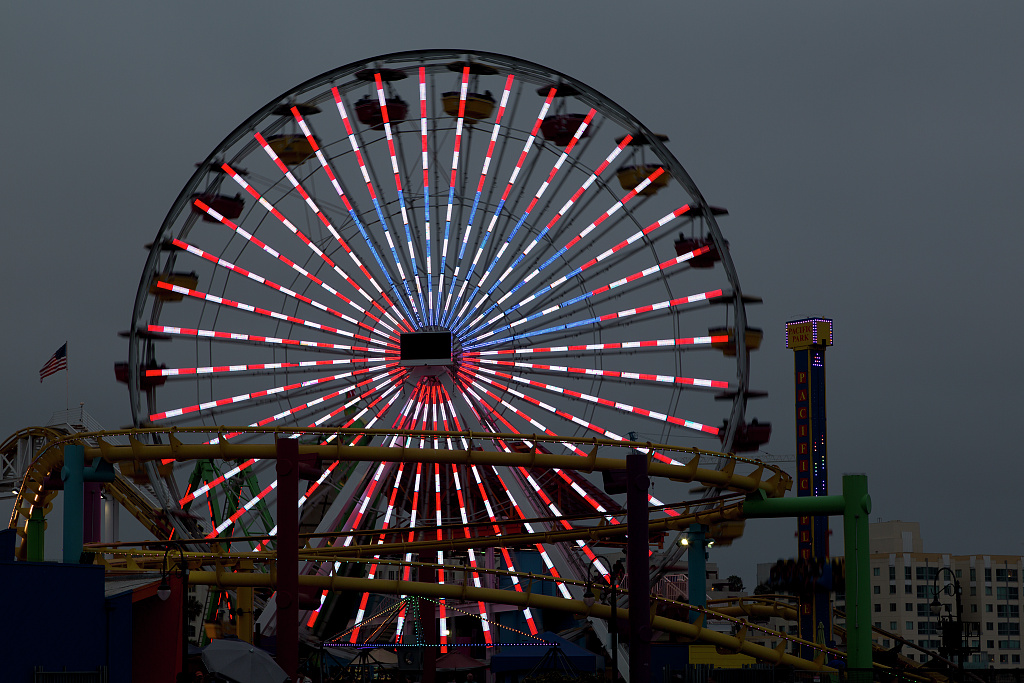 |
|
| (2012)* – Close-up view of the Ferris wheel at Santa Monica Pier. Photo by Carol M. Highsmith / Library of Congress |
Then and Now
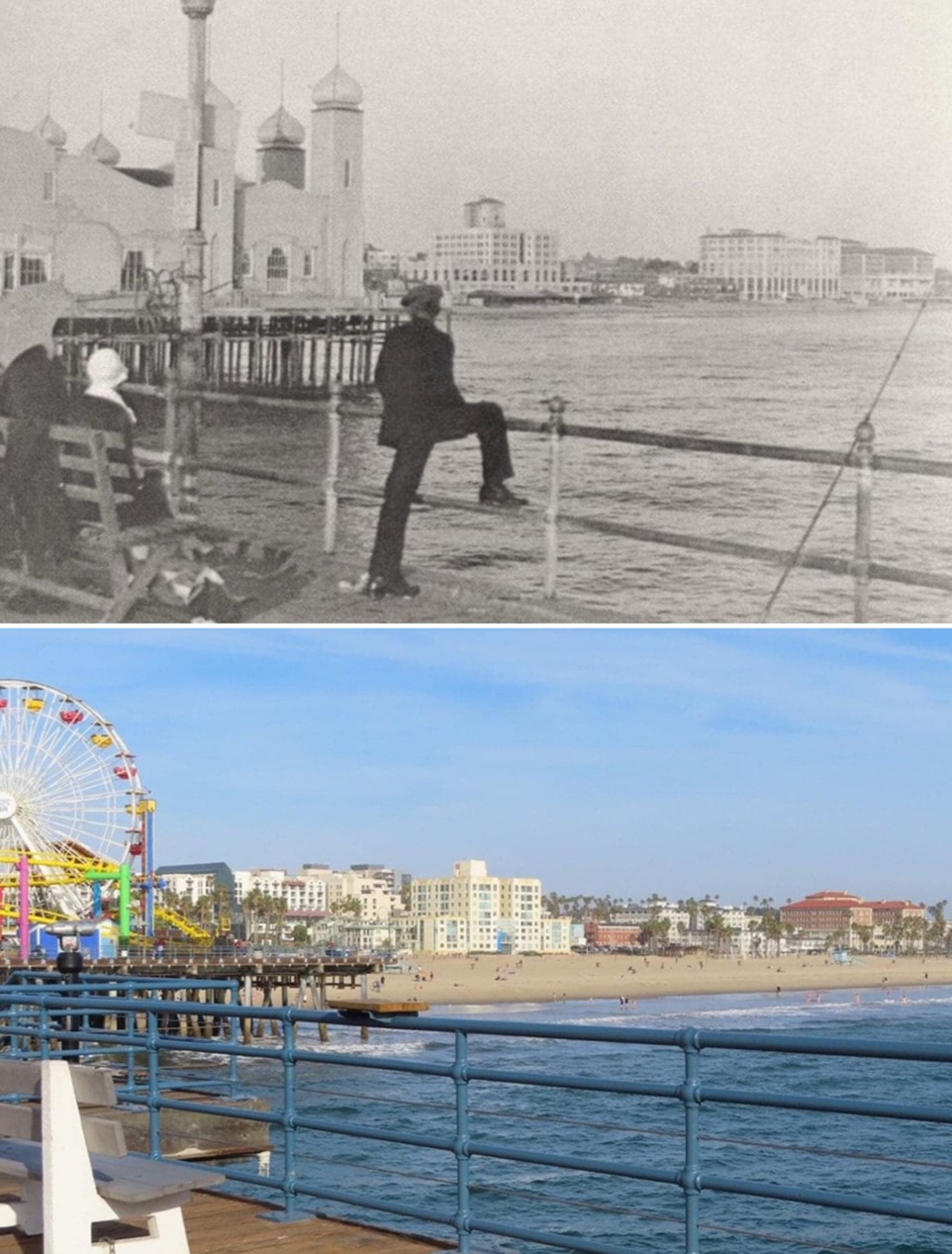 |
|
| (1927 vs Now)* - Santa Monica Pier showing the LA Monica Ballroom where the Ferris wheel is today. Contemporary photo by Lorie Vignolle-Moritz. |
California Incline
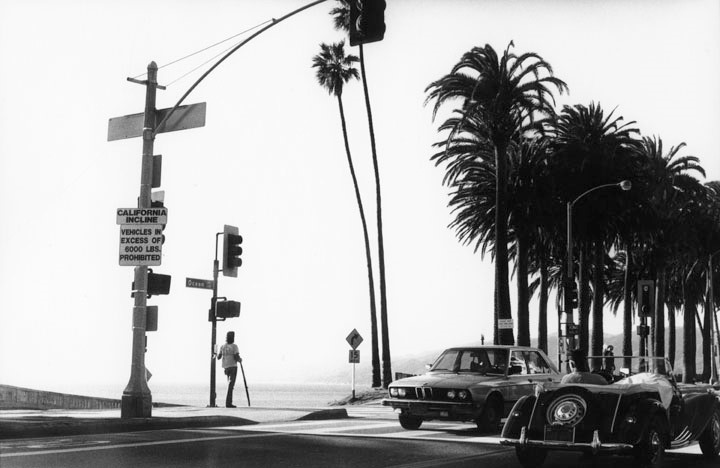 |
|
| (ca. 1987)* - Cars travel in both directions along Ocean Avenue where it crosses California Avenue in Santa Monica. California Avenue leads to the California Incline, also known as the California Avenue Incline Bridge (foreground, left), connecting Ocean Avenue to the Pacific Coast Highway. Sign at left reads: California Incline, Vehicles in Excess of 6,000 lbs. Prohibited. |
Historical Notes The California Incline was identified as structurally deficient in the early 1990s. In 2007, the City of Santa Monica secured federal highway funds to replace the structure with one meeting current seismic standards. |
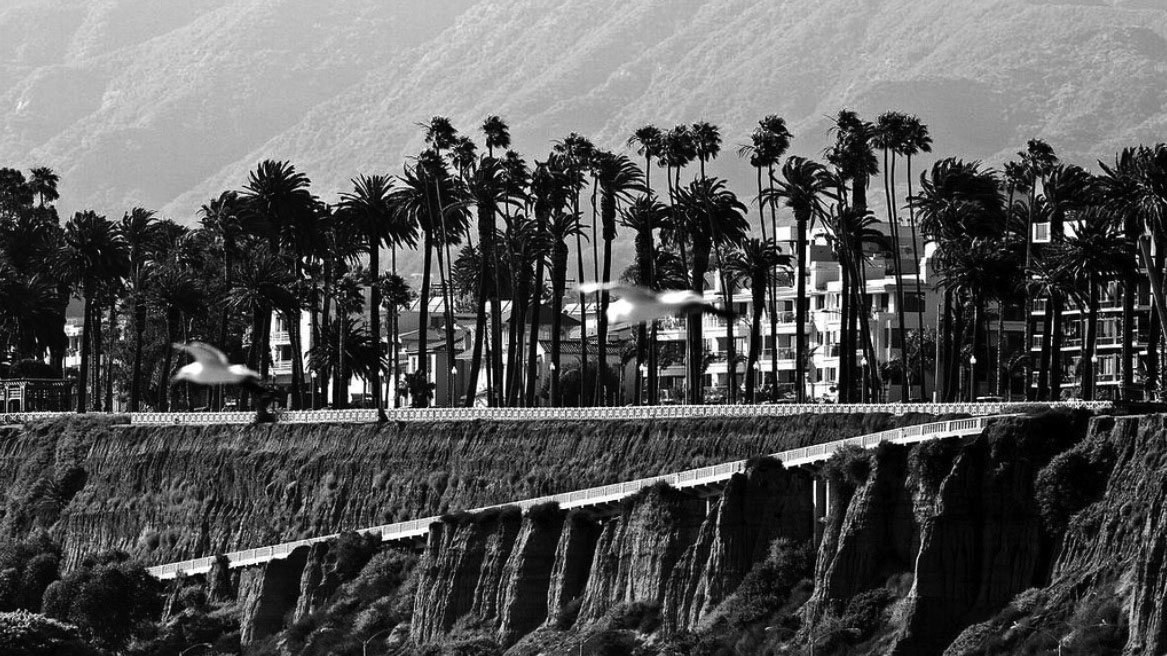 |
|
| (2011)* - View of the California Incline as seen from the Santa Monica Pier. Photo by Ricardo DeAratanha / Los Angeles Times |
Historical Notes The California Incline was rebuilt between 2015 and 2016. The new bridge consists of a pile-supported reinforced concrete slab structure with a width of 51 feet 8 inches, an increase of 5 feet 8 inches over the previous structure. The project cost $17 million, with 88.5% coming from federal funds and the balance from local funds. Construction began in April 2015 and took 17 months to complete. The roadway reopened to the public on September 1, 2016. The rebuilt structure includes wider sidewalks and bicycle lanes. Click HERE to see early views of the California Incline (1905 +). |
Palisades Park
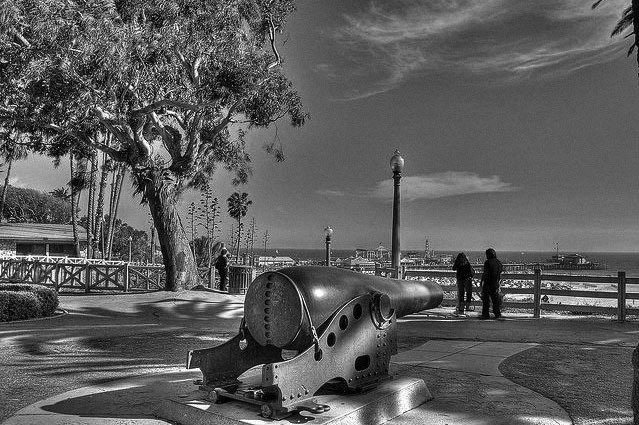 |
|
| (2012)* - View of one of two very large cannons located at Palisades Park. Three people are seen by the rail at the bluff's edge looking out toward Santa Monica Pier and Beach. Photo courtesy of Thomas Hart |
Historical Notes A pair of Civil War seacoast cannons dating from 1861 were given to the City of Santa Monica on July 4, 1908, by the U.S Veteran’s Administration. Originally, each of the mounted guns had a pyramidal stack of iron cannonballs beside it, which are now gone. One cannon is located north of Colorado Boulevard near the entrance to the Santa Monica Pier. The other cannon, is located north of the Recreation center. They are ten-inch Rodman smoothbore seacoast guns. Each of the cannons is twelve-feet long and weighs about sixteen tons. They came to Palisades Park from Angel Island. Santa Monica was never defended with cannons during times of war, although it is said that during the Spanish-American War, the city engineer mounted lengths of large pipes along the bluff to give the impression that the city was heavily fortified. |
.jpg) |
|
| (n.d.)* - Tall palm trees line the walking path in Palisades Park. The Santa Monica beach can be seen in the background. |
Historical Notes In recognition of its value as a historic resource and cultural landscape, Palisades Park was designated as a Santa Monica landmark in 2007. |
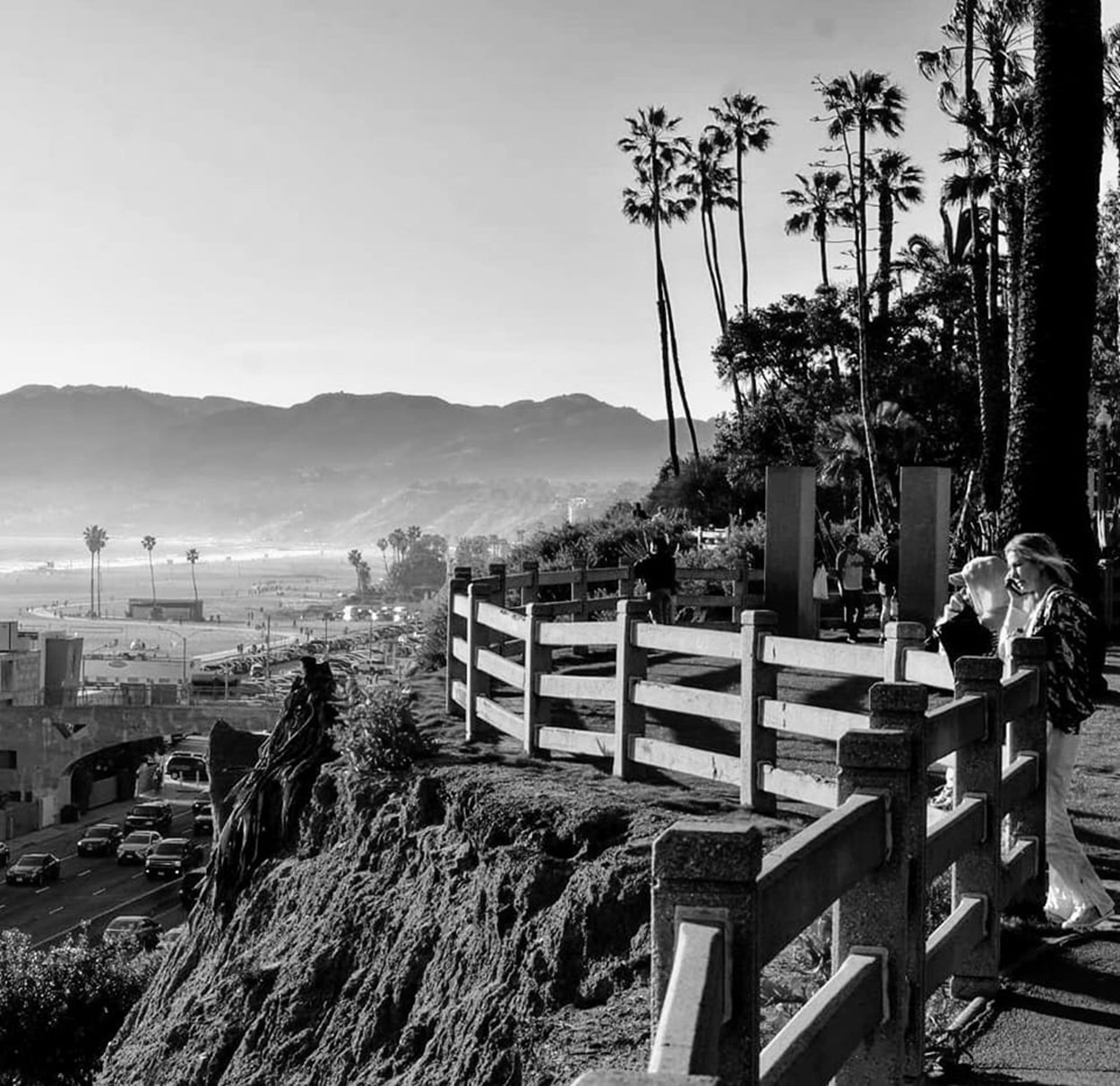 |
|
| (2023)* - Looking down from the top of Palisades Park. Photo courtesy of Paul Wright |
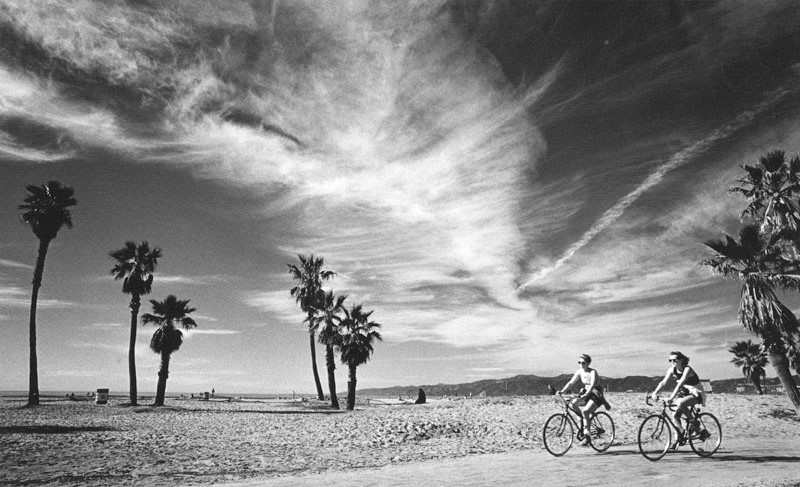 |
|
| (1988)* - Two bike riders take advantage of springtime in January while they take in the sights along the sunny, wind-swept beach path between Santa Monica and Venice Beach. Photograph dated: Jan. 26, 1988. |
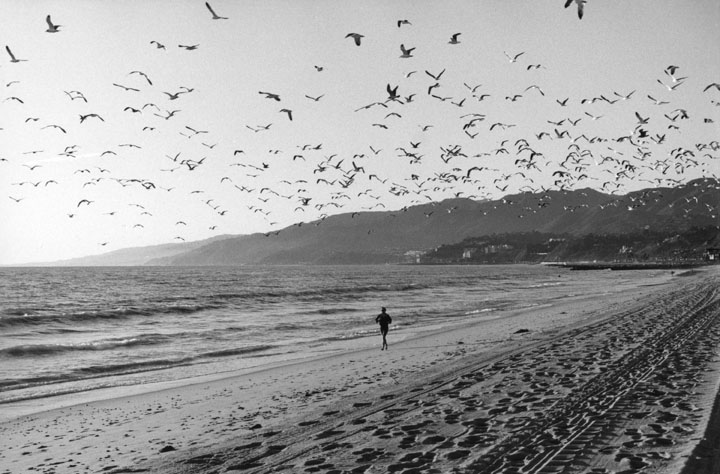 |
|
| (1986)* - A large colony of seagulls fills the sky over on a beach in Santa Monica, where a woman is seen jogging near the water. |
 |
|
| (n.d.)* - Sunset over the Pacific Ocean as seen at Santa Monica Beach. |
* * * * * |
Please Support Our CauseWater and Power Associates, Inc. is a non-profit, public service organization dedicated to preserving historical records and photos. We are of the belief that this information should be made available to everyone—for free, without restriction, without limitation and without advertisements. Your generosity allows us to continue to disseminate knowledge of the rich and diverse multicultural history of the greater Los Angeles area; to serve as a resource of historical information; and to assist in the preservation of the city's historic records.
|
More Historical Early Views
Newest Additions
Early LA Buildings and City Views
History of Water and Electricity in Los Angeles
* * * * * |
References and Credits
* LA Public Library Image Archive
^^The California History Room, California State Library
^*LMU Digital Collection: Arcadia Hotel
#^ Santa Monica Public Library Image Archive
+# Santa Monica Mirror: Statue of Santa Monica
+^ Santa Monica Landmarks: Looff Hippodrome
## Library of Congress: Santa Monica Bay ca. 1908; Ferris Wheel
***Cinema Treasures: El Miro Theatre; Criterion Theatre and Thrid Street; Criterion Theatre
^x^Facebook.com: Venice, Ca, Ocean Park, & Santa Monica in the 20th Century
**^Noirish Los Angeles - forum.skyscraperpage.com; Deauville Club; Palisades Park Cannon; Muscle Beach
^^*Deviantart-Studio5: Santa Monica Beach
^^#University of California Digital Library: The Deauville Club
^^+Stanford University Revs Digital Library
*^#Nuestra Señora la Reina de los Ángeles: losangelespast.com
*#*KCET: A Historical Look at SoCal's Beaches
*#^Santa Monica Public Library
^#*Santa Monica History Museum
^#^Framework.latimes.com: Santa Monica Beach, 1936; Santa Monica Aerial, 1937; McClure Tunnel
^##The Malibu Times: Historic Las Flores Canyon
+##Facebook.com: Vintage Los Angeles
*#*KCET: A Historical Look at SoCal's Beaches; Arch Rock and Castle Rocks; When L.A.'s Most Famous Streets Were Dirt Roads
**#The Central Tower Building - City Landmark Assessment and Evaluation Report
#**MTA Transportation and Research Library Archives
#^^Huntington Digital Library Archive
#*^Electric Railway History: Venice Trams
#+#Facebook.com: Photos of Los Angeles
^^^California State Library Image Archive
****Life.time.com: Stoked-Life Goes Surfing
^^^^Pinterest/Santa Monica Past: Santa Monica Canyon Flood; Santa Monica Airport/Clover Field; Douglas Aircraft
*^*^Santa Monica Beach Stories
^**^California Legends: Santa Monica at the End of Route 66
*^^*Discoverlosangeles.com: Santa Monica
*^^^NonPhotography.com-Nika: Santa Monica Pier
***^History of the Fairmont Miramar Hotel and Bungalows
^***Southern California Beaches: Santa Monica Beach
**#*Santa Monica via Beverly Hills Line - uncanny.net
*#**Los Angeles Westerners Corral: Venice Miniature Railway
*##*AkamaIdivers.com: Pacific Ocean Pier
*##^Santa Monica Conservancy; Henshey’s Tegner Building
*#*#Los Angeles Then and Now: Douglas' Dream Took Wing in Santa Monica
*#^#Flickr.com: Walking Over Santa Monica
^#*#Venice History: Roller Coasters and Carousels
^^*#Oceanpark.wordpress.com: Ocean Park Time Line
*^*#Santa Monica Municipal Airport
*^^#LAistory: The Santa Monica Pier
#*^*Cardcow.com: Marion Davies' Mansion
#***California 2012 - Travel w/ Terry: Annenberg Beach House
#*#*Flickr.com: Michael Ryerson
#^#*Denver Public Library Image Archive
#^^^Survey LA: Brentwod-Pacific Palisades Community Plan Area
#^*^Santa Monica Landmark Properties
#^^*Pinterest.com: Old Hollywood
#^#^Paslisades Park: smgov.net
##*^Facebook.com: Hollywood's Garden of Allah Novels, Martin Turnbull
##^^MartinTurnbull.com: Gables Beach Club
****^Facebook.com: West San Fernando Valley Then And Now
^*^*^Wehadfacesthen.tumblr.com
*^*^*SantaMonicaPier.com
*#*#*Venice Miniature Railroad - Jeffrey Stanton
*^ Wikipedia: California State Route 1; History of Santa Monica; Alphonzo Bell; Venice; California Incline; Route 66; Third Street Pomenade; Santa Monica Pier; Casa del Mar Hotel; Pacific Palisades - Castellammare; Parkhurst Building; Venice Canal HIstoric District; Annenberg Community Beach House; Santa Monica High School; Jack Dempsey; Muscle Beach; Wilshire Boulevard
< Back
Menu
- Home
- Mission
- Museum
- Major Efforts
- Recent Newsletters
- Historical Op Ed Pieces
- Board Officers and Directors
- Mulholland/McCarthy Service Awards
- Positions on Owens Valley and the City of Los Angeles Issues
- Legislative Positions on
Water Issues
- Legislative Positions on
Energy Issues
- Membership
- Contact Us
- Search Index
